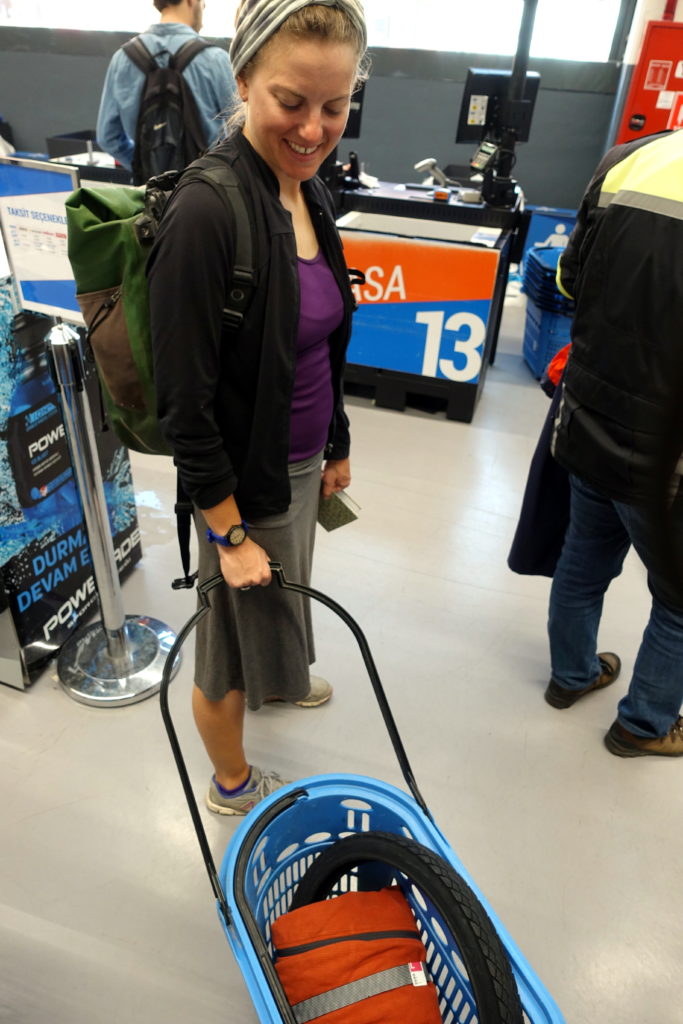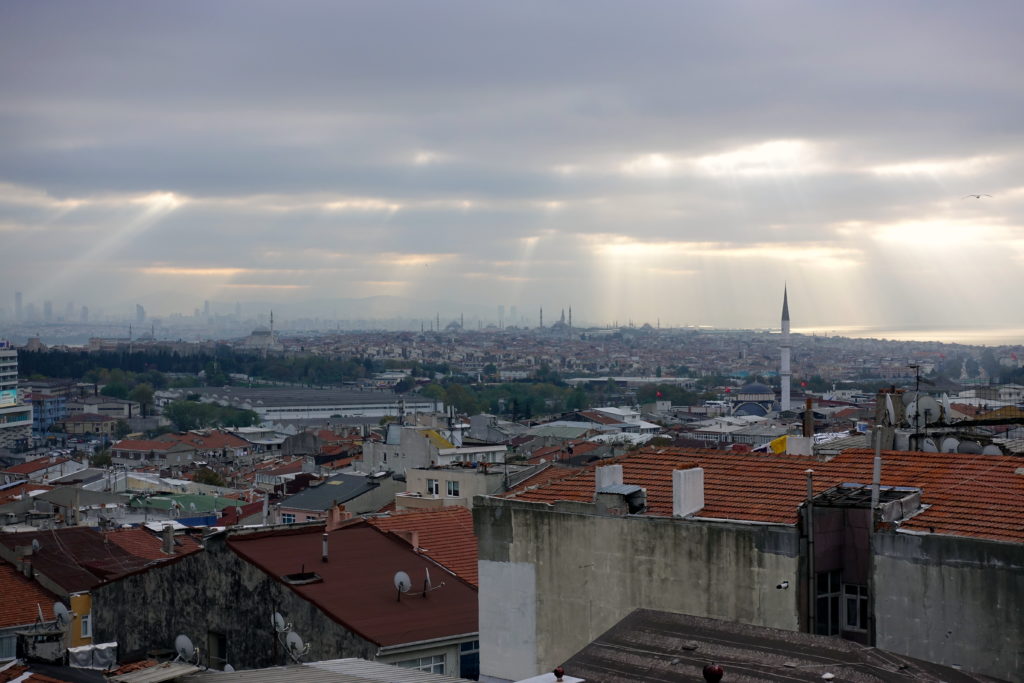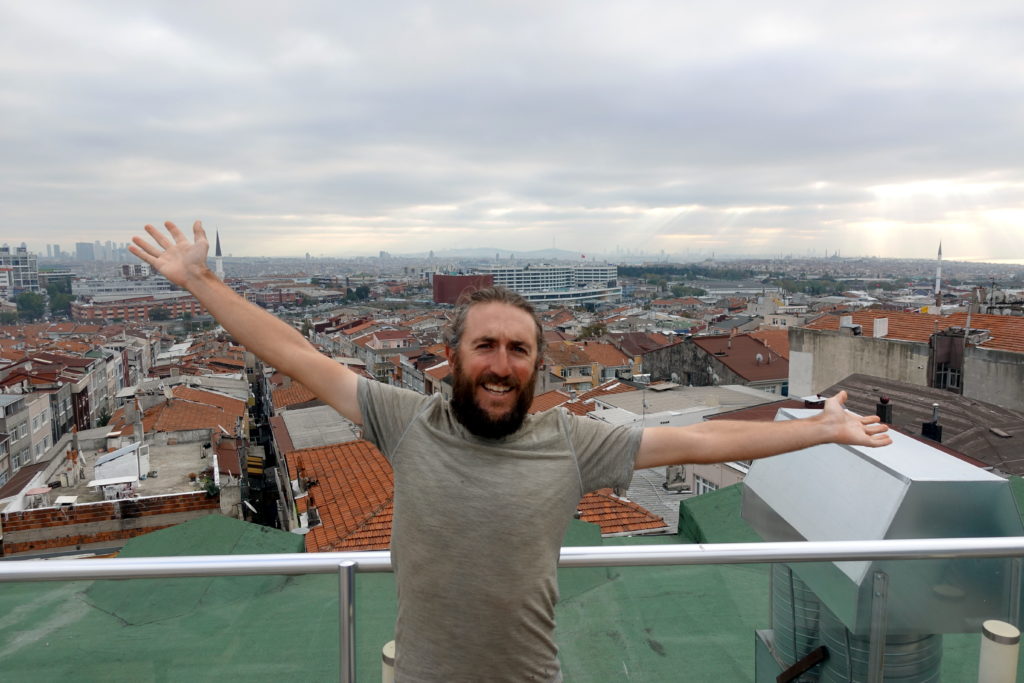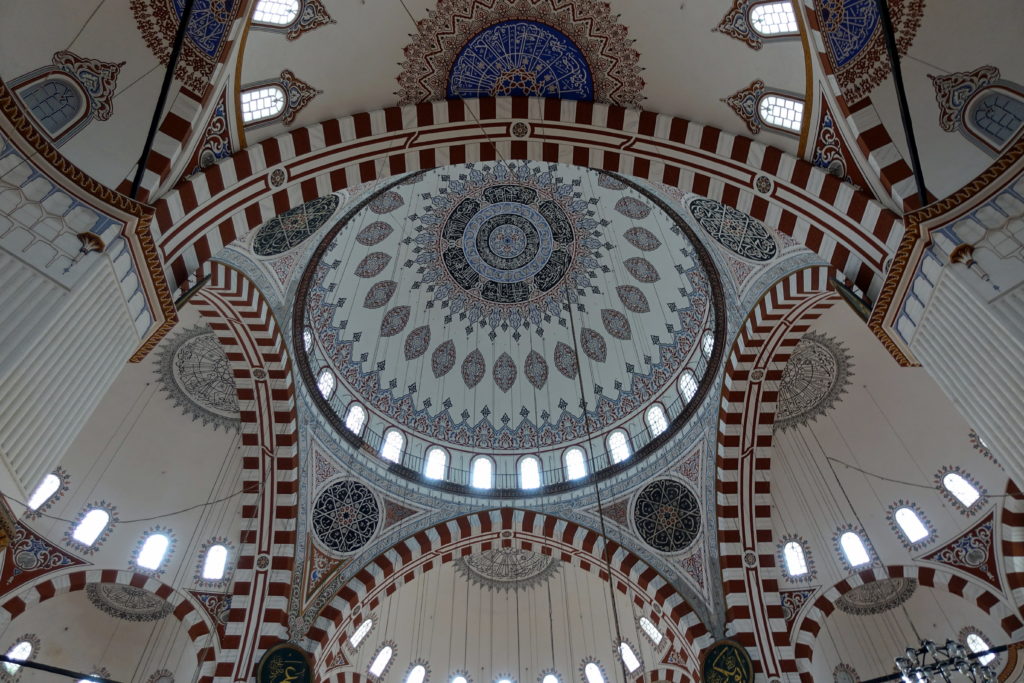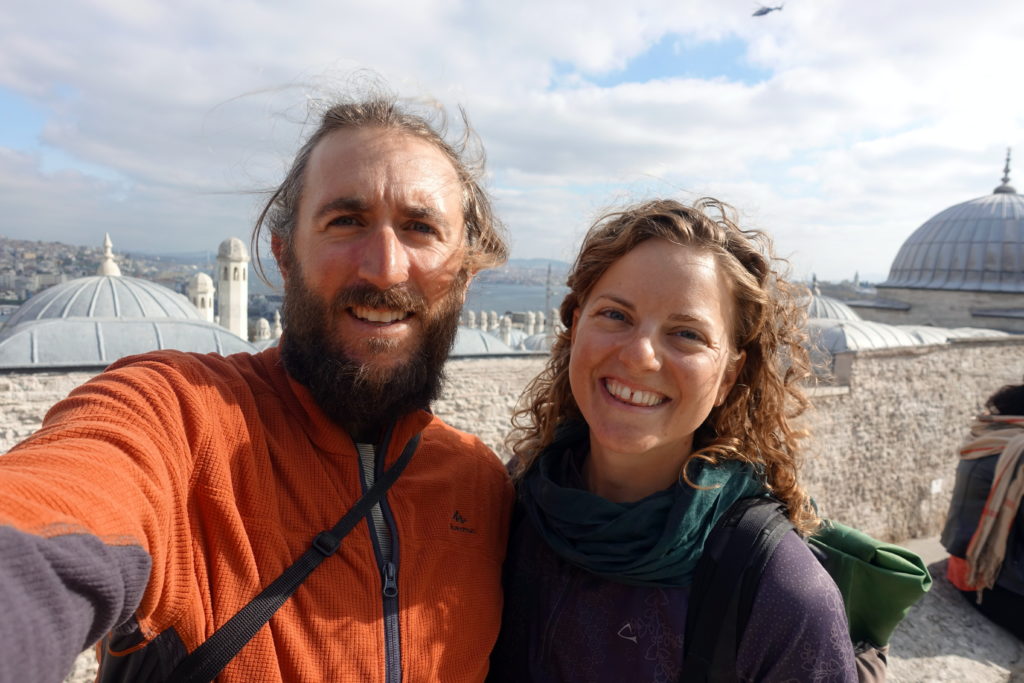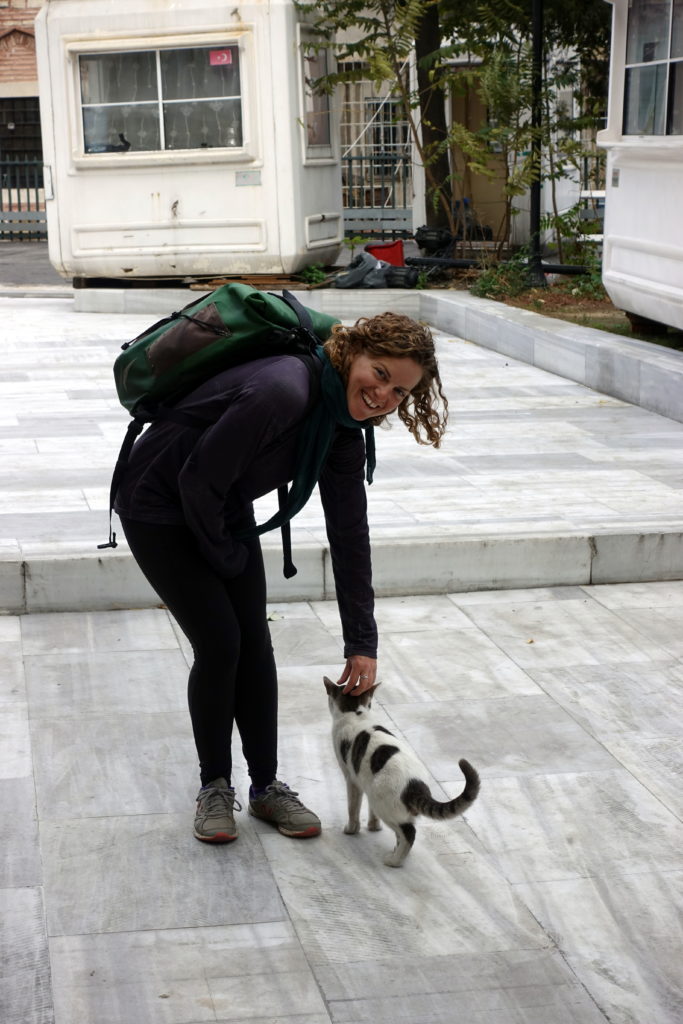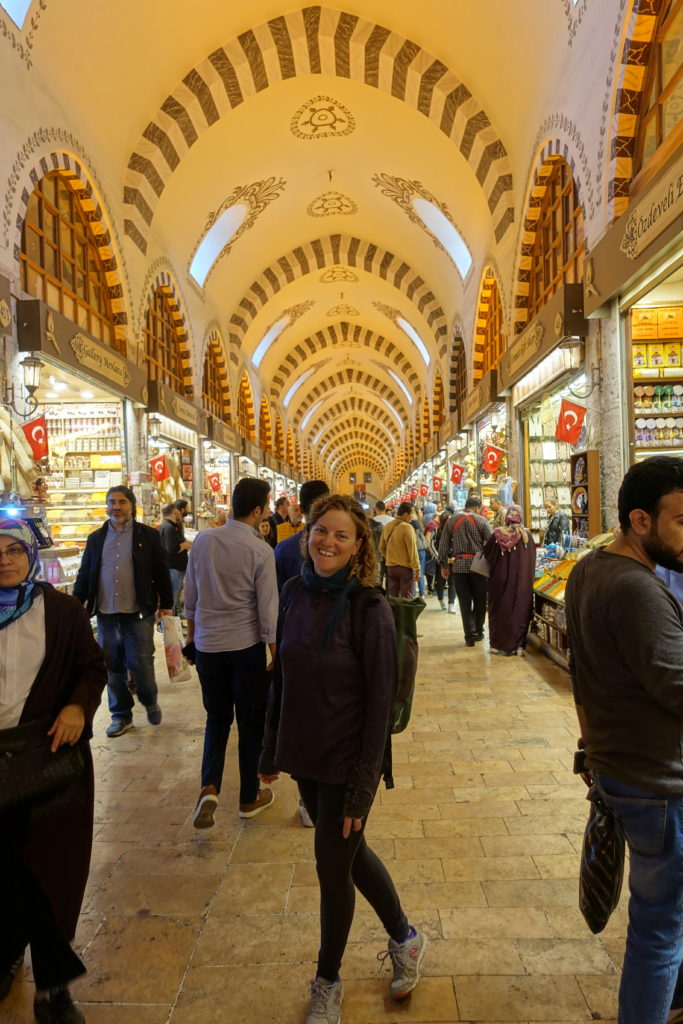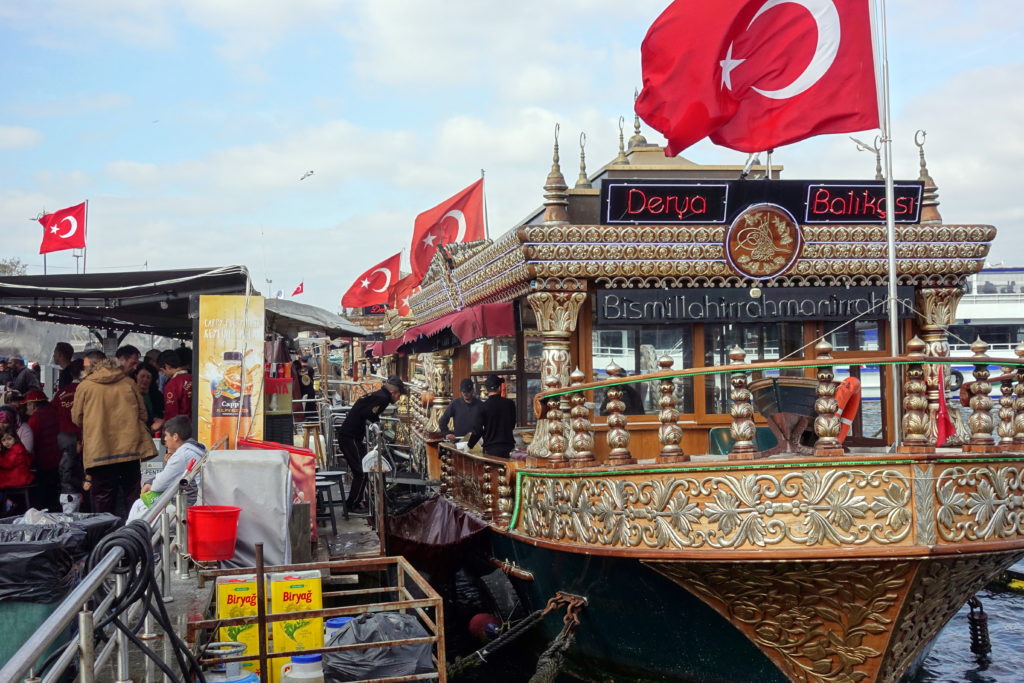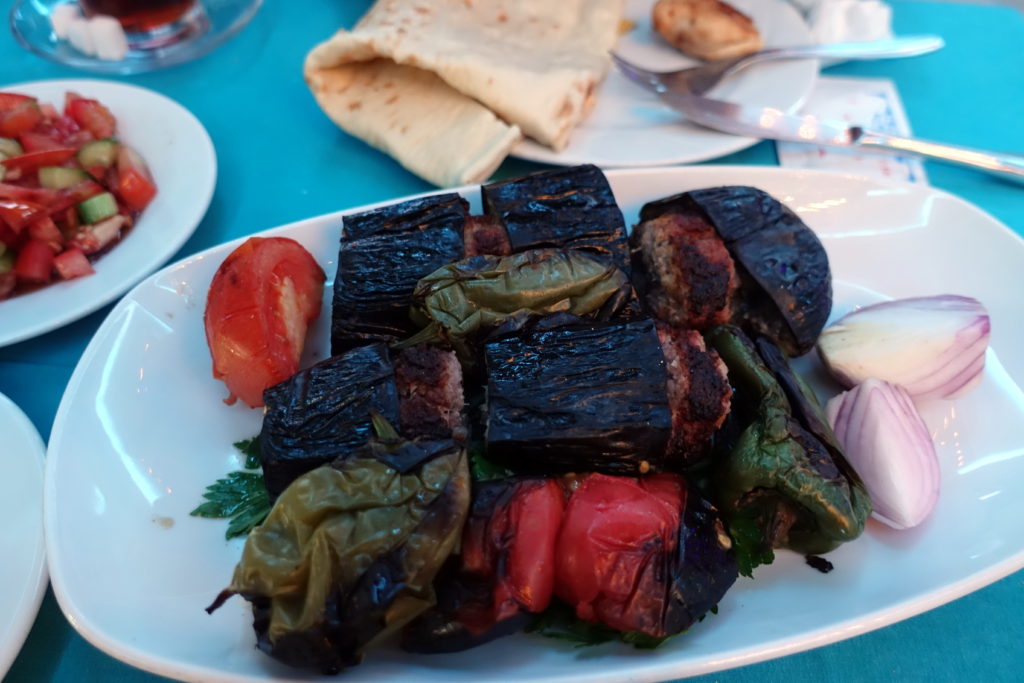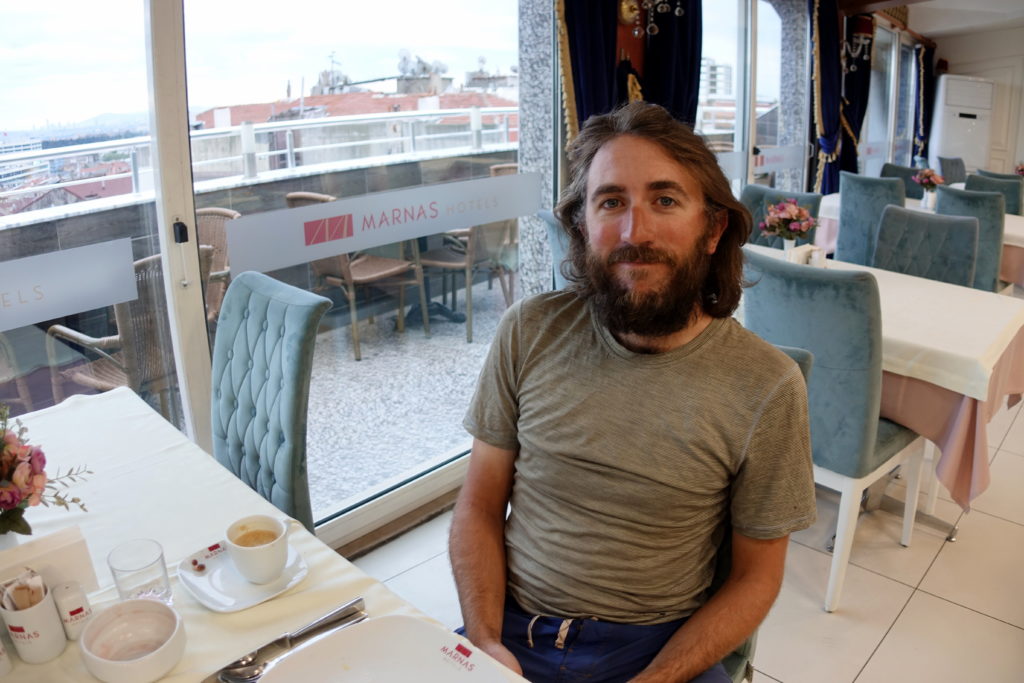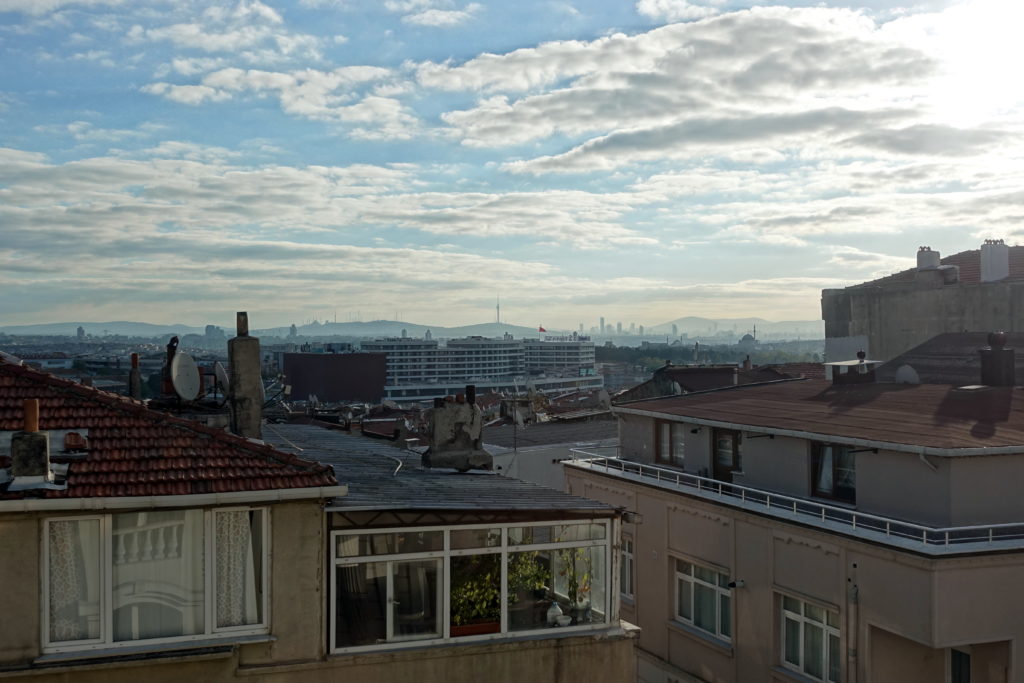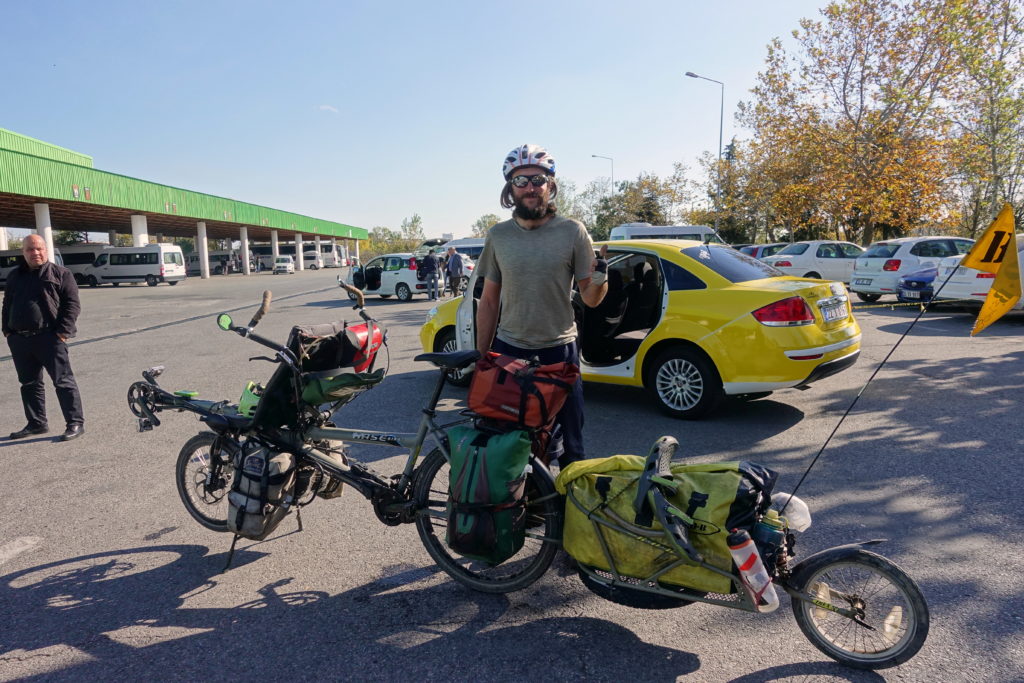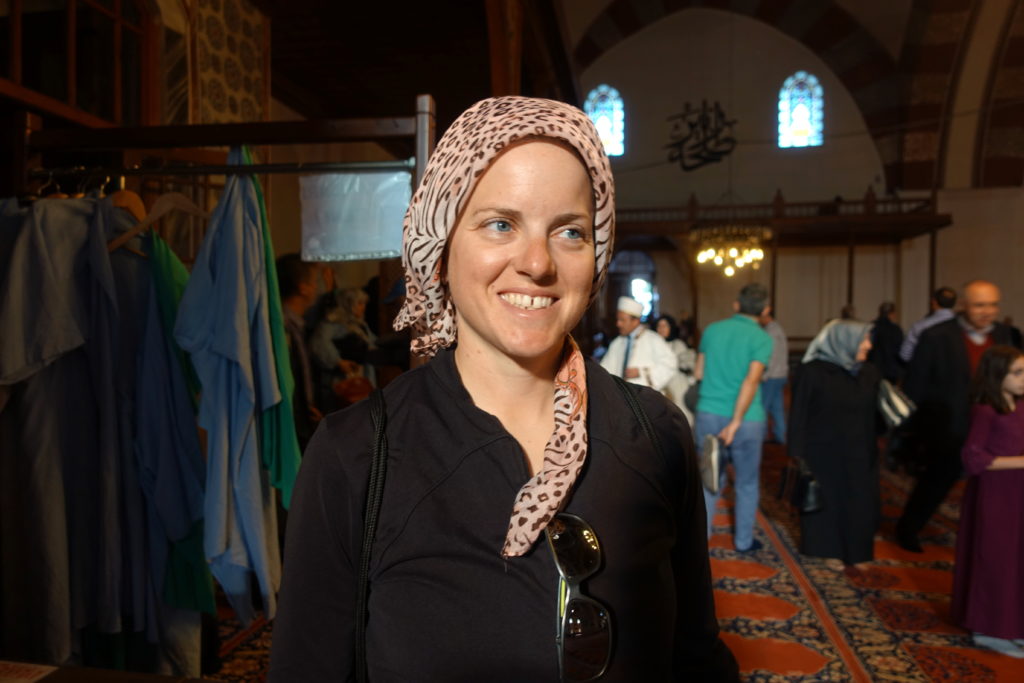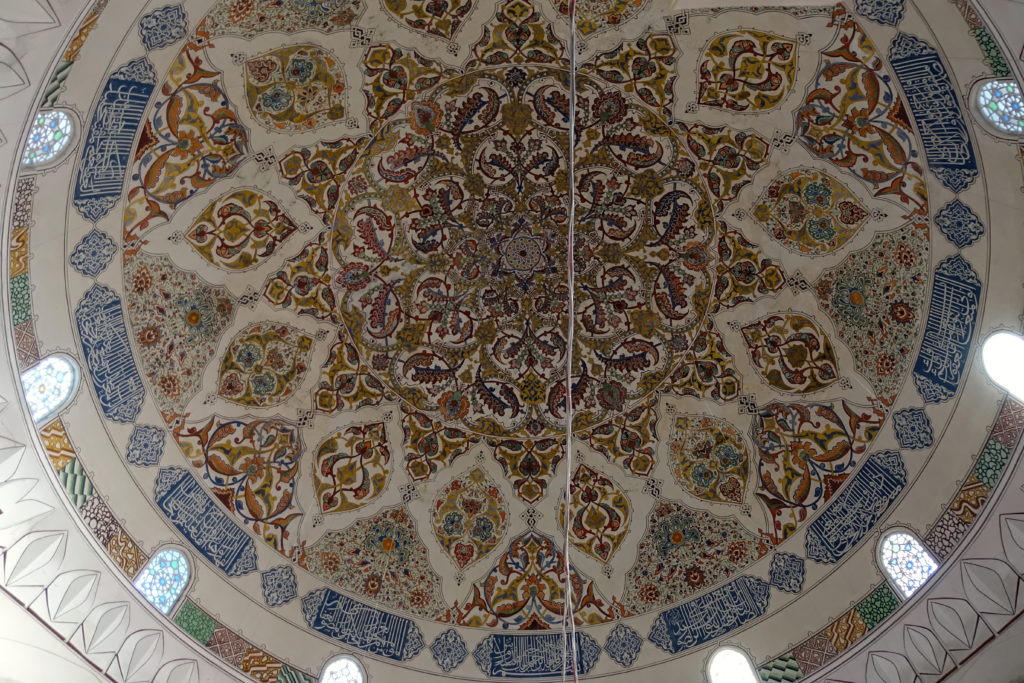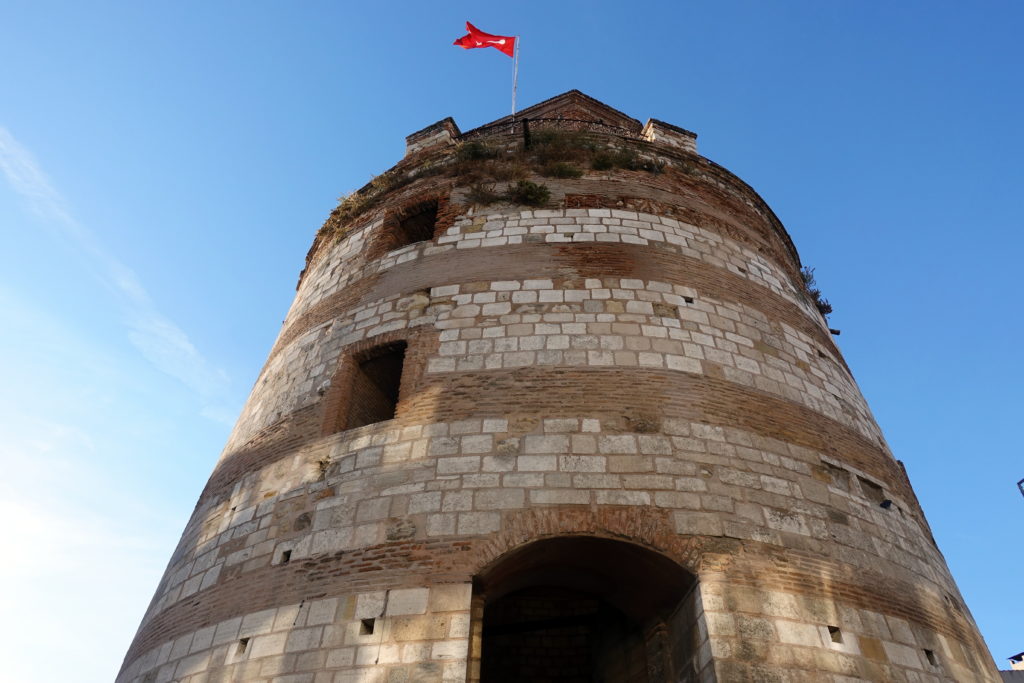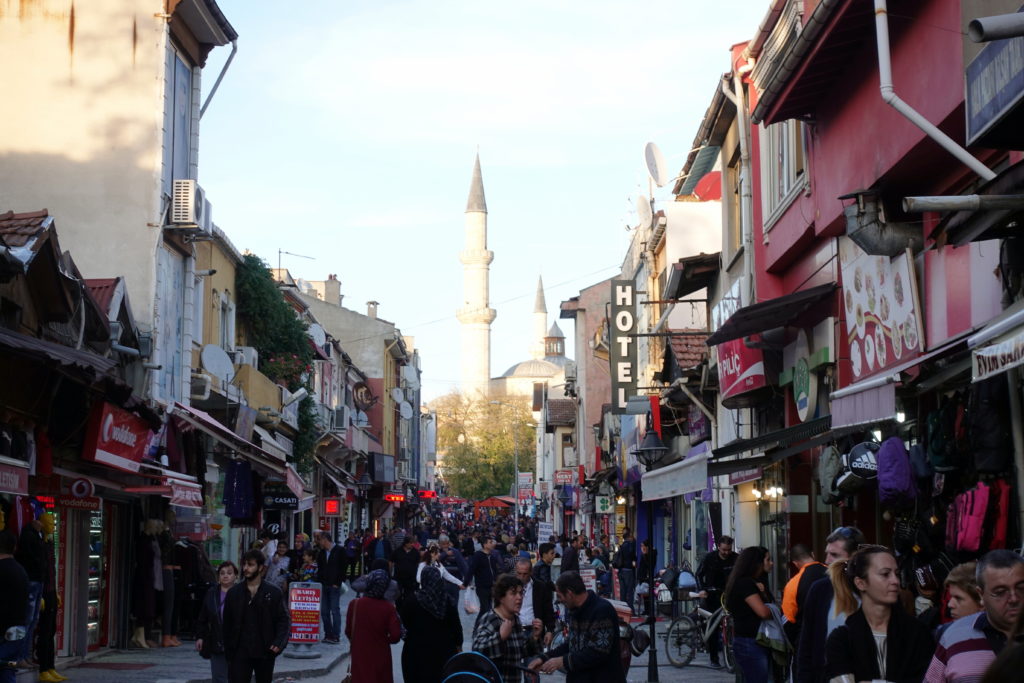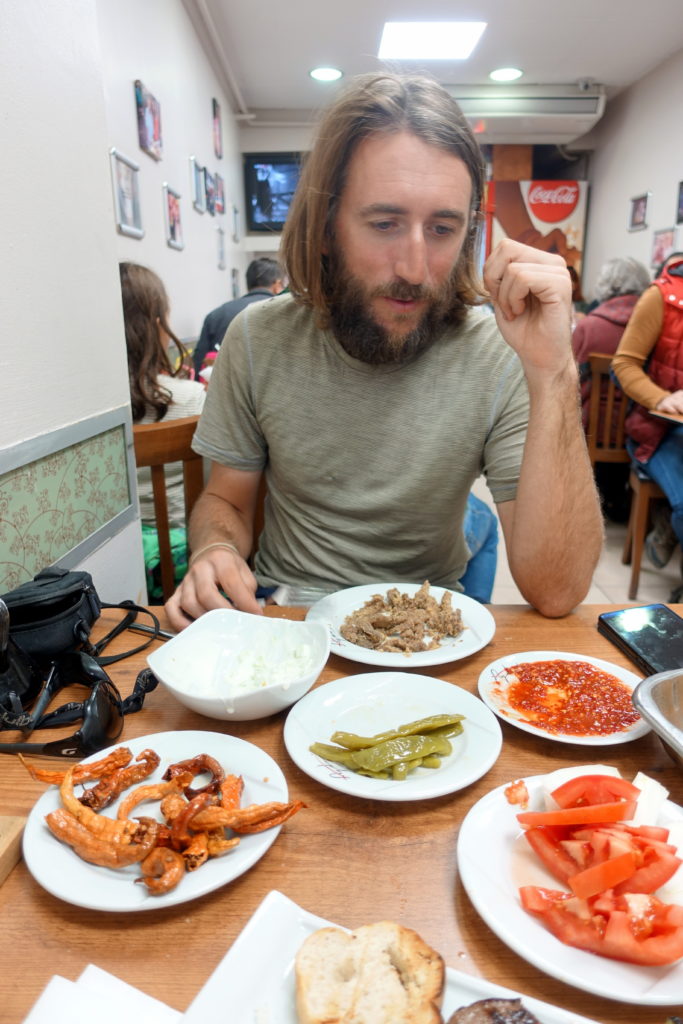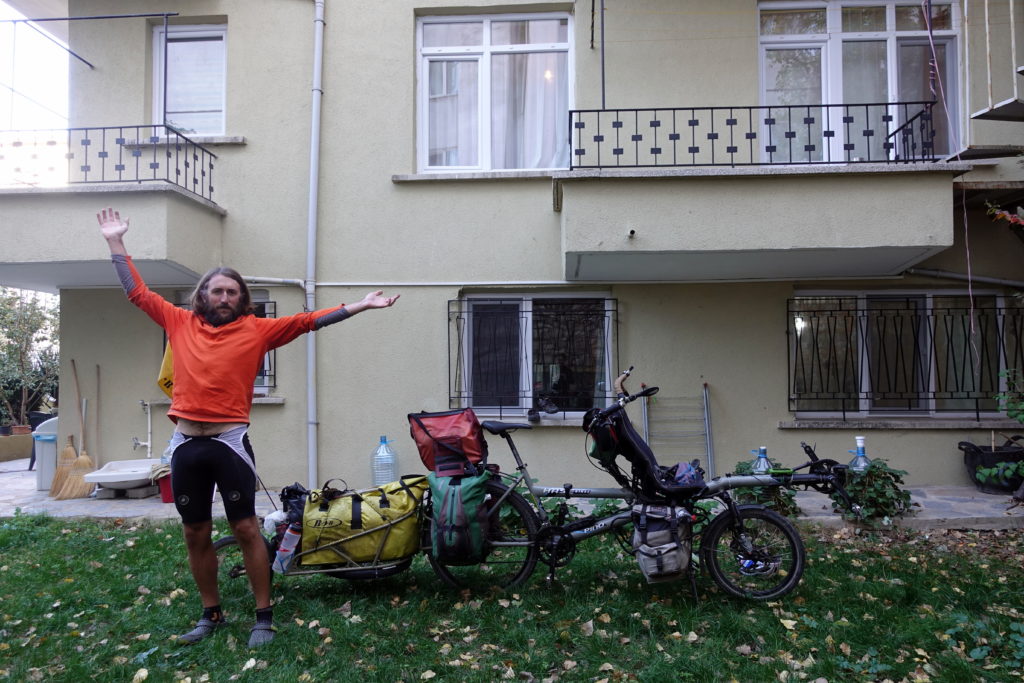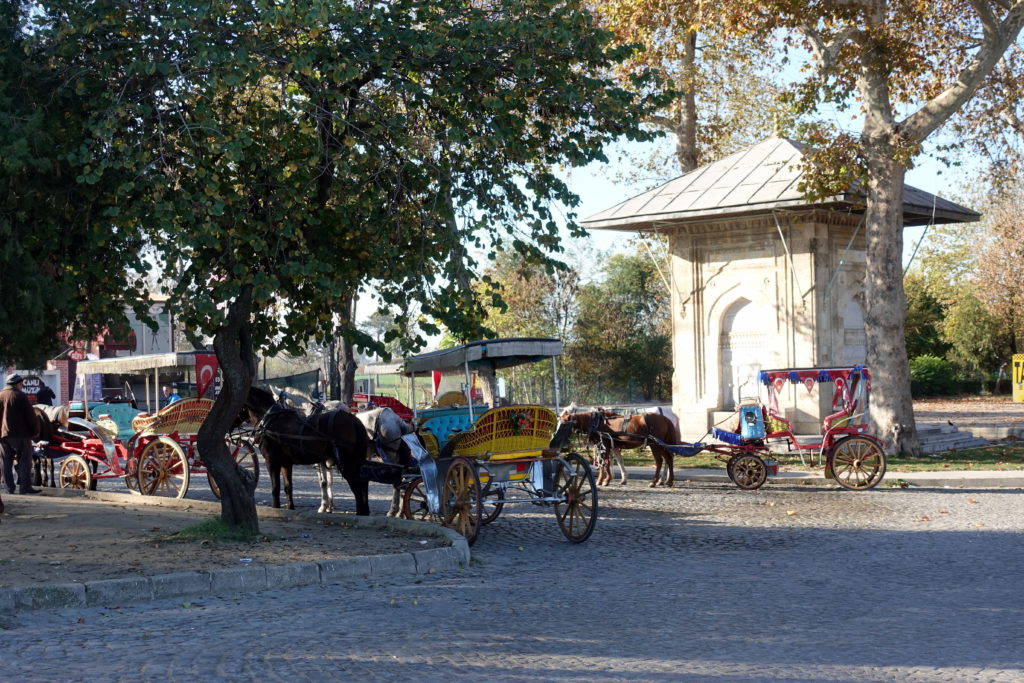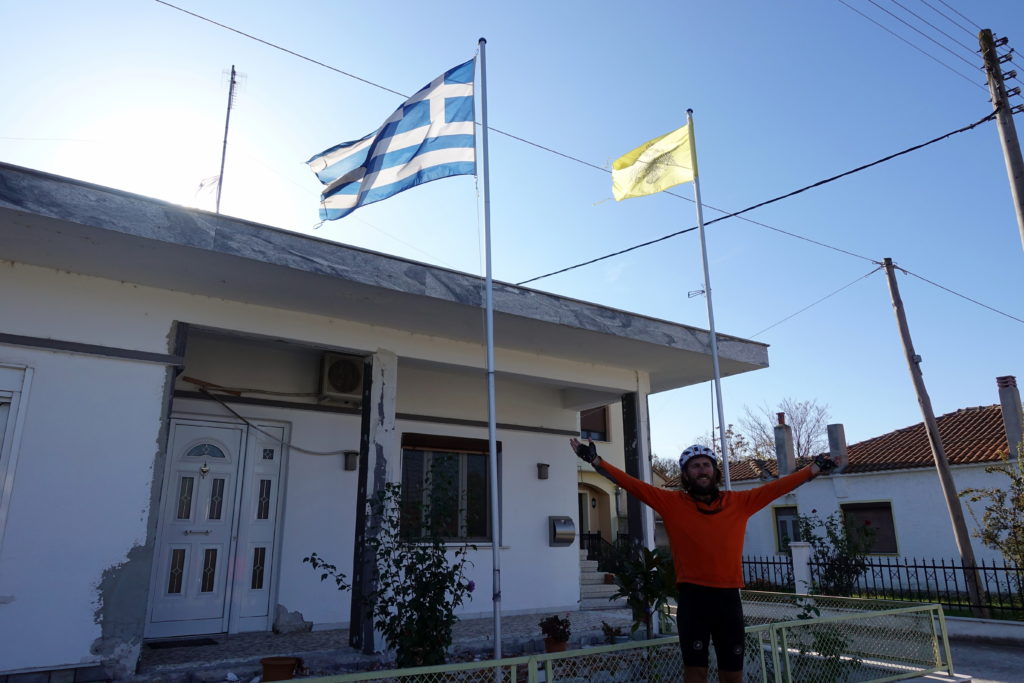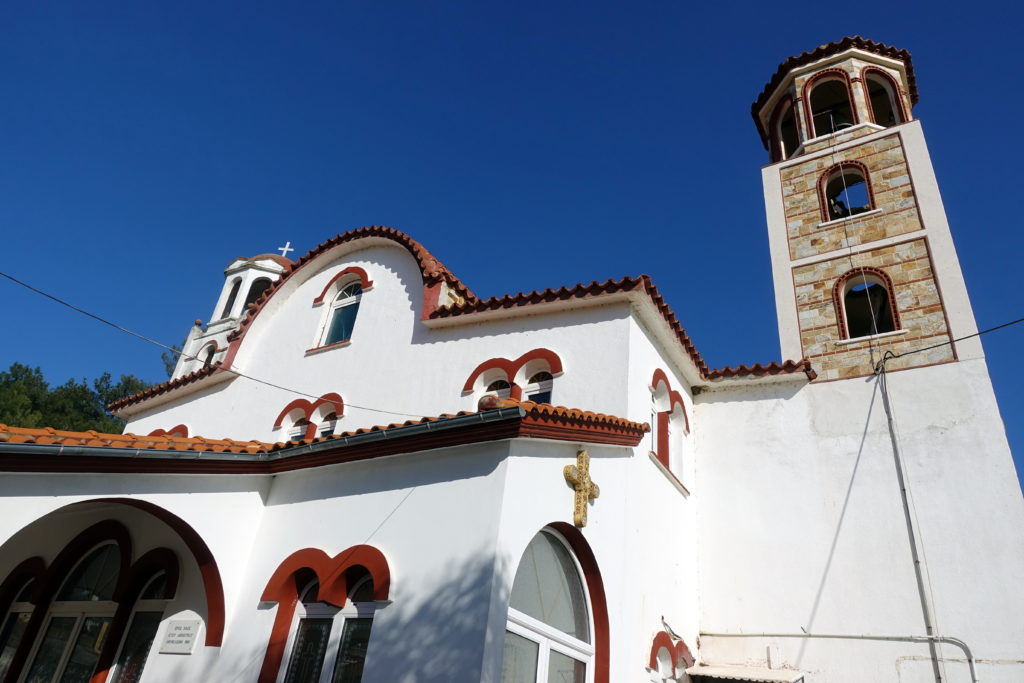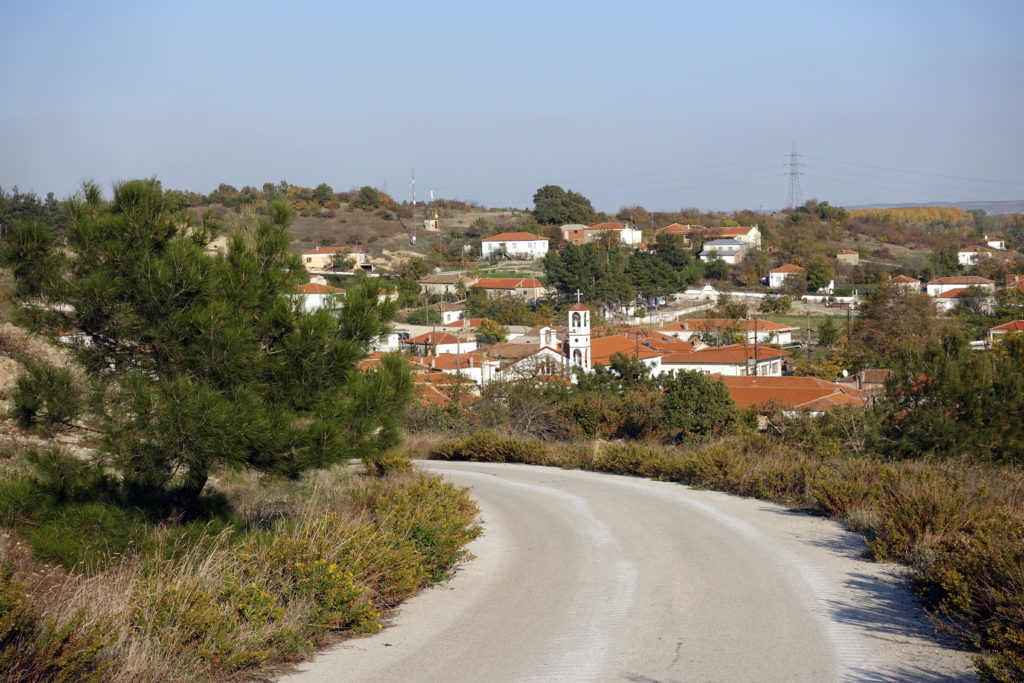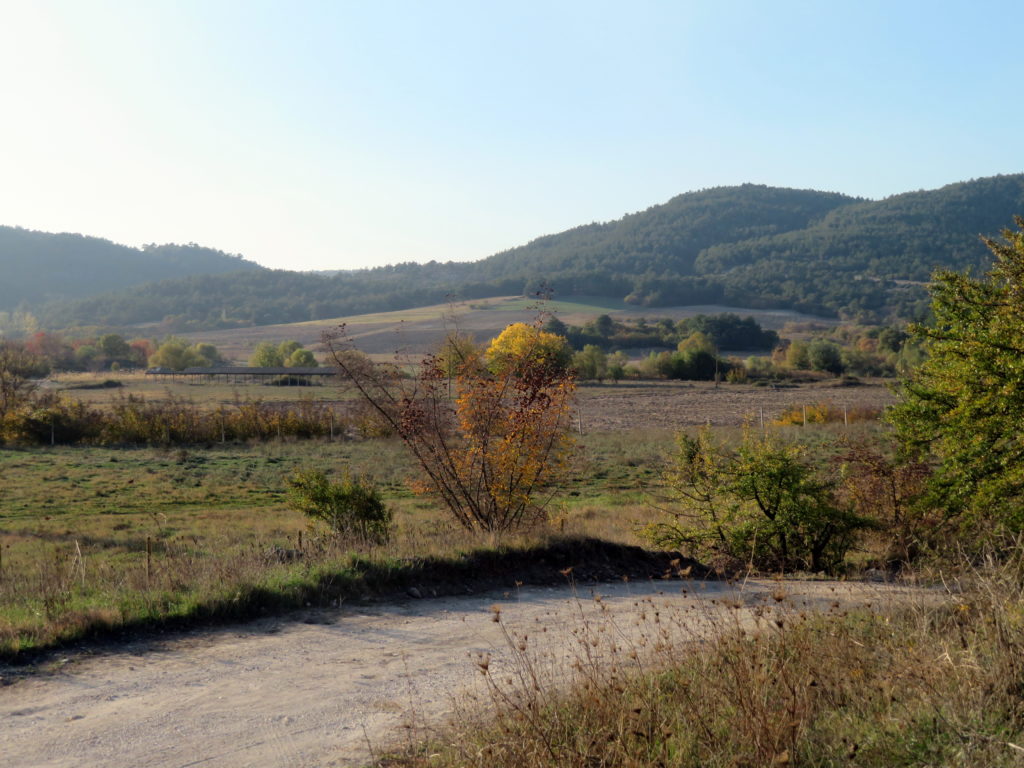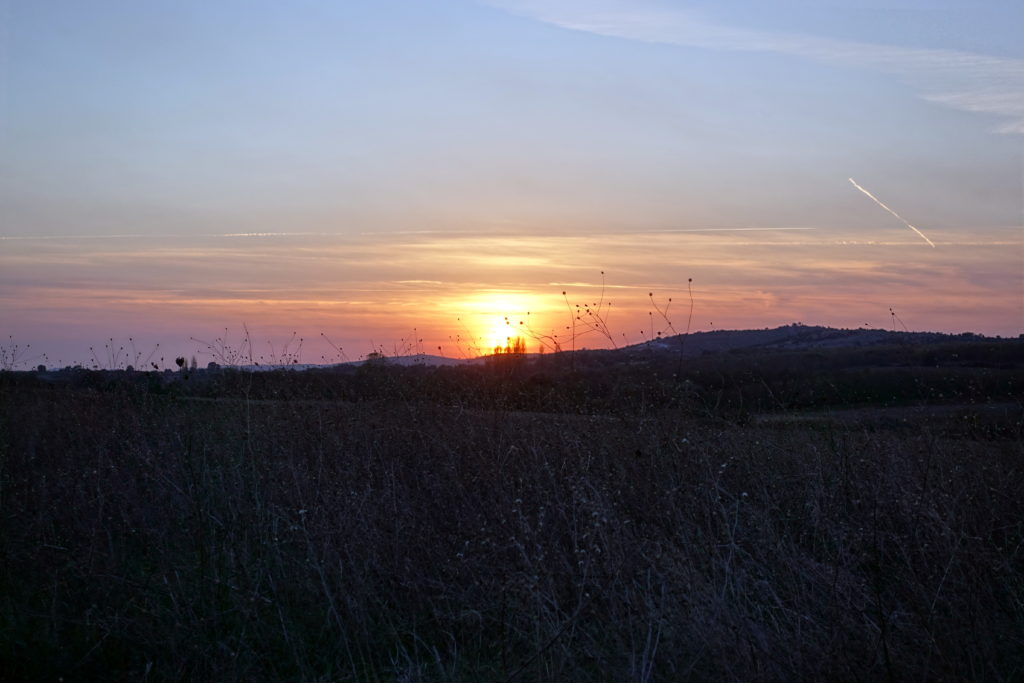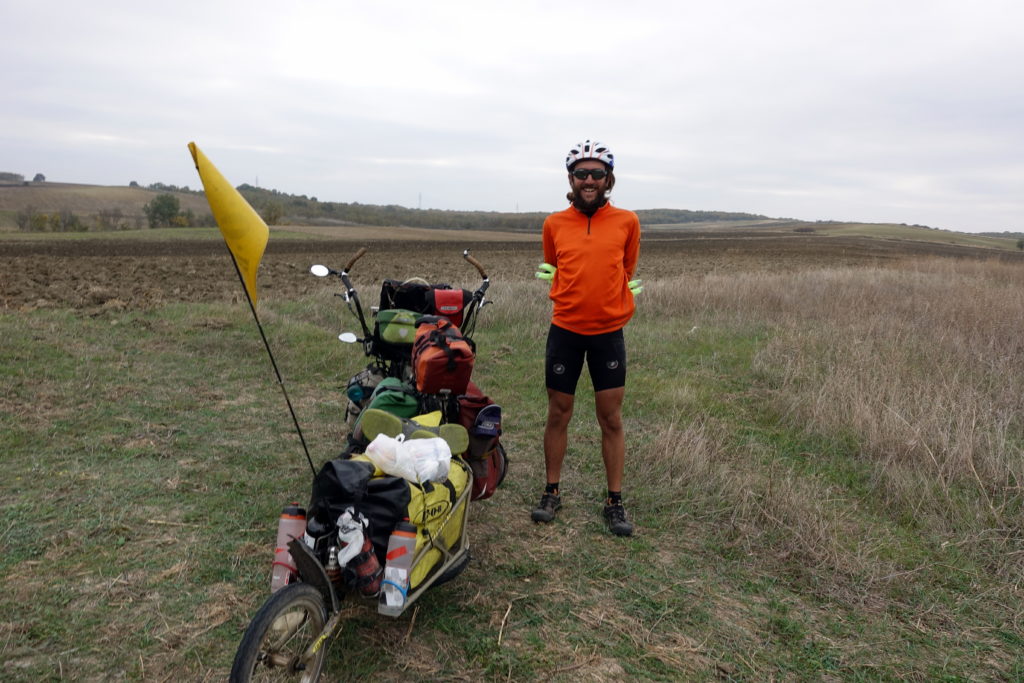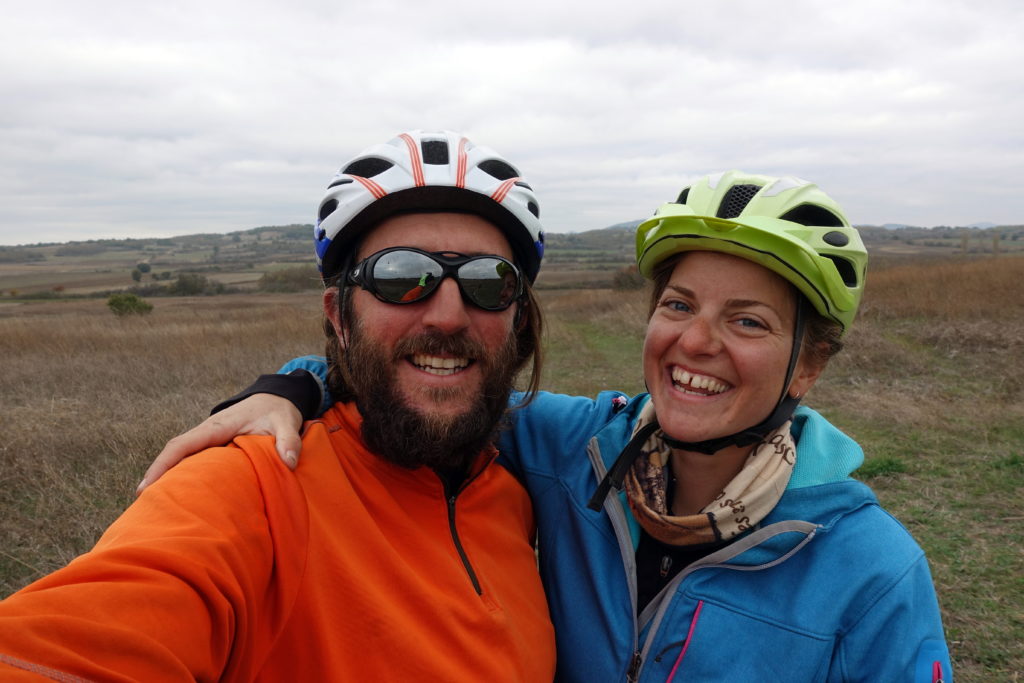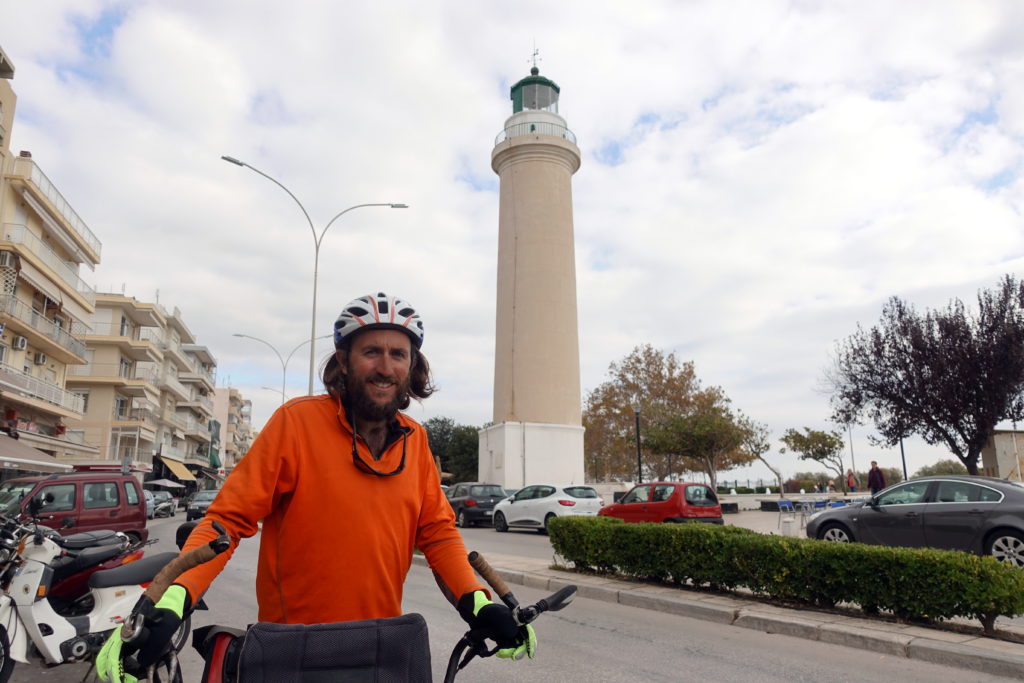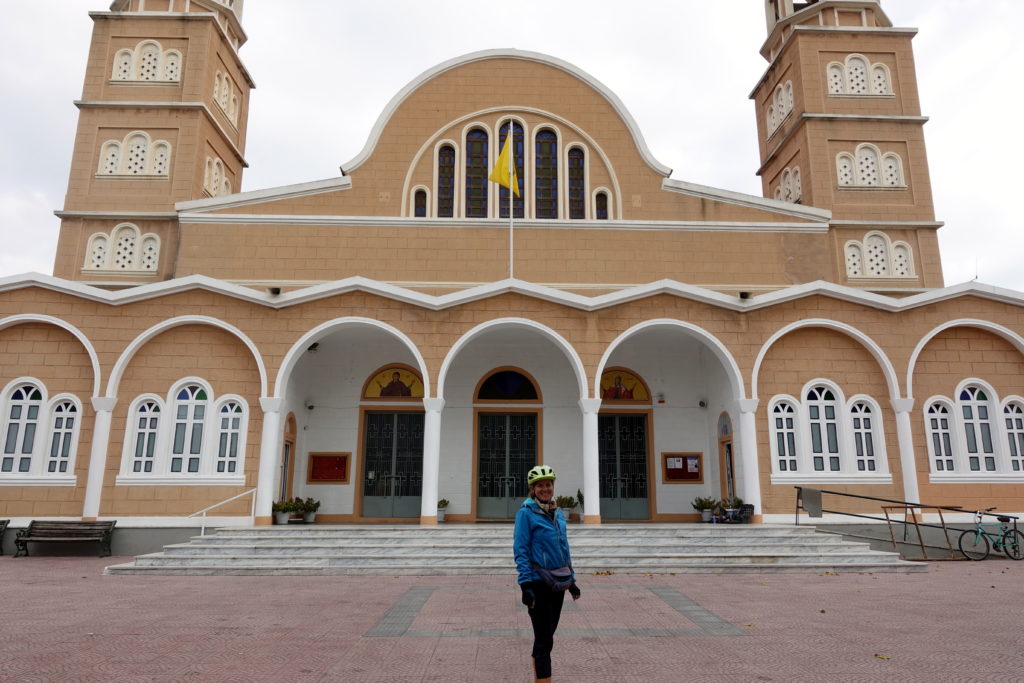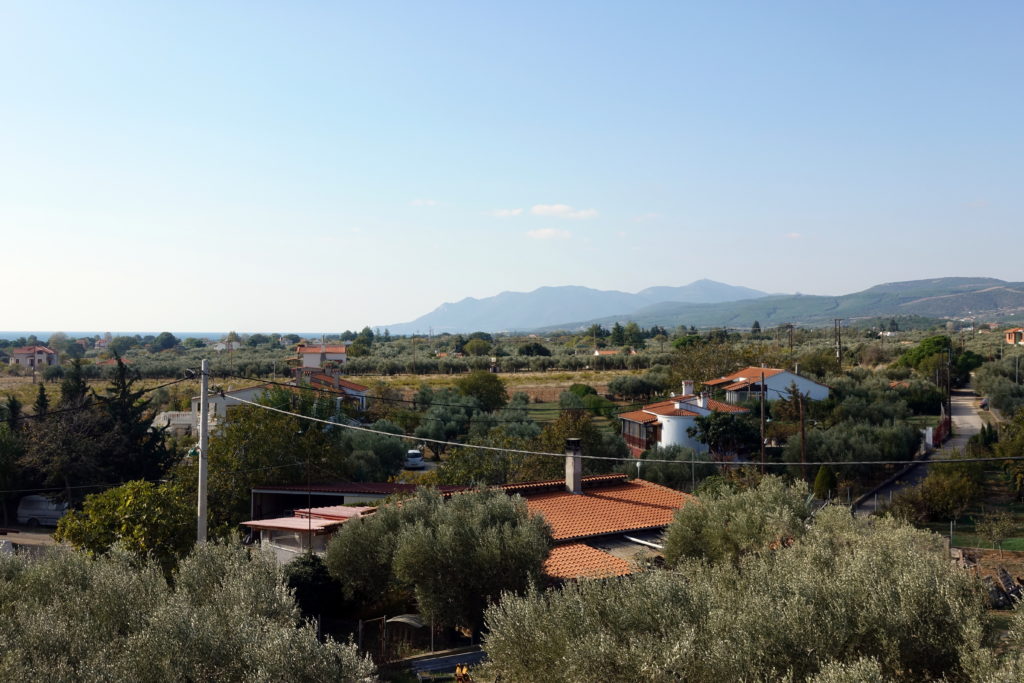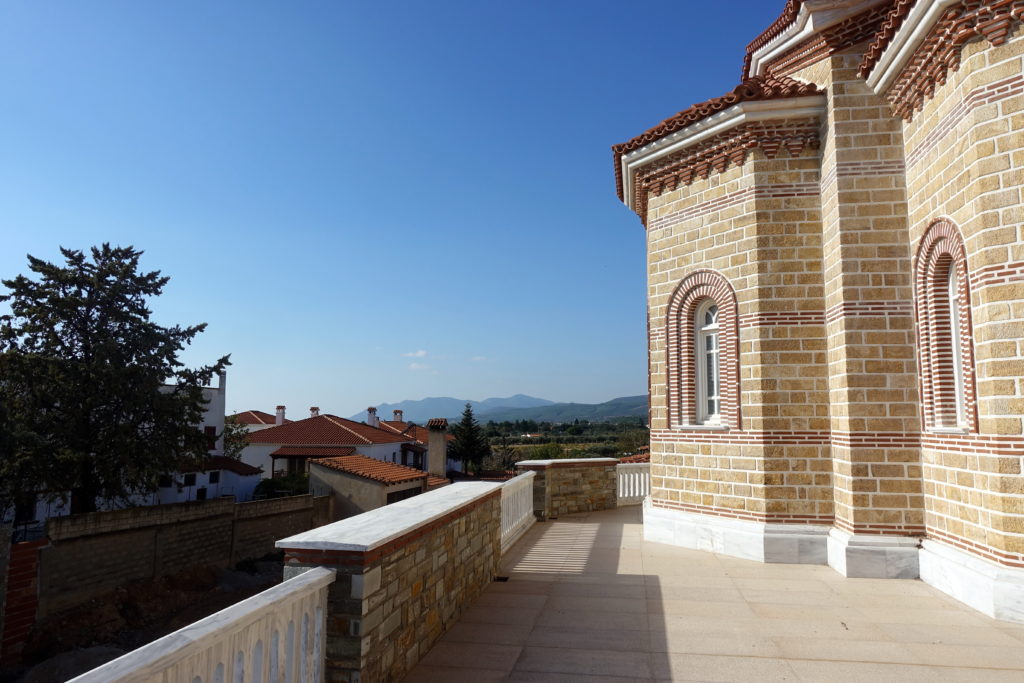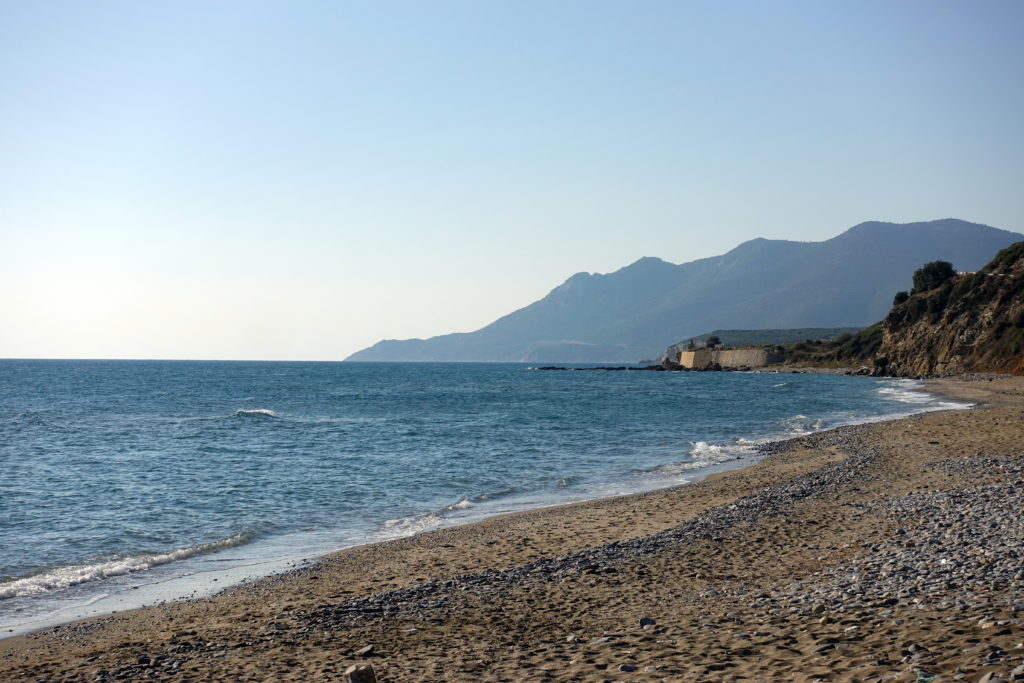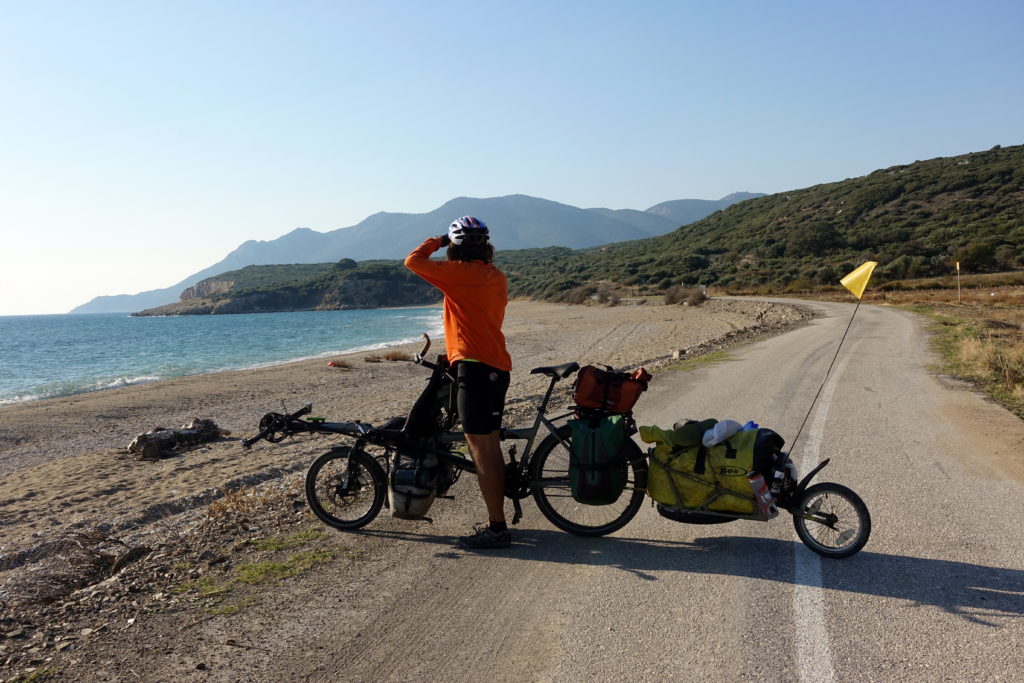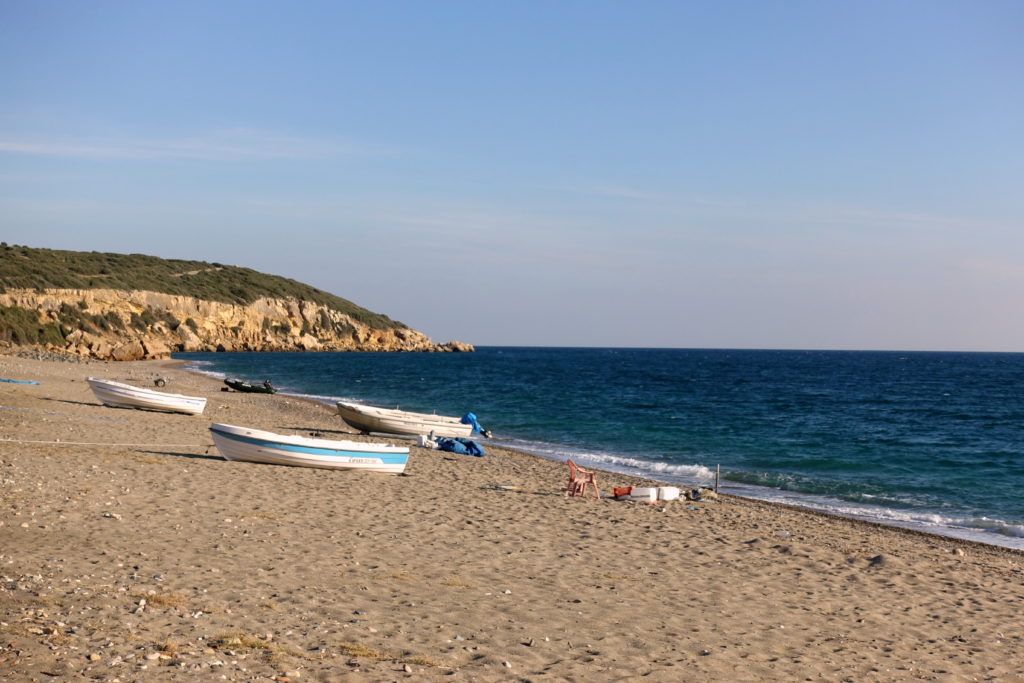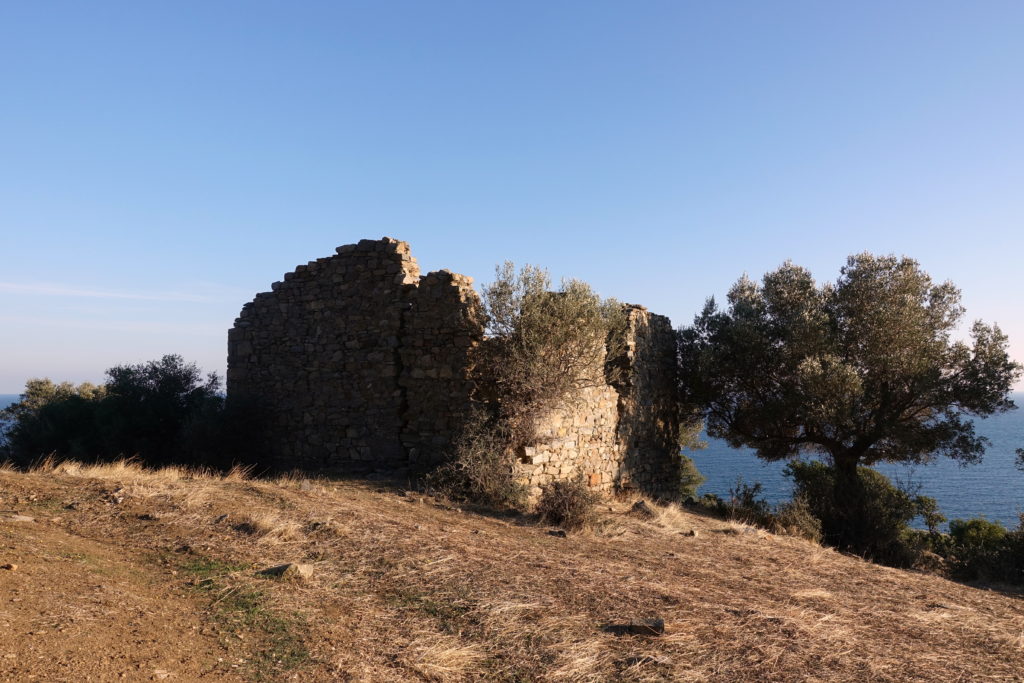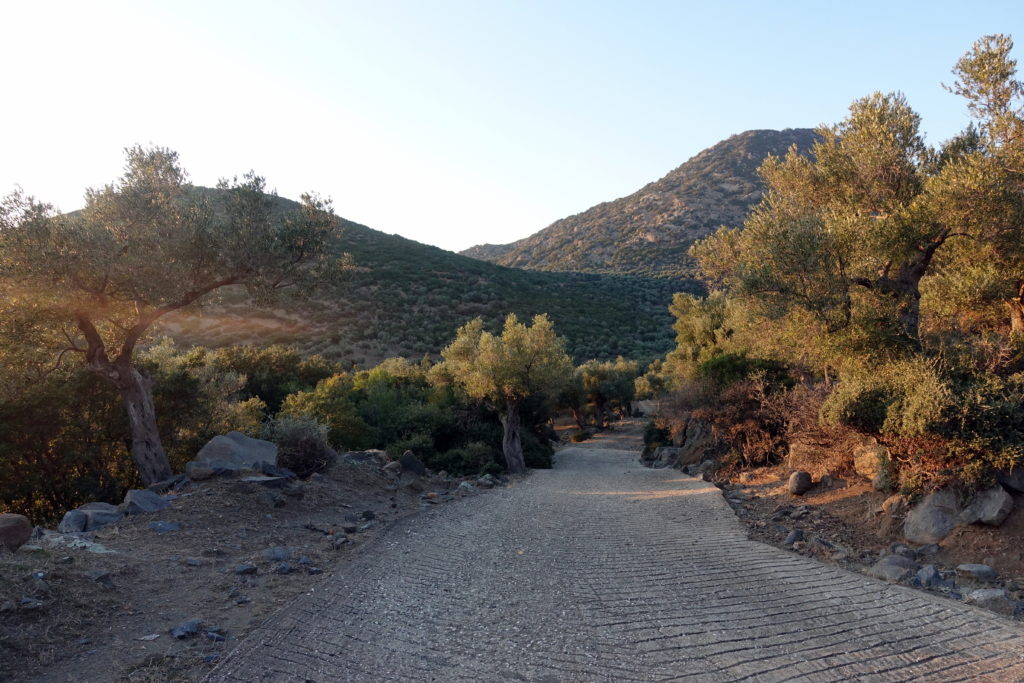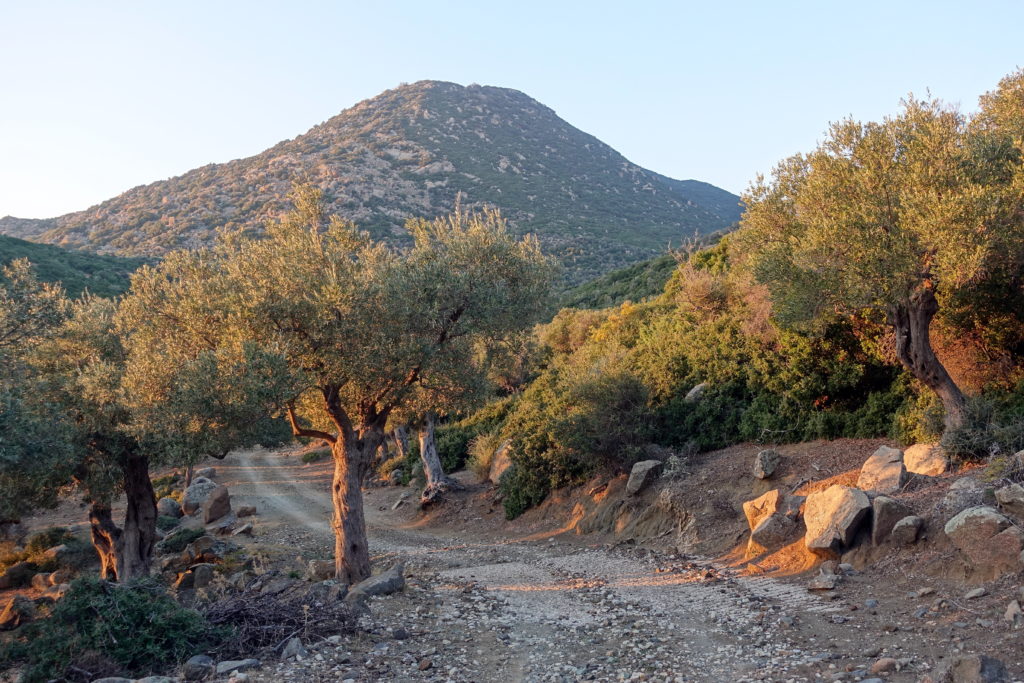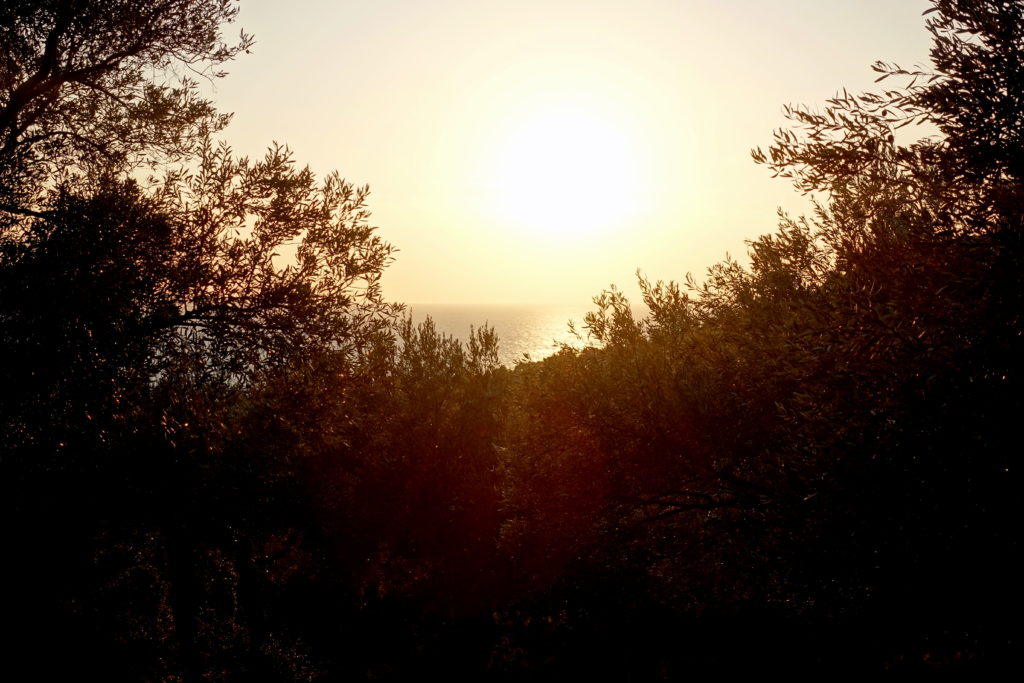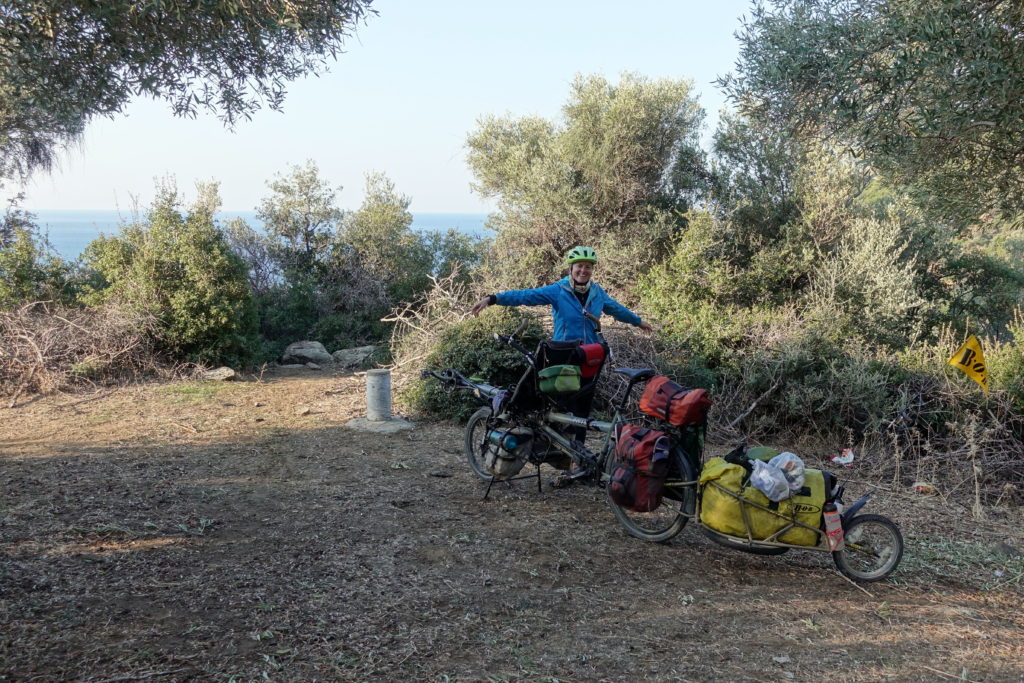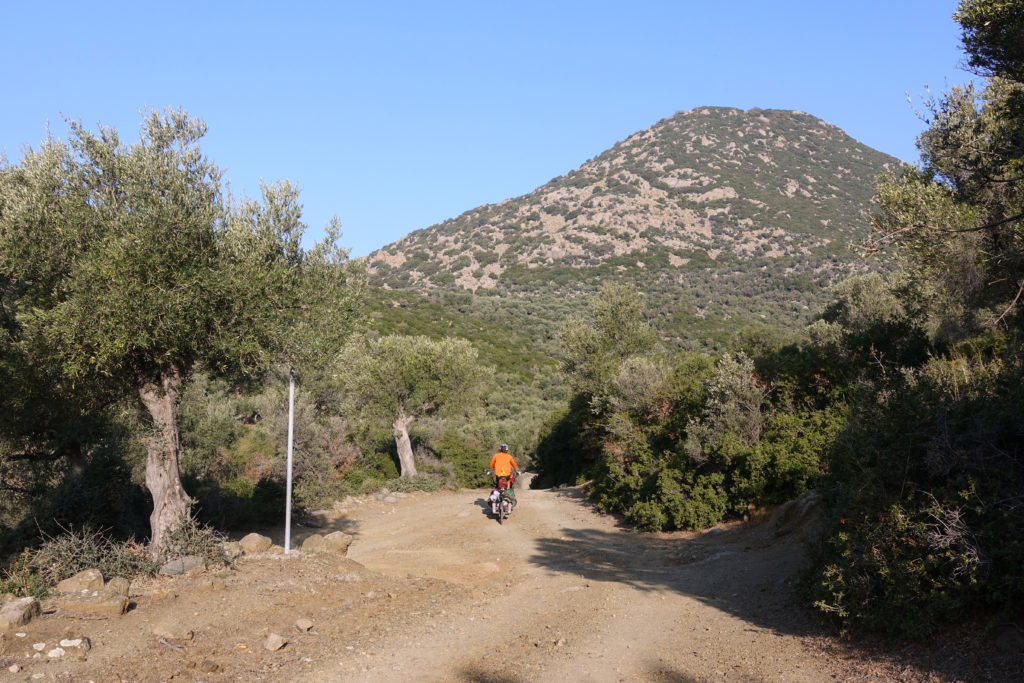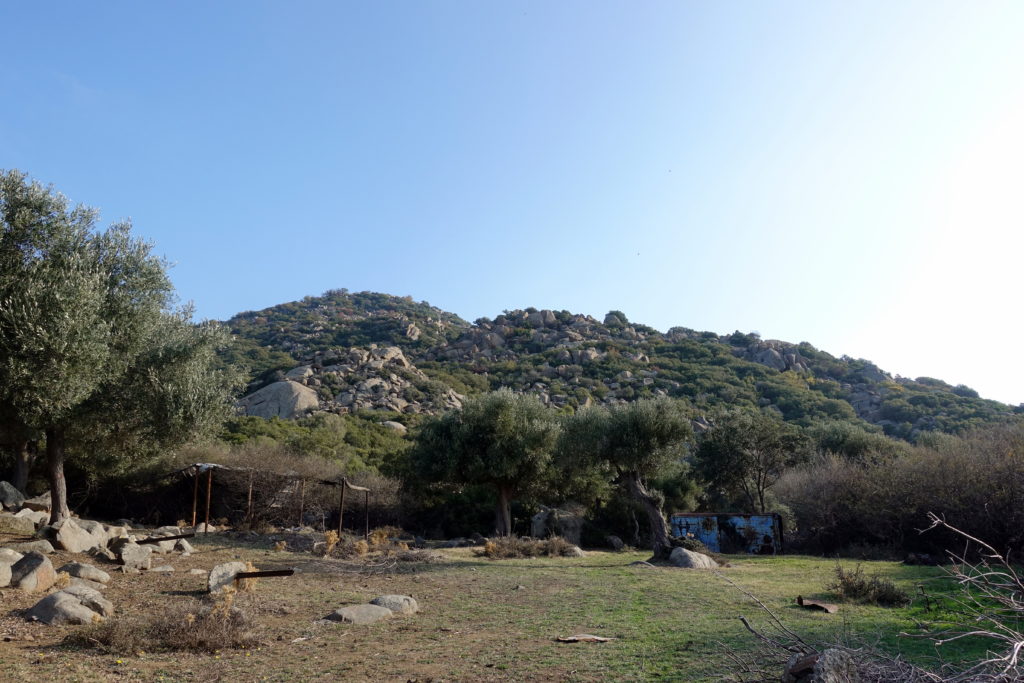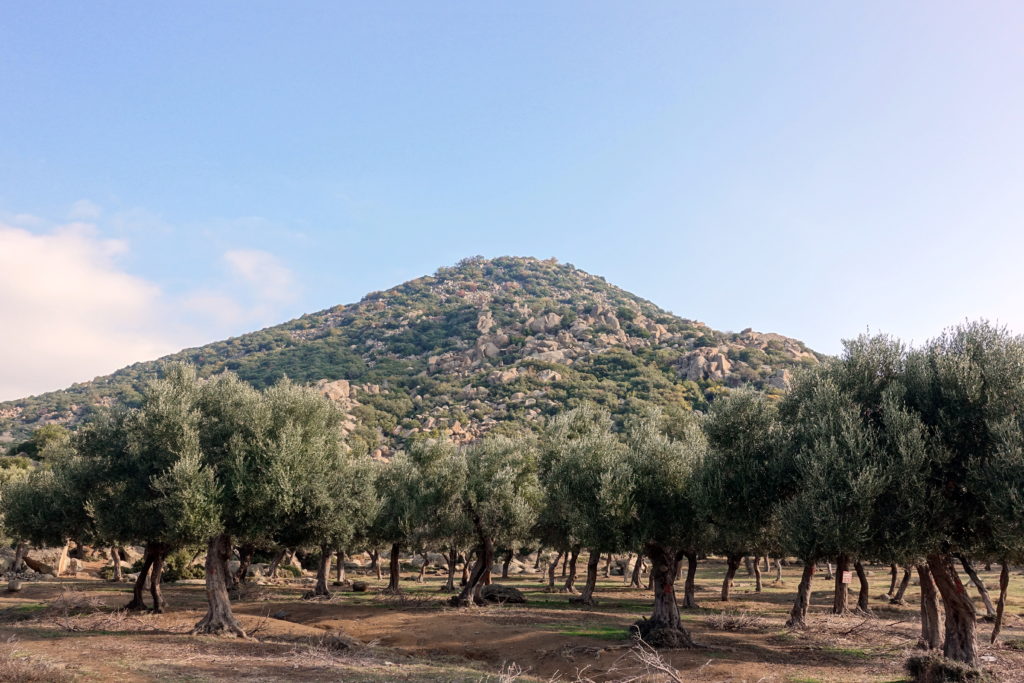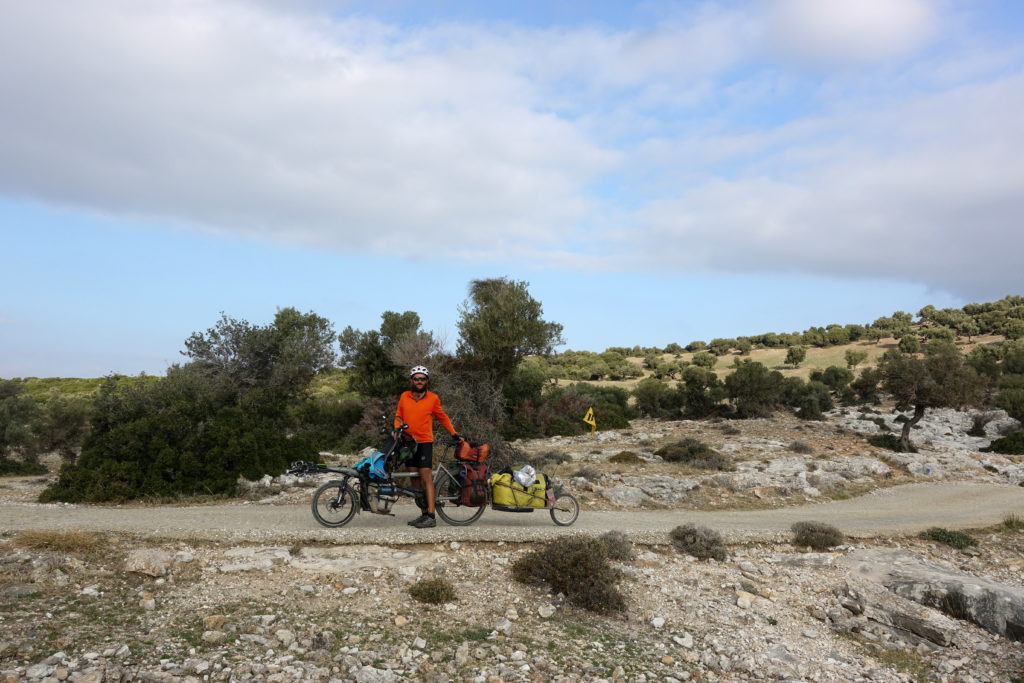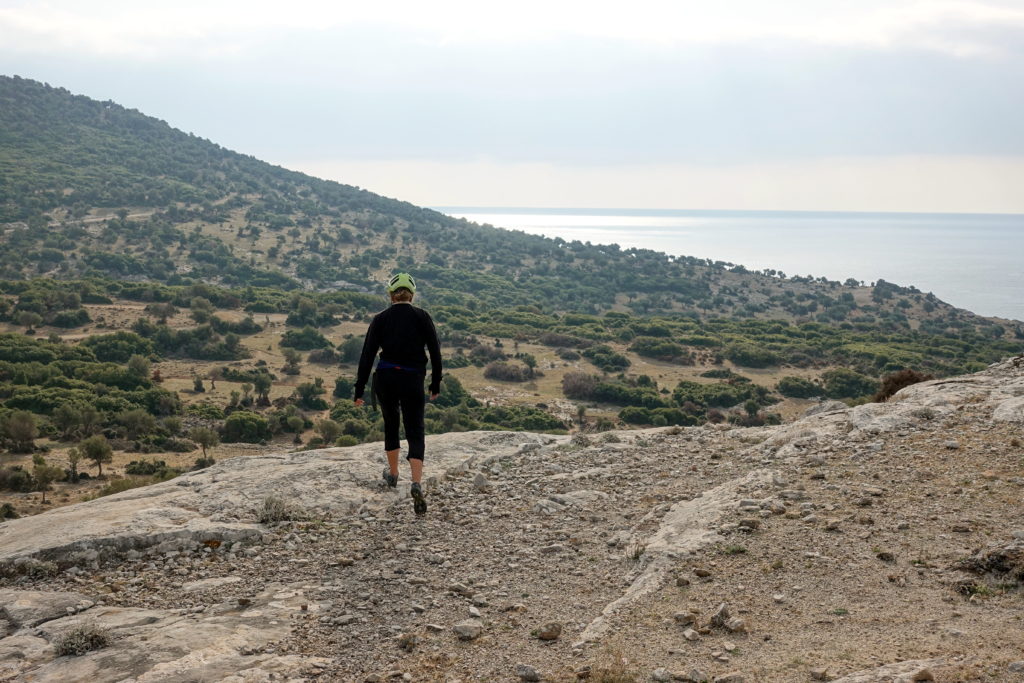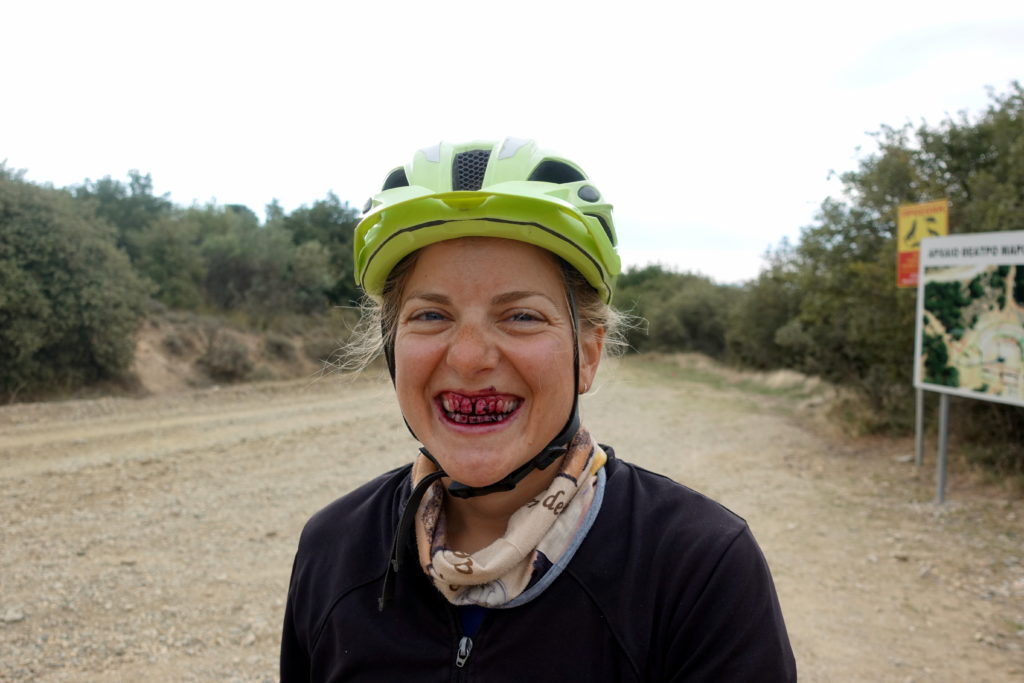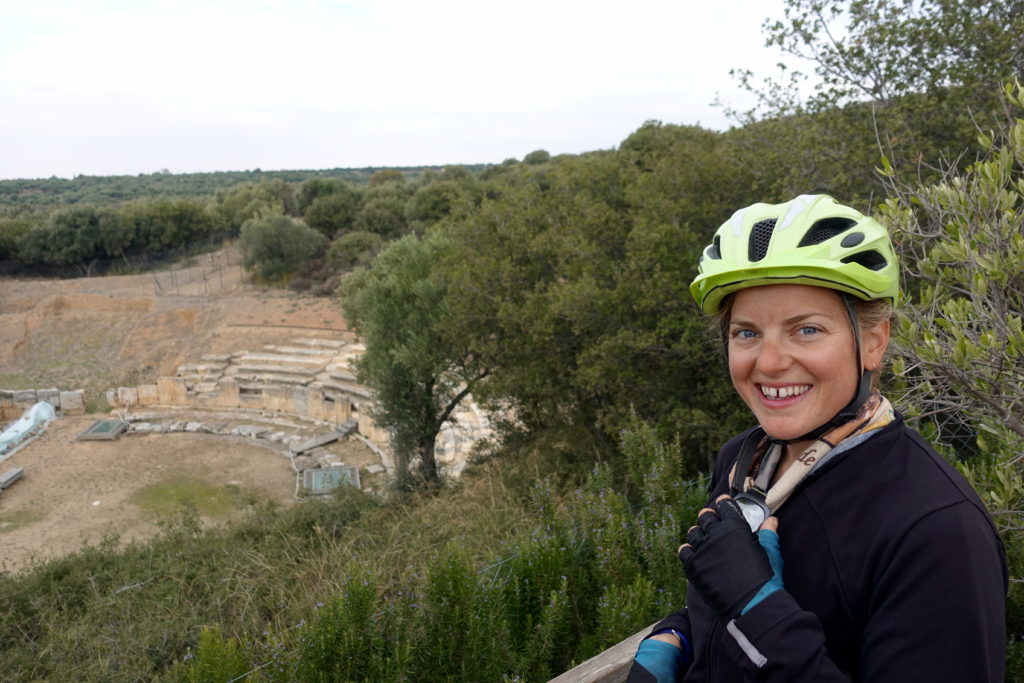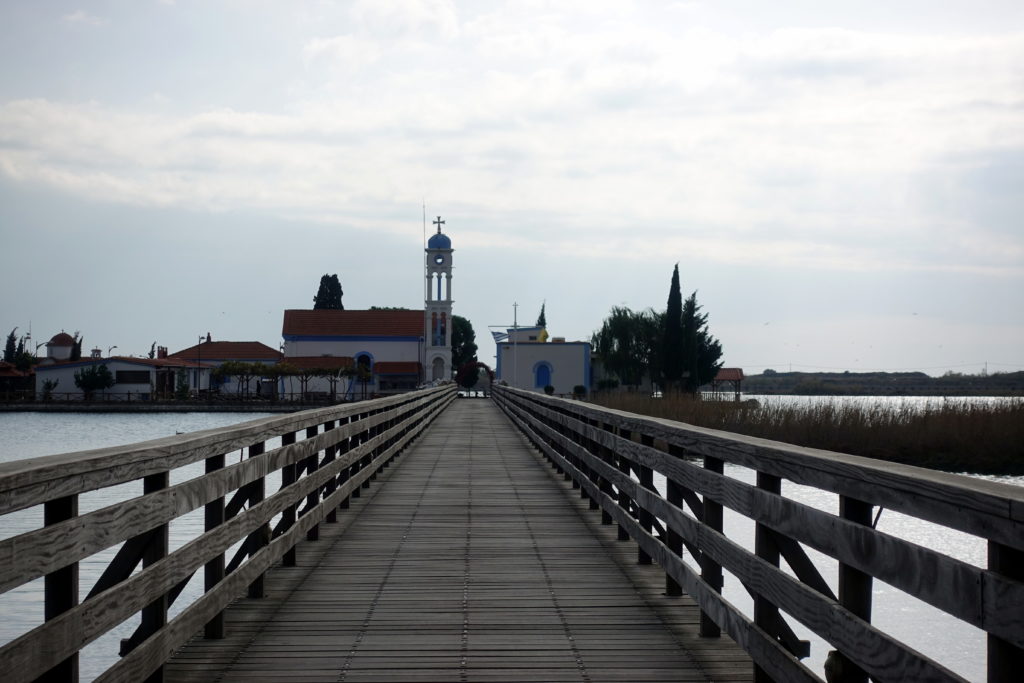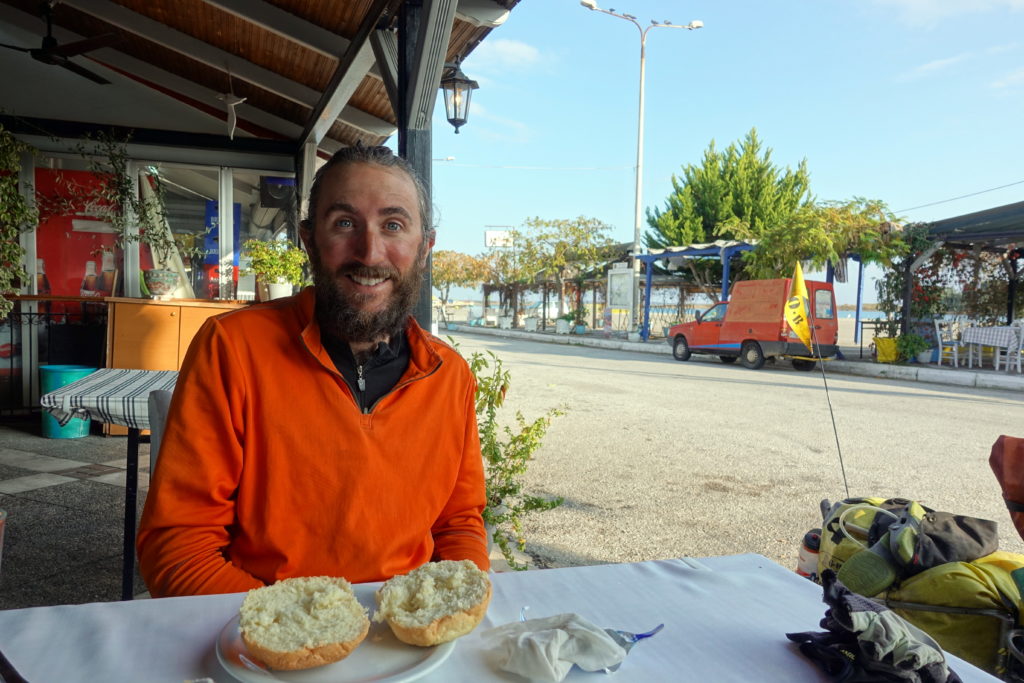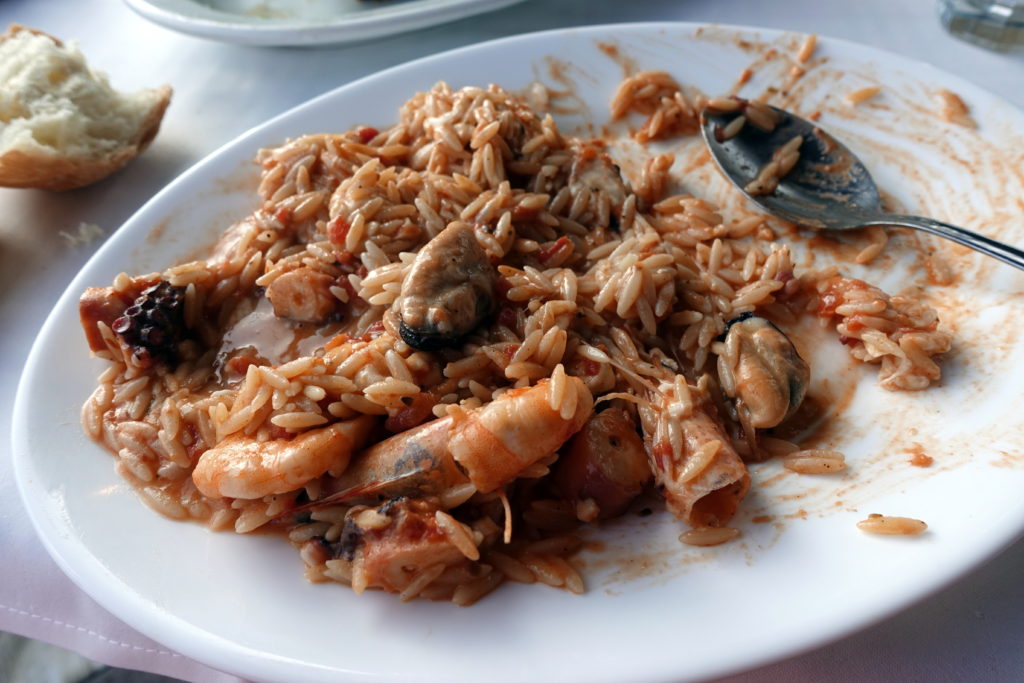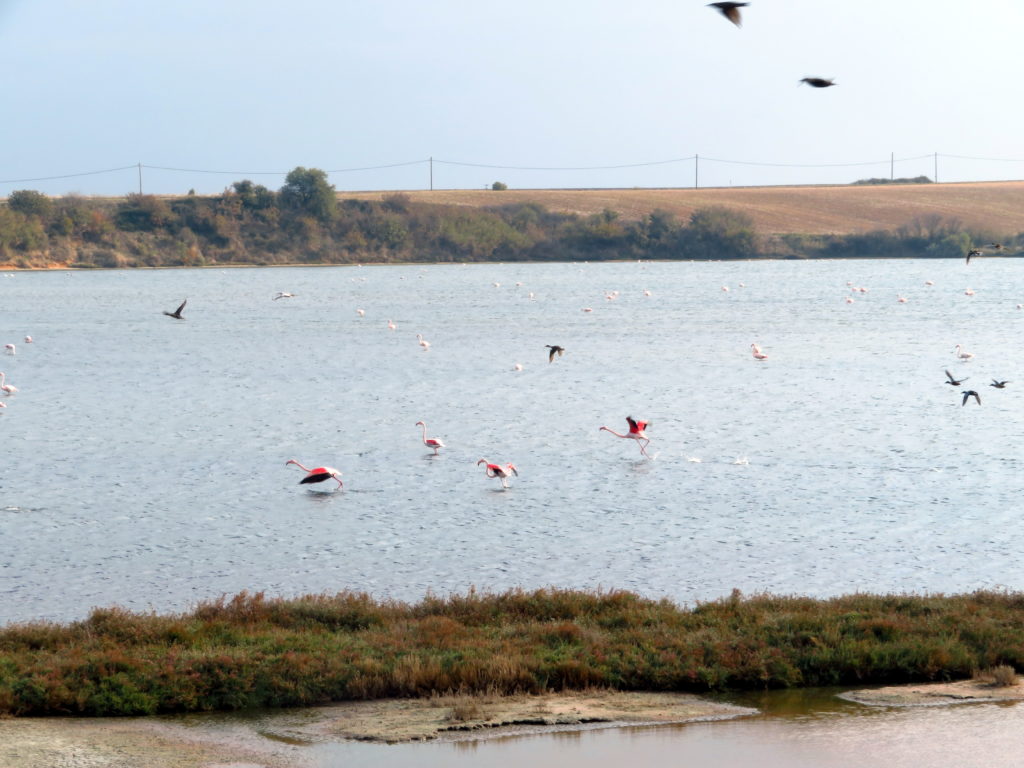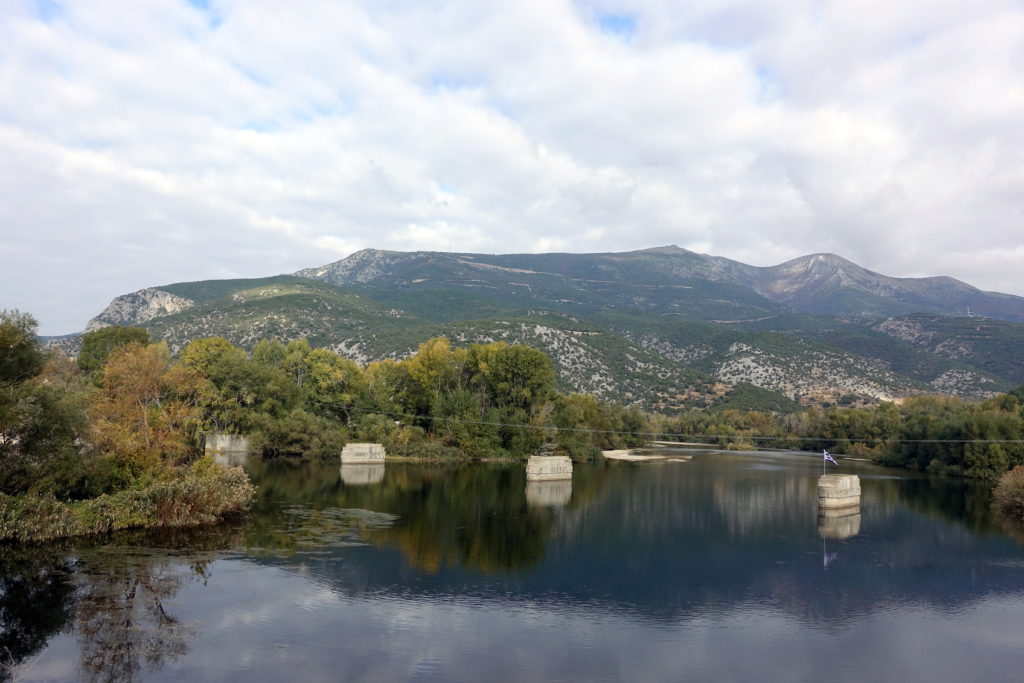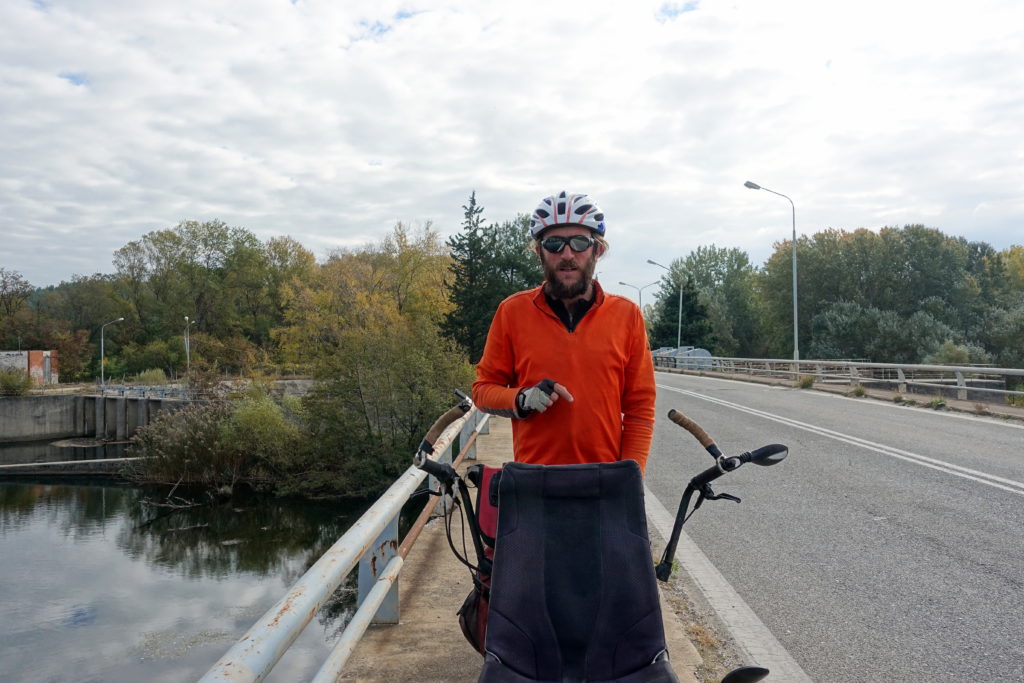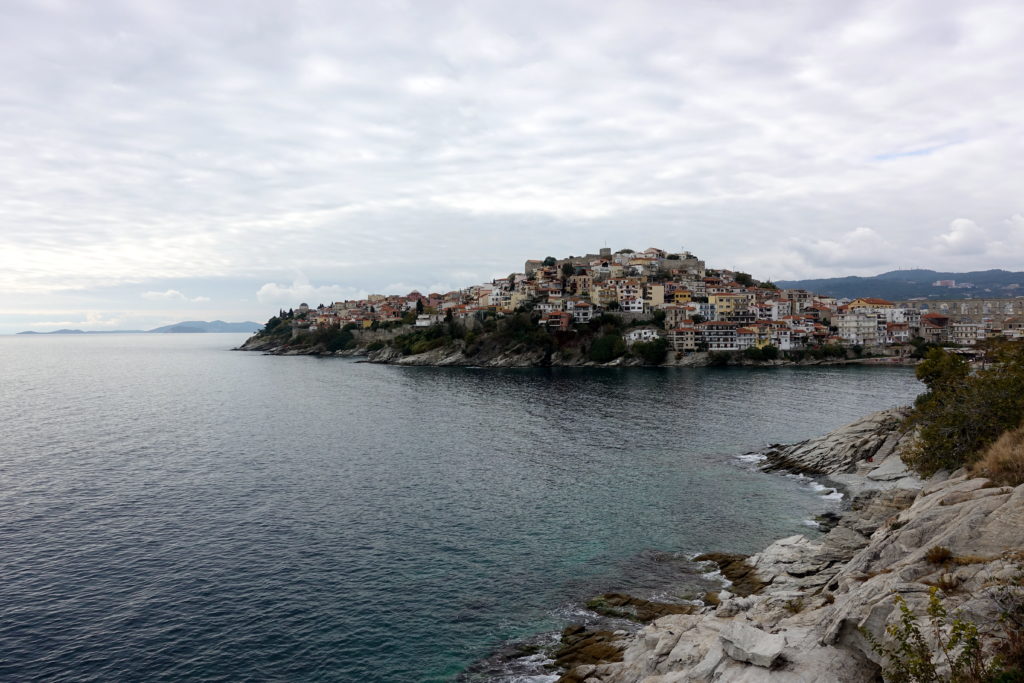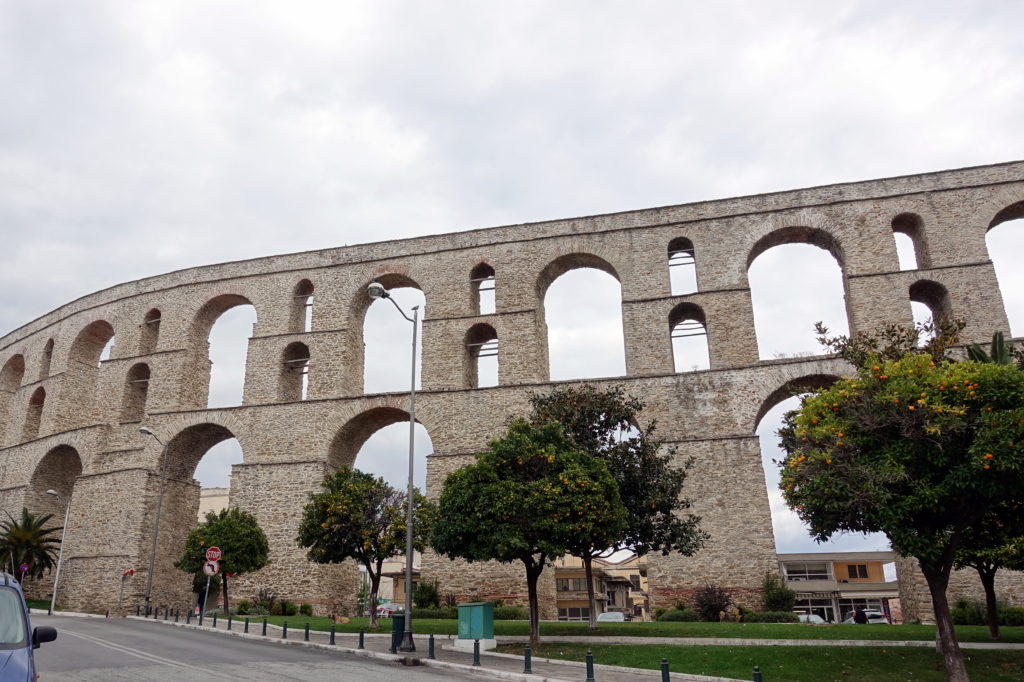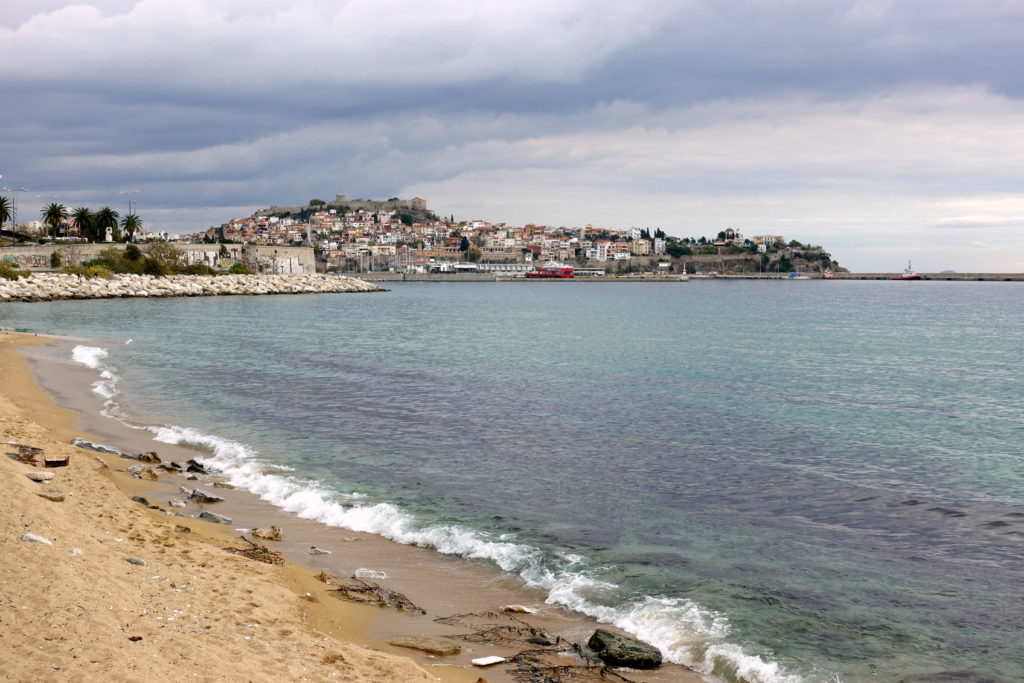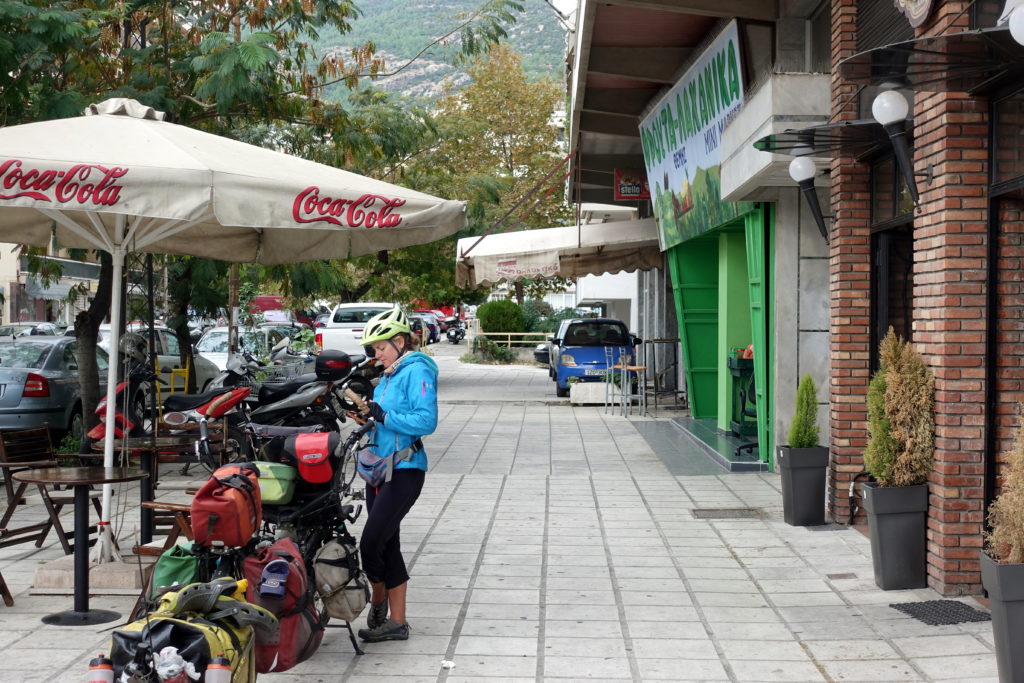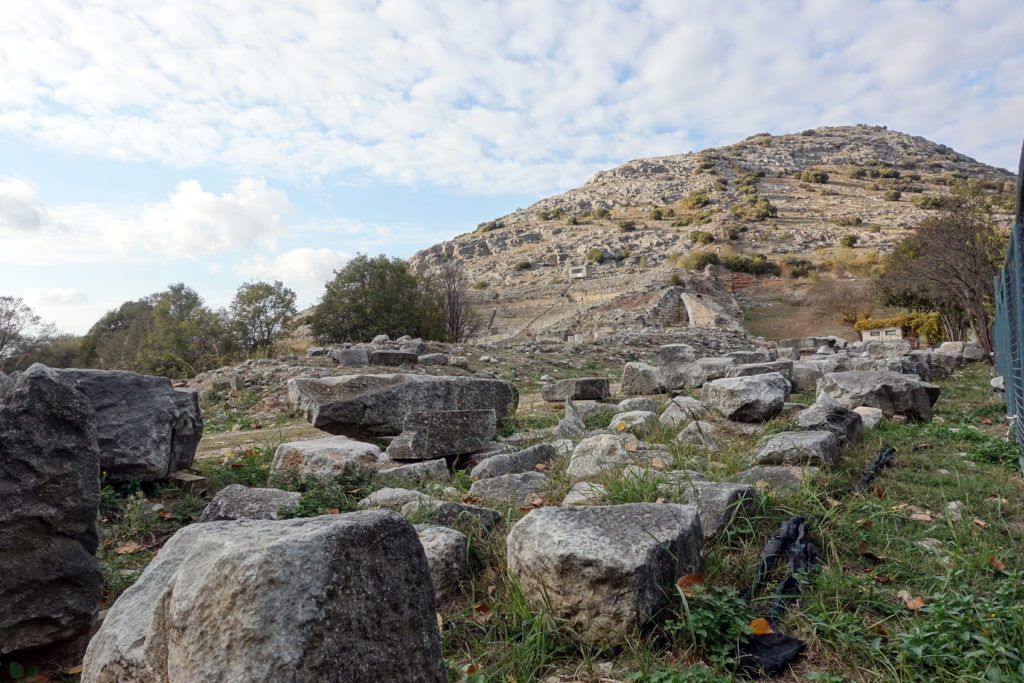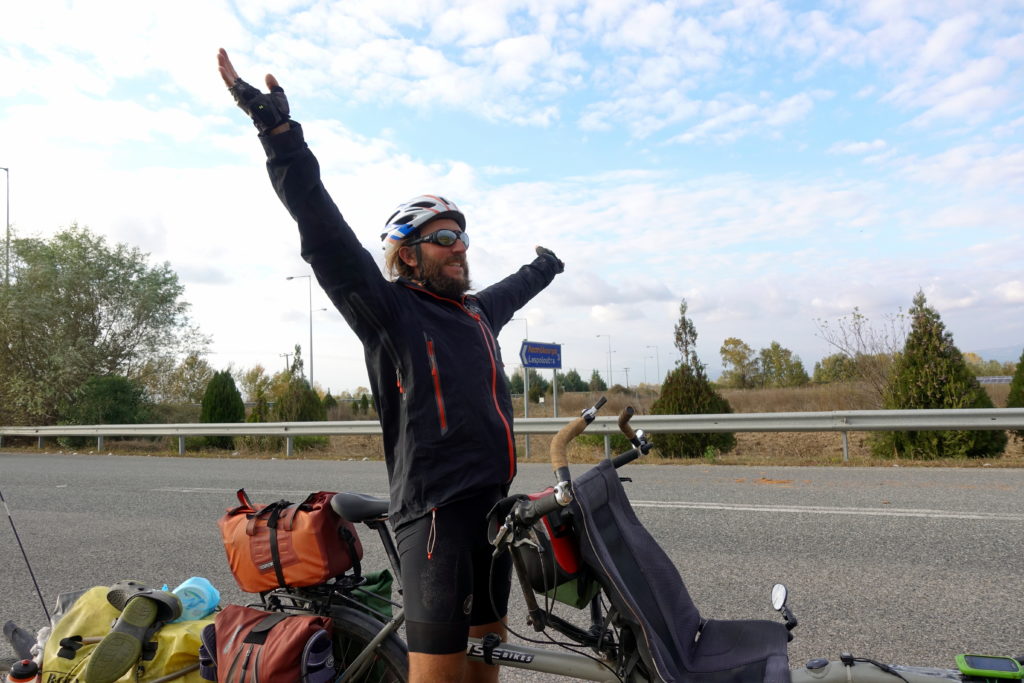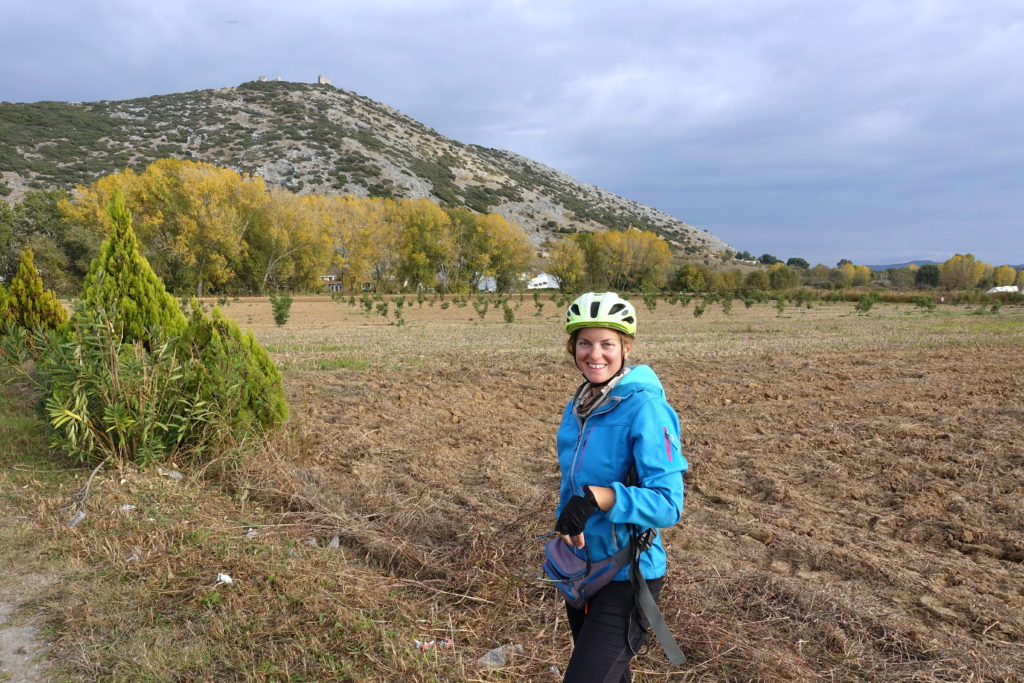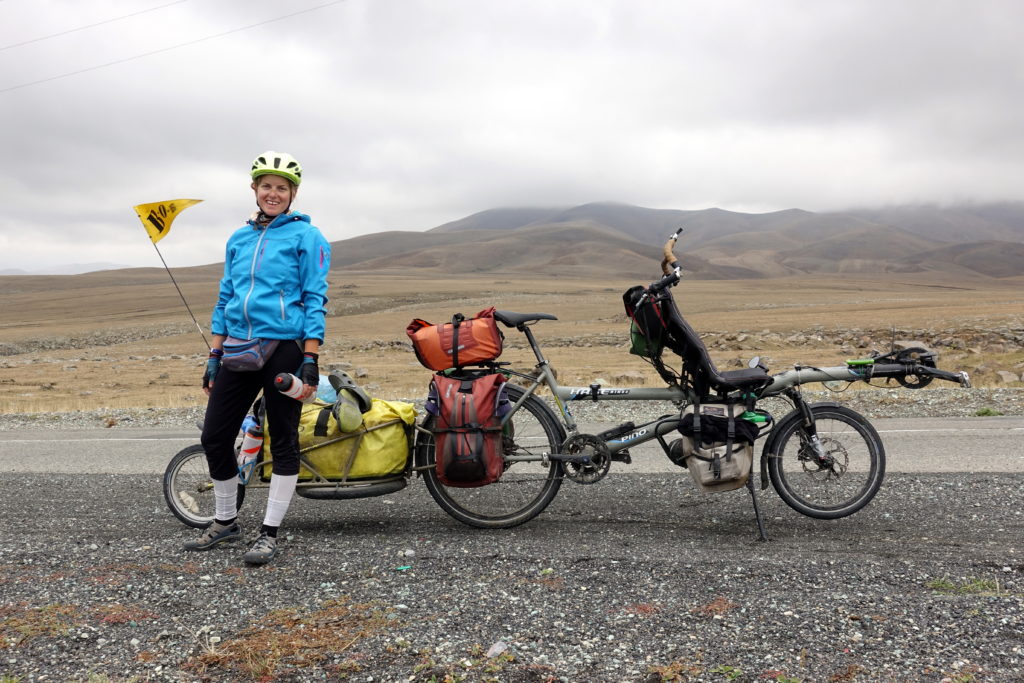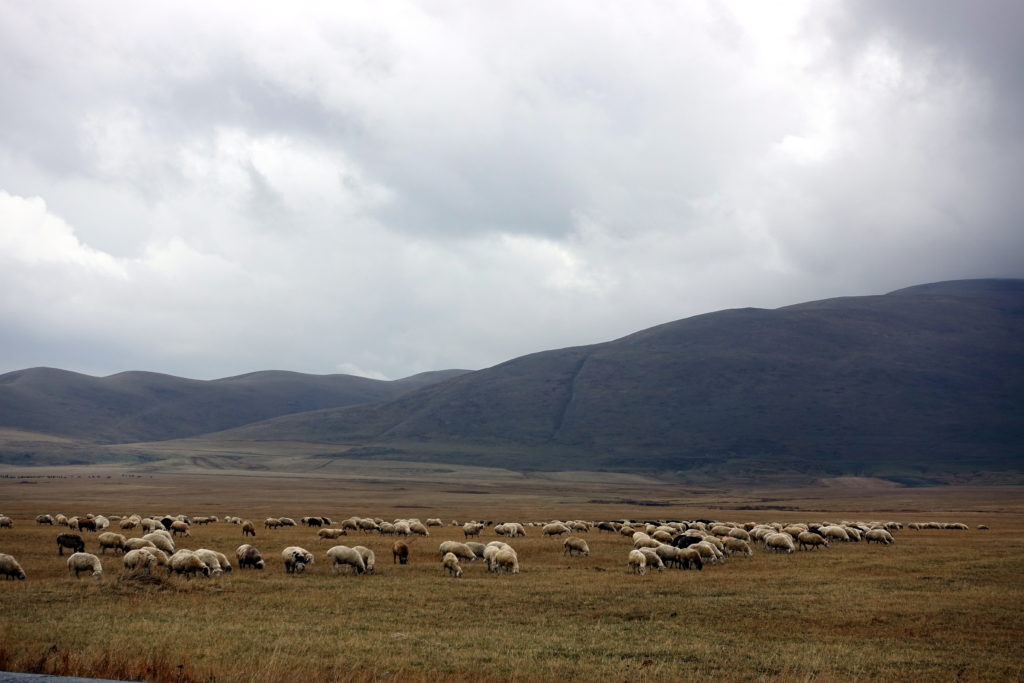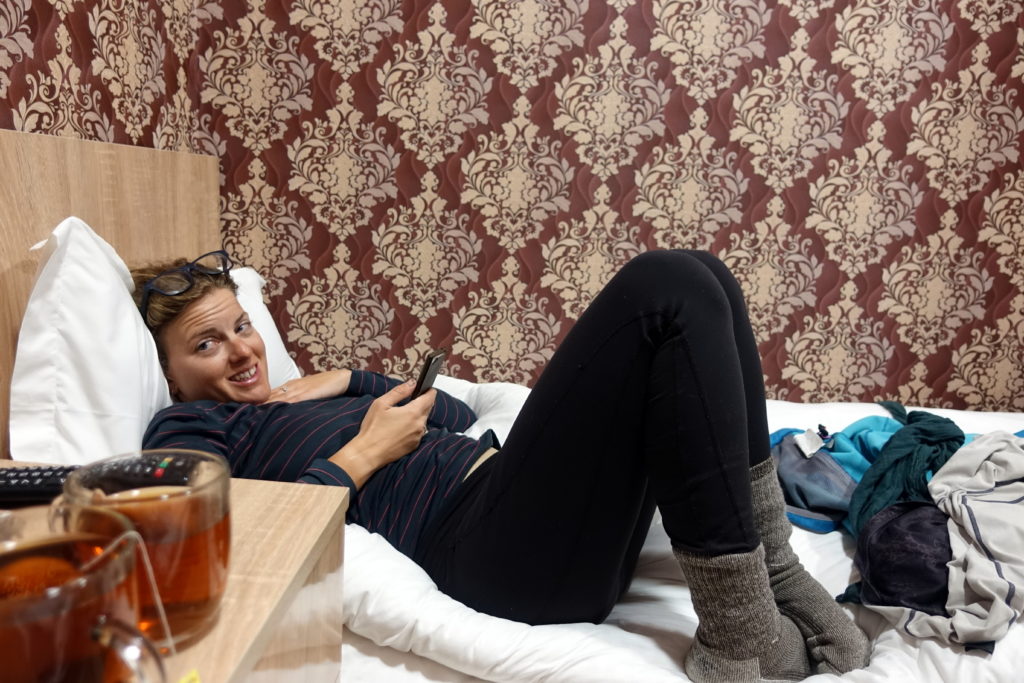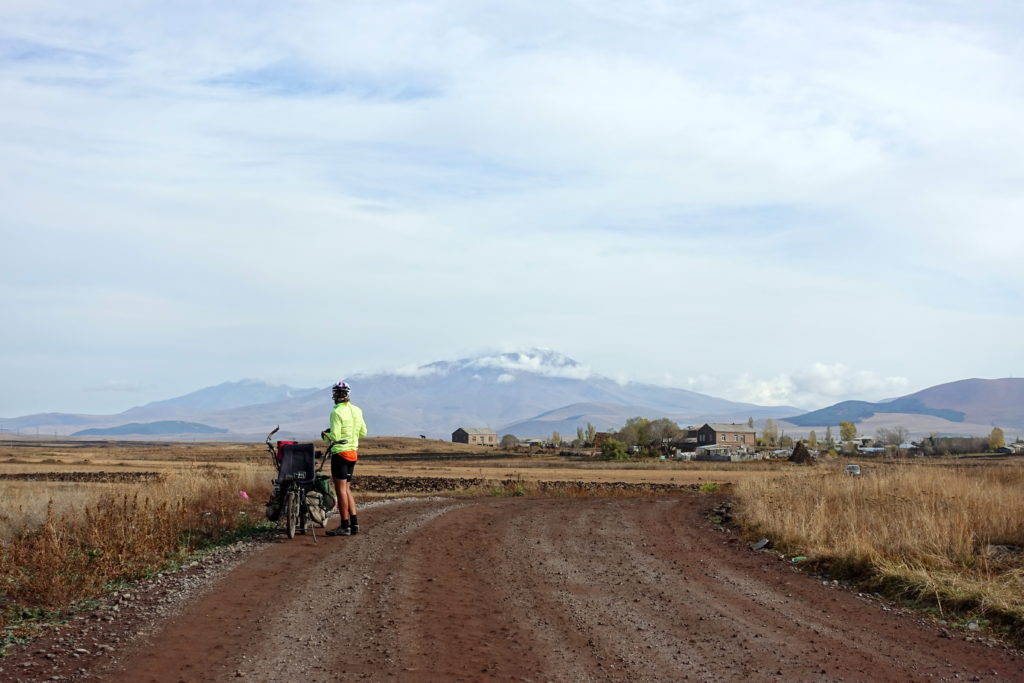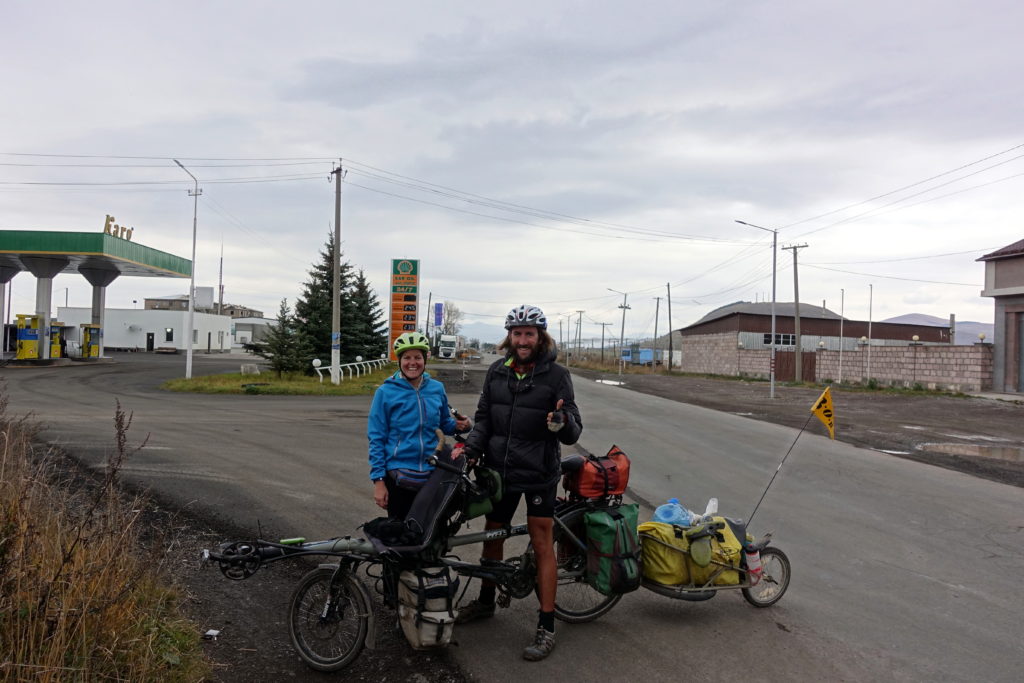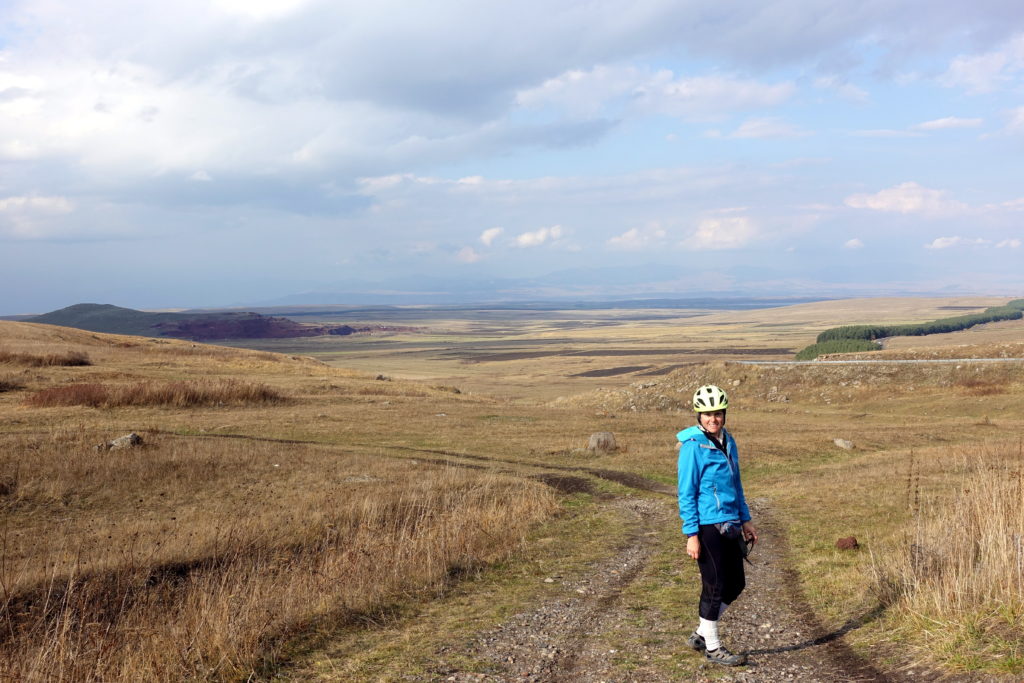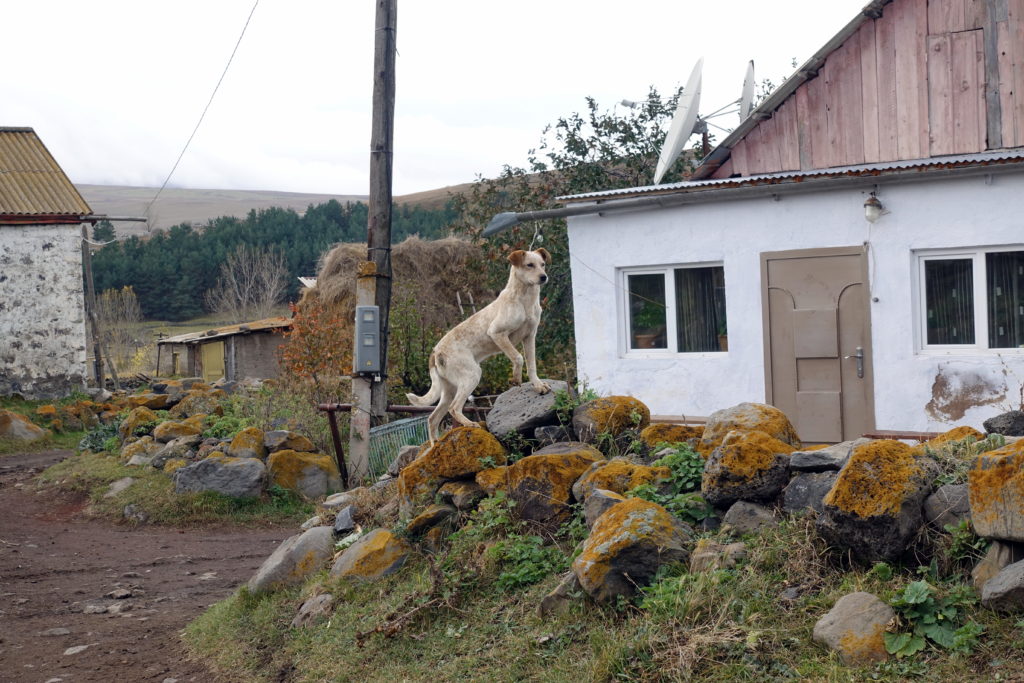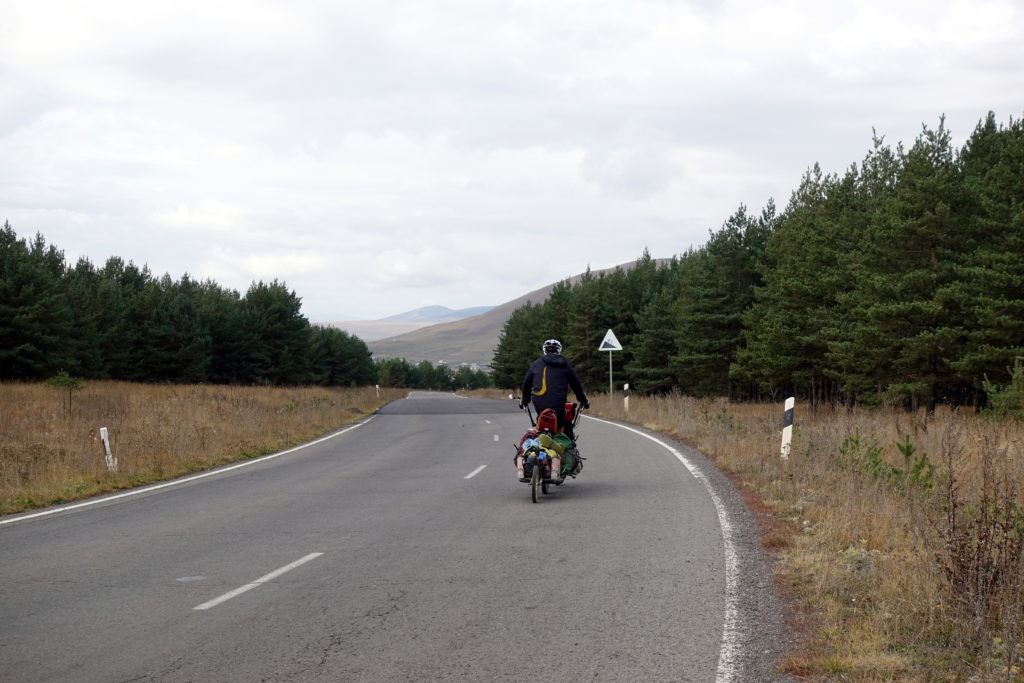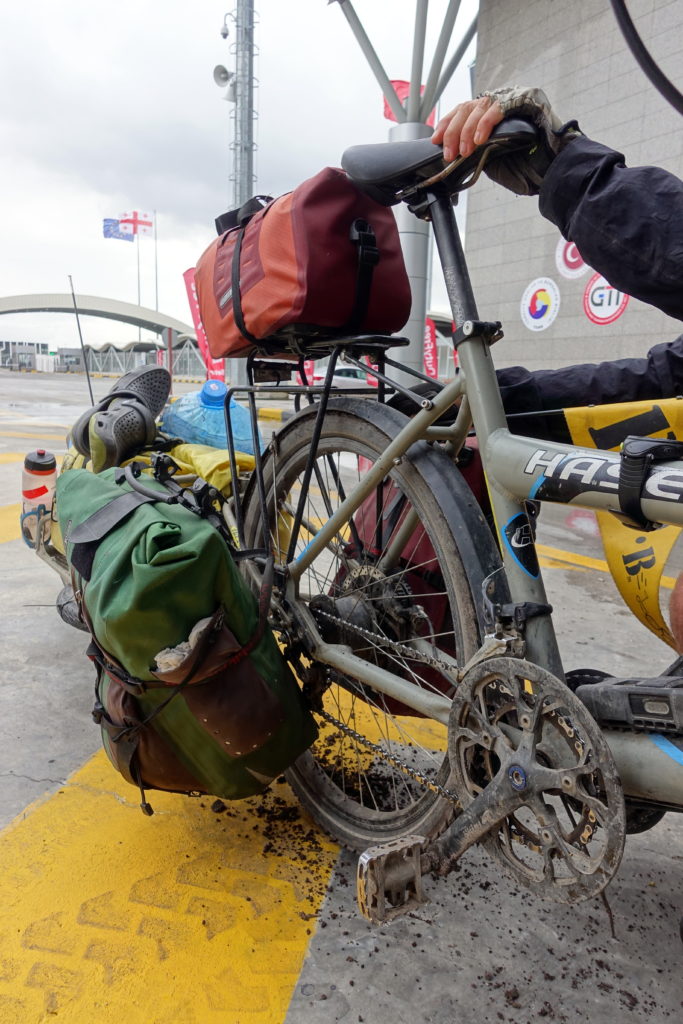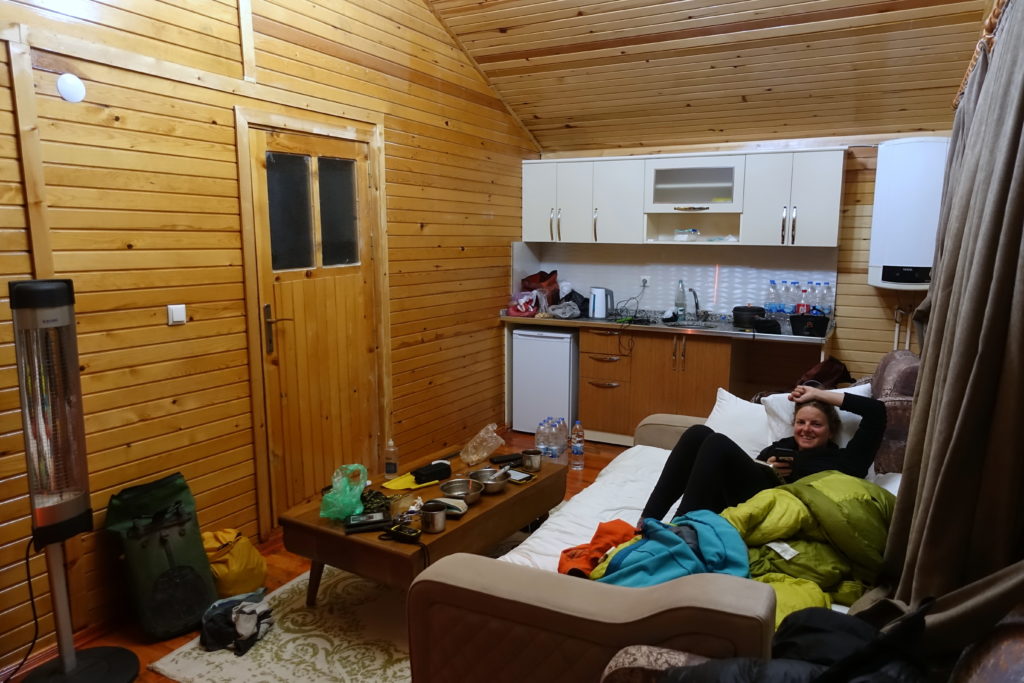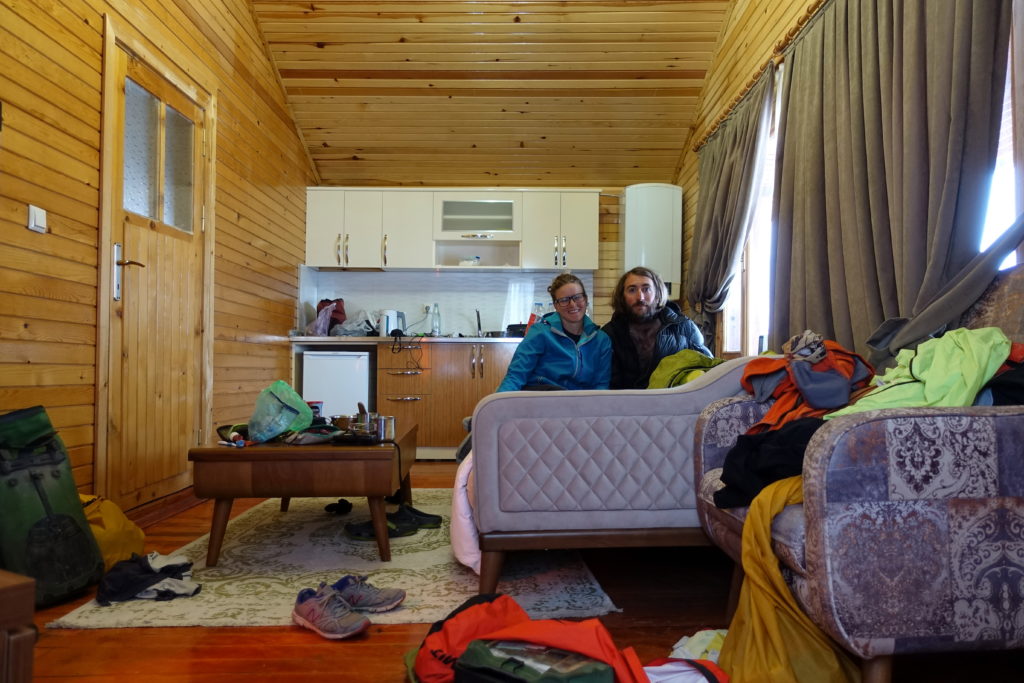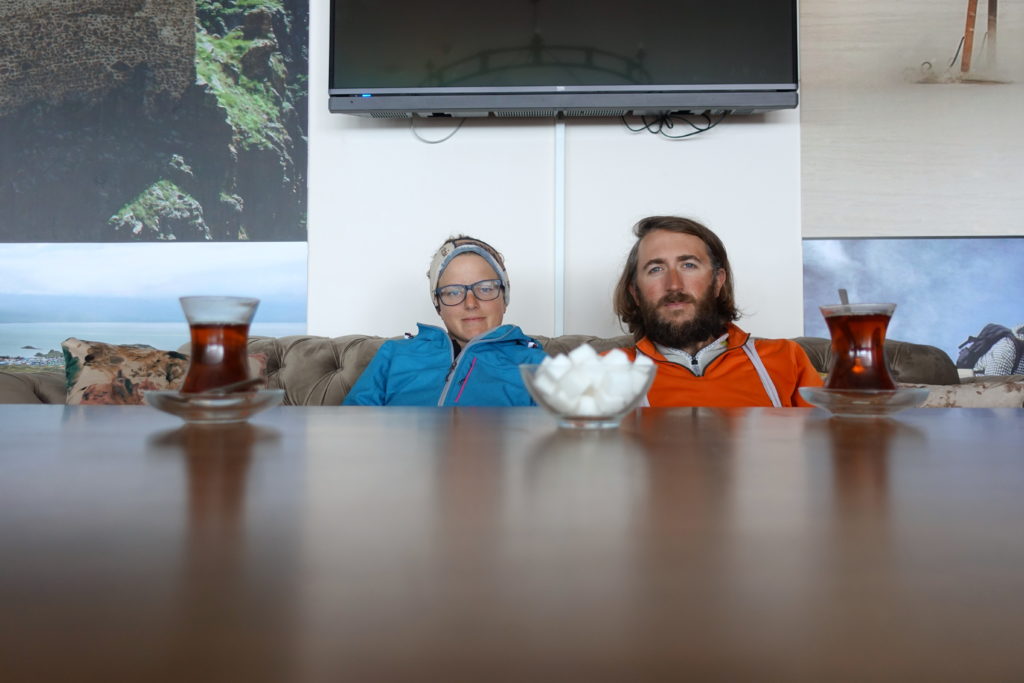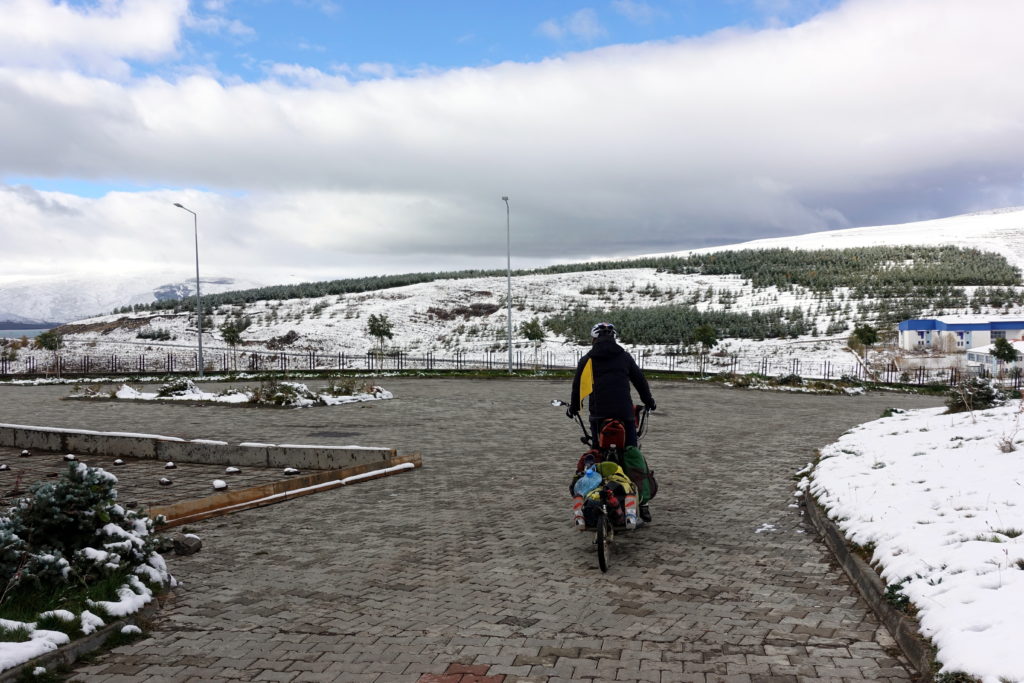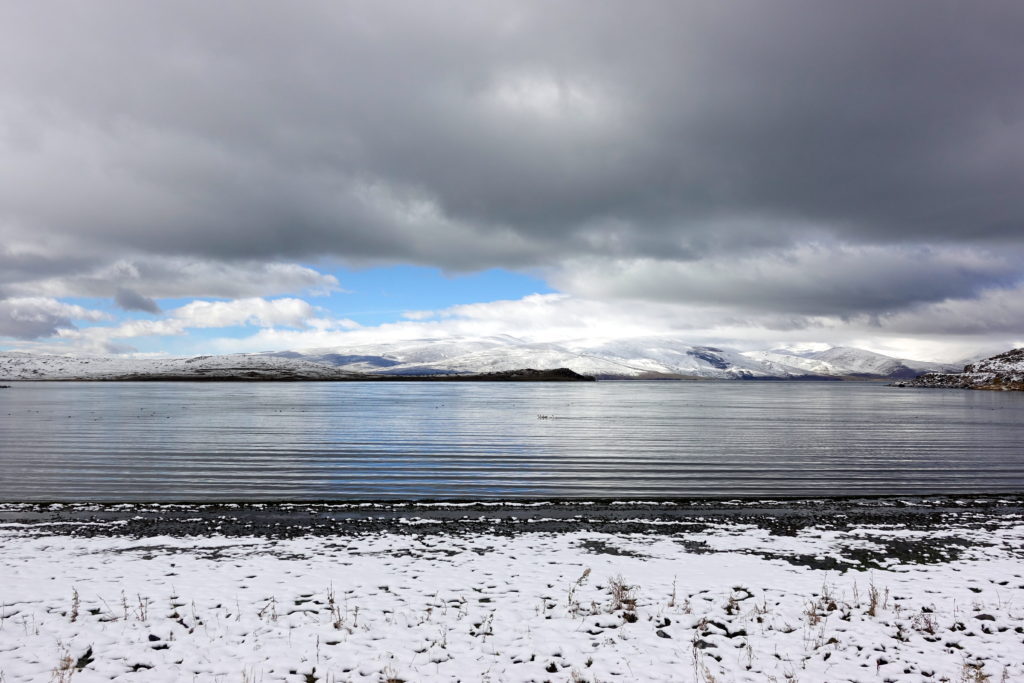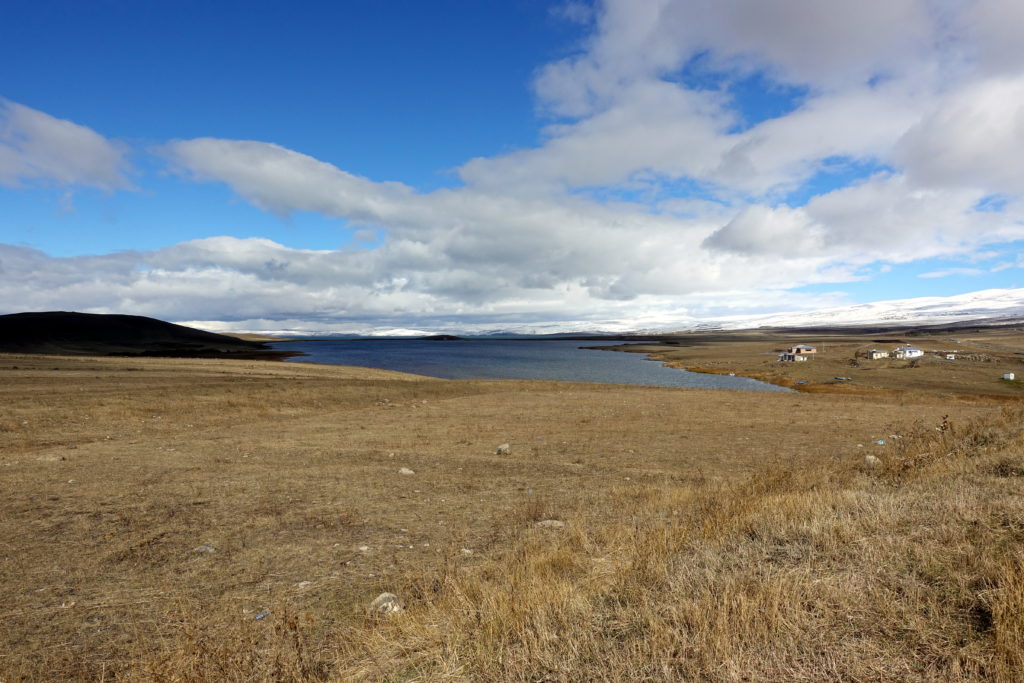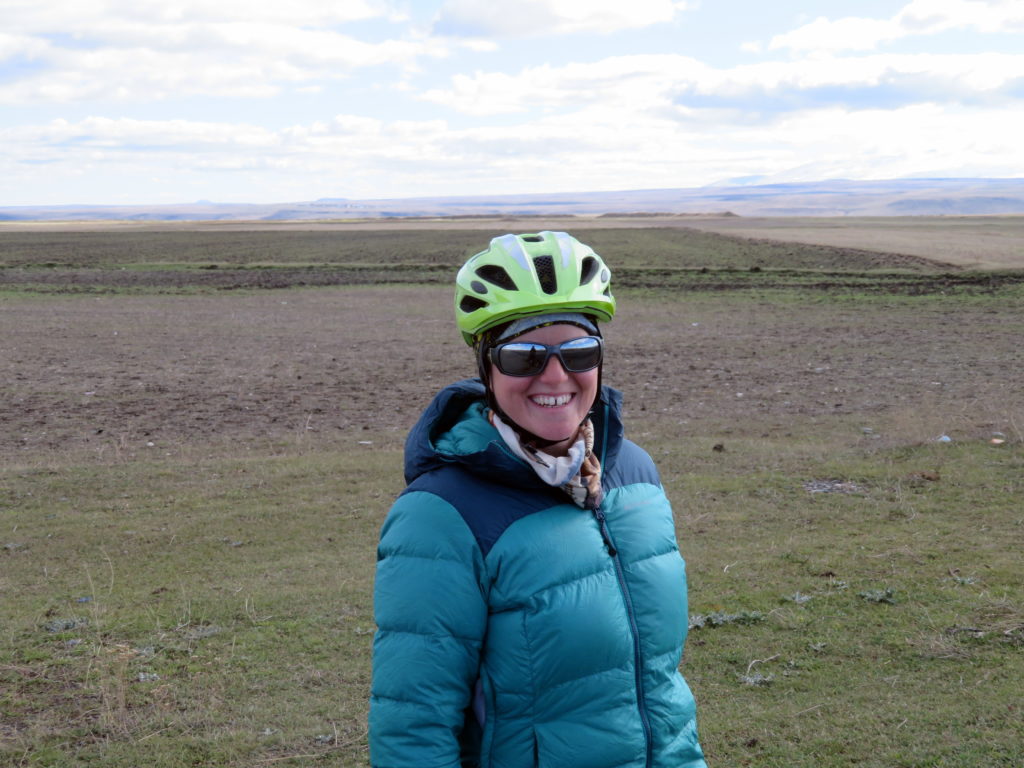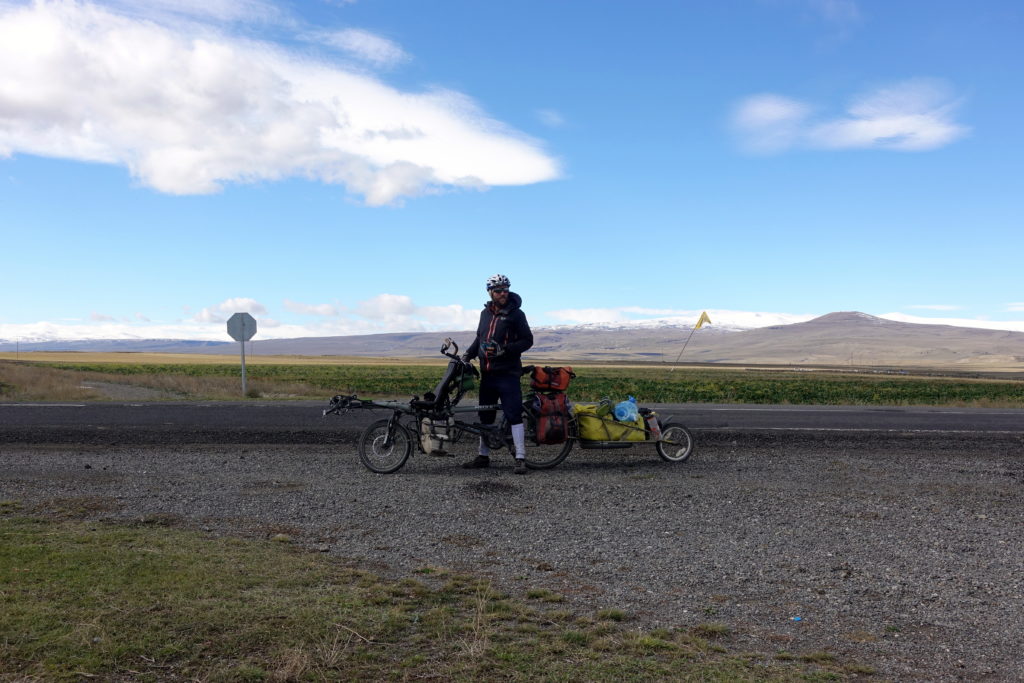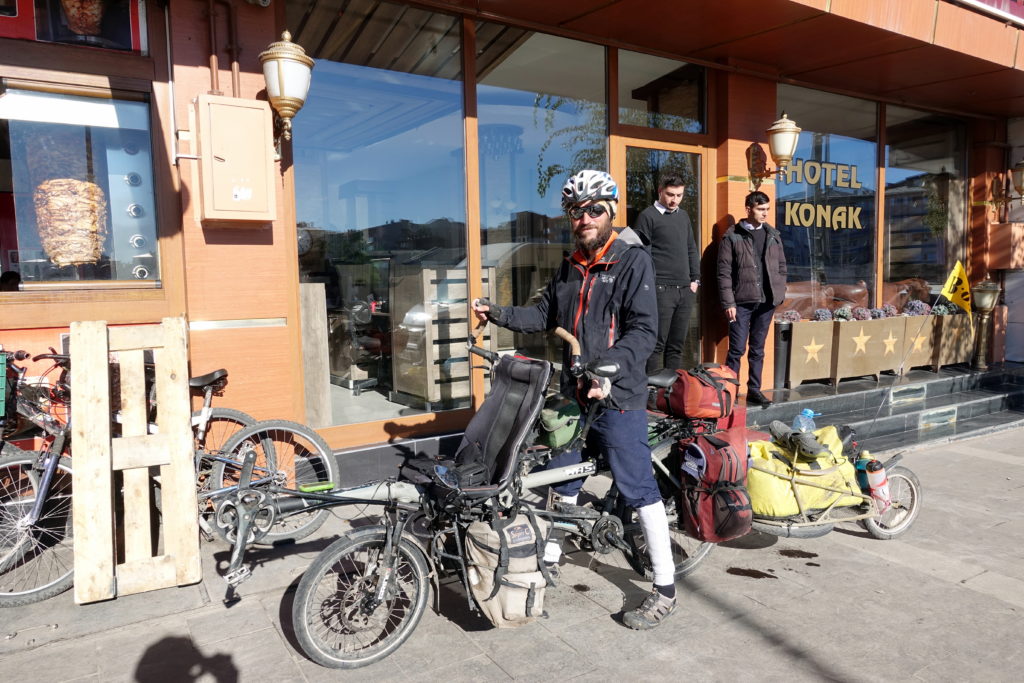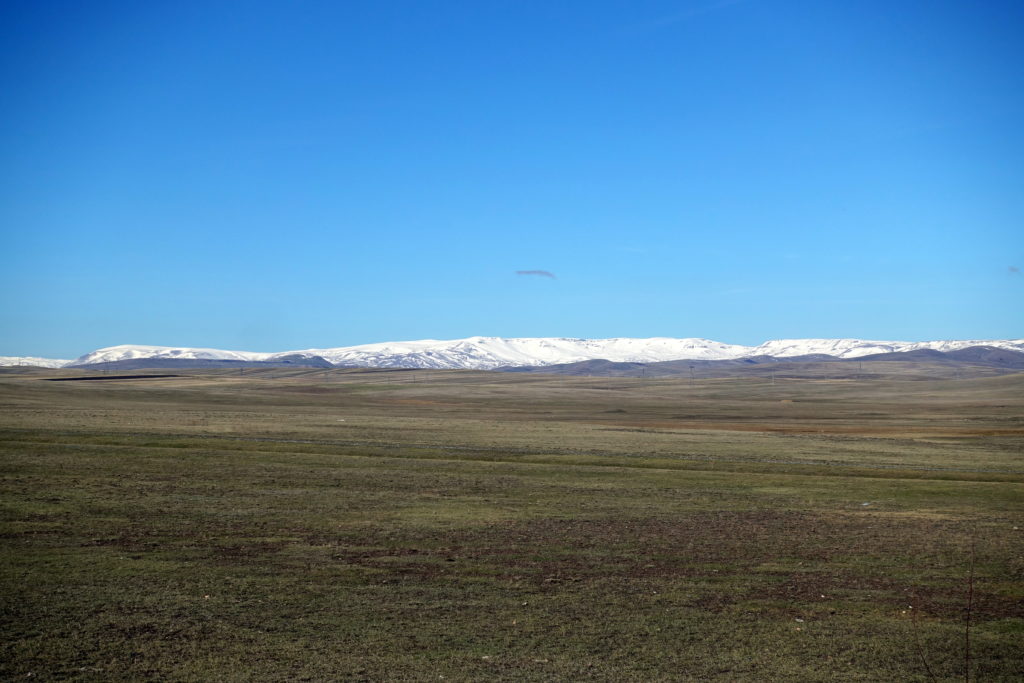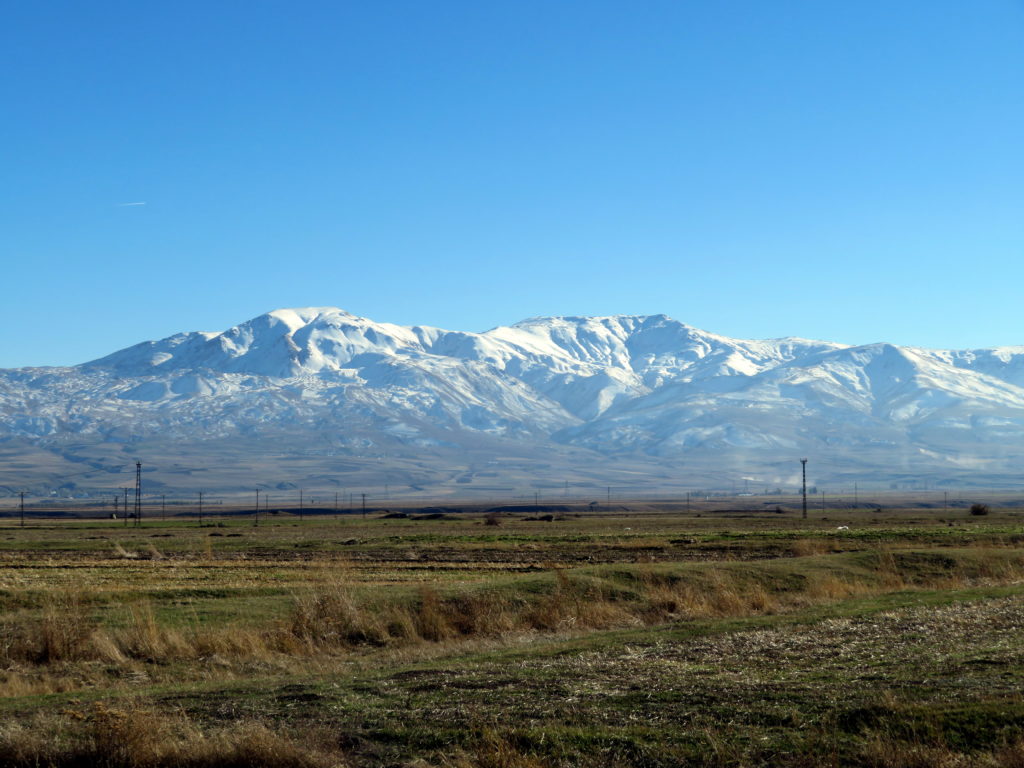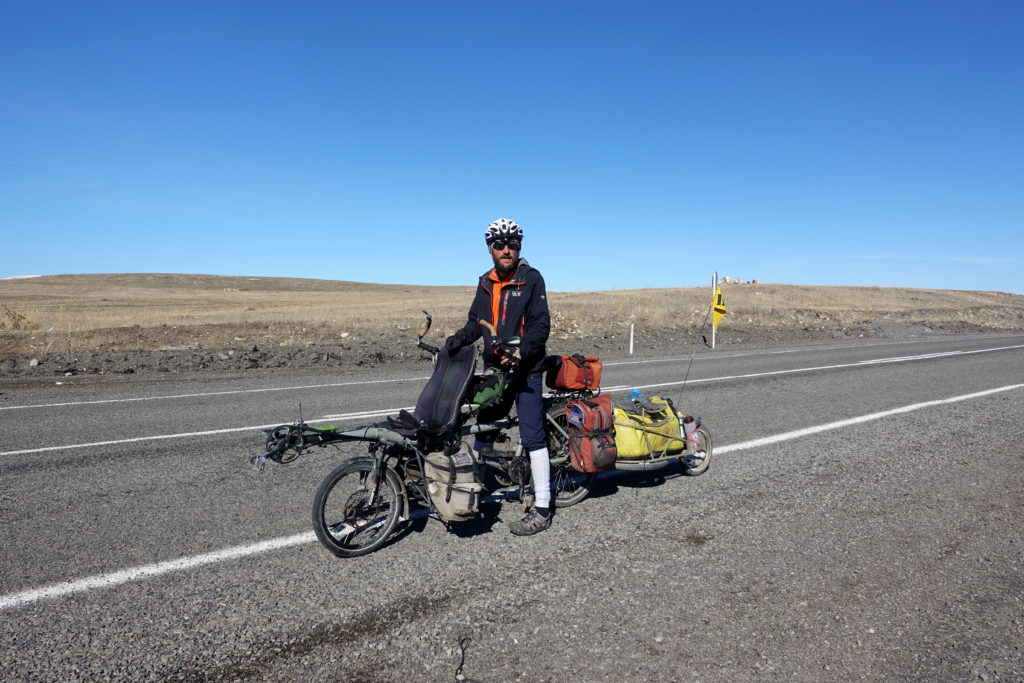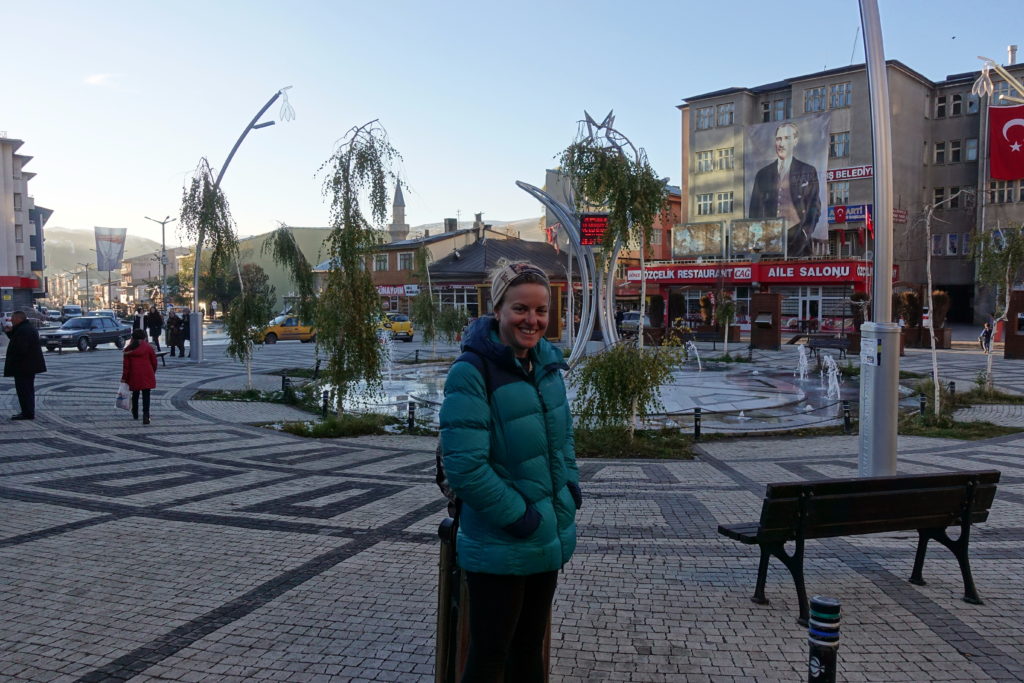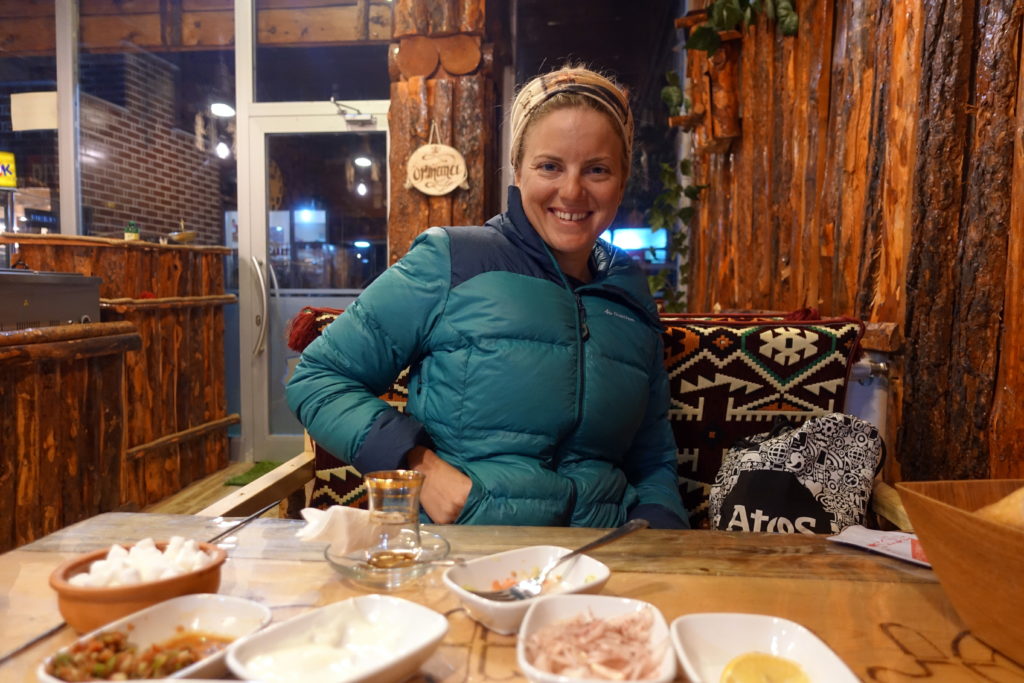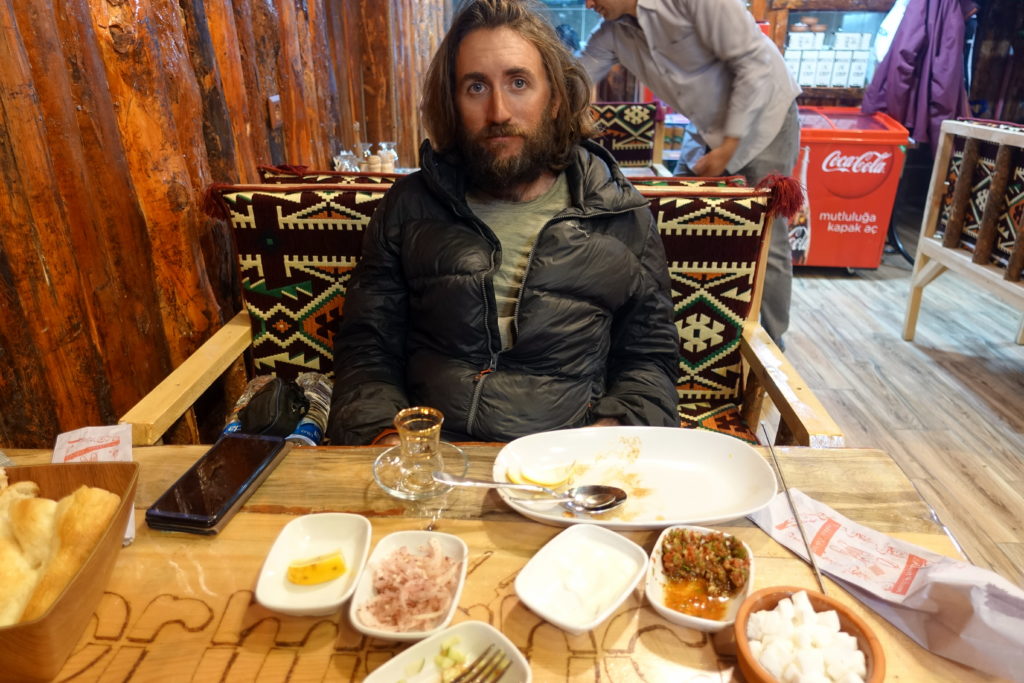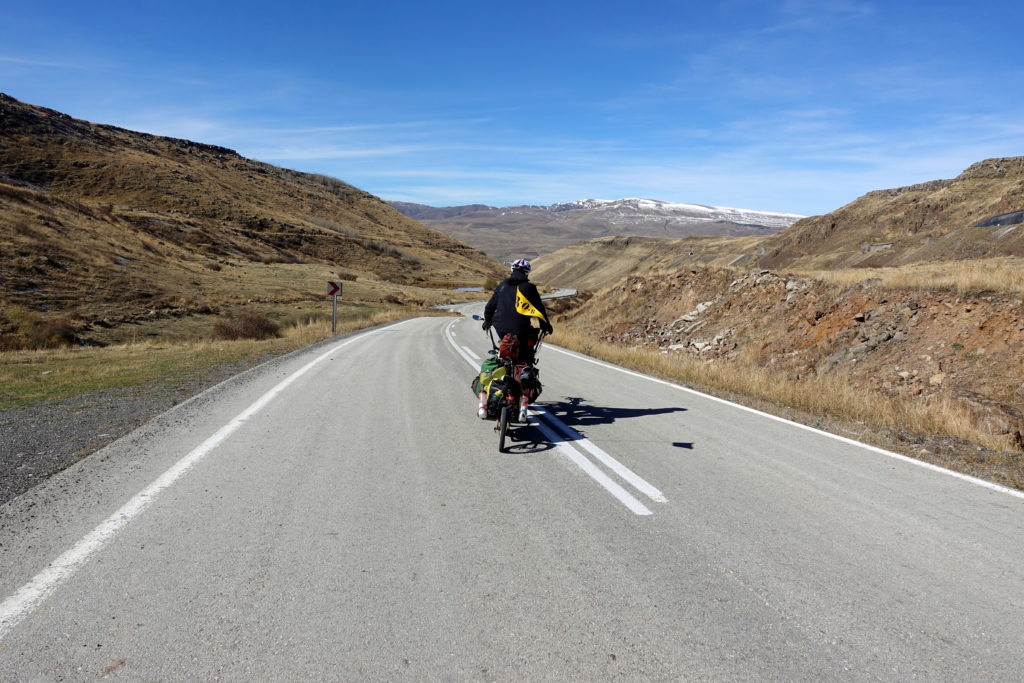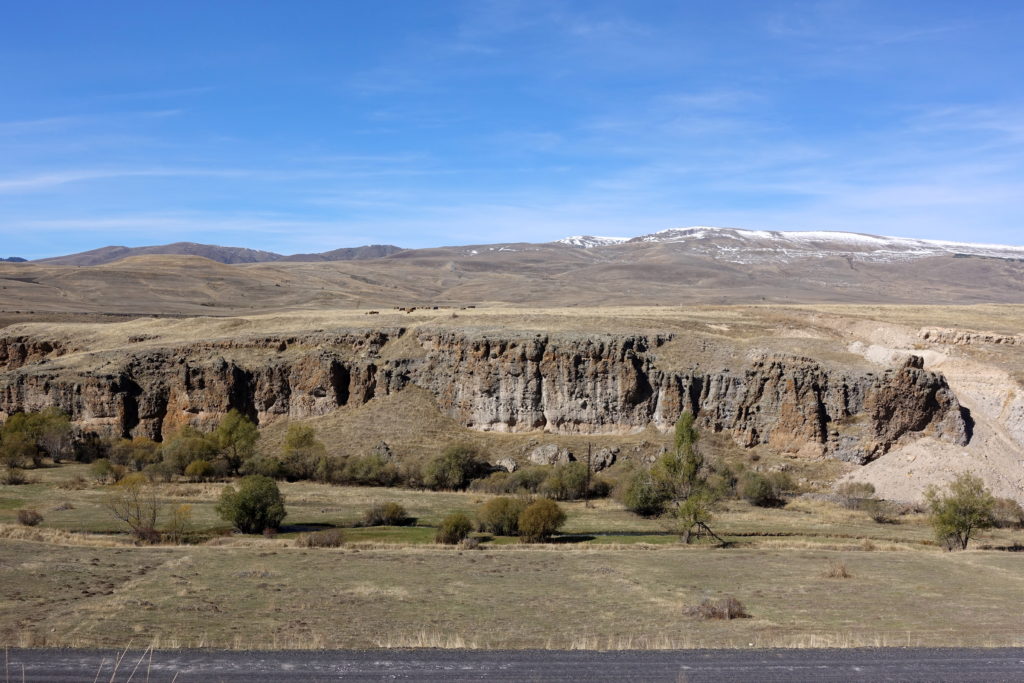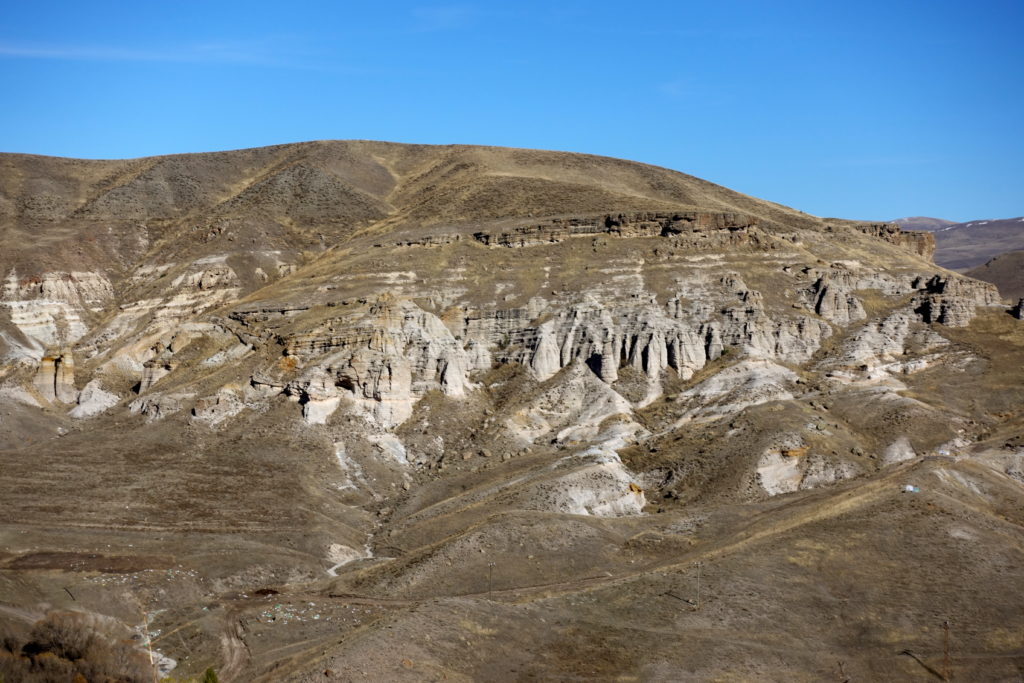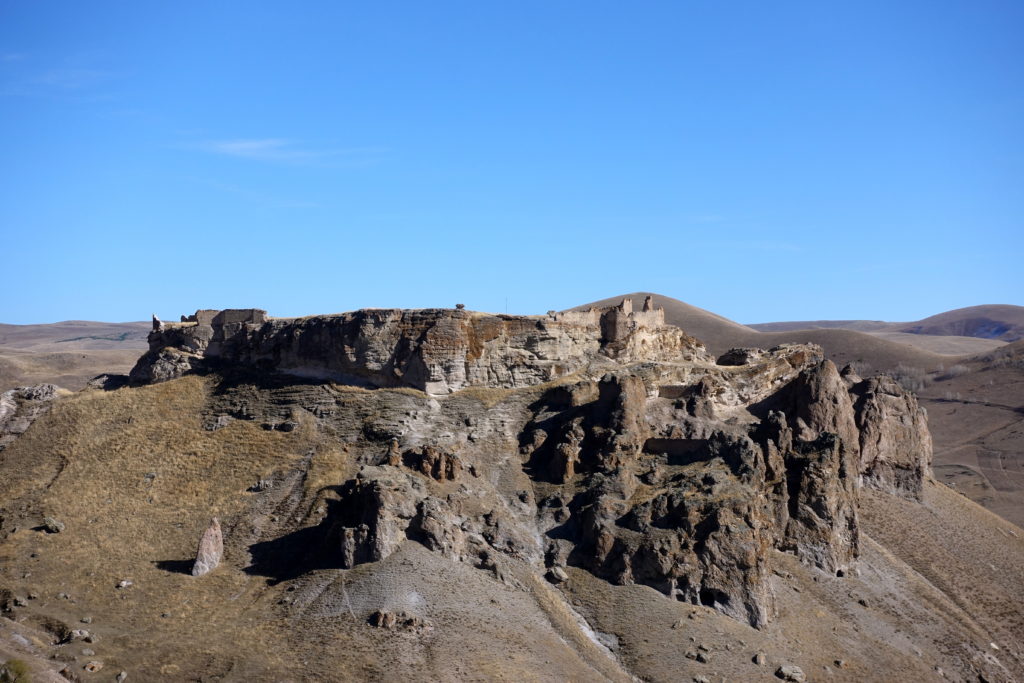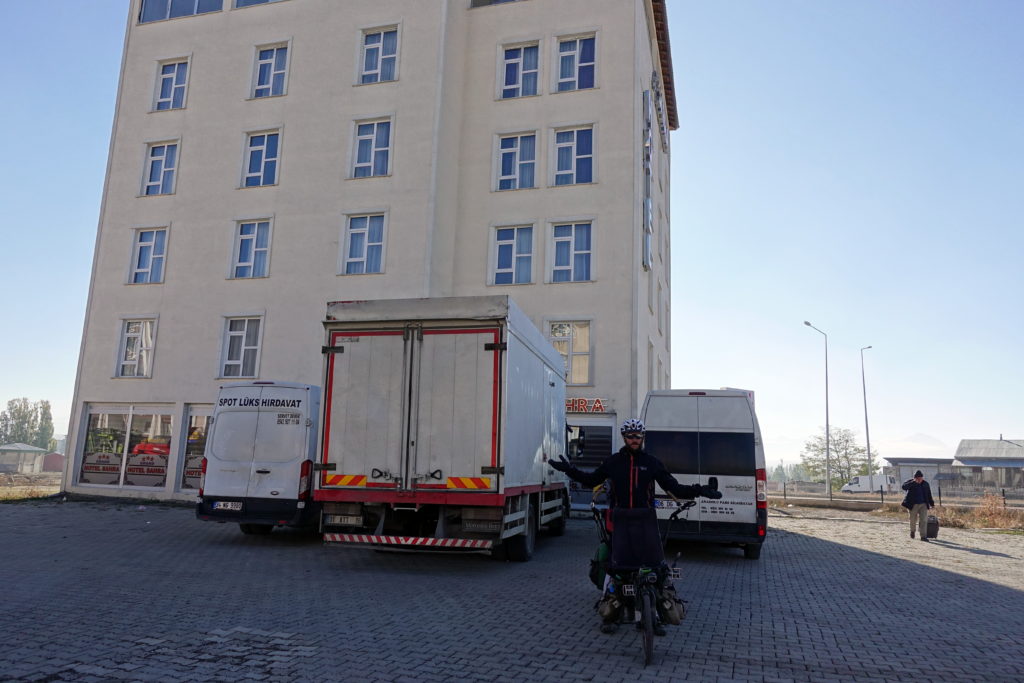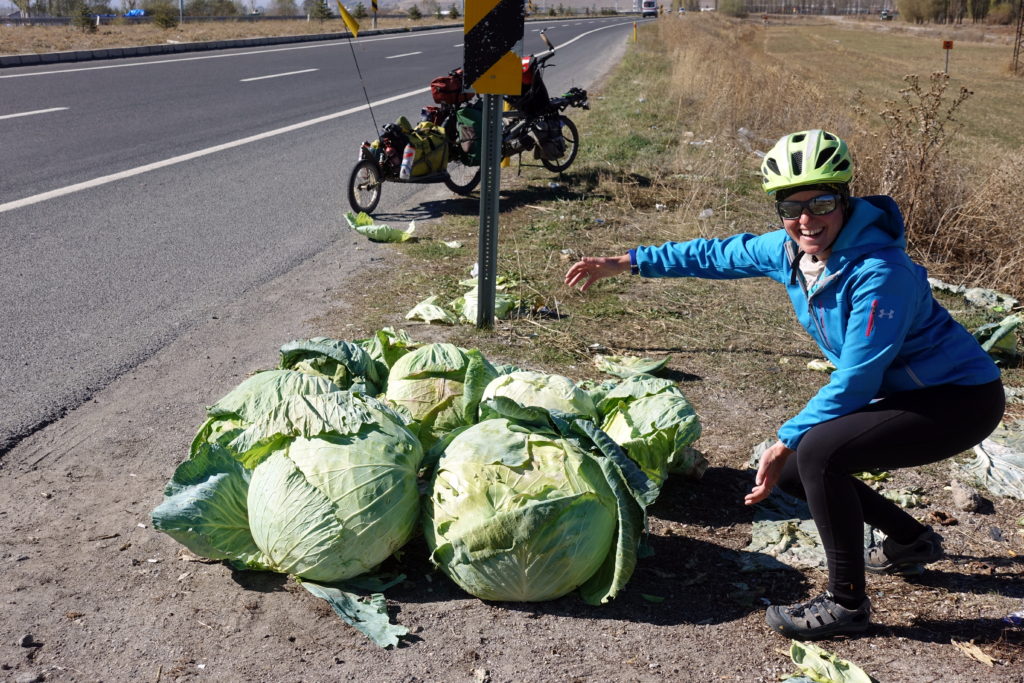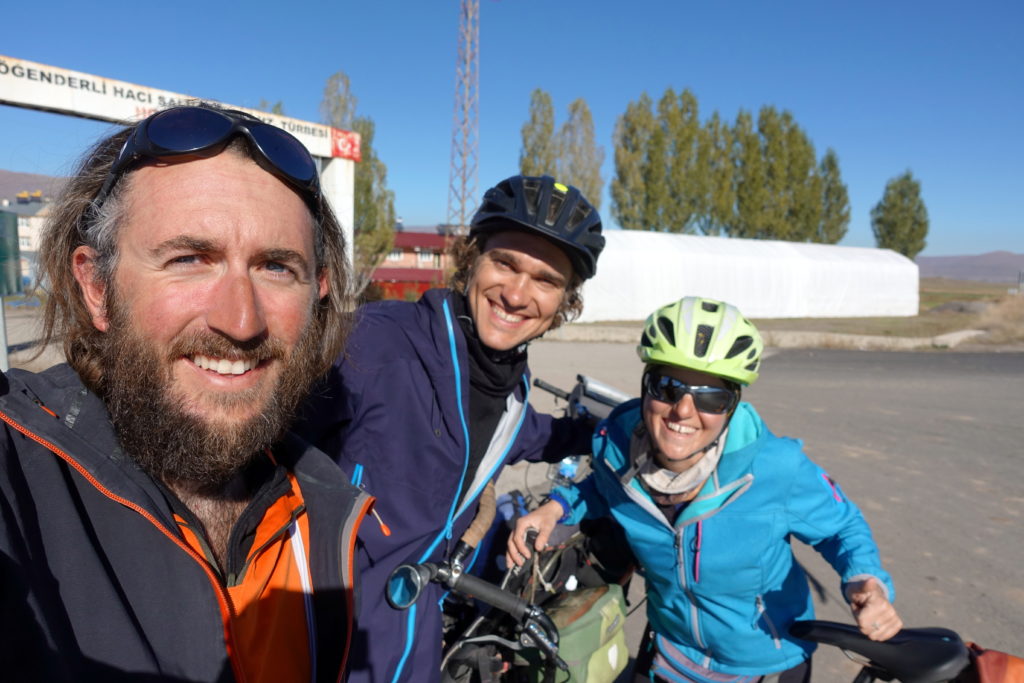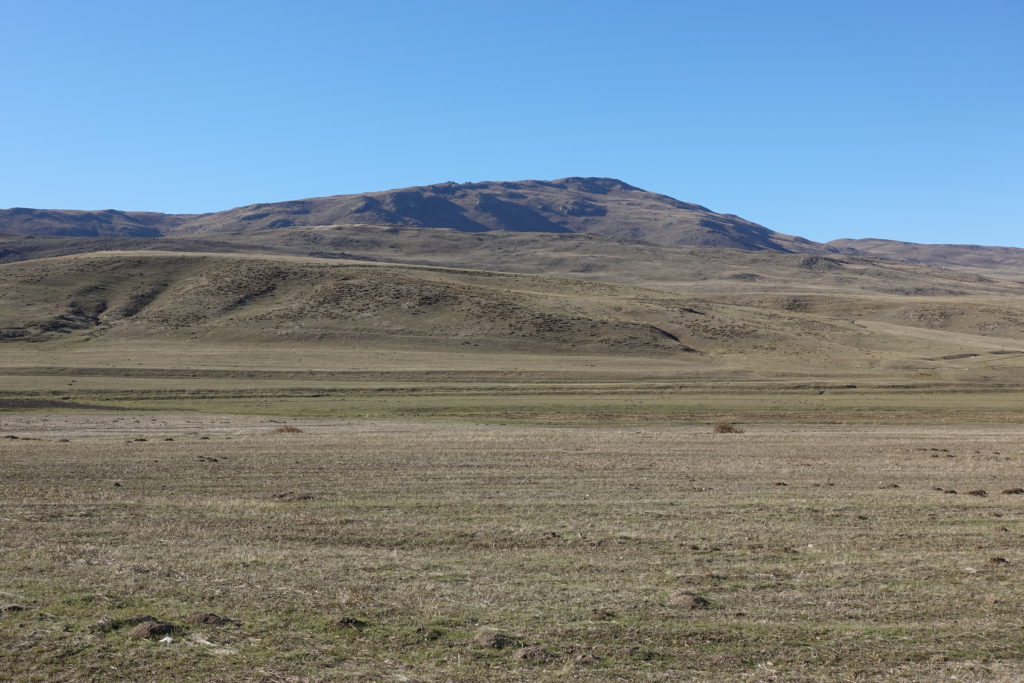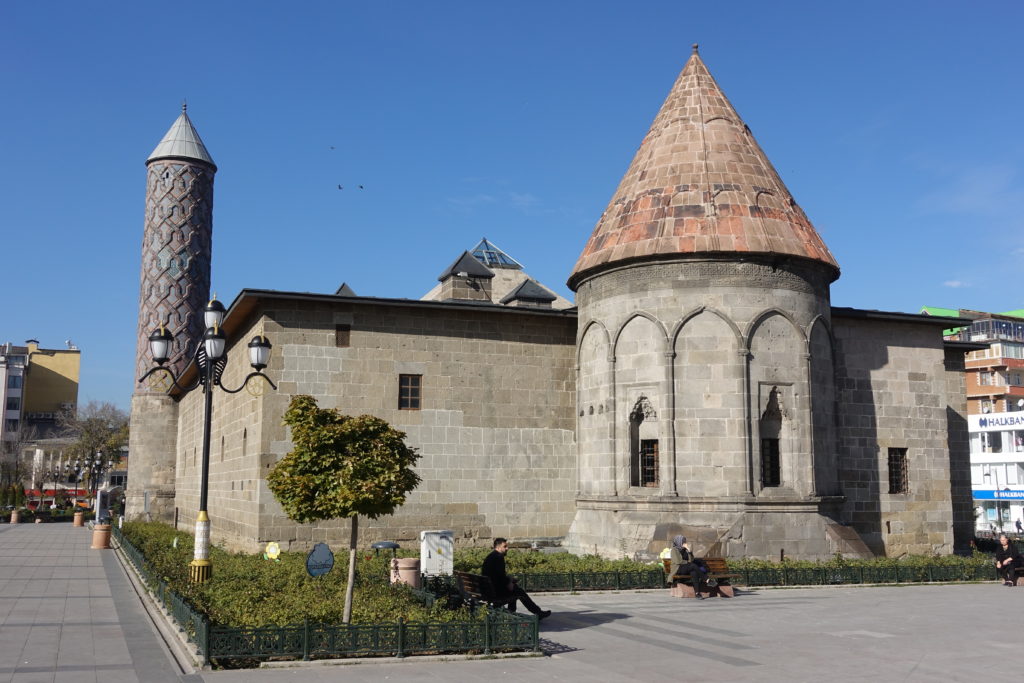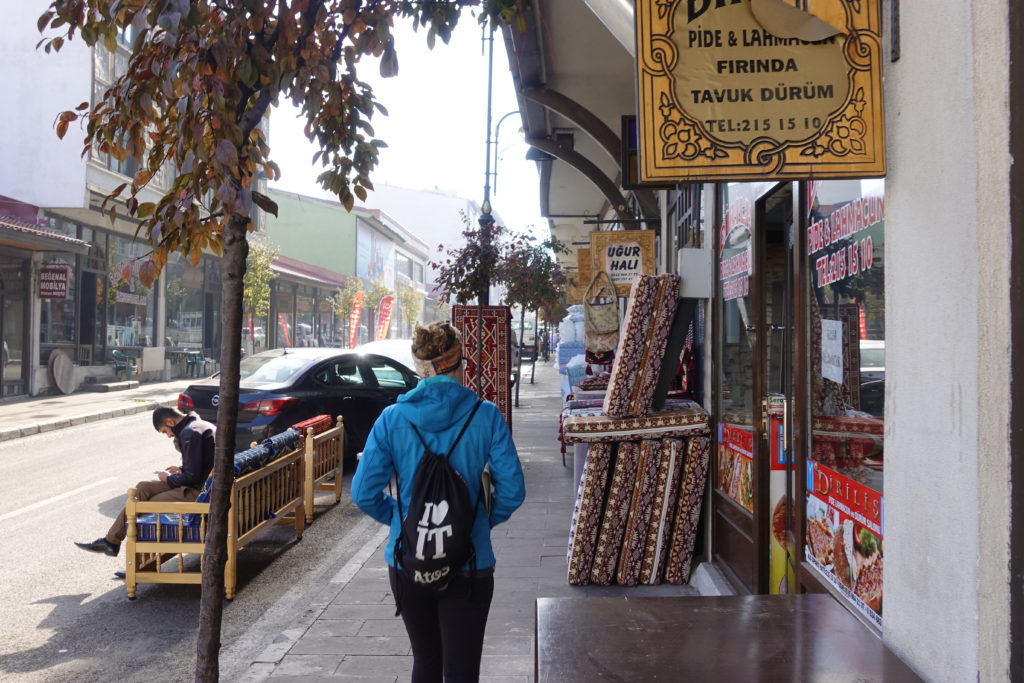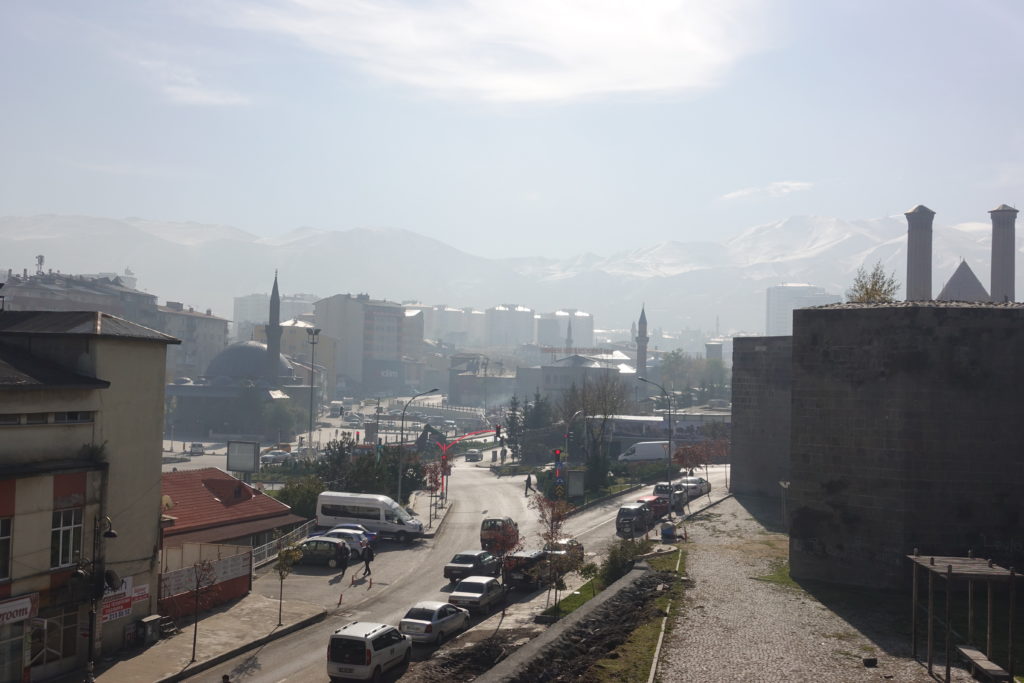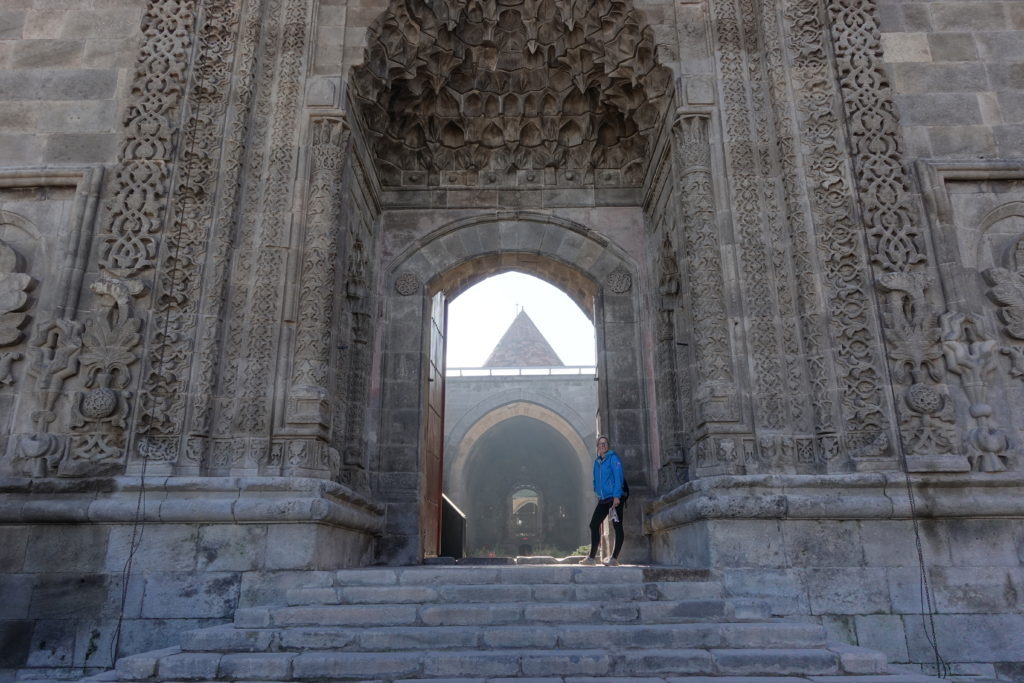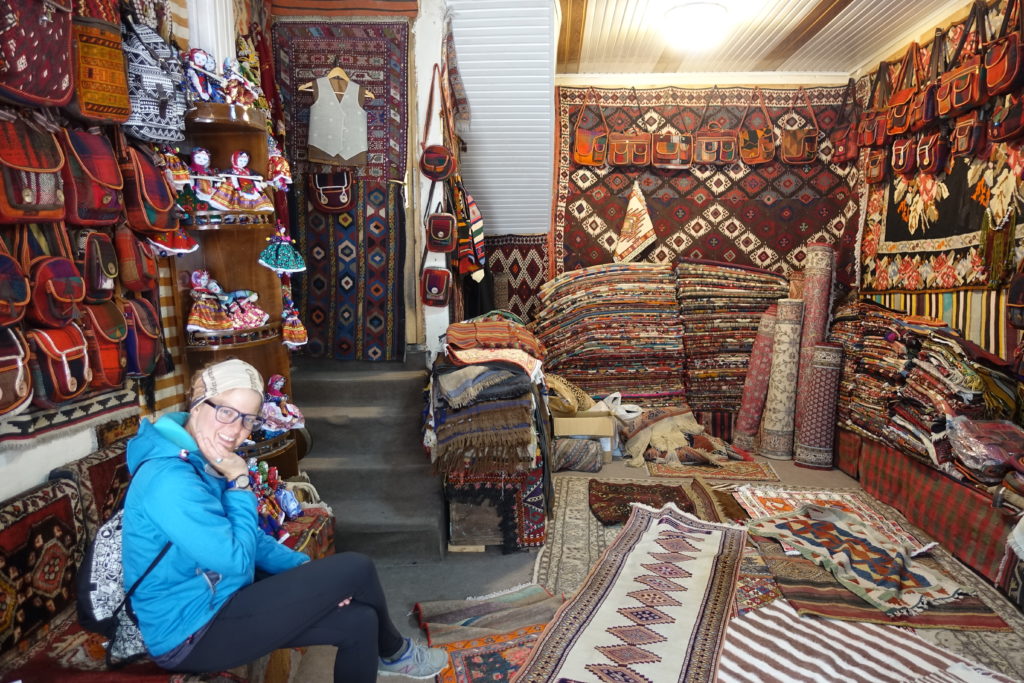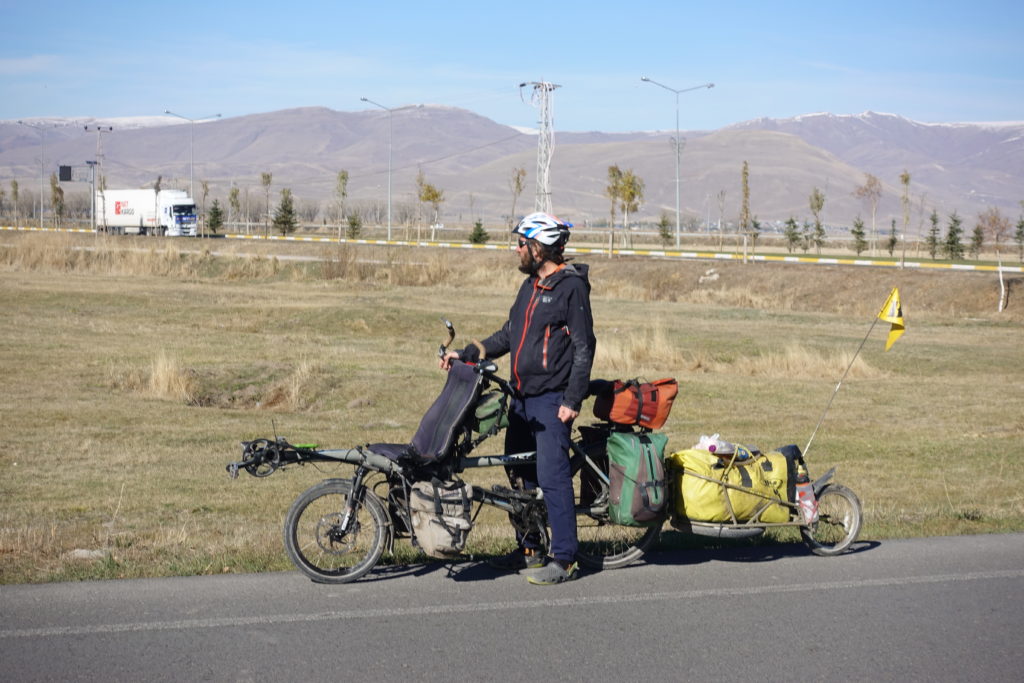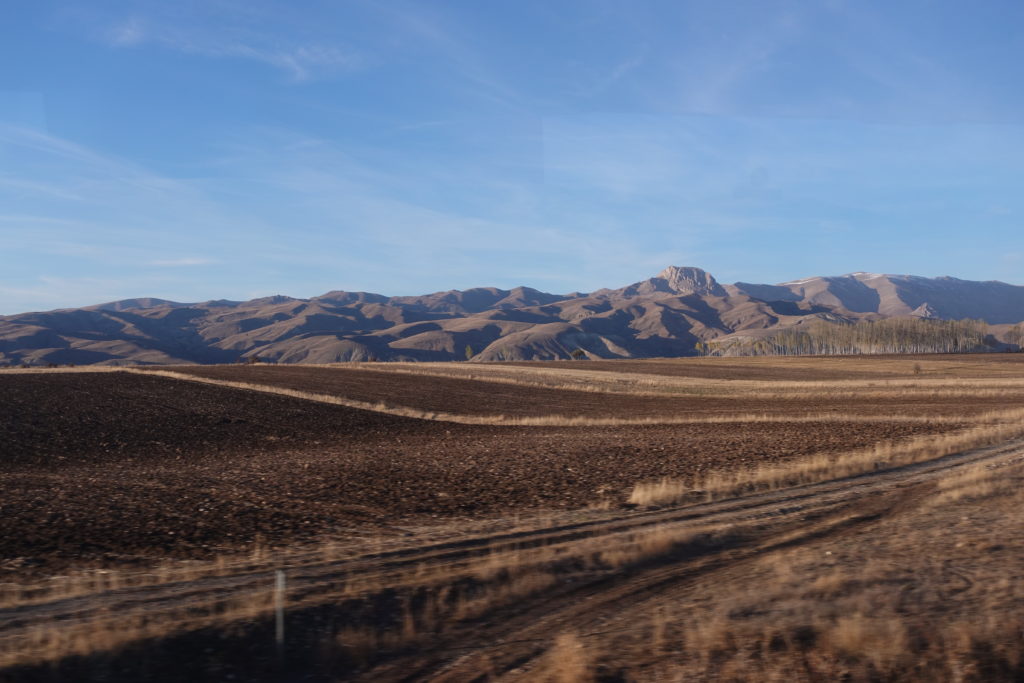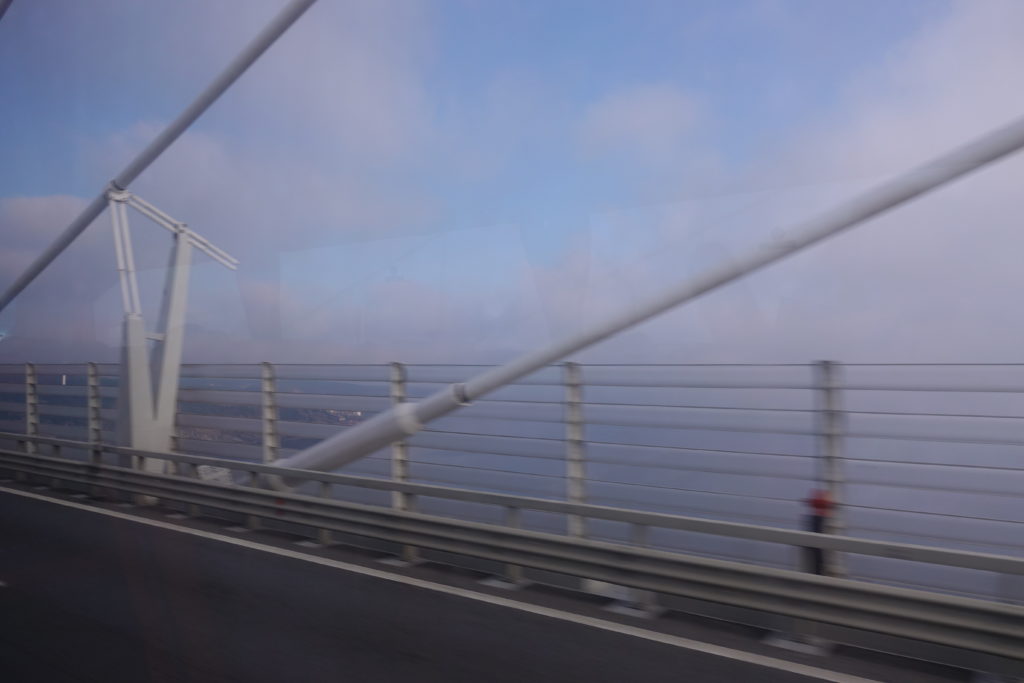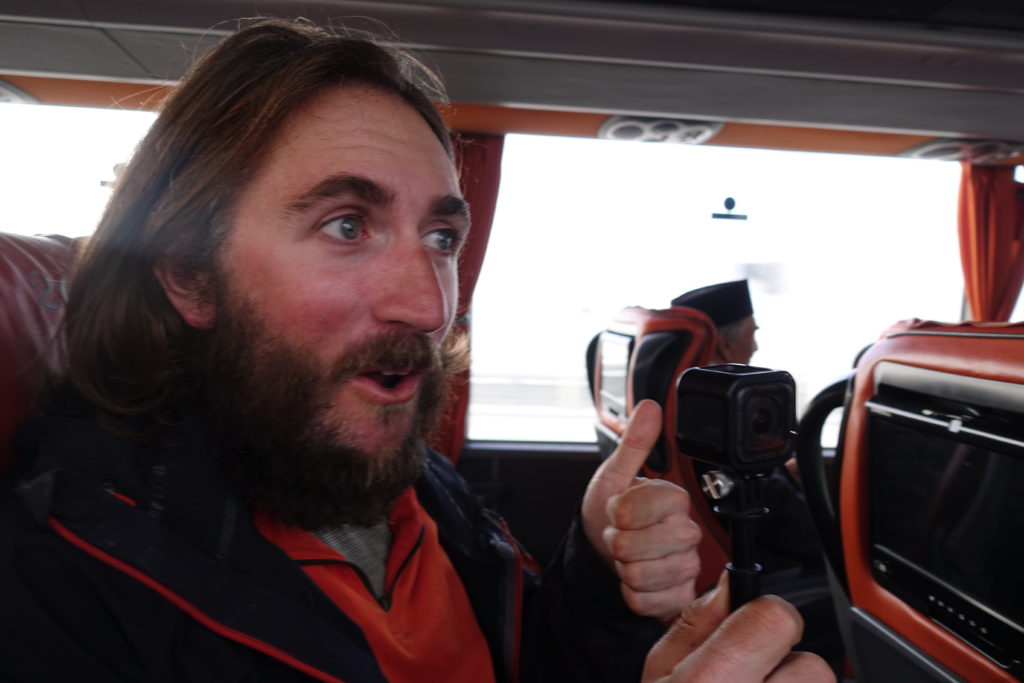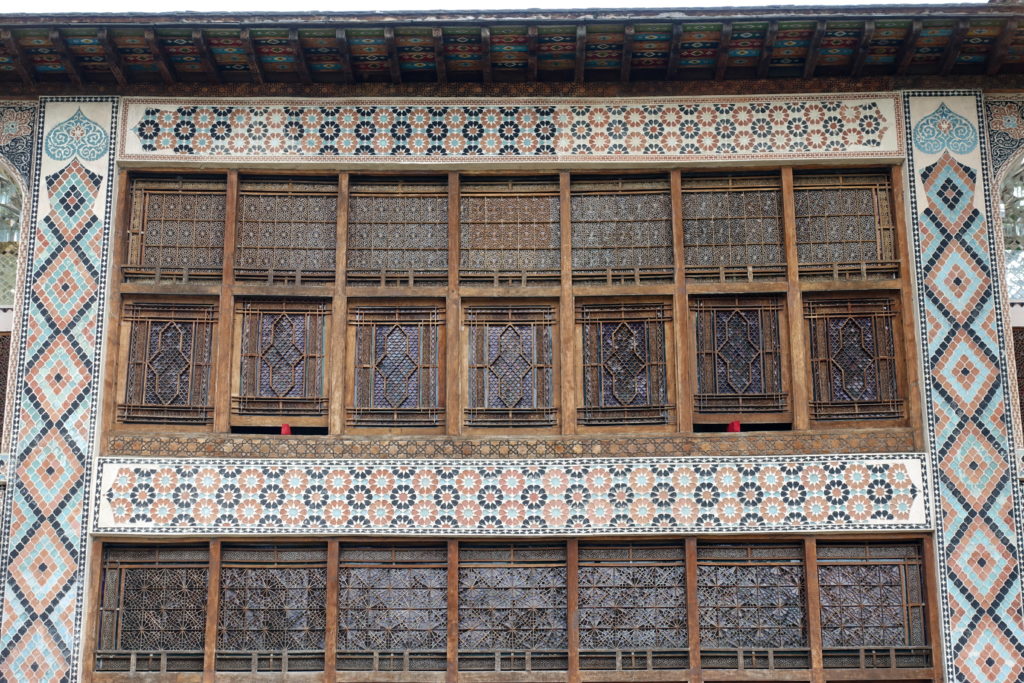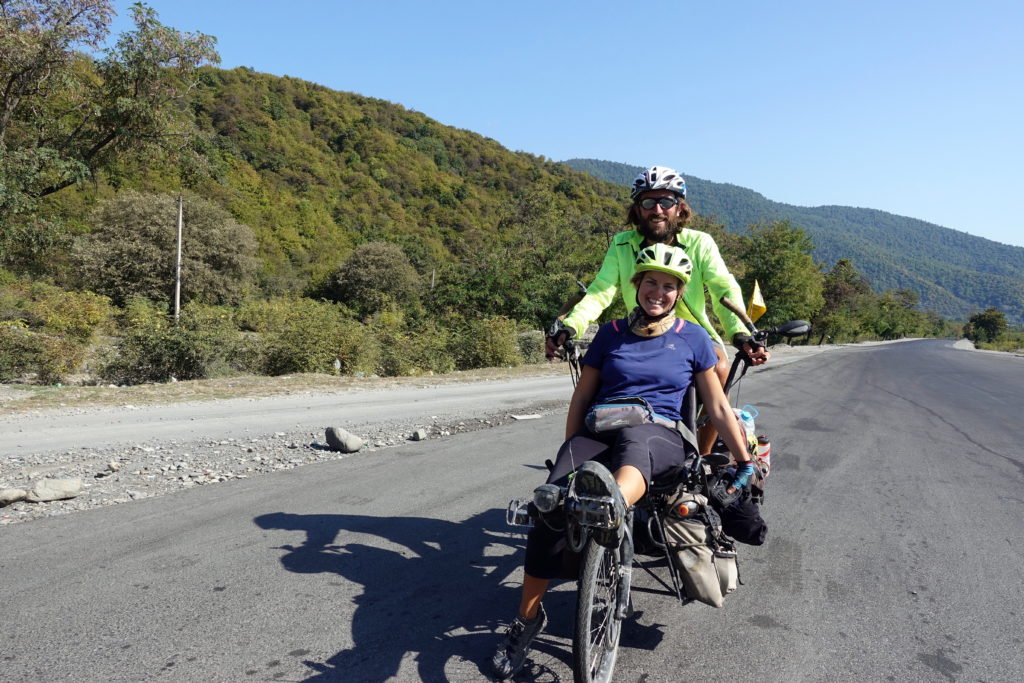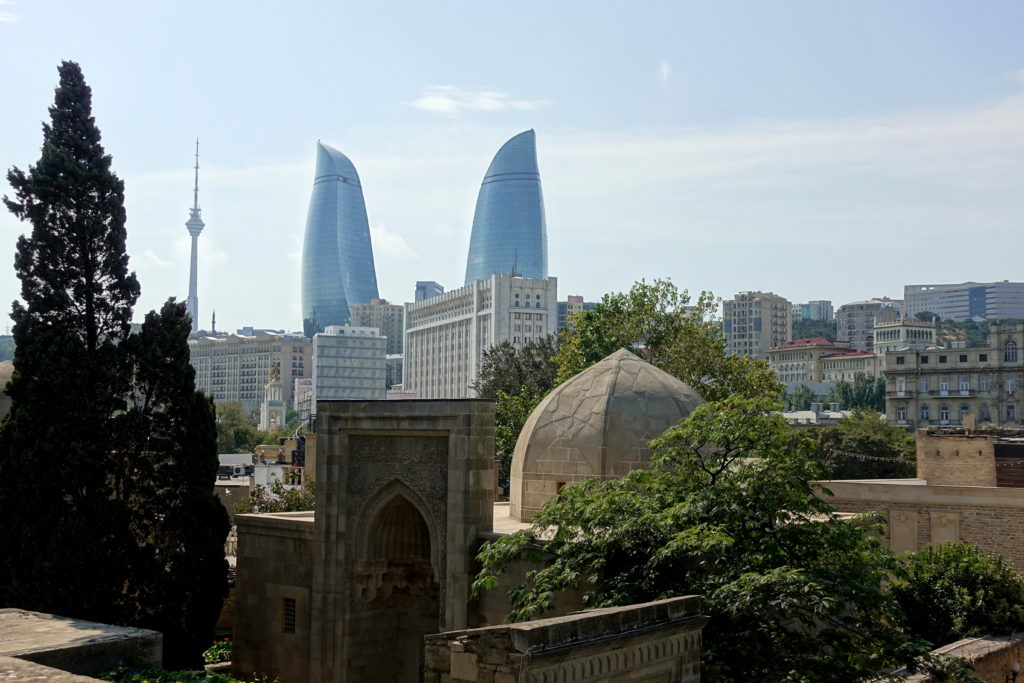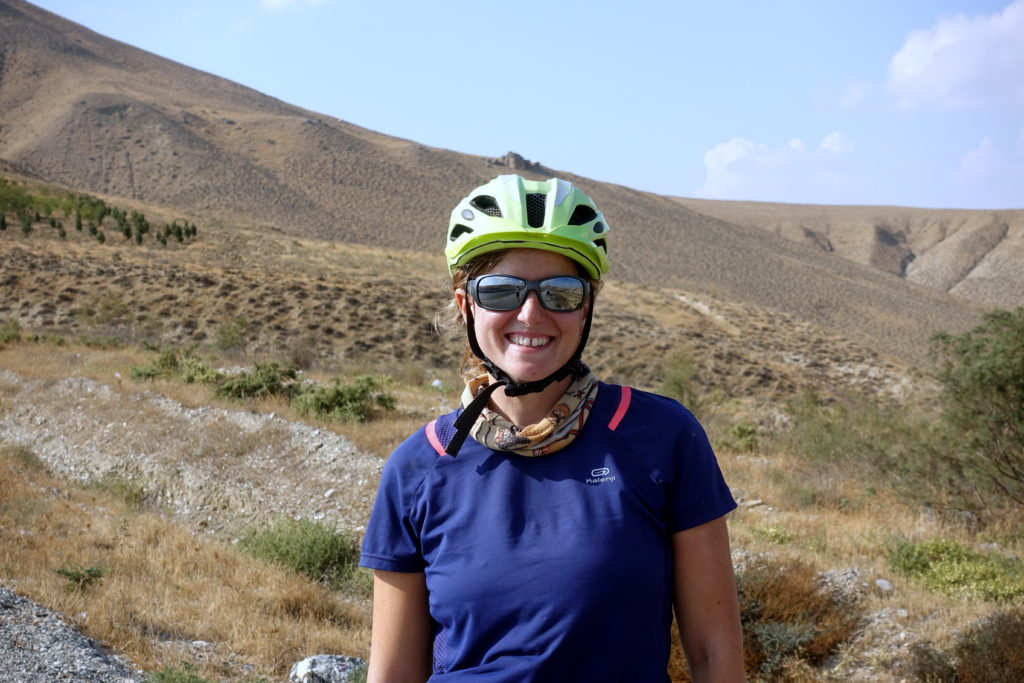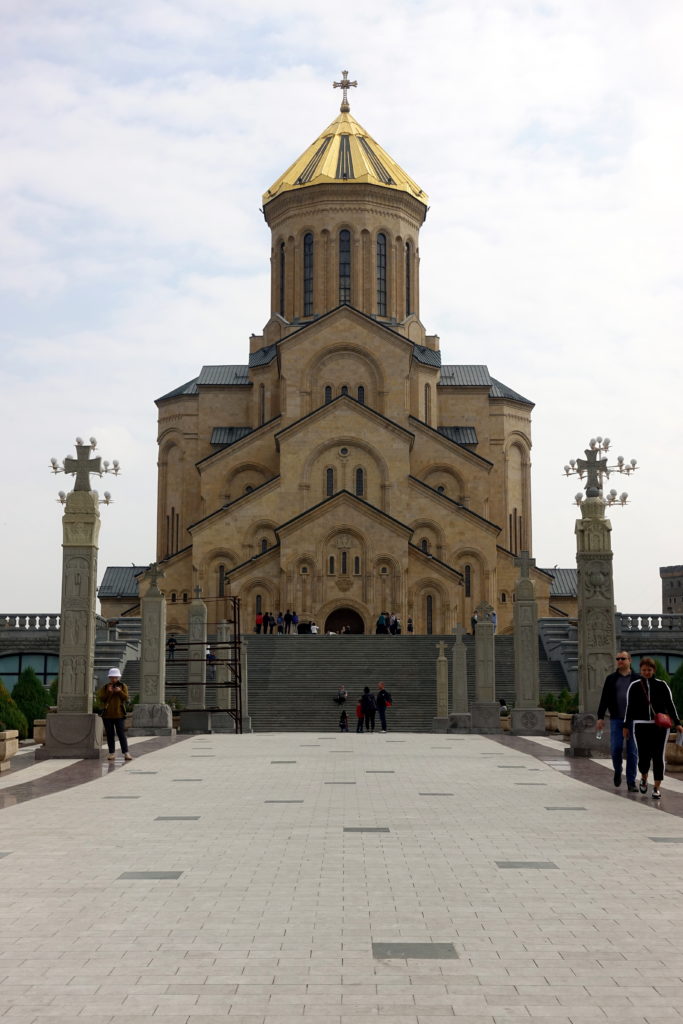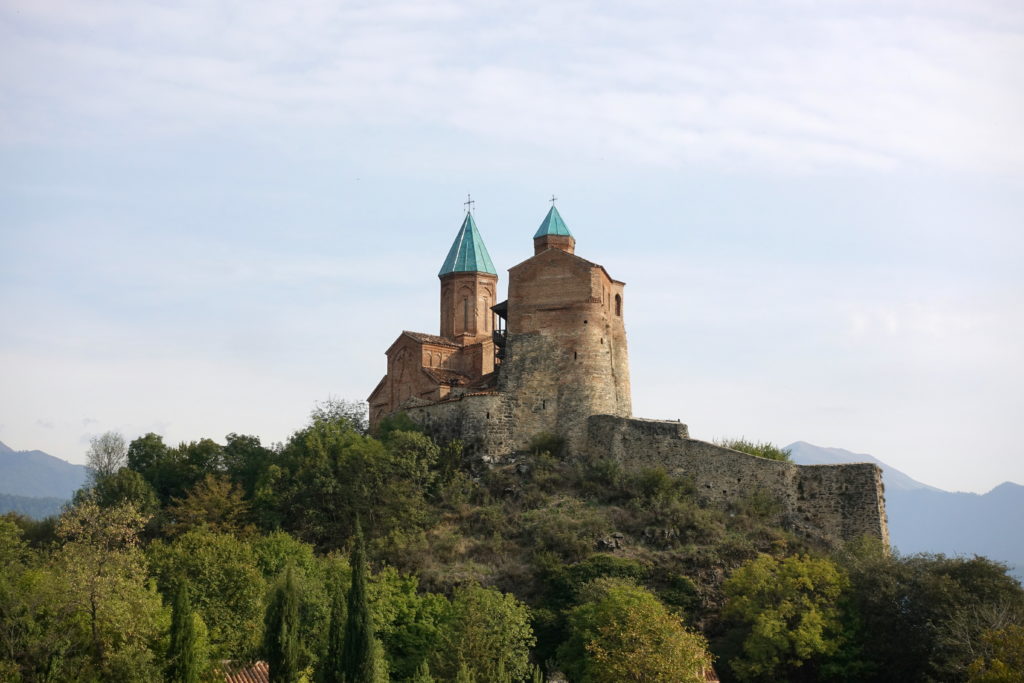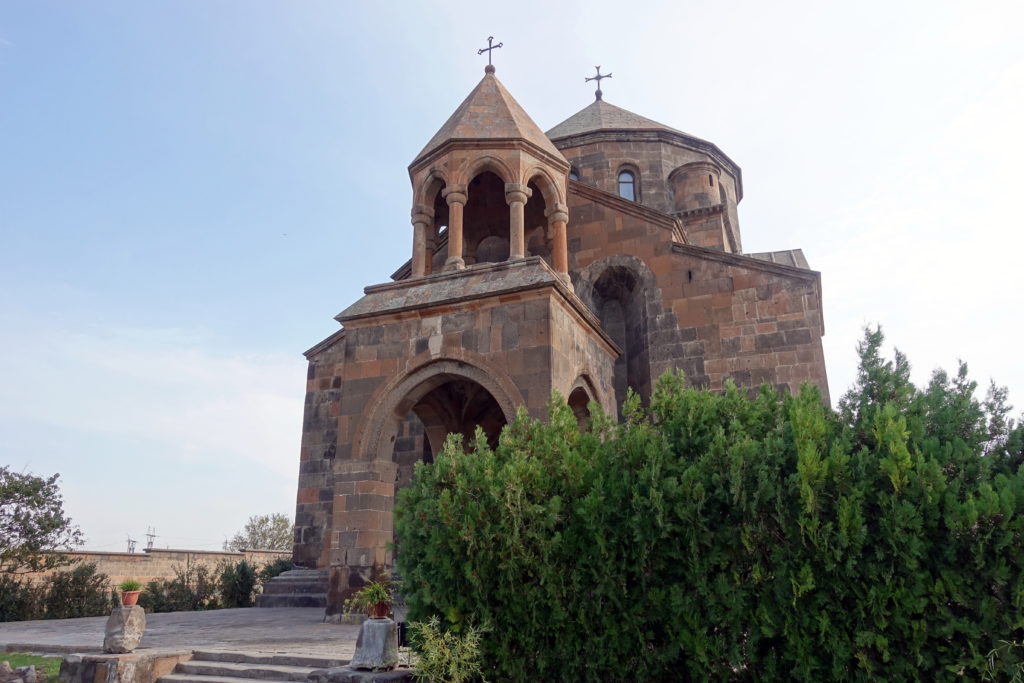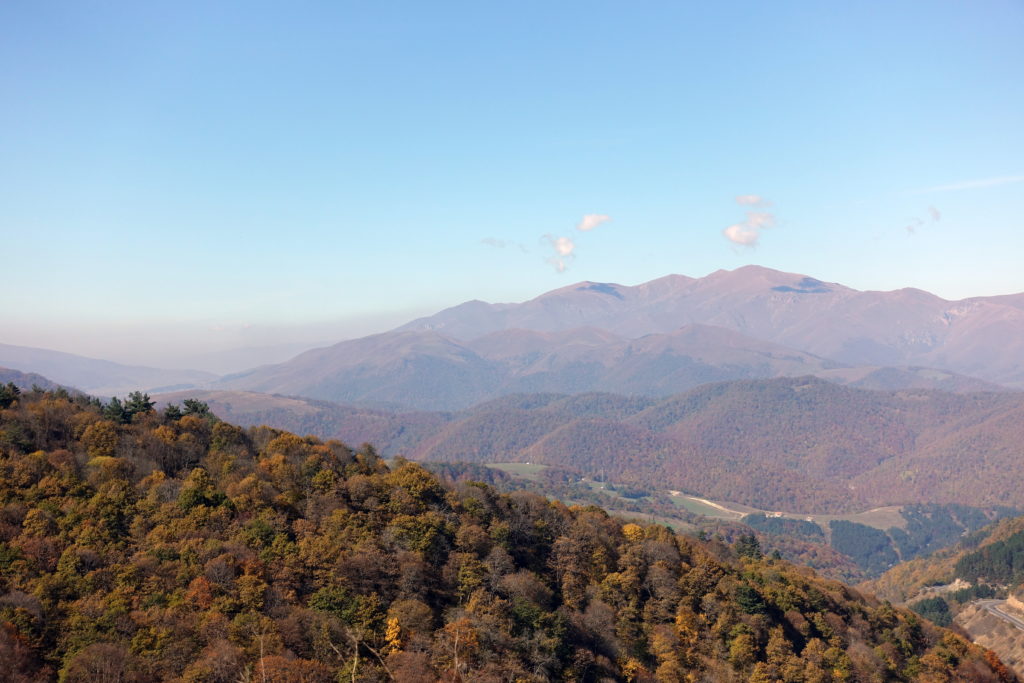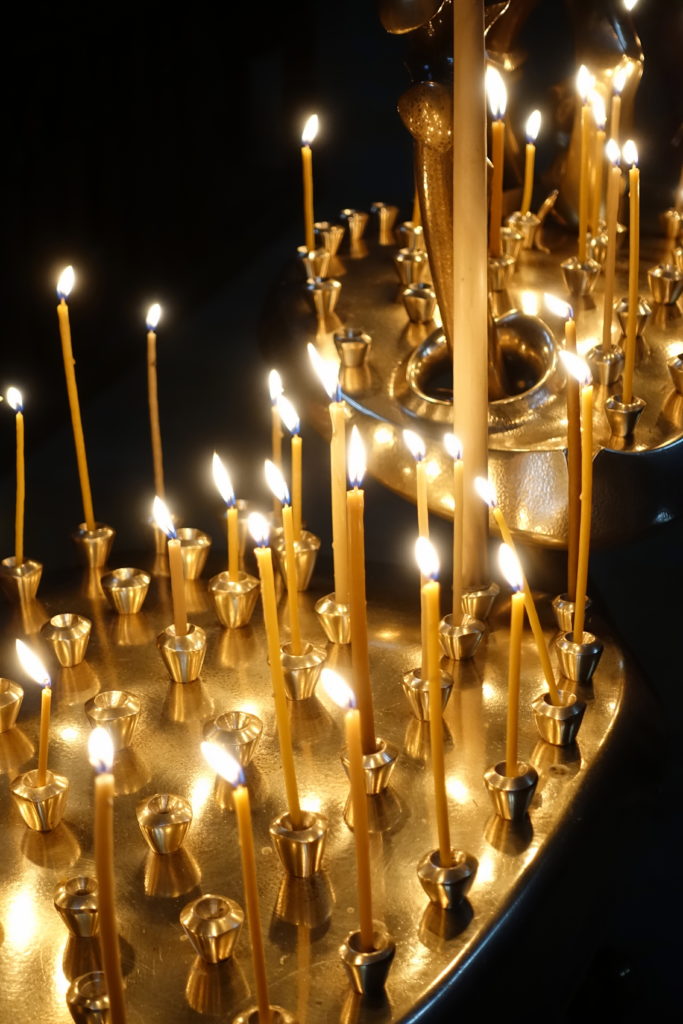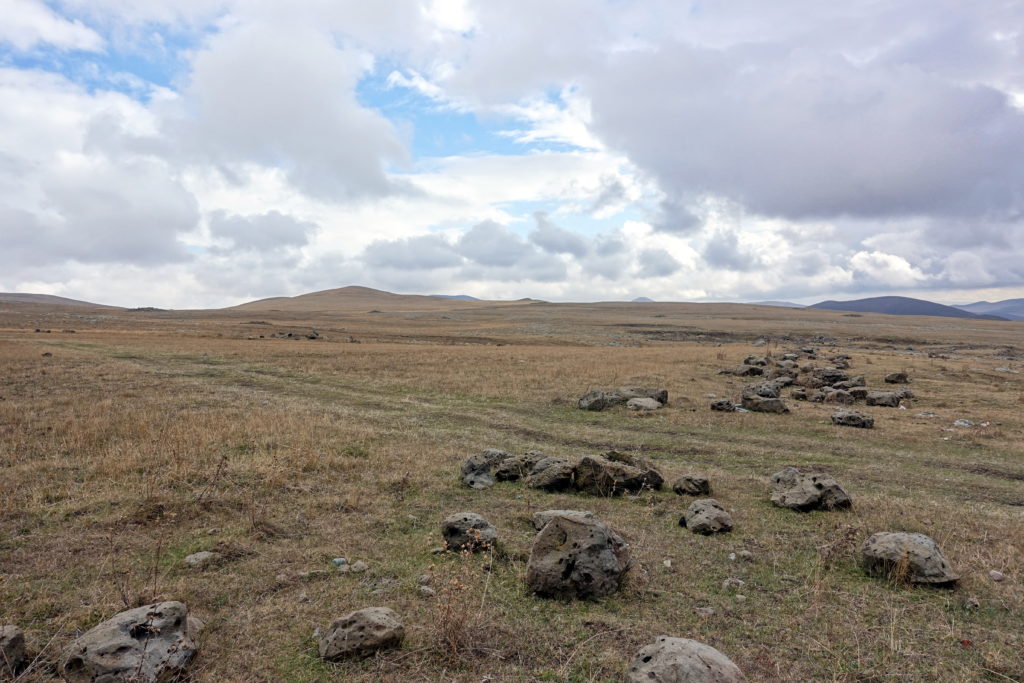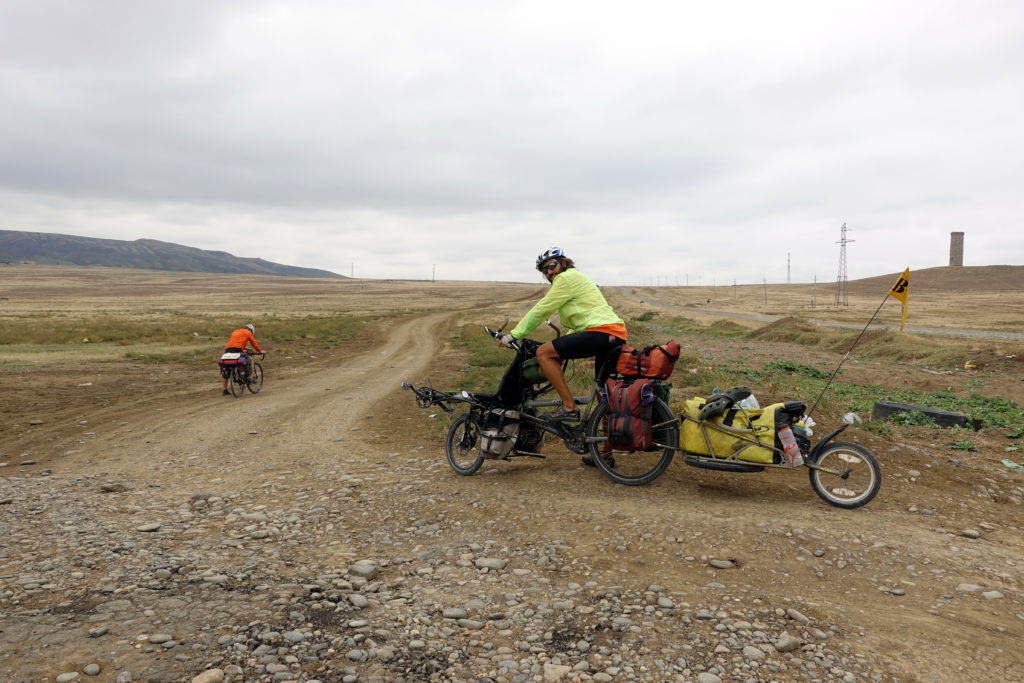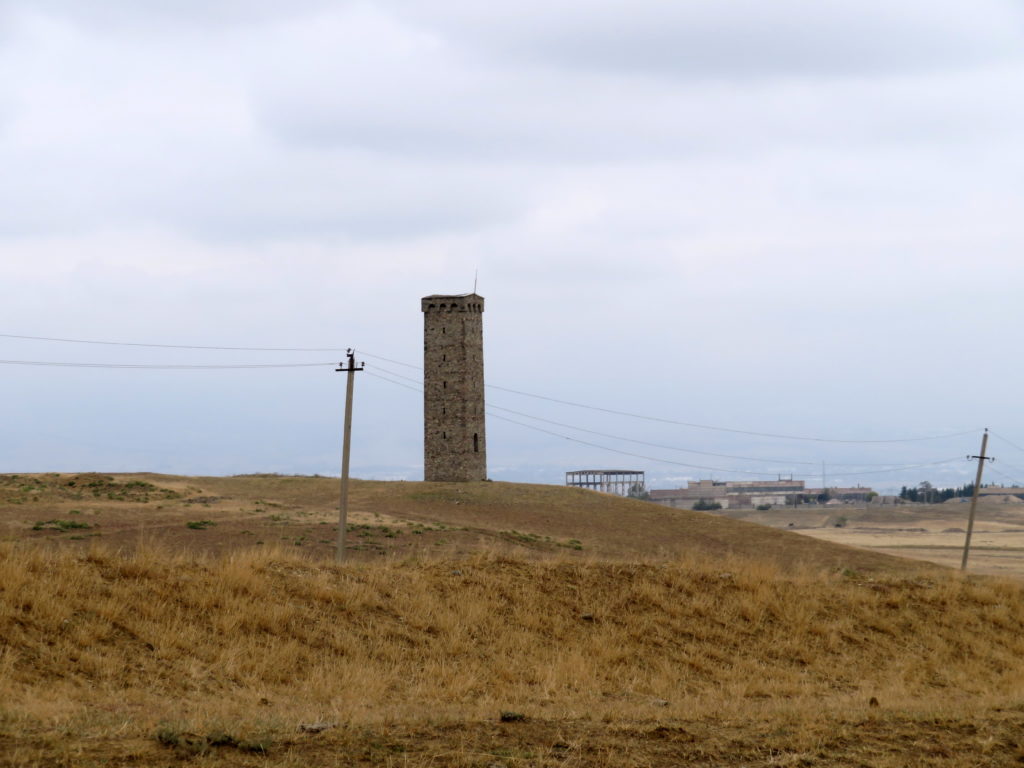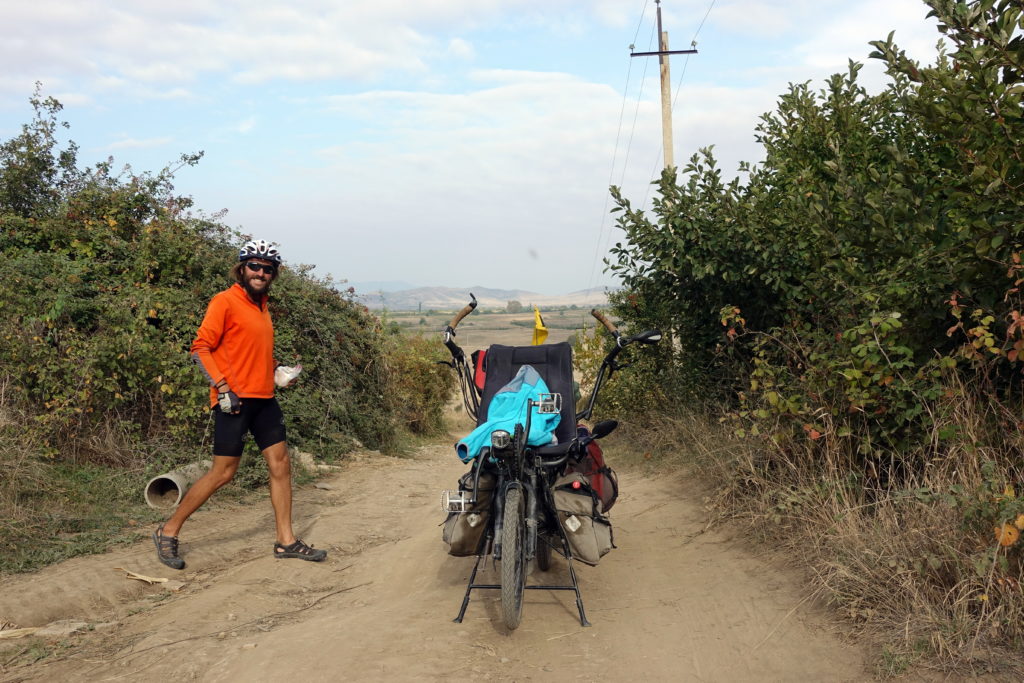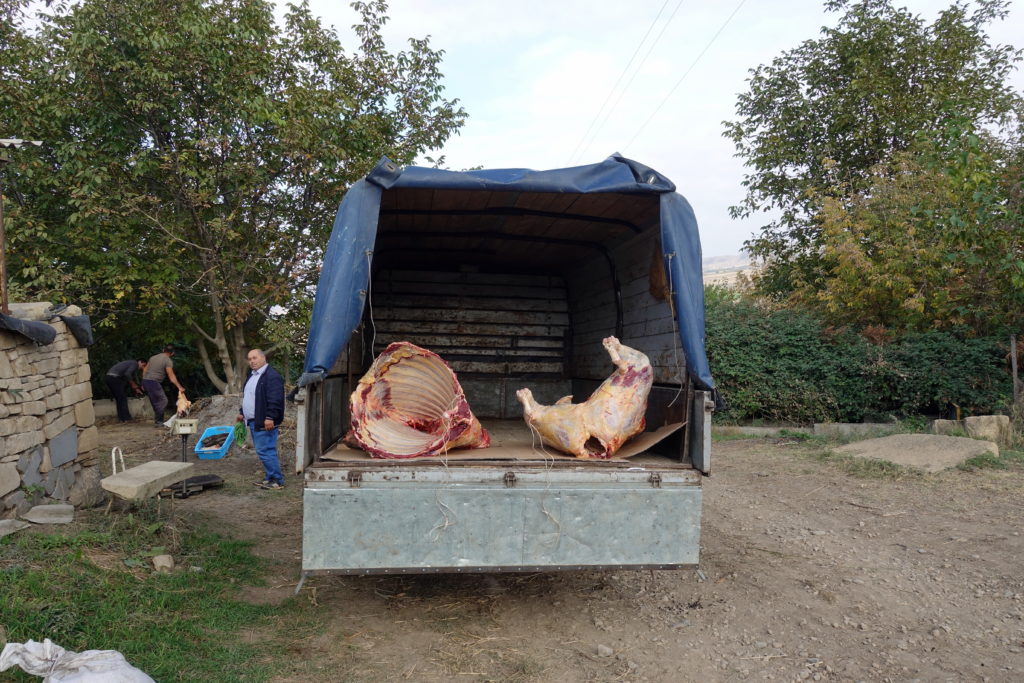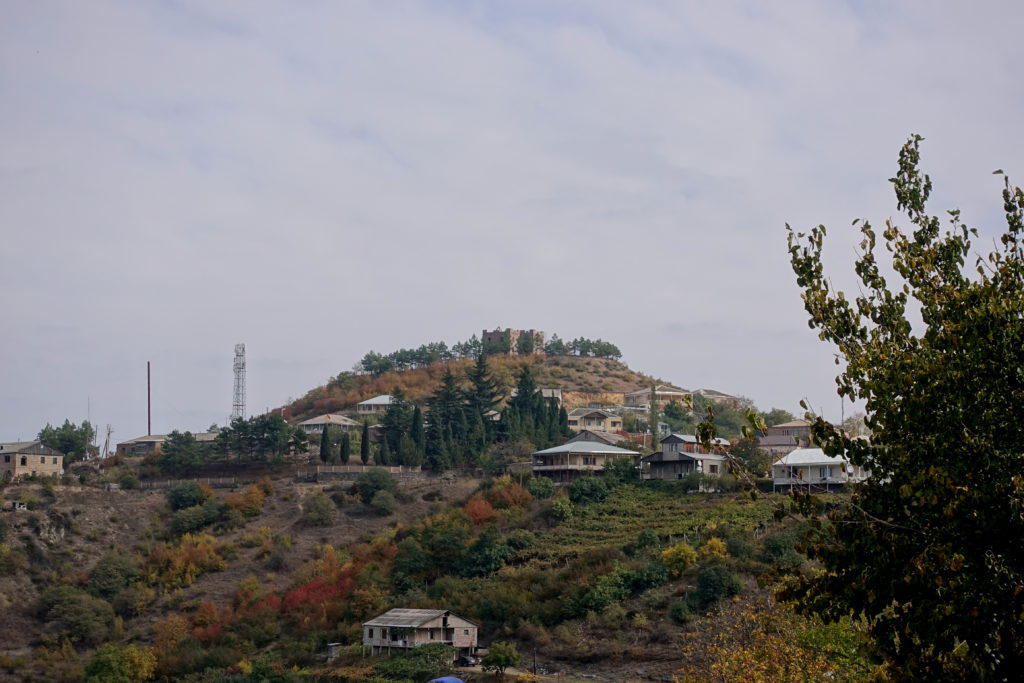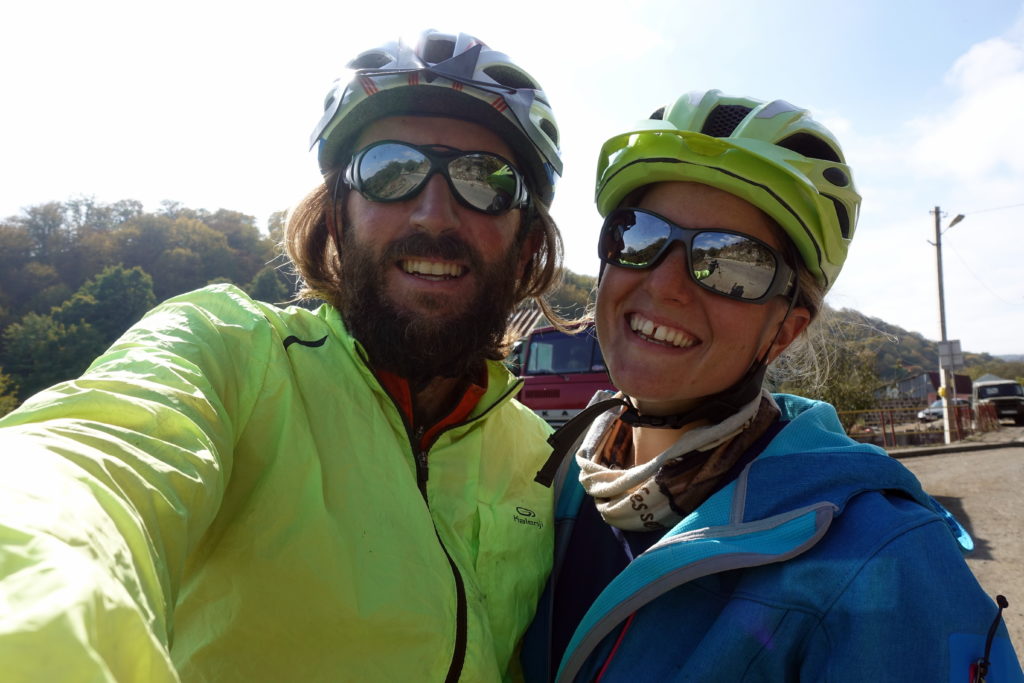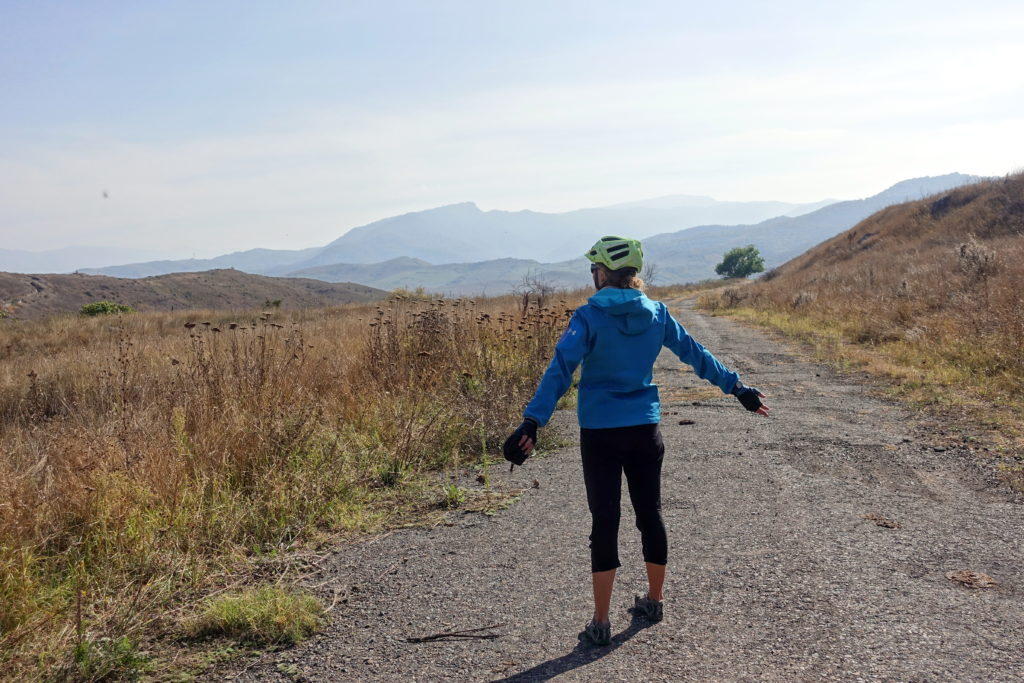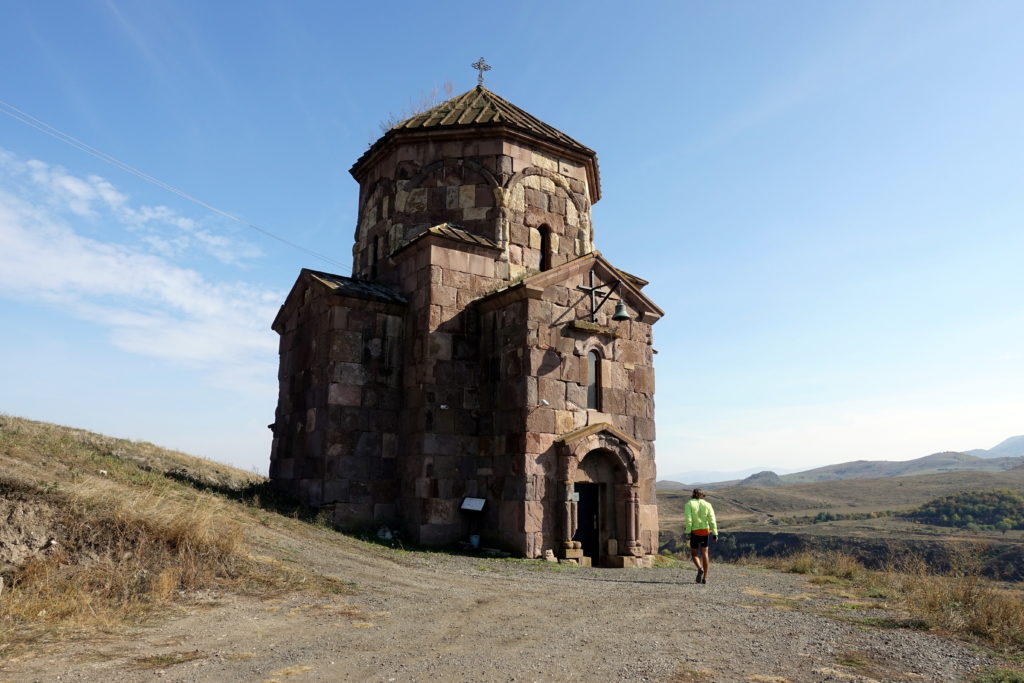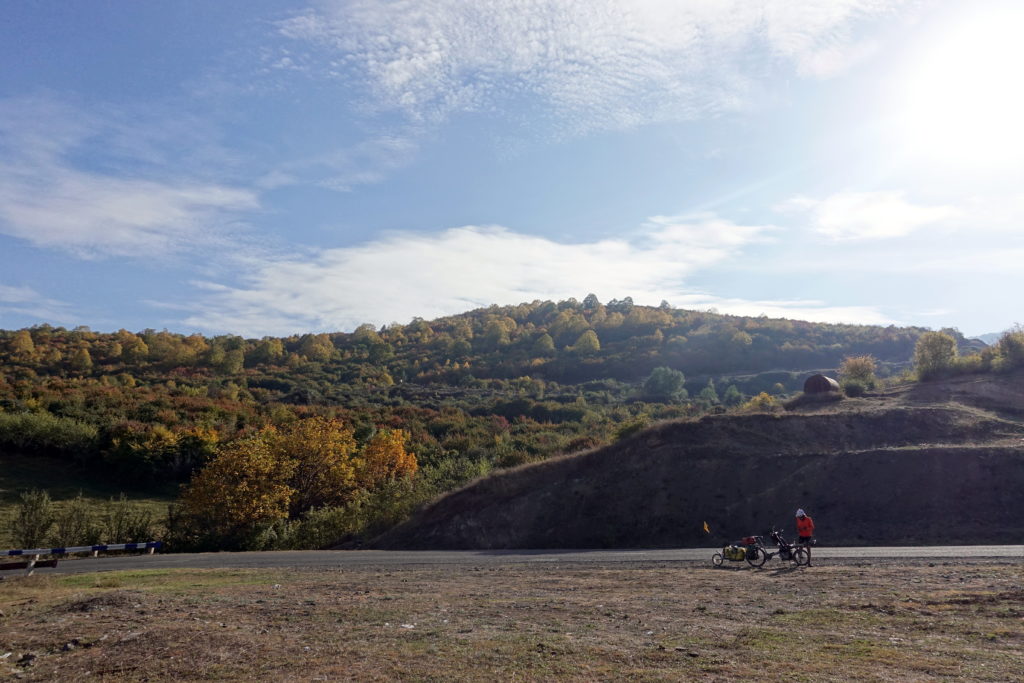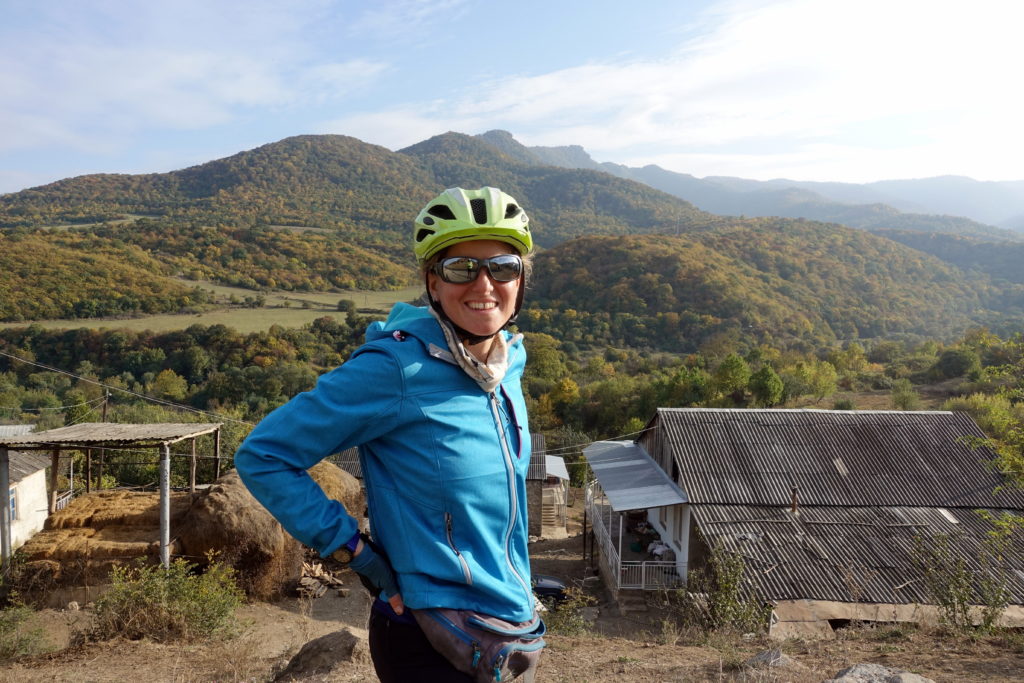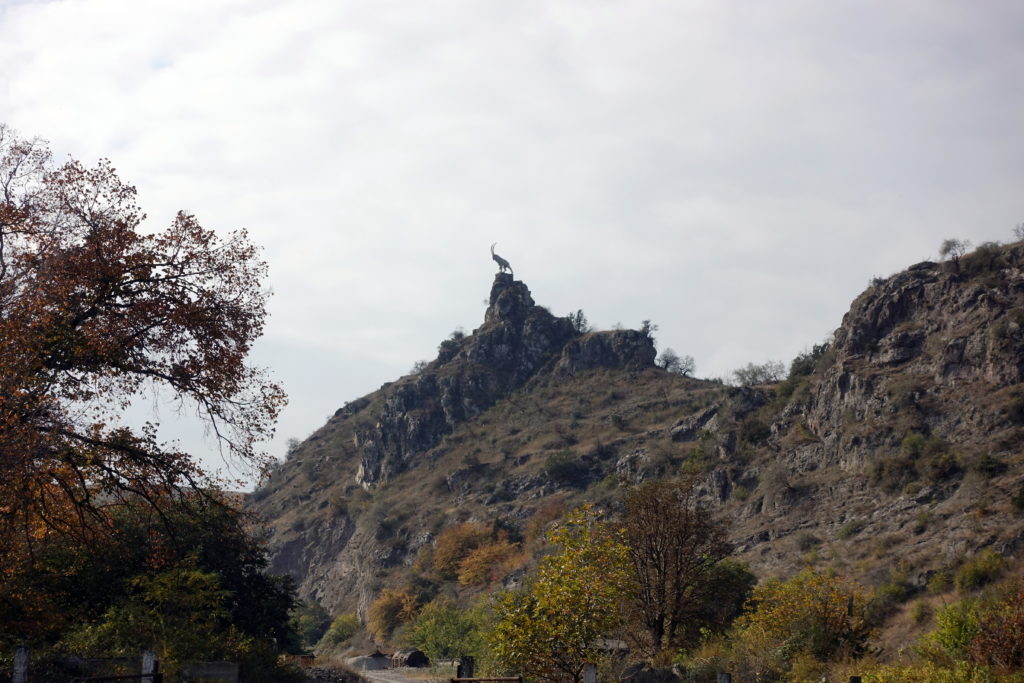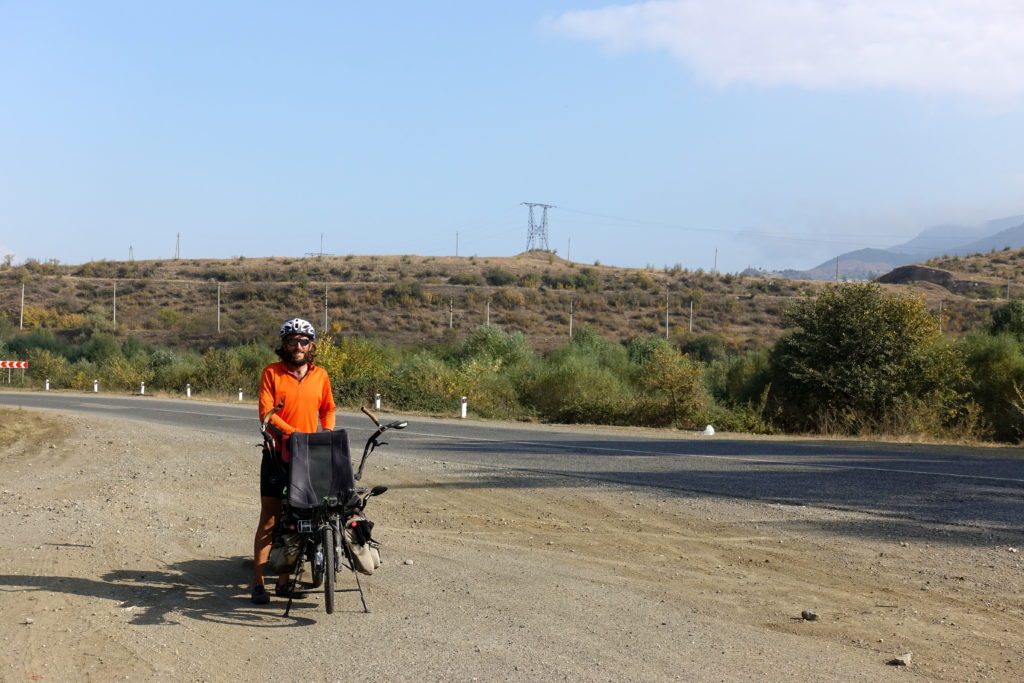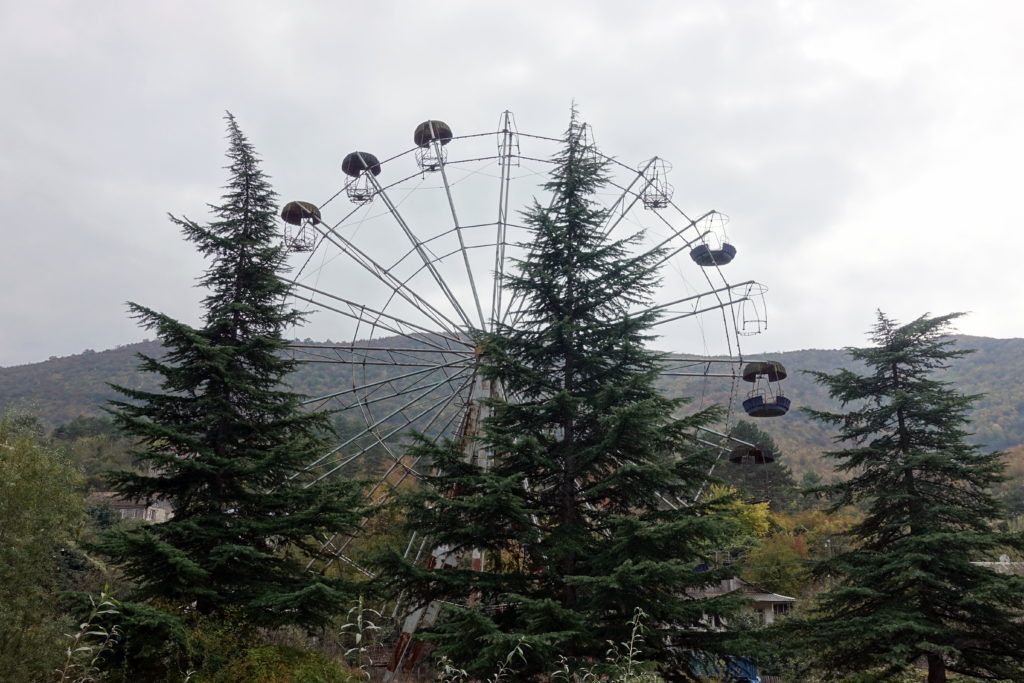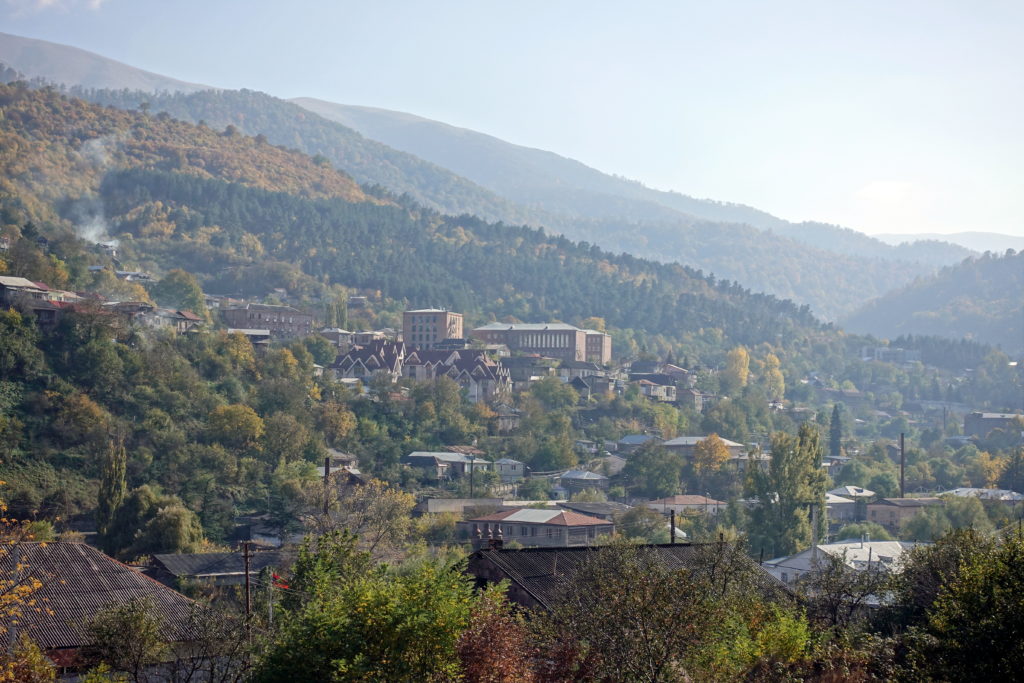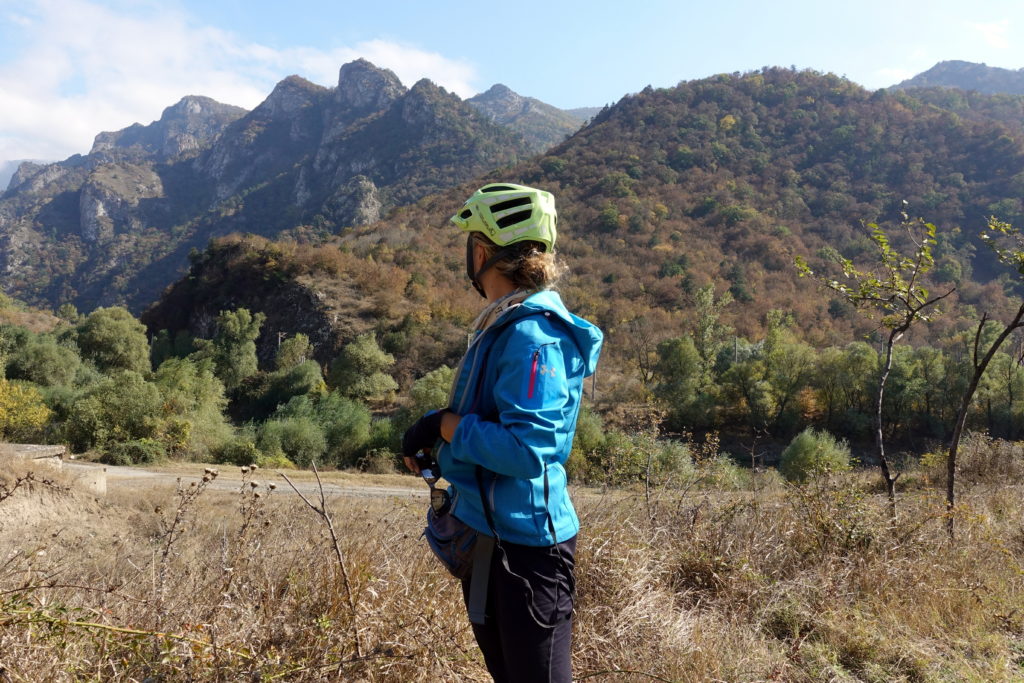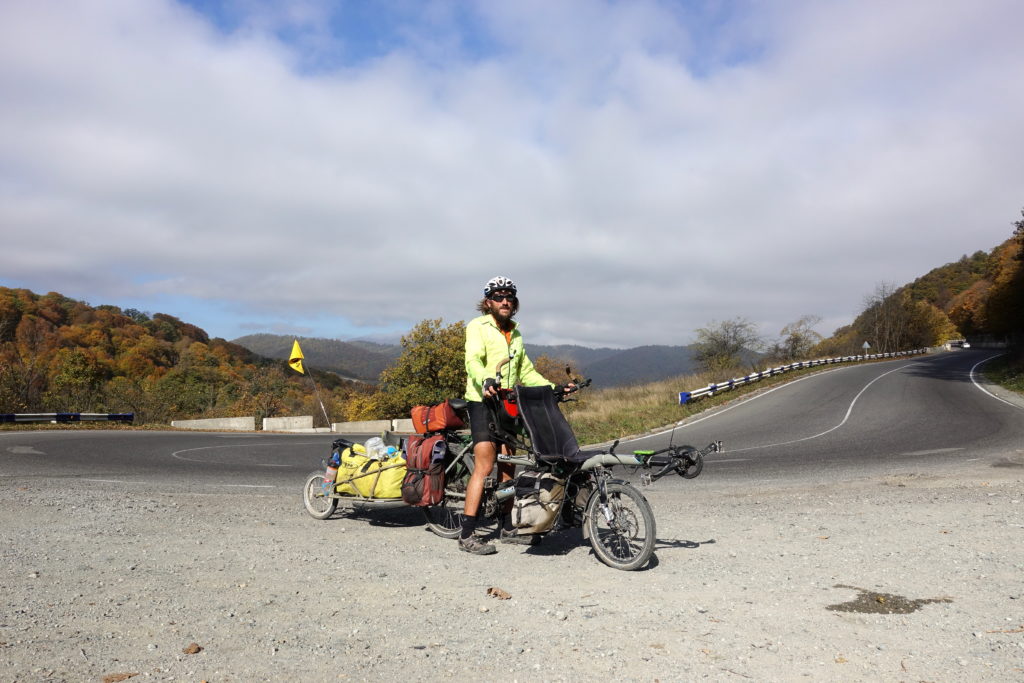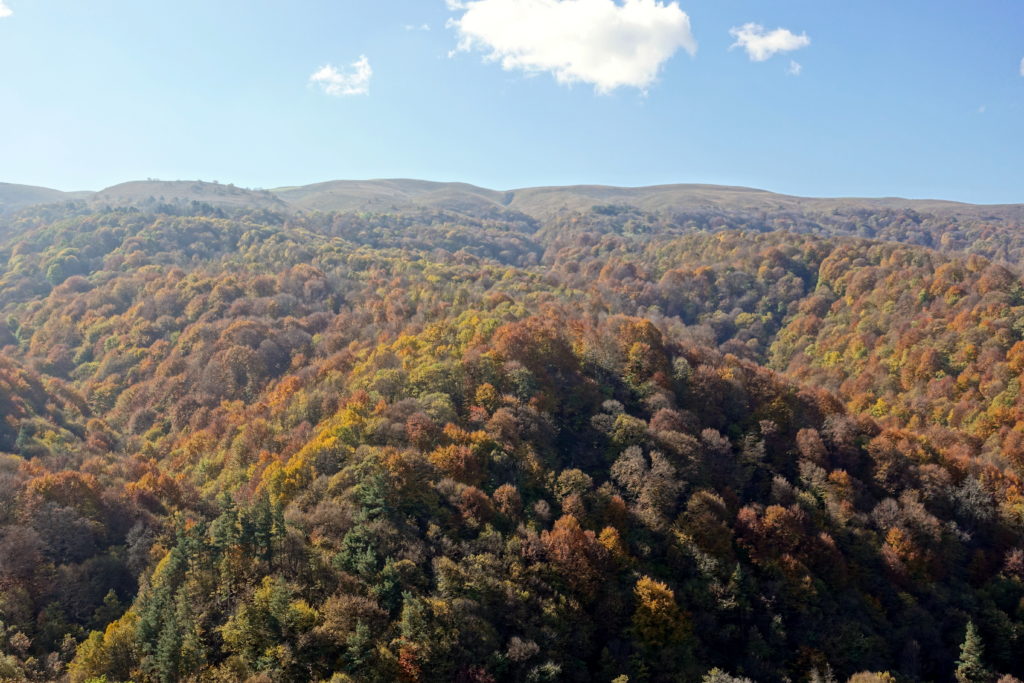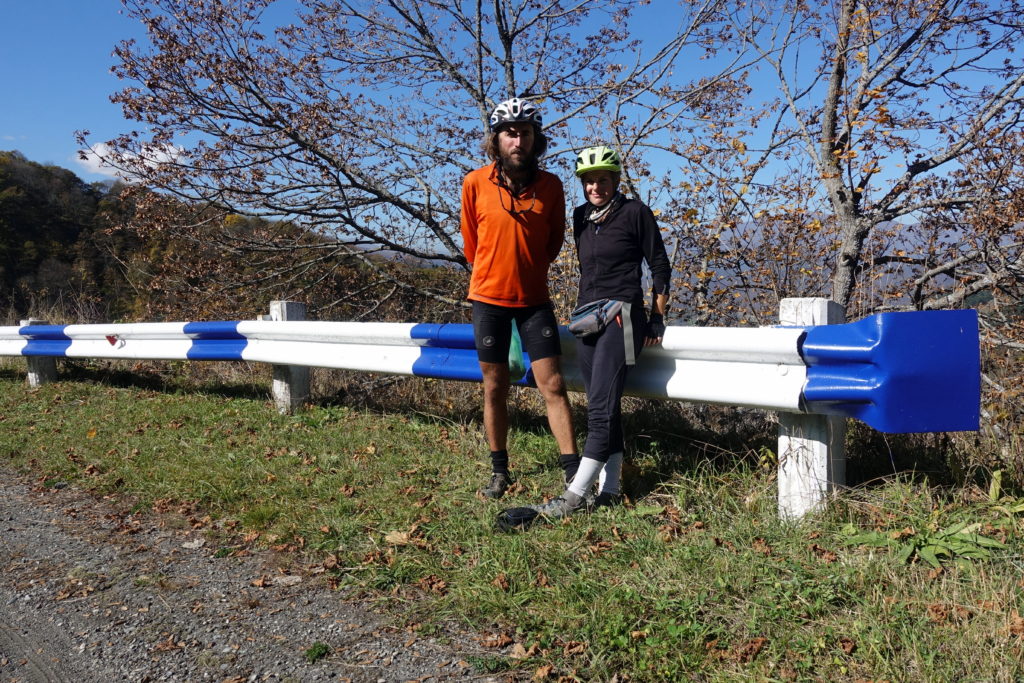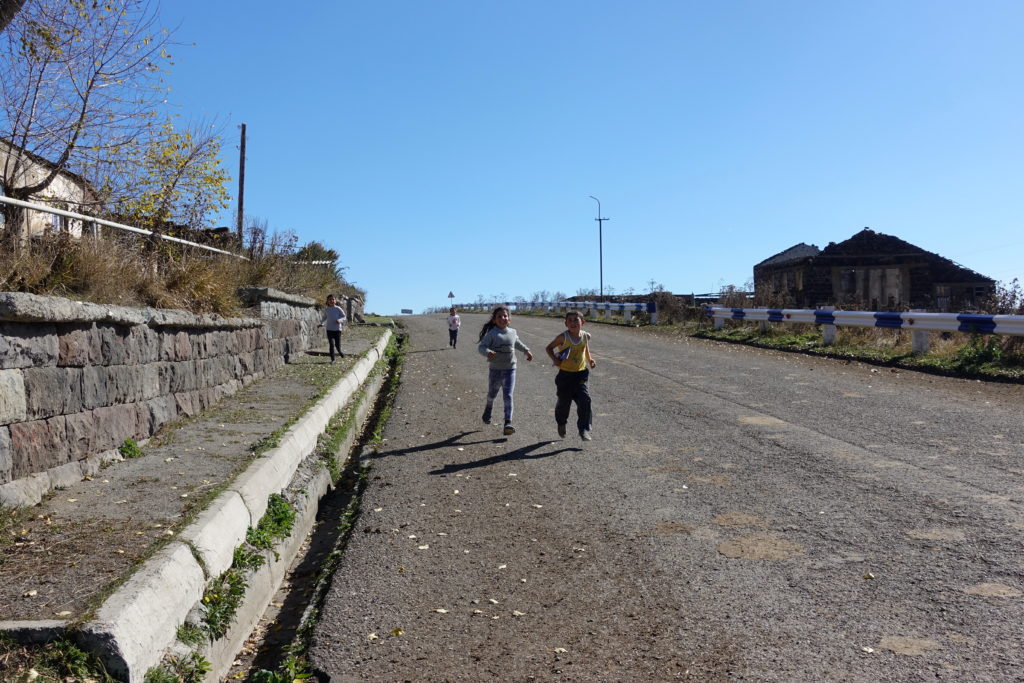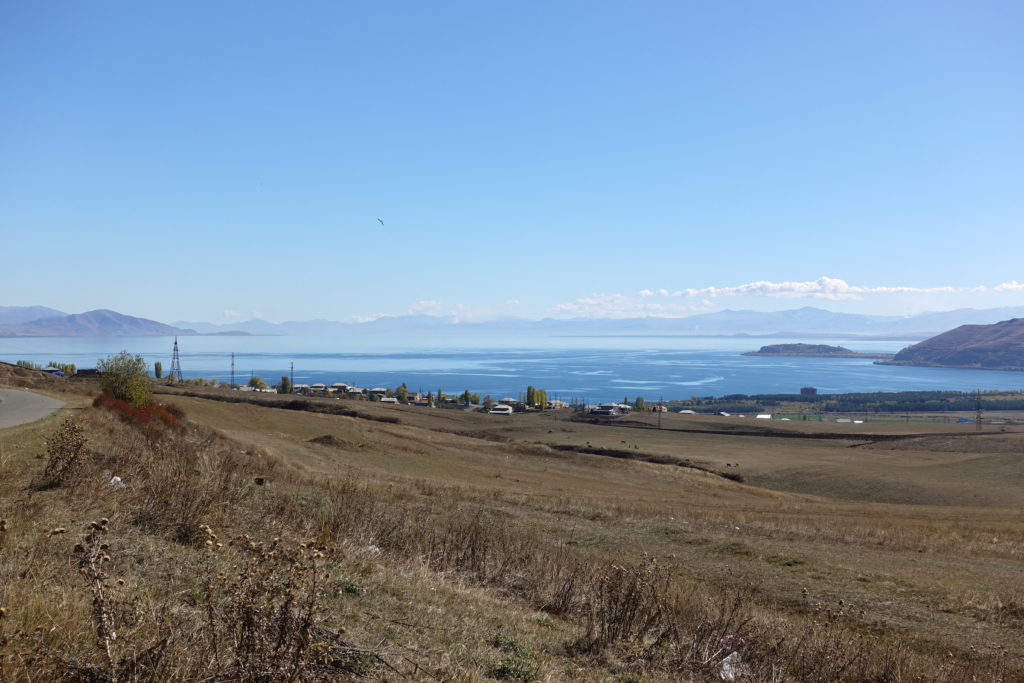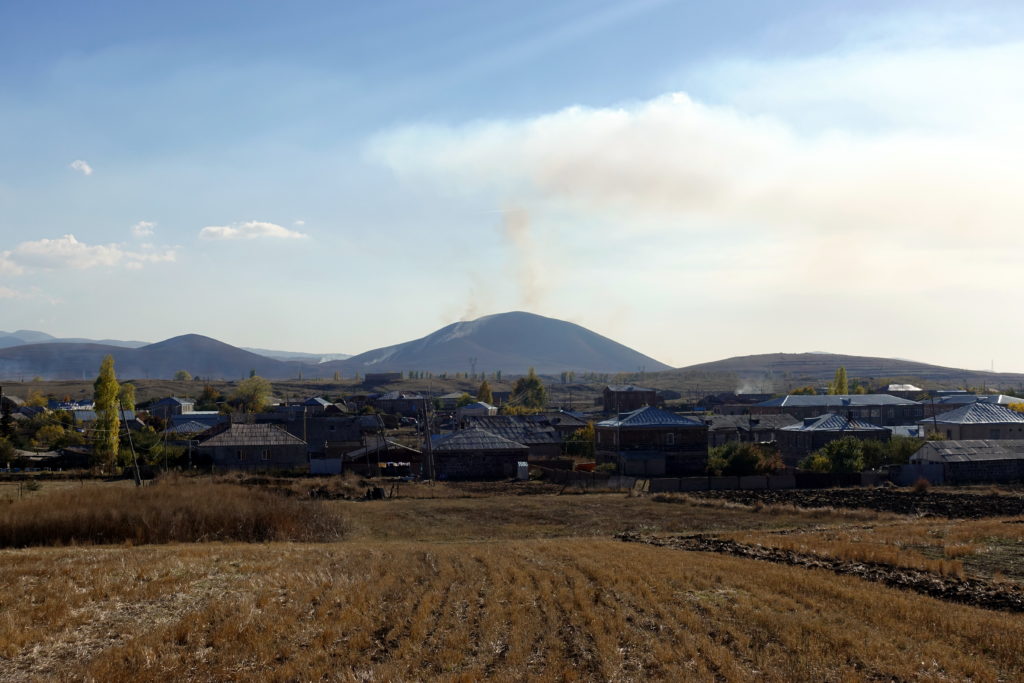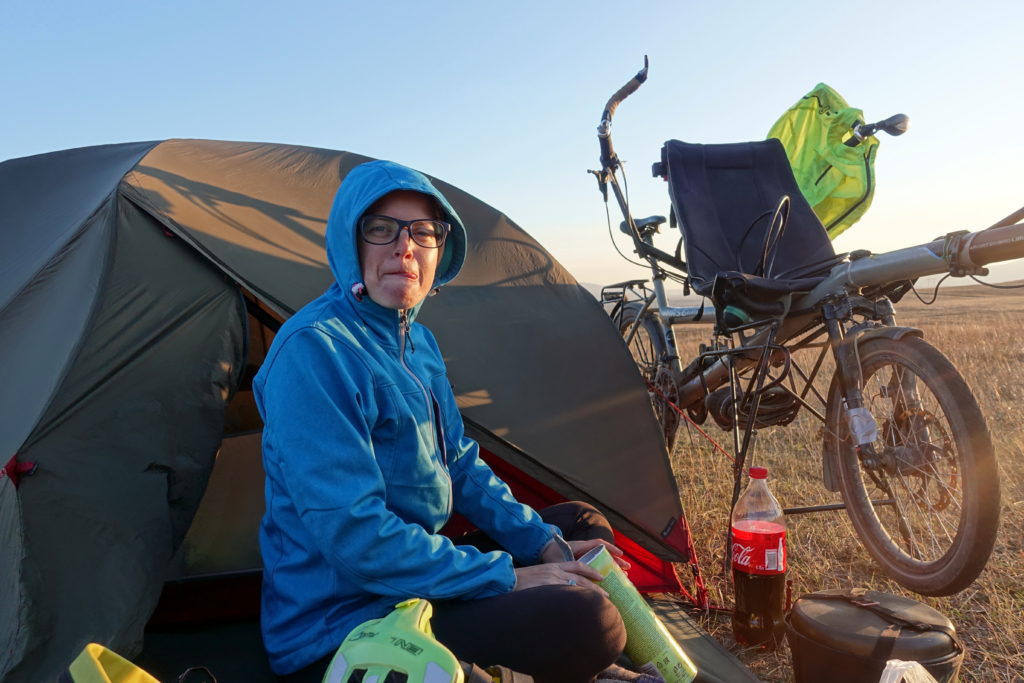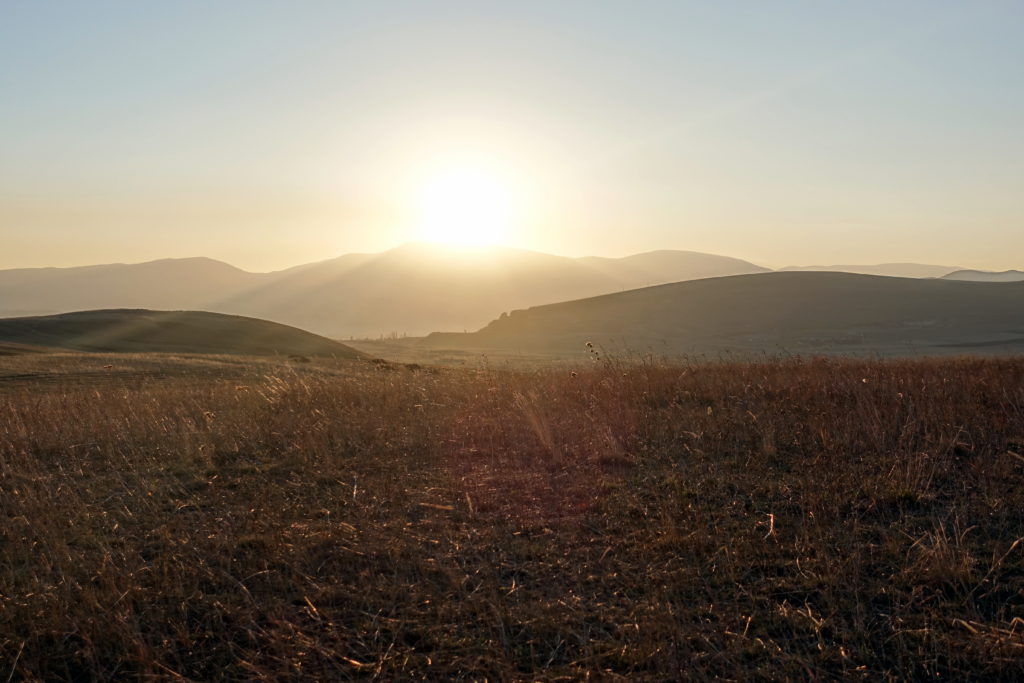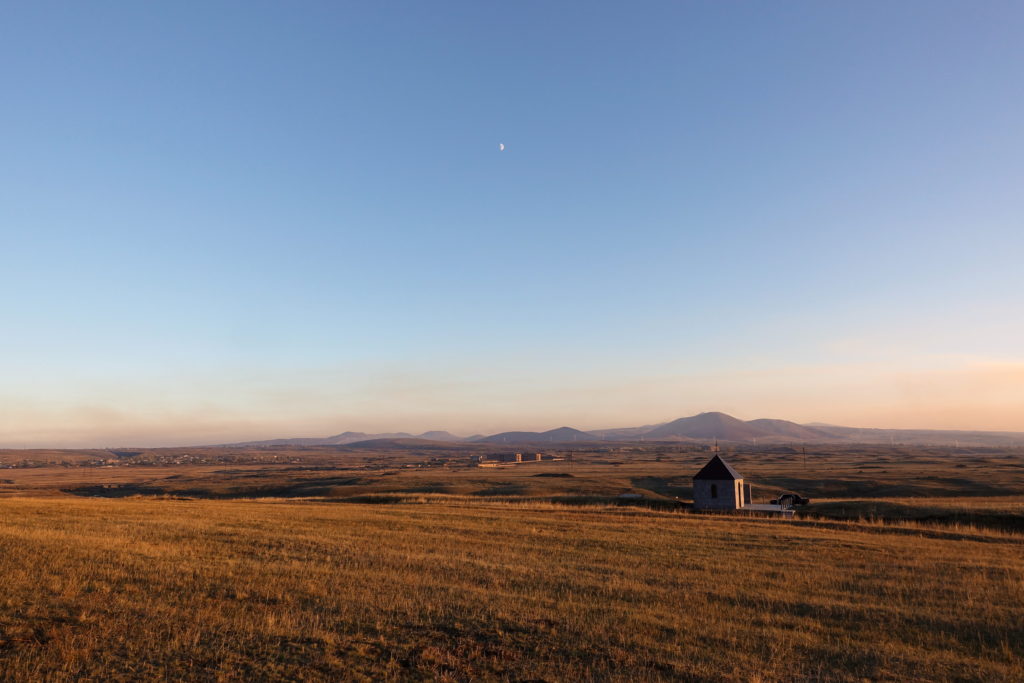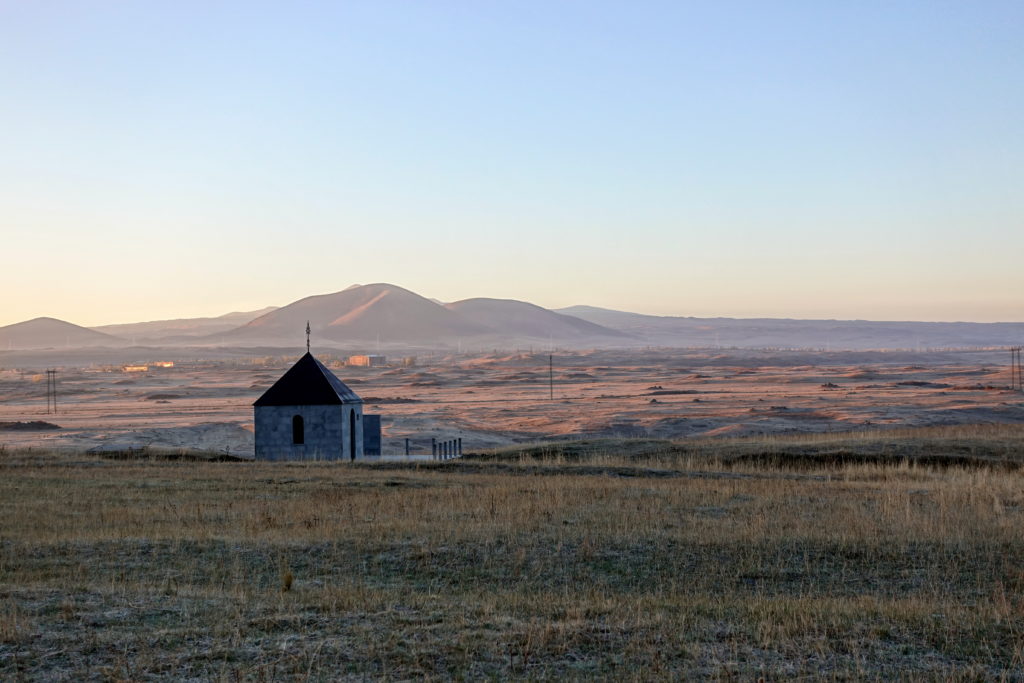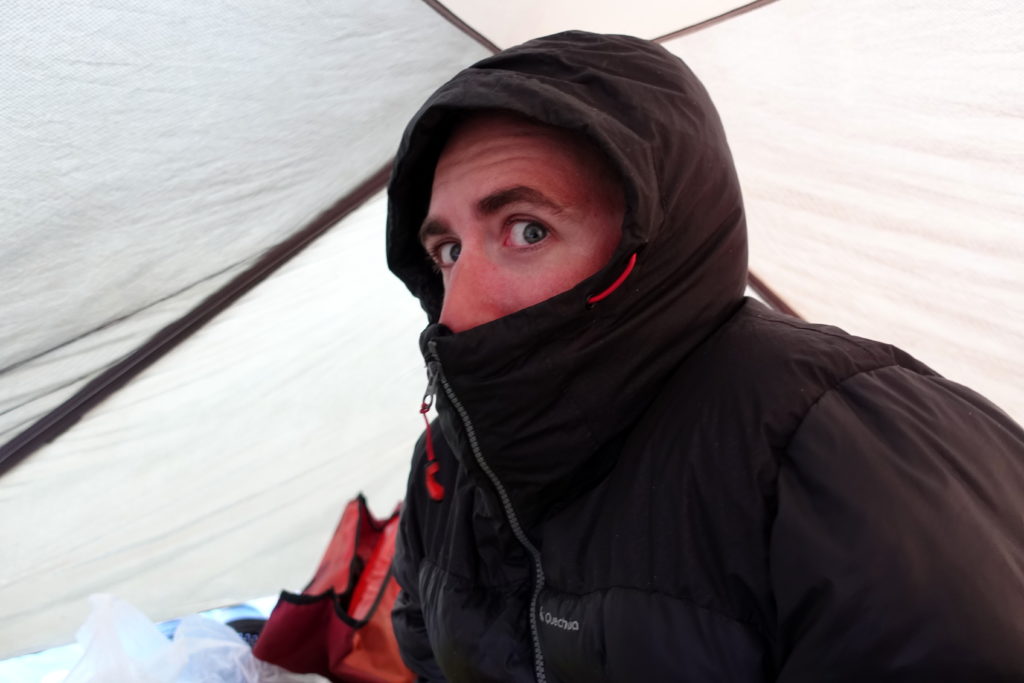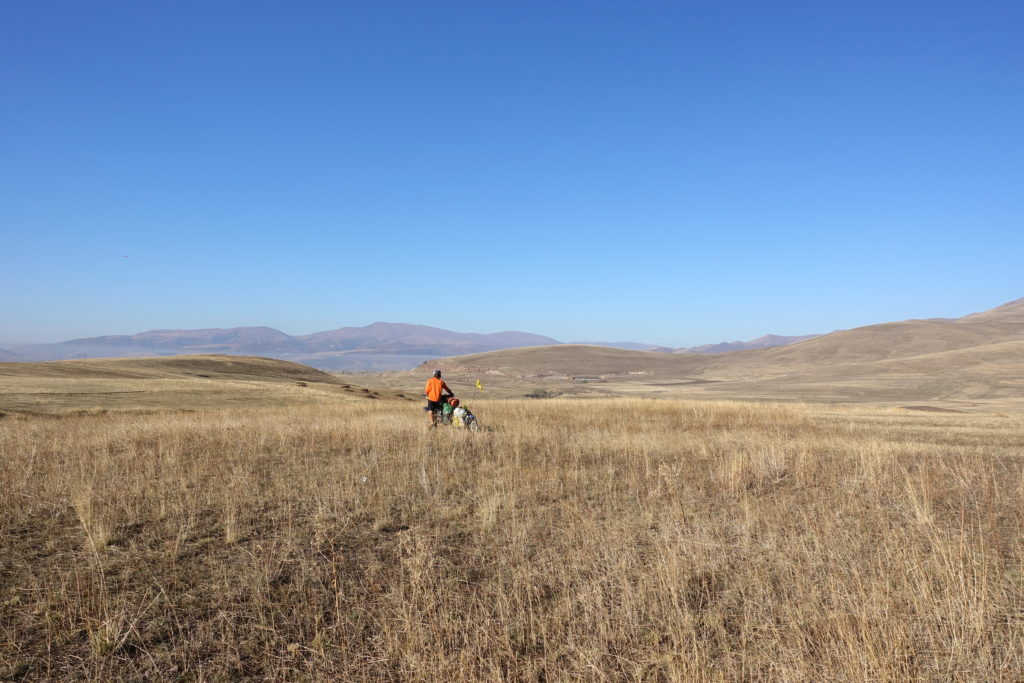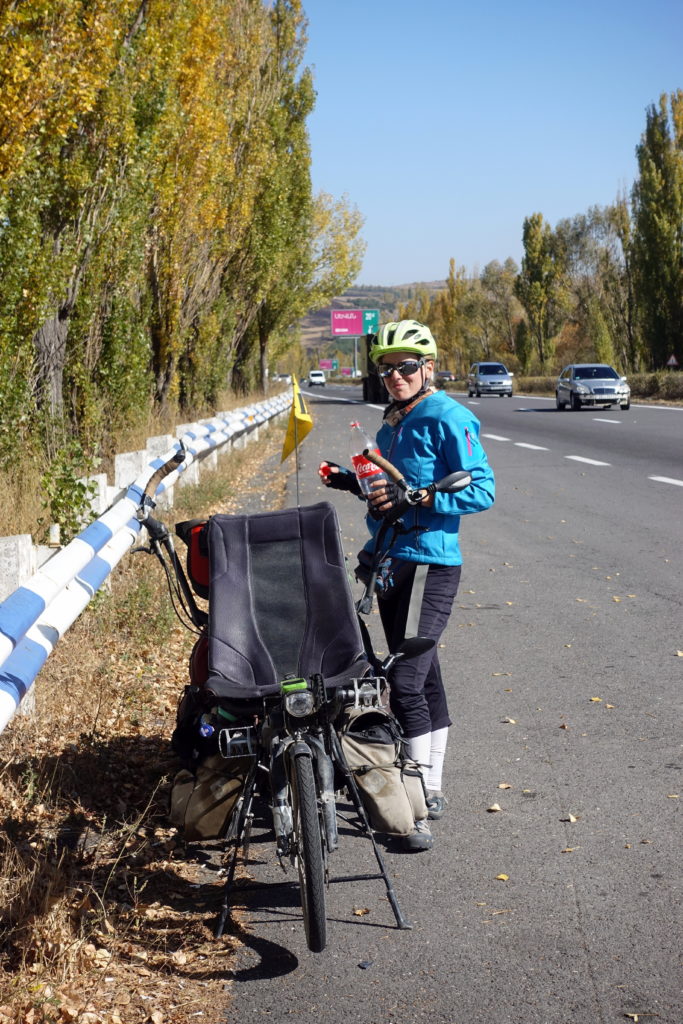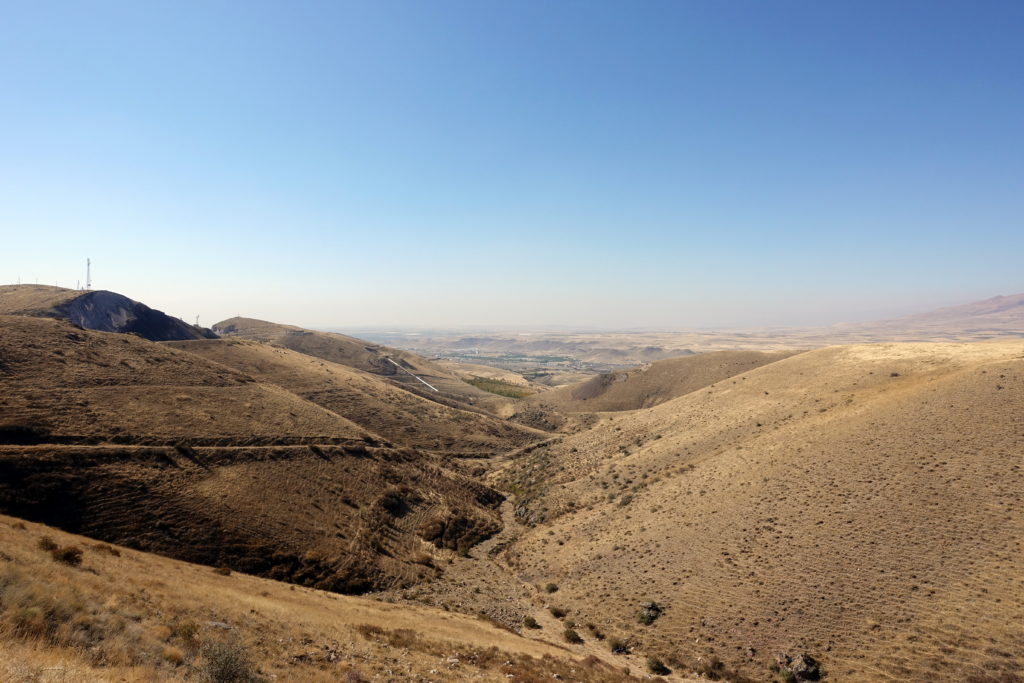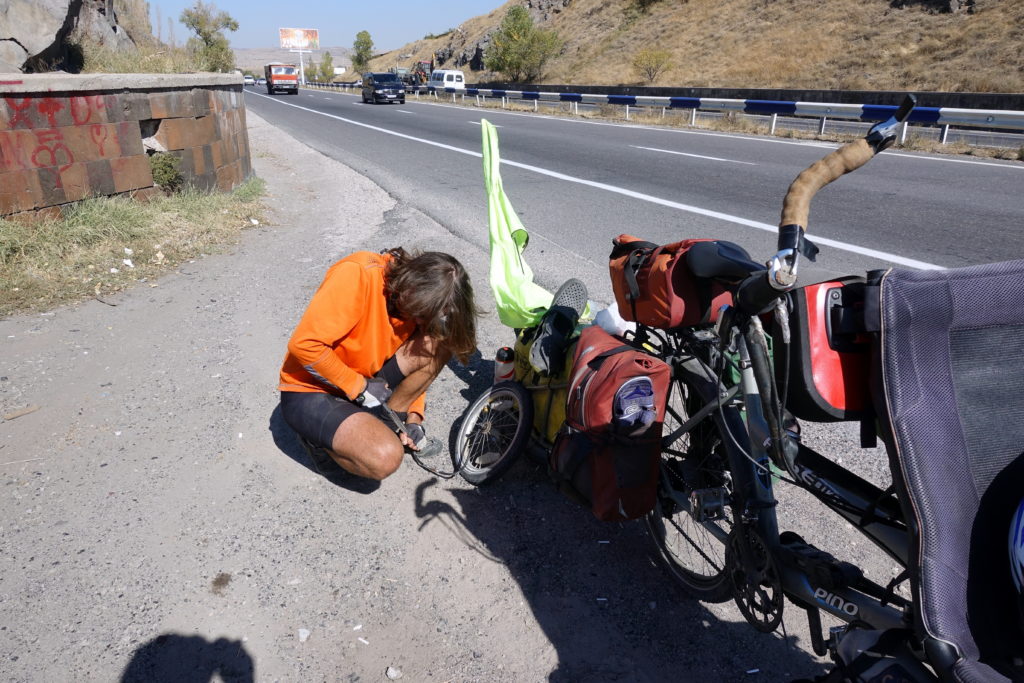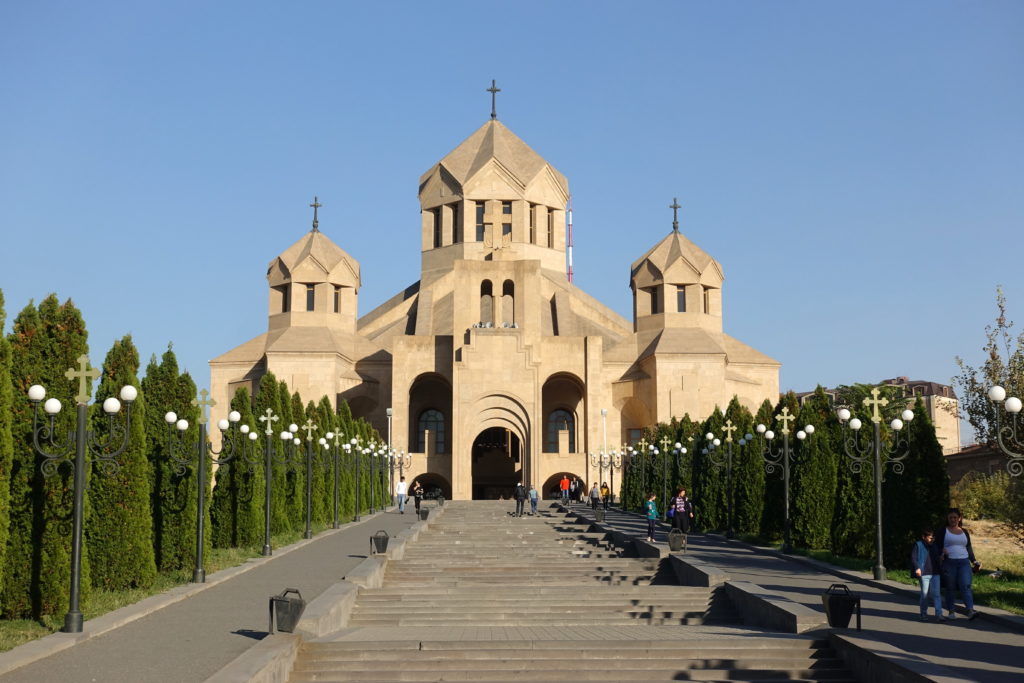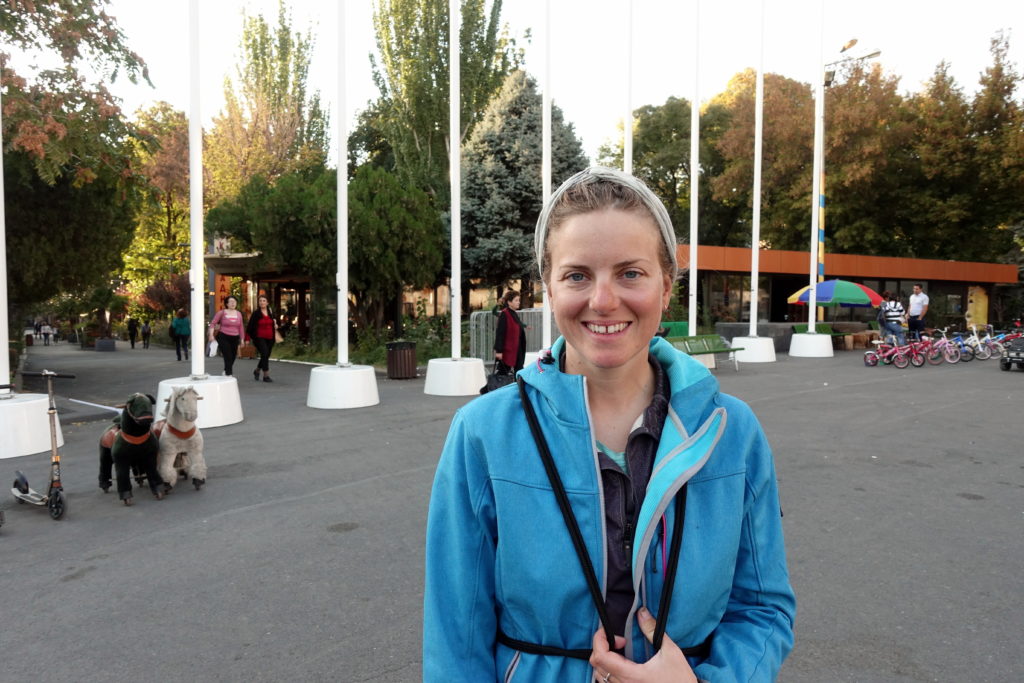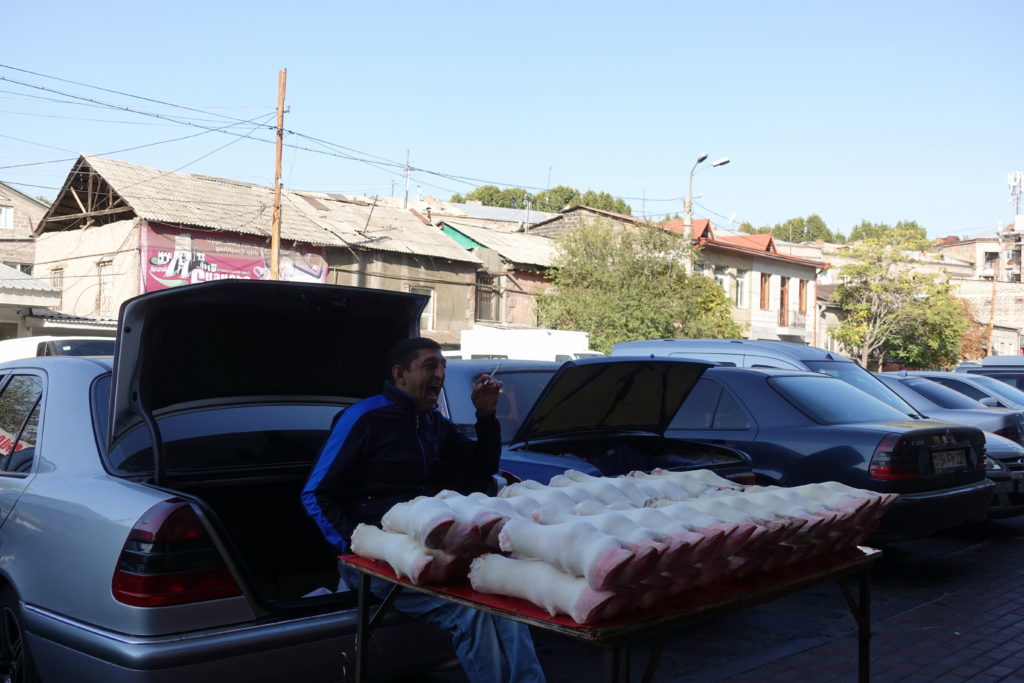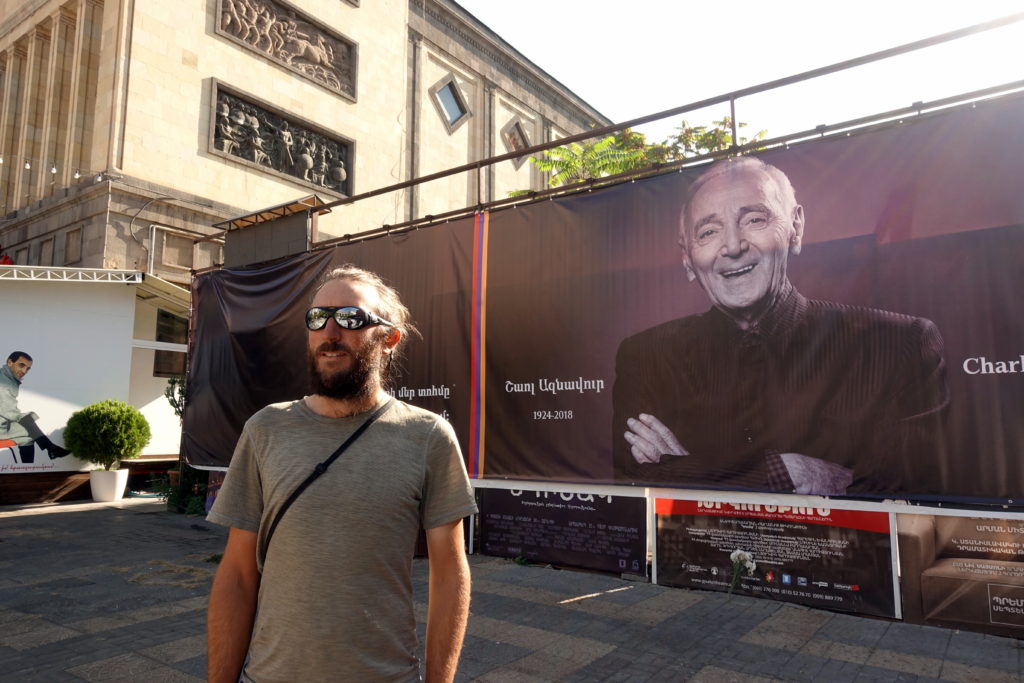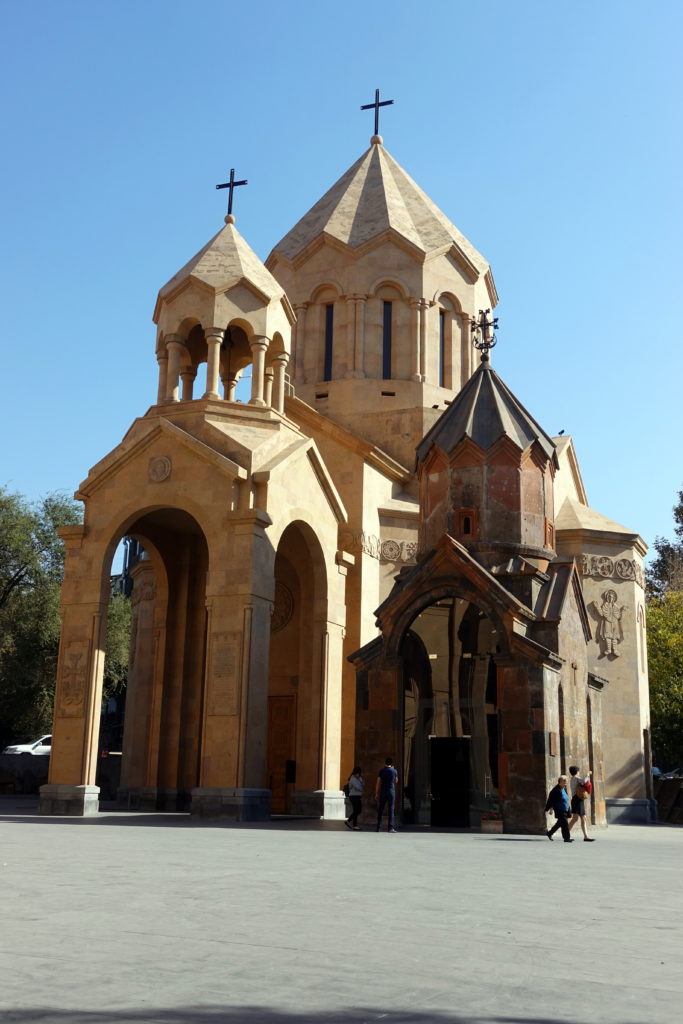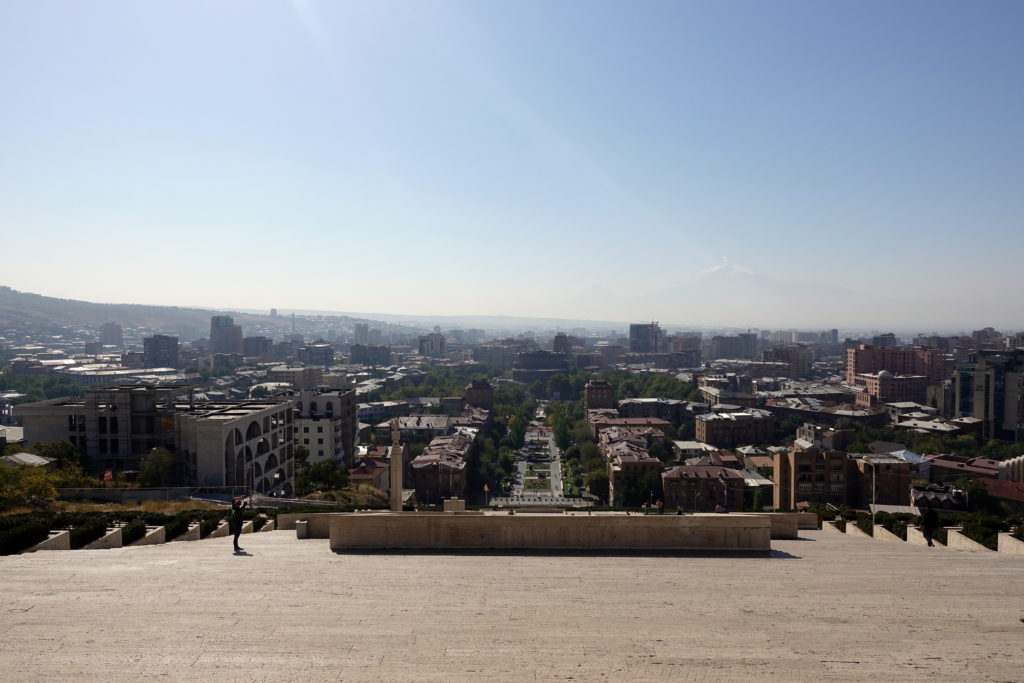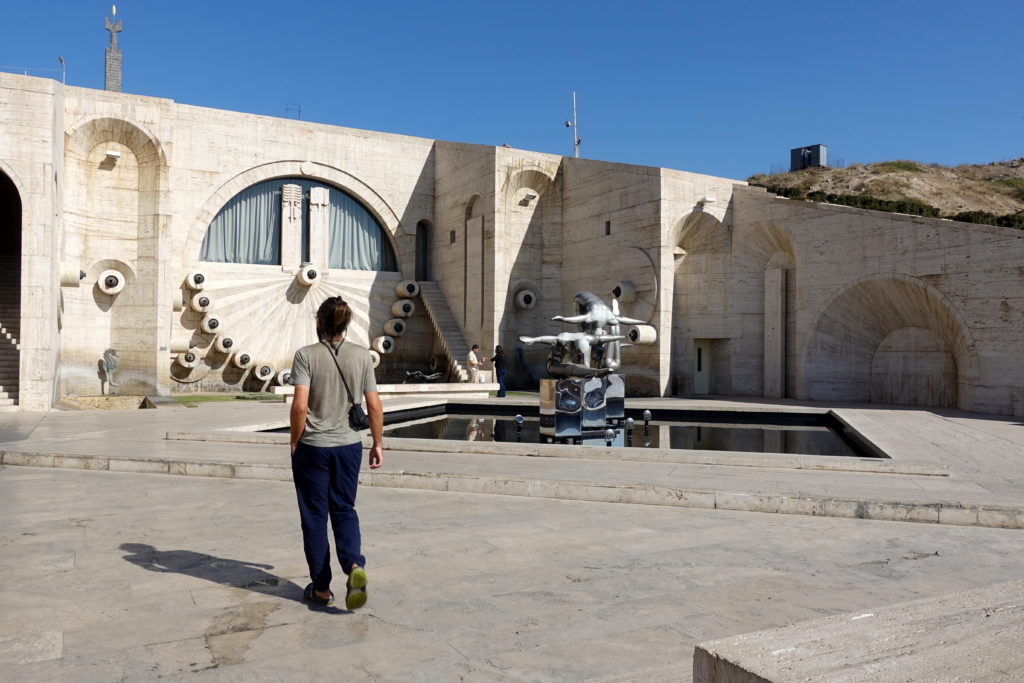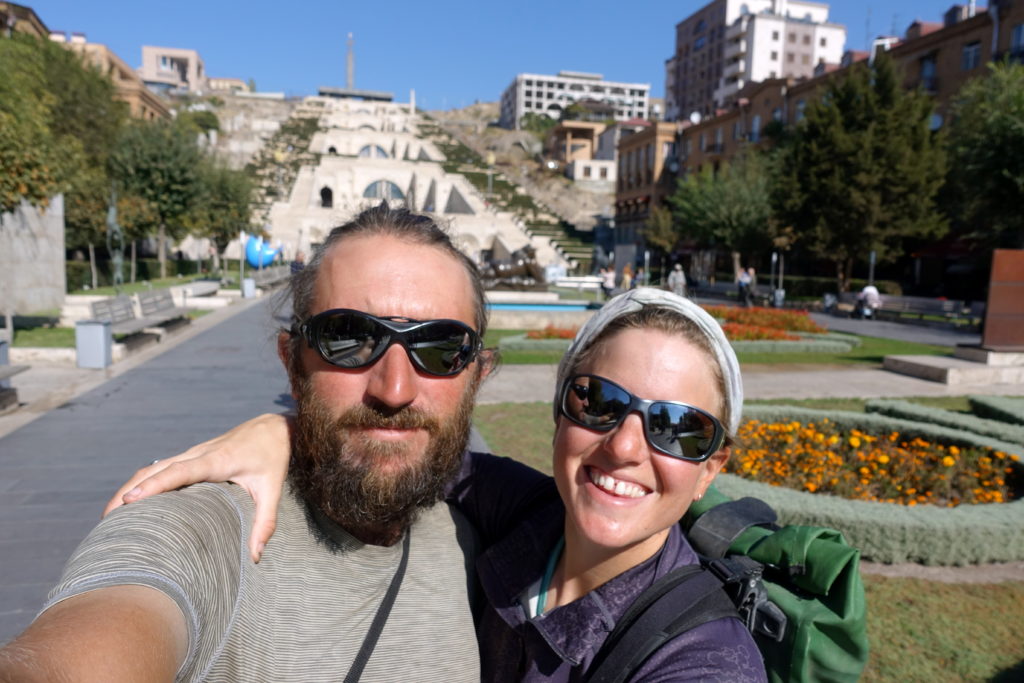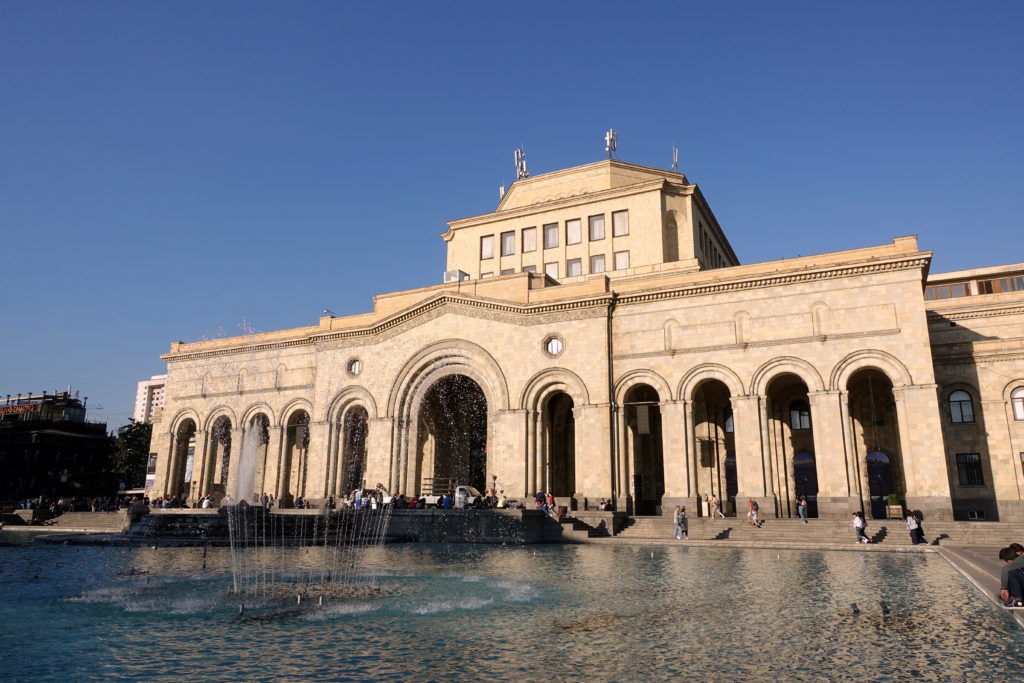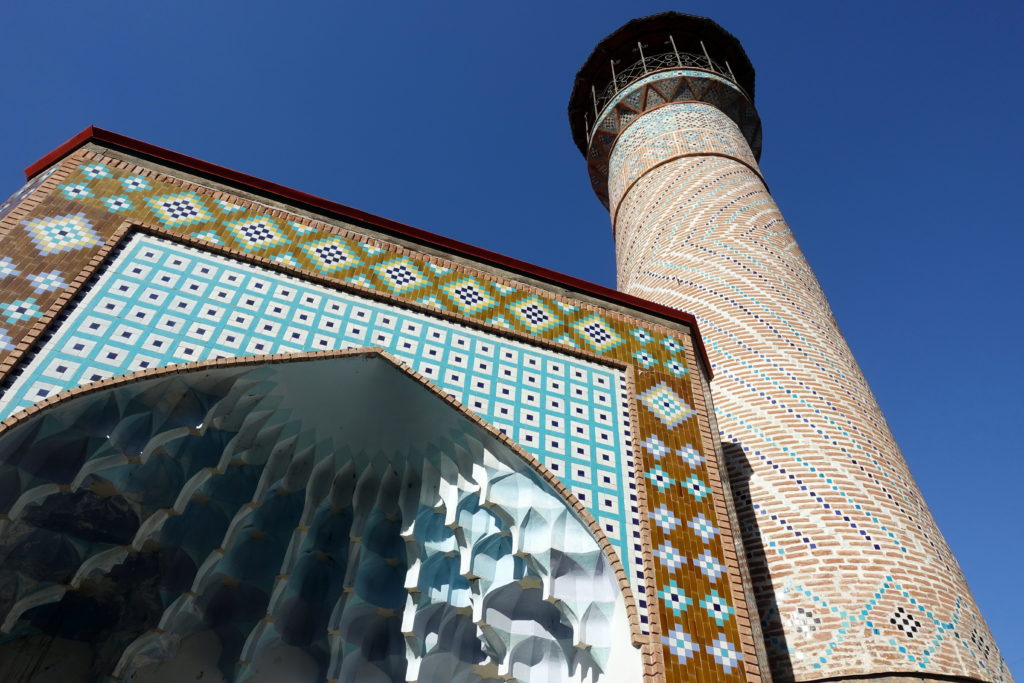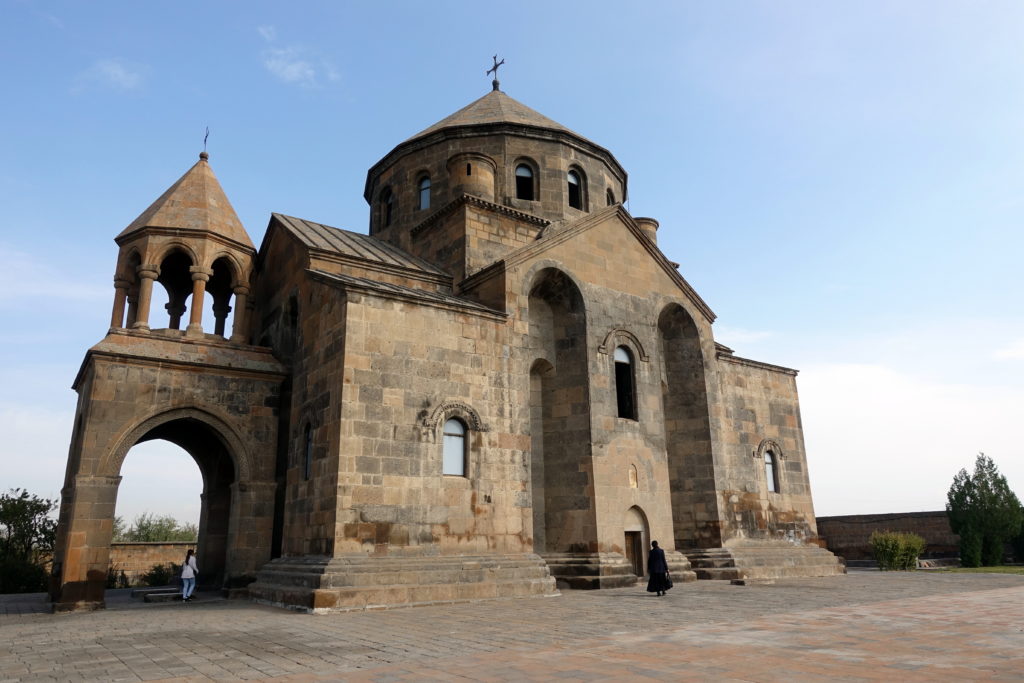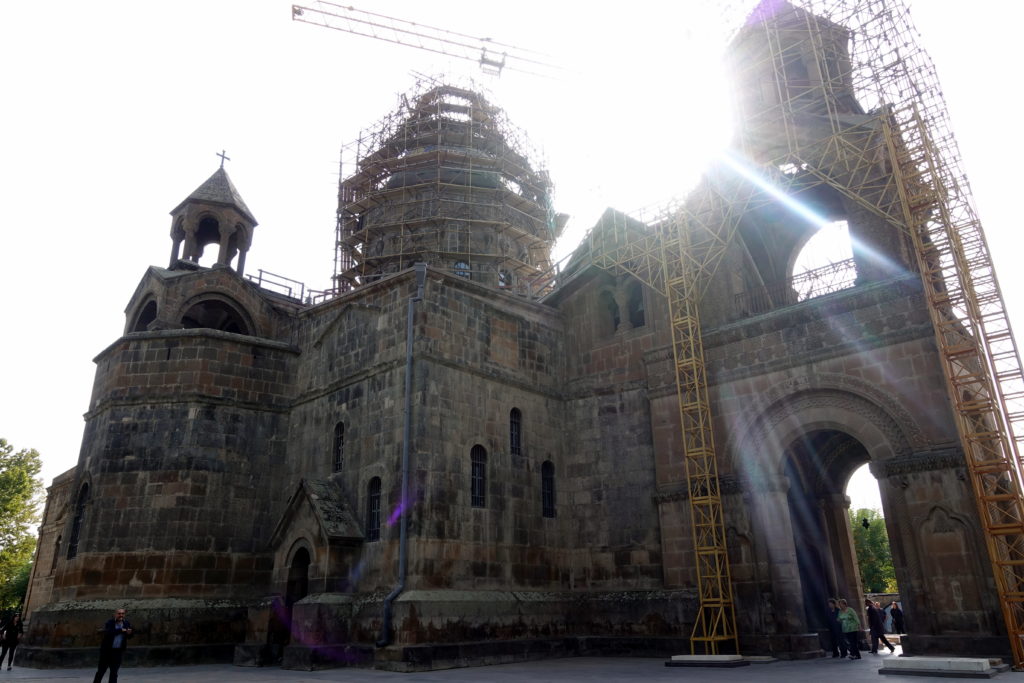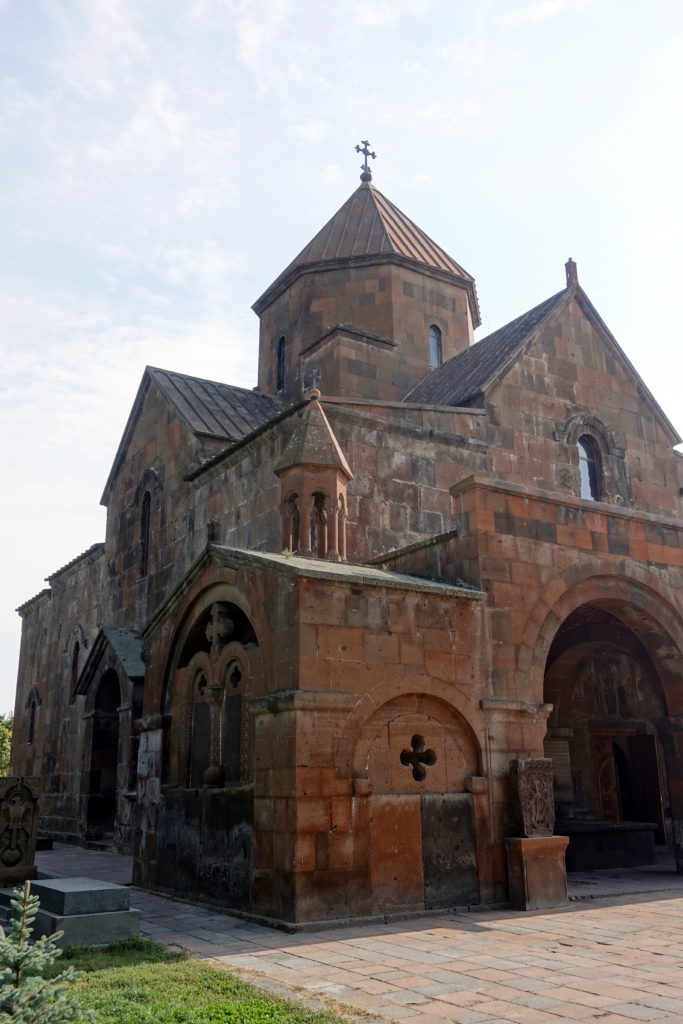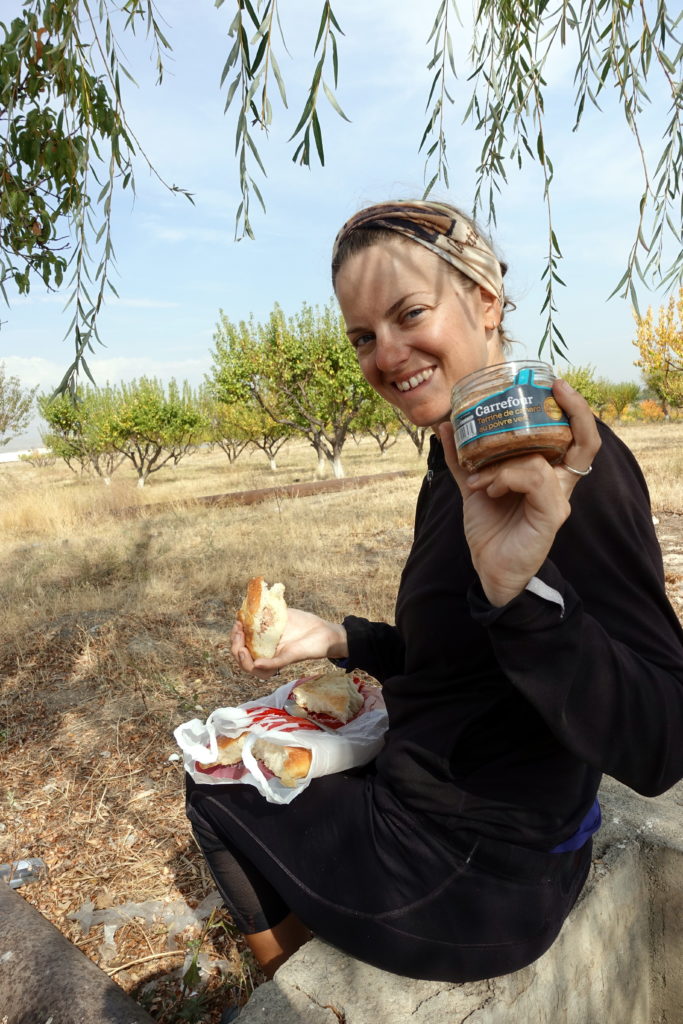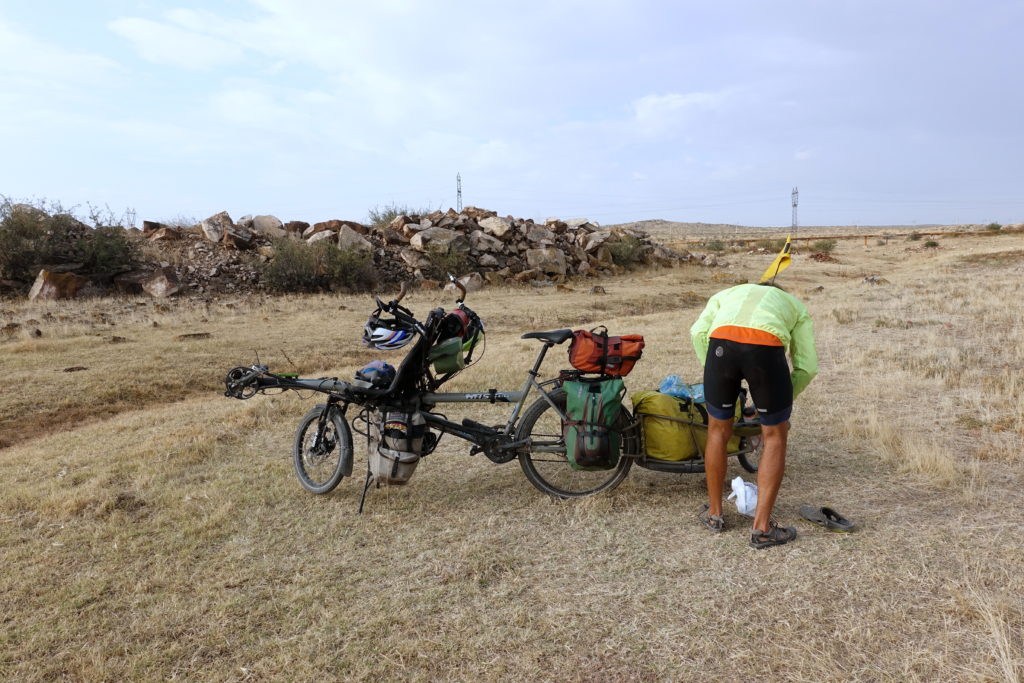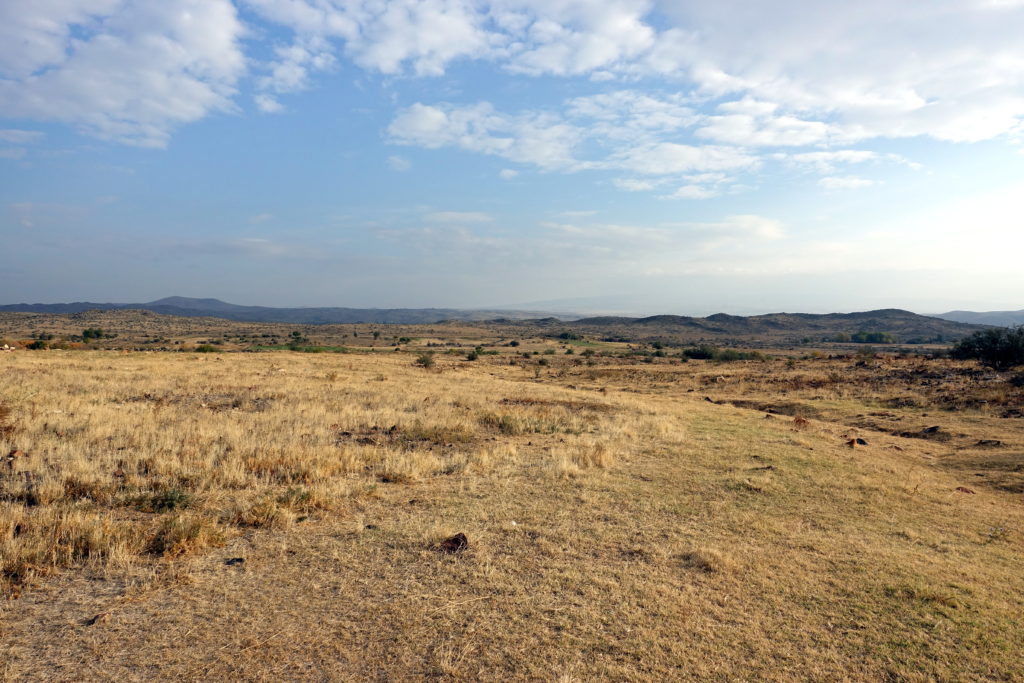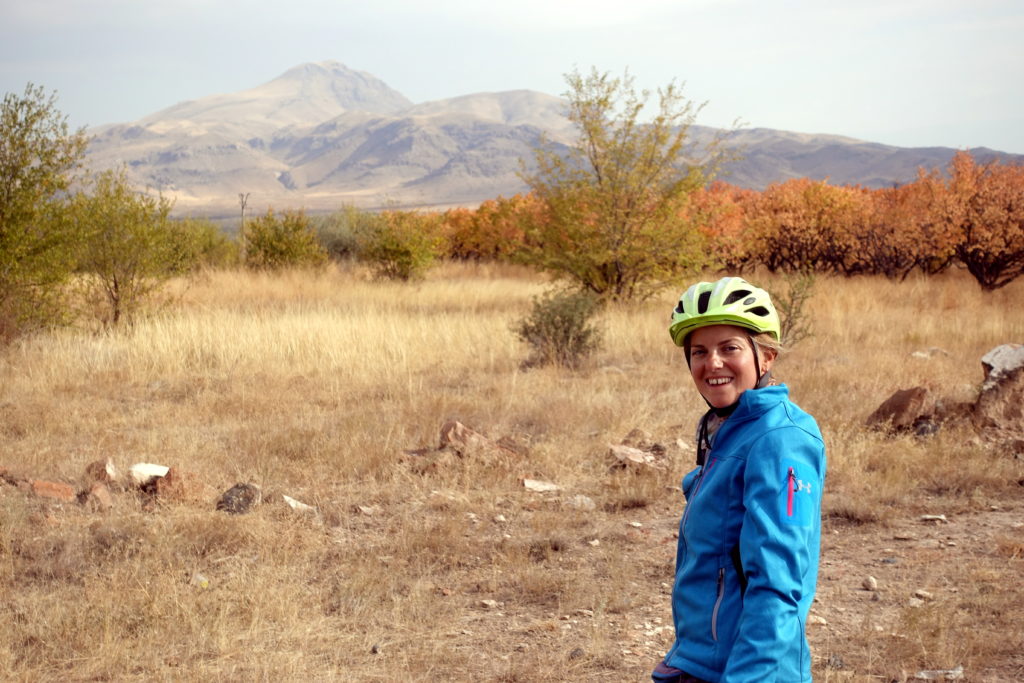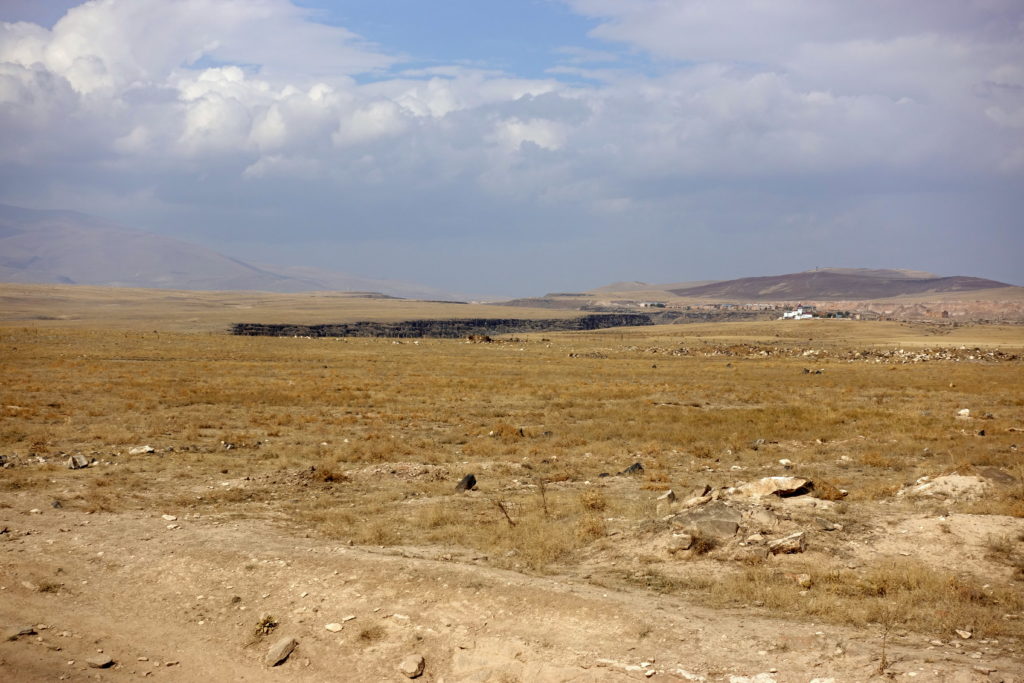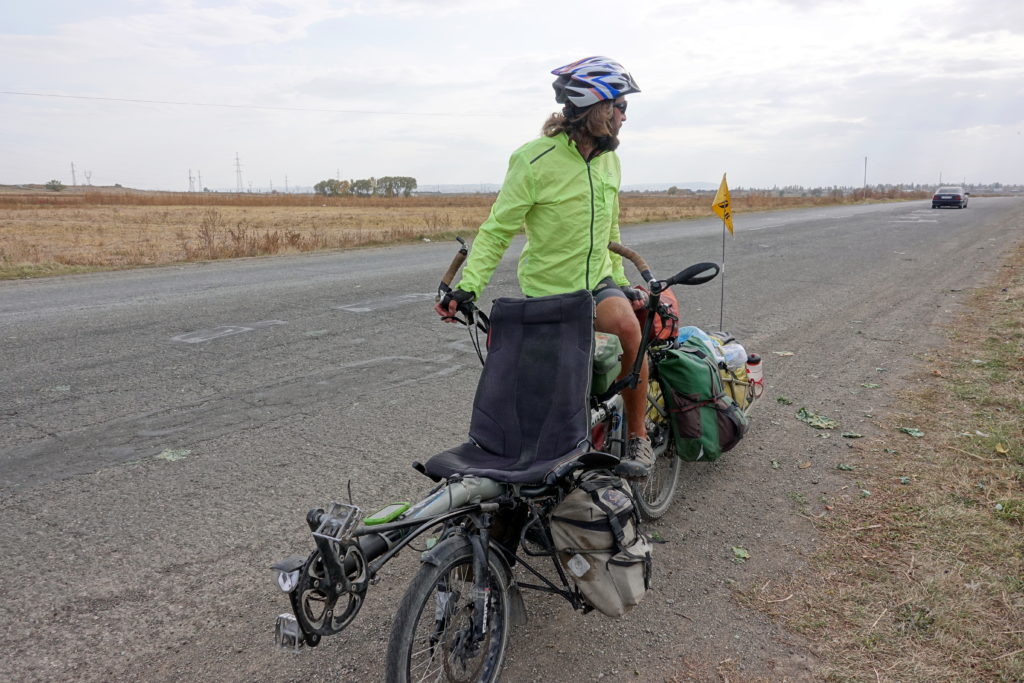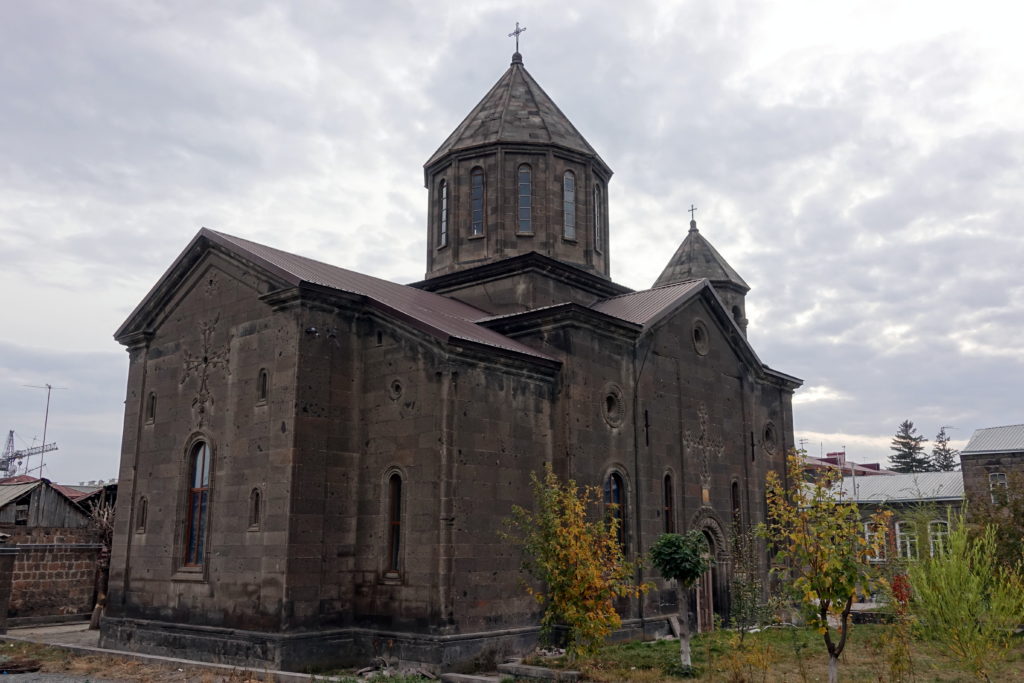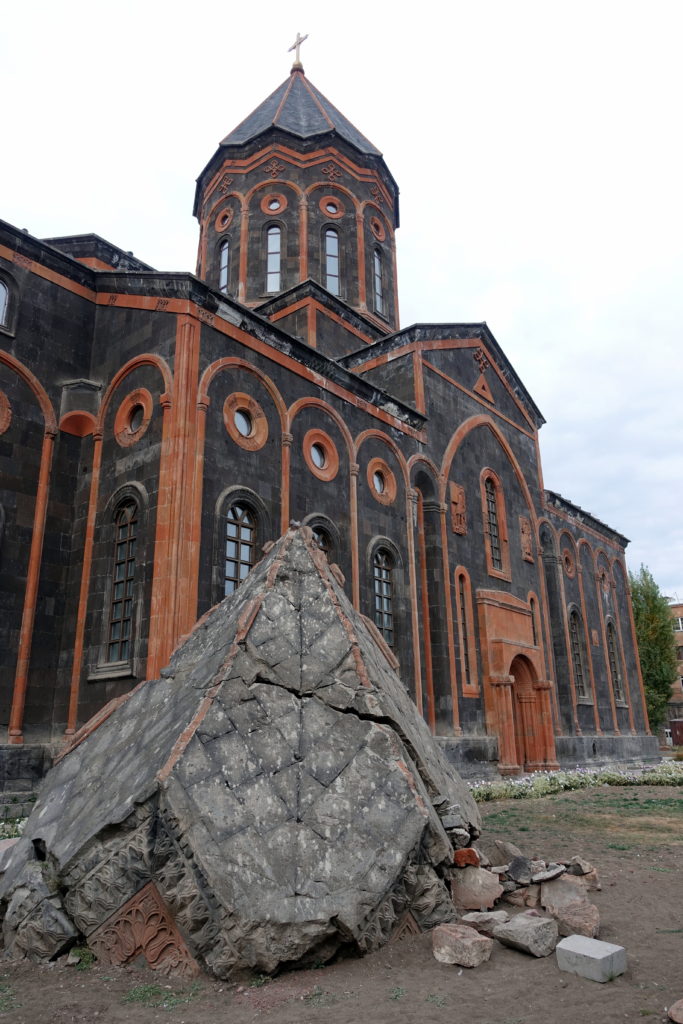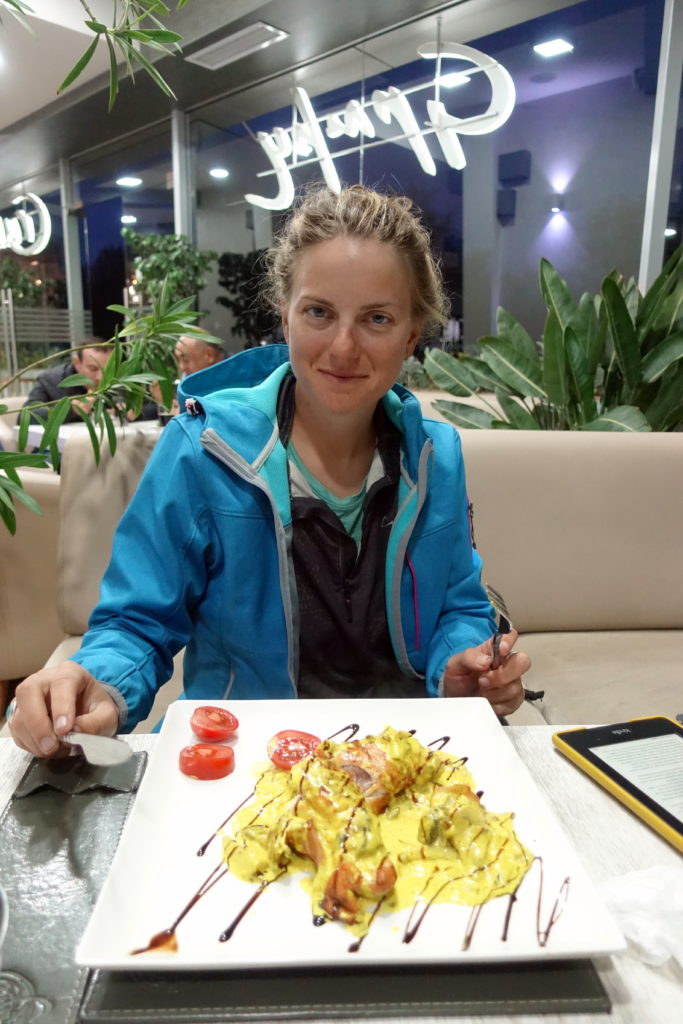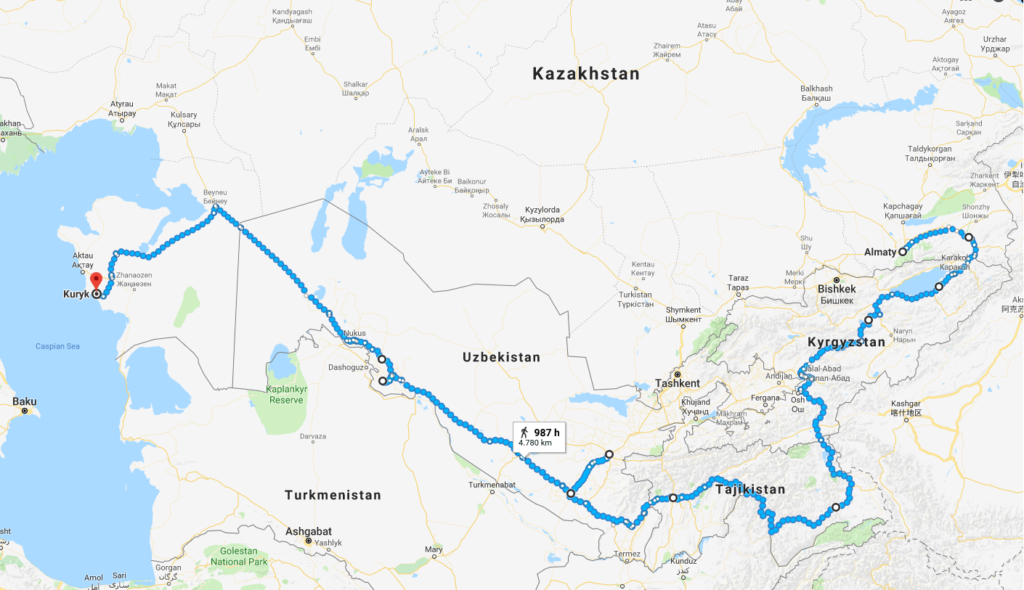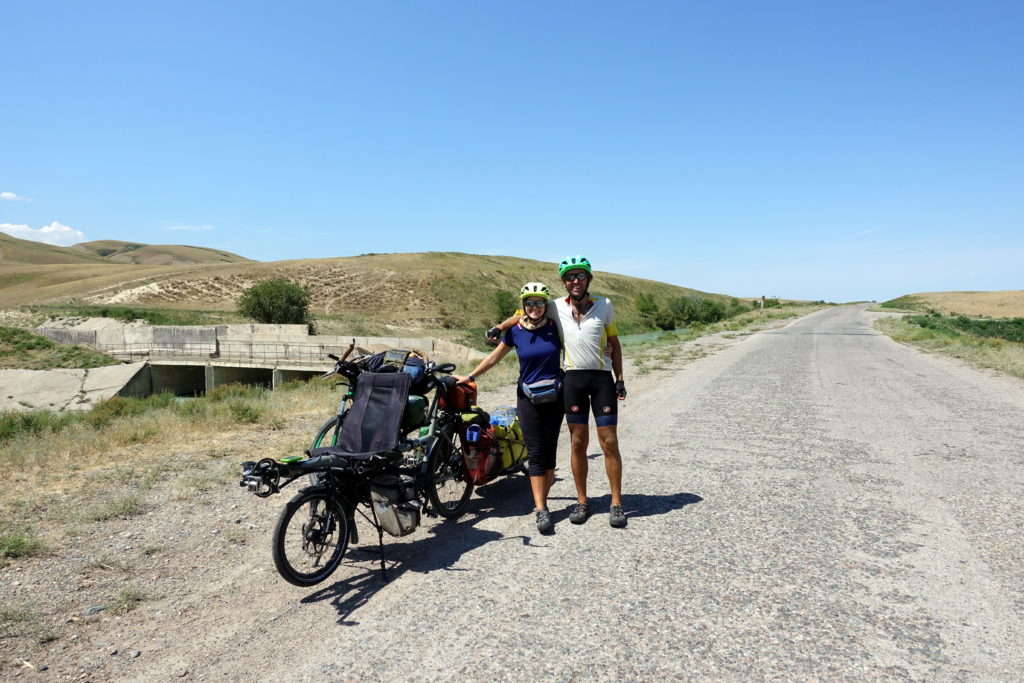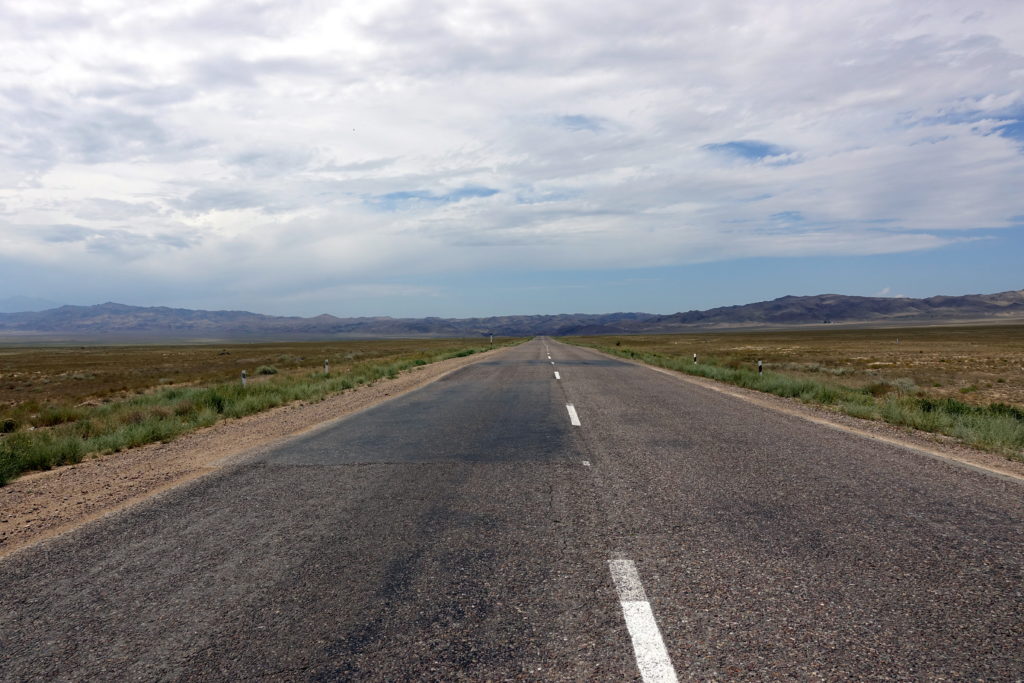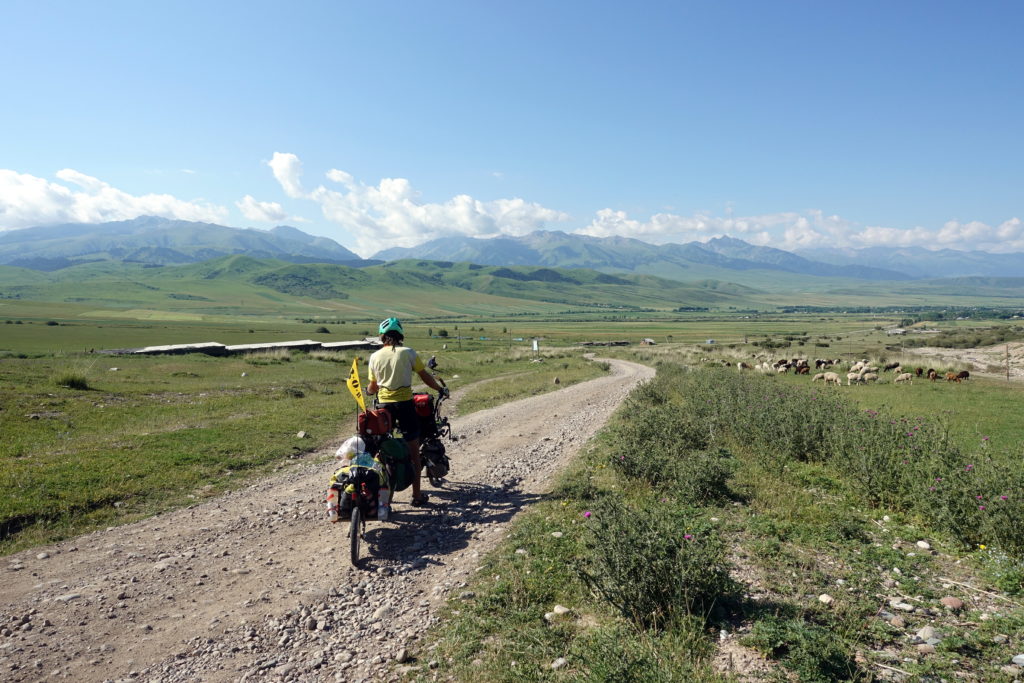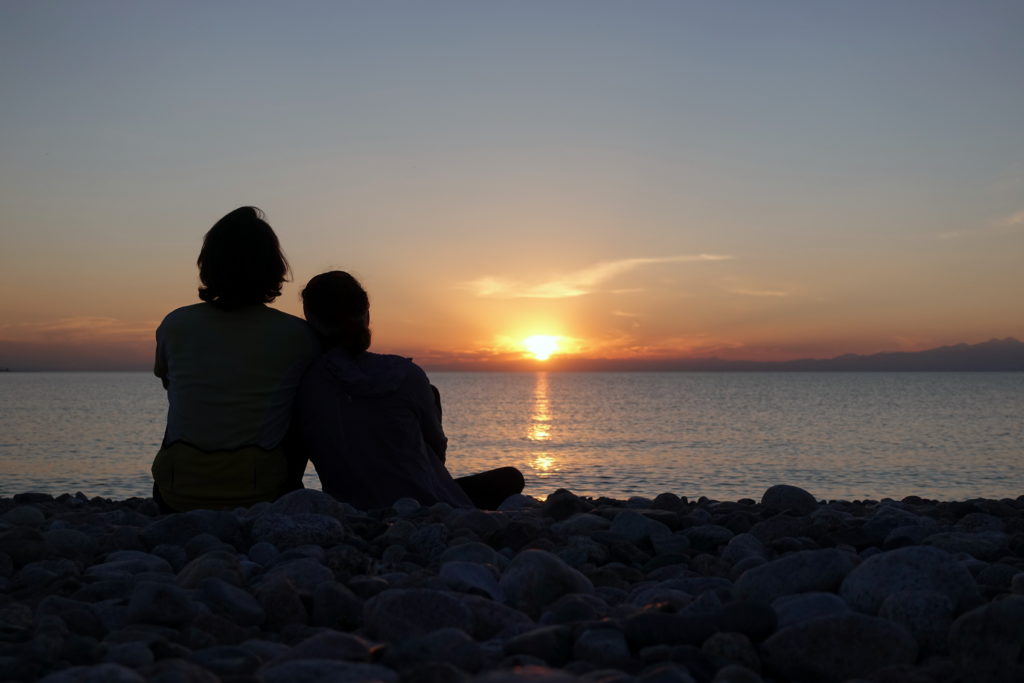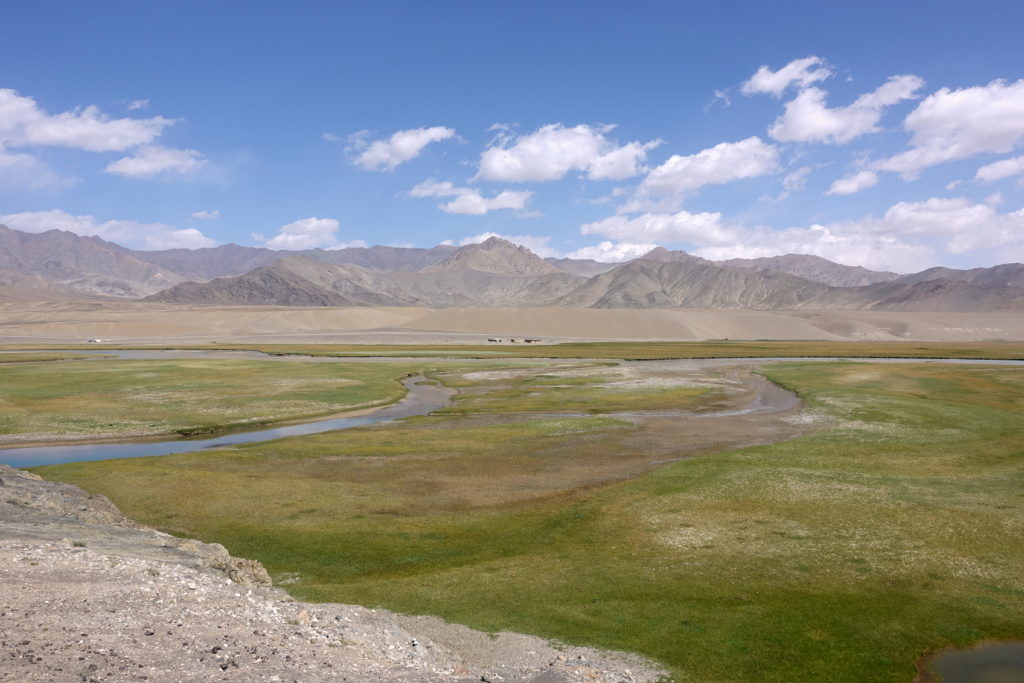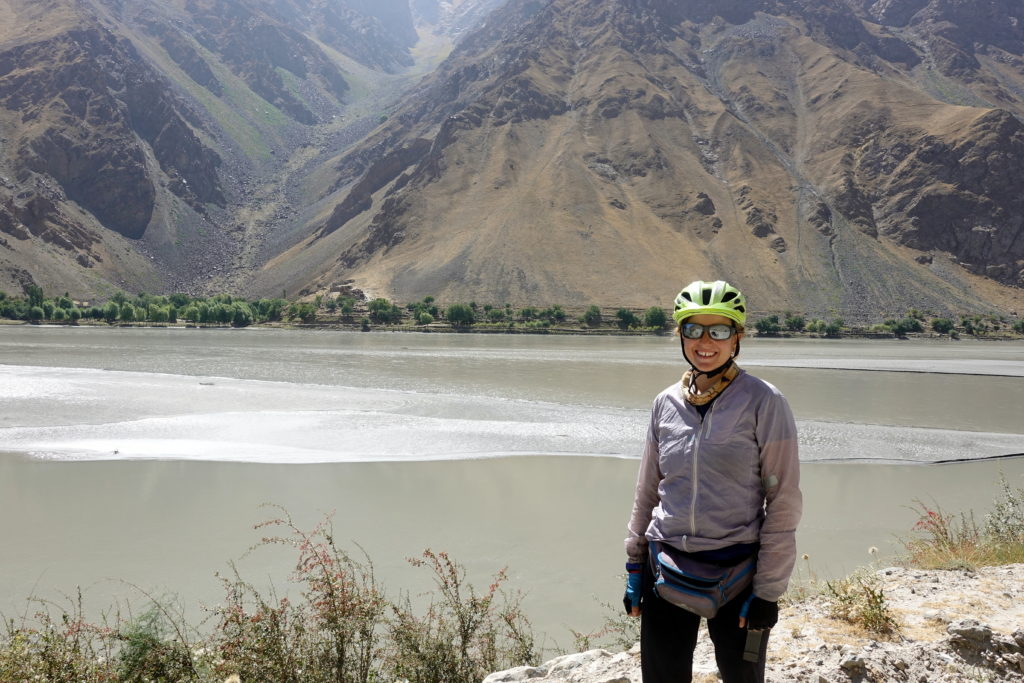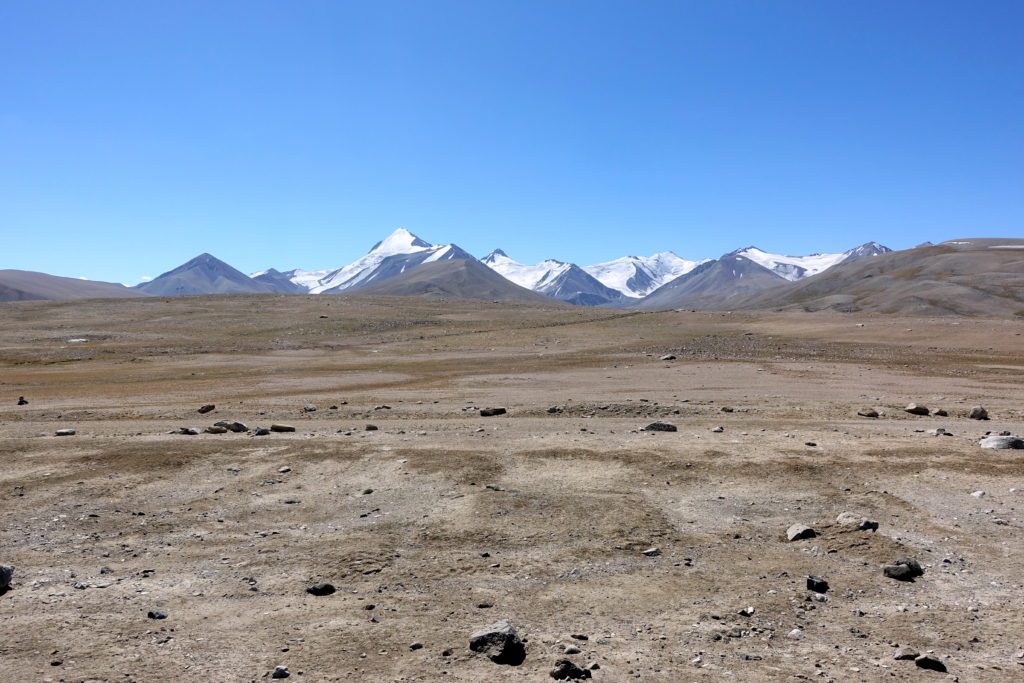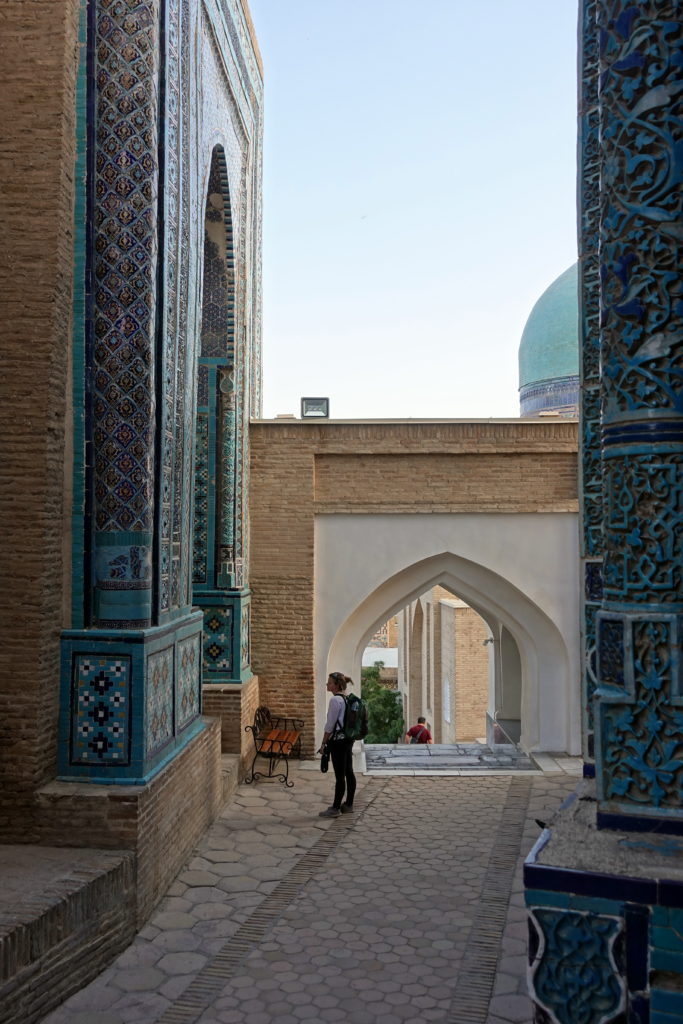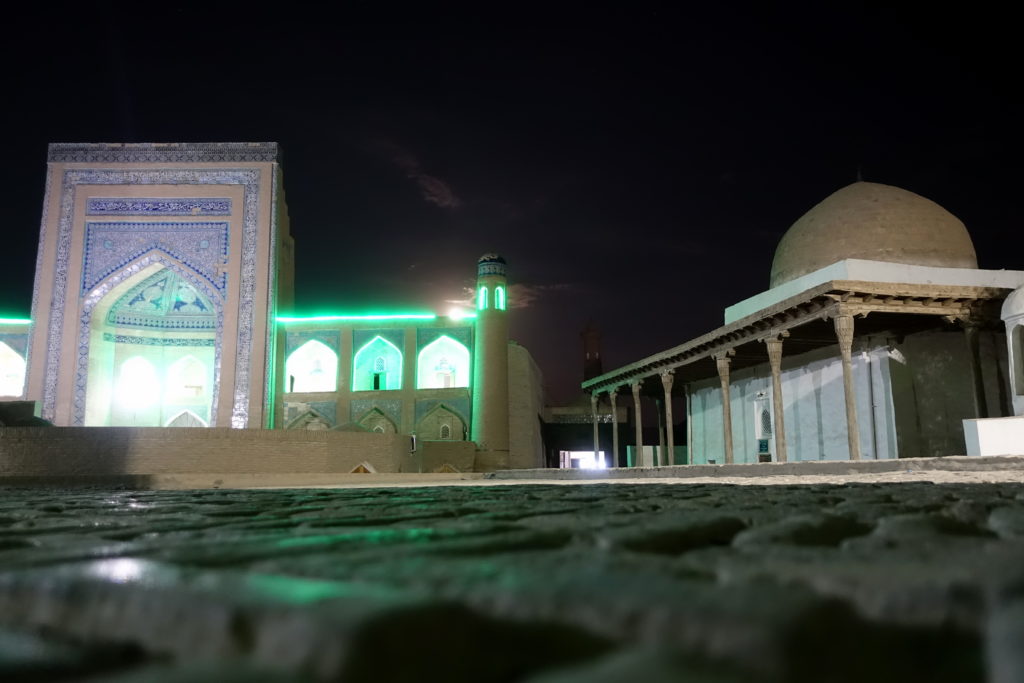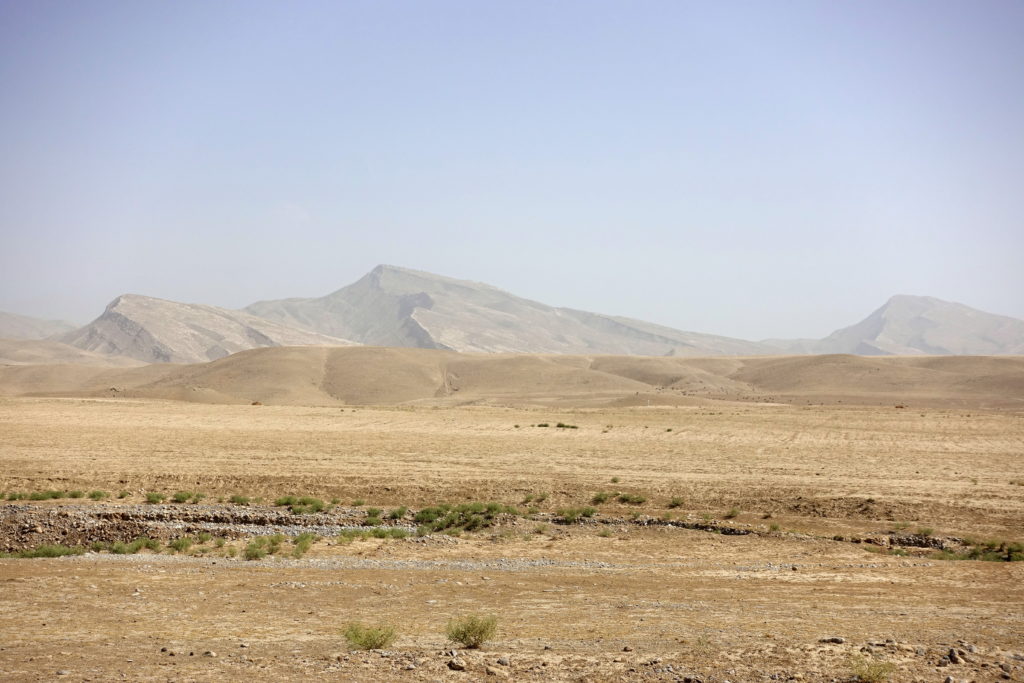Our first day in Istanbul was probably very different from a usual tourist tour: we first started by visiting the nearest Decathlon mostly because Cédric urgently needed colder weather gear (the negative temperatures of eastern Turkey with shorts, sandals and light gloves had been hard!), a few bicycle things, and some goods that we had not been able to find for months (granola bars!). We then headed to a DIY store nearby to get “better-quality-than-Kyrgyz” bolts and screws as well as some epoxy glue to fix the light that our careless bus-driver had ruined the day before – our 4* hotel should not mind us mixing the epoxy compounds in the conference room where we had stored the bike! We finished the day by another visit to the French supermarket Carrefour to get a large bag of chocolatines. Cédric has been more often in a Carrefour between Tbilisi and Istanbul than in the last decade in Europe…
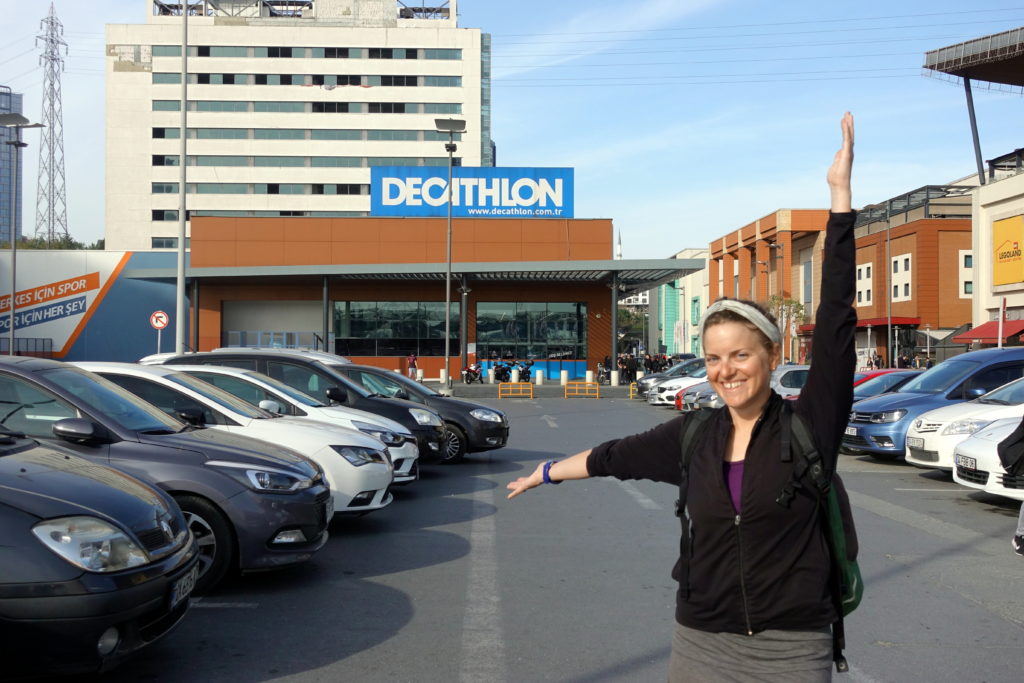
Decathlon! Cédric’s been dreaming of warm bike tights and granola bars for a long time. The most awaited sight in Istanbul!
The second day was a little more standard with a tour of a few famous mosques, the grand-bazaar, then strolling through small streets, getting the traditional fish-sandwich under the Galatasaray bridge facing the golden horn, and finally walking around the Hagia Sofia and the blue mosque. We had little interest to queue or pay to get into any museum and other tourist attraction, so we spent the entire day just enjoying the city, walking around and getting food whenever something felt interesting! We had been slightly annoyed in the eastern part of Turkey that lots of restaurants had reduced (or “not available today”) their menu to only Donner and Kebab, so we could finally enjoy some more varied Turkish and Mediterranean dishes.
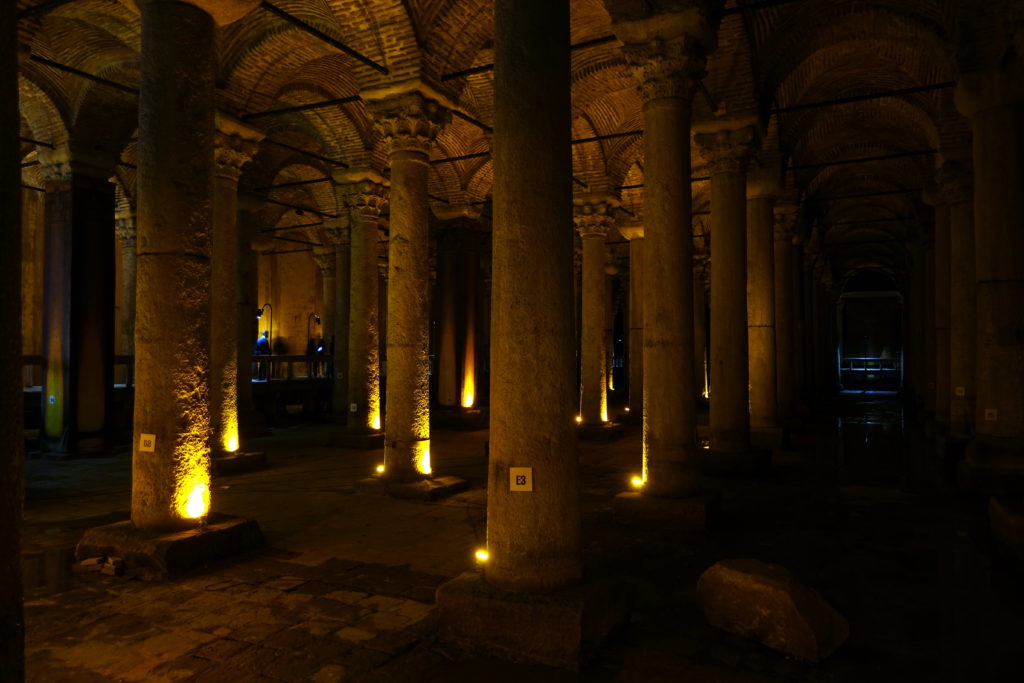
The Basilica Cistern, once an underground water reservoir dating from the Romans – unfortunately now under major renovations, so a little less impressive.
We left on day three after a gargantuan breakfast at the hotel, direction Edirne – the last city before entering Greece – and a three-hour bus ride. The best way for cycling around Istanbul is simply to avoid it entirely, and because bridges over the Bosporus are again not made for pedestrians or cyclists, the only way is to take a ferry near the Dardanelles strait. For us being already in the European part of Istanbul, that was not really an option, so we would see most of the Turkish Thrace from the window of the bus. Before that we eventually had to struggle with yet-another not cooperative bus-driver: although confirmed by the company, again at the ticket counter, the bus driver just refused us to put our bicycle in the cargo. We hardly understood his reasoning, given that the cargo was far from being full, and he gets the random extra-charge requested directly in his wallet… after some discussions not going anywhere, Cedric just went in the cargo compartment, reorganized all the bags to free enough space for a whole cycling team, and put our bike inside. The driver threatened to cancel our tickets and throw the bike outside but us running down the clock (and having the bike already inside), he put himself in the situation to create some delays and so we finally got to leave.
Once in Edirne (and luckily without any damage to the bike), we were surprised to see so many tourists from Greece and Bulgaria. Edirne was the former Ottoman Empire capital, and has thus similar monuments as Istanbul, but just across the border for Bulgarians and Greeks. It is also a cheaper place to go shopping for them, so tens of buses unload their passengers for some quick-sightseeing followed by a shopping frenzy, mostly cheap plastic things, counterfeit products and lukums… We walked around the city and its multiple mosques or monuments, also enjoying the Aegean Sea warmer temperatures at the beginning of November. We finished our day with a huge plate of Tava Ciger (fried strips of liver), one of Edirne’s most famous dishes.
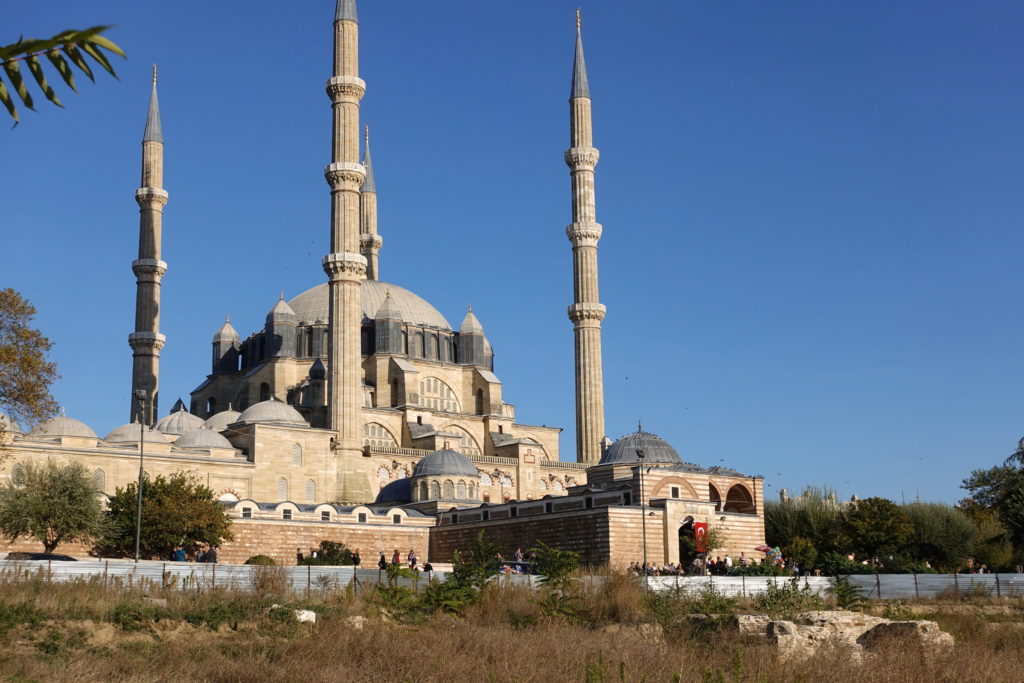
The Selimiye Camii mosque in Edirne, the blue Mosque of Istanbul is a copy of that one but with a lot less tourists in here (back then the Ottoman capital was Edirne)
The next morning, Cédric and I set off in the direction of the Greek border. The morning was cool and misty, an enjoyable contrast to the icy temperatures in Eastern Turkey. As we rode east, we noticed that area felt more European than other places in Turkey – some streets still had cobblestones, people were less conservative, a lot less gender separation, and generally everything was more relaxed. We were also aware that this area is where many South Asian and Middle Eastern migrants attempt to cross into Europe; in theory, it’s a quick swim (or boat ride) away is you don’t have the right passport. As we bussed across Turkey, we met a few Pakistani guys who told us that their goal was to reach Germany… While they were looking and talking to us like if we were half-gods – they had obviously never or rarely been directly with Europeans before reaching Istanbul, we were hesitant to tell them that the path would be more difficult now, with an increased police presence, infrared cameras, and border fences. For us, the border crossing was relatively uneventful – we waited for our stamps and joked with the Greek police. Greece was for us a big step forwards and we were feeling almost home by entering the EU (and Schengen area, the Eurozone, etc.!). In the first Greek village, we spent the last of our Turkish money in a small shop and then headed south.
Crossing a border is always surprising as it shows so quickly the differences between countries: Greece felt immediately cleaner, the buildings of a much better standard, but at the same time completely asleep – especially on a Sunday morning. While Turkey has multiple small shops in every town, Greek towns felt a lot less lively, with usually only a few supermarkets outside of larger towns. The demography is also clearly much older on the Greek side, and with the younger generations moving in larger cities, a lot of villages felt very lonely – although well maintained. Our entry into the Greek Thrace was yet enjoyable for cycling after the border, especially with large smooth roads with little traffic, often with broad shoulder, sometimes even with a service road. In the late afternoon, we found a camping spot deep in fields off the side of the road and enjoyed a night of near complete silence (there’s always a few barking dogs somewhere).
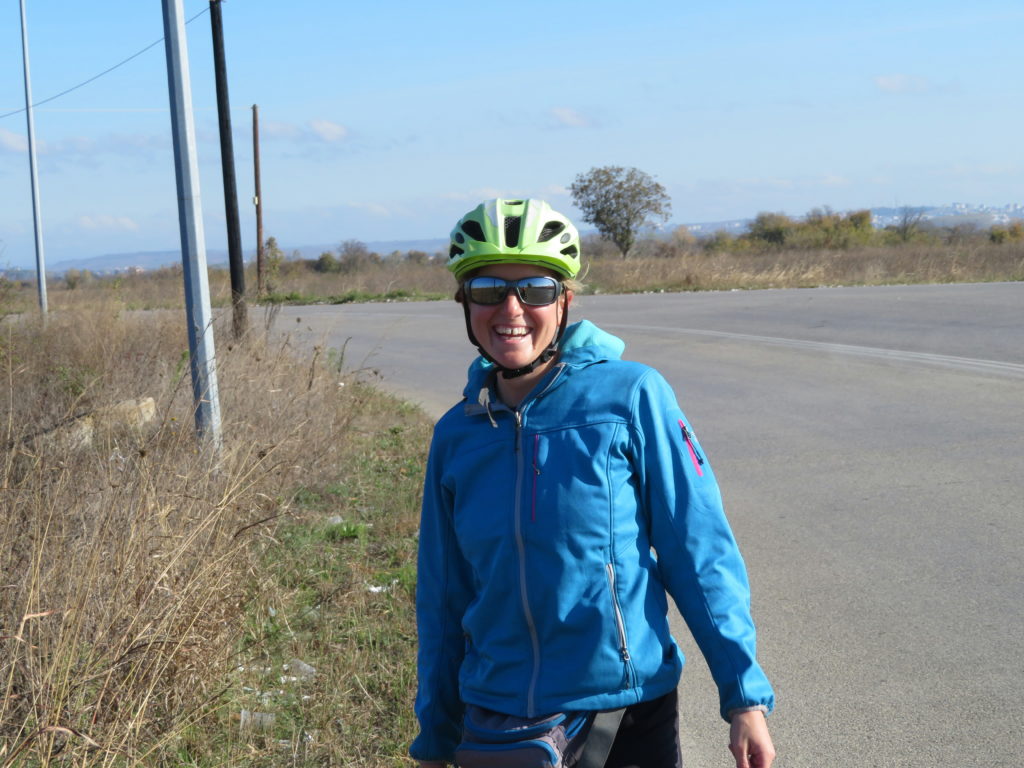
In Greece, surprised to see so many Cotton fields – with memories of Uzbekistan (except that Greece uses heavy machineries instead of slavery)!
Once we awoke and packed our things, we hopped on the bike and headed for the coast. Although our plan was to spend just a few days in Greece before cycling through Bulgaria, we wanted to make the most of it by seeing the Mediterranean Sea (more precisely the Aegean Sea). In the morning, we followed quiet roads through empty cotton fields and olive groves. We arrived in Alexandroupolis and decided to treat ourselves to some Greek pastries on the side of the sidewalk- in the busy seaside town, I became aware of how out of place we must have looked since most residents were retired and wearing fancier clothes than bike shorts. After debating the route a bit, we decided to continue along the coast despite the uncertainty of paved roads. This turned out to be the best decision because the road became quieter and the views more impressive. We stopped for a picnic lunch on the construction grounds of an epic monastery that was being built – given the remoteness, we were wondering who was funding this project and why. As the day progressed, the olive groves became denser and the houses less, and we finally got an uninterrupted view of the sea. We continued following the shore on a rough dirt road – now only drivable for AWD – that felt as though it was a few millennia old (it was). As it approached the late afternoon, and having passed too many areas that looked ideal for camping, we found a nice spot between a few olive trees and overlooking the sea. This time, we didn’t run into anyone while setting up our tent, but we did hear farmers harvesting olives off in the distance. We noticed some alignments of stones that looked a little strange – there are no straight lines or sharp corners in nature – we realized the following day that we had spent the night in an archeological site! Ups!
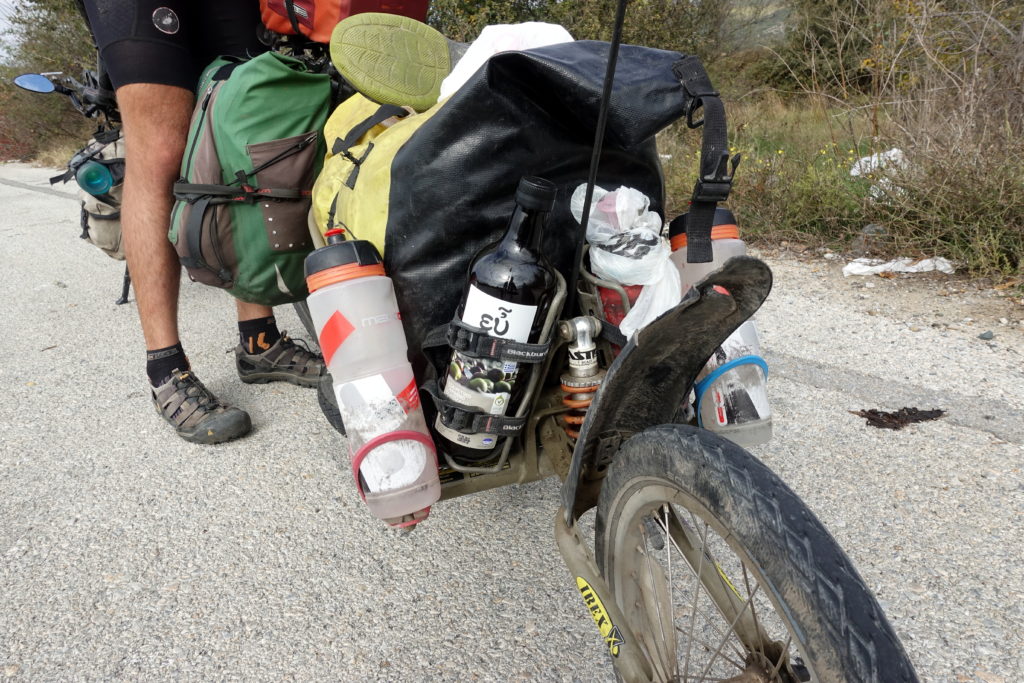
See that liter of olive oil? We replaced a water bottle by some tasty Greek olive oil. That’s why Cédric sometimes gets banned from grocery shopping (he buys more interesting stuff though!).
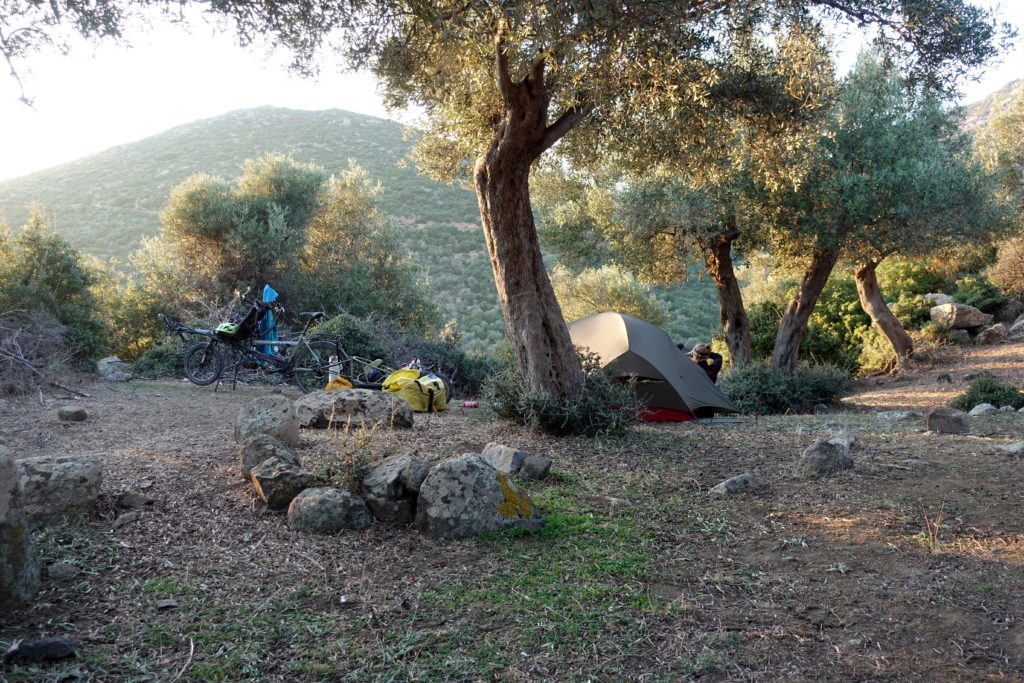
Just a camp under some olive trees – we suspected that the stones were oriented in a not too natural way. It turned out that this was an ancient Greek town.
One more day heading west:
The next morning, we woke up to sun and good weather, which was ideal for continuing down this old dirt track. It didn’t take long before we were constantly stopping and snapping pictures. The morning light caught the shrubby, rocky hills in a mesmerizing way. About a mile down the road, we came upon our first sign that we were riding through an archeological site – there were signs hinting to the ancient town of Ismara and its walls (now barely noticeable) and the role it played in Odysseus’ travels. We rode further and came across the Maroneia amphitheater (though locked) and Dionysus’ temple. By the time we reached the main roads again, the clouds crept across the sun and we were back to grey skies while cycling. We had a quick stop in the town of Ismero and were invited to Greek coffee with a guy who spoke a bit of German (which turned out to be the lingua franca for the next few weeks). Since we had our eyes set on finding a room for the night, Cédric and I cycled like mad to a village way off in the distance. Our afternoon was riding through fields of brown, overturned dirt and a few coastal villages. Finally, well into the afternoon, we stopped at a restaurant to devour some seafood risotto and mussels before pushing out another 37 kilometers before nightfall. Just as it was getting dark, we found our little hotel in Kremasti, a Turkish minority town, and called it a night. Although completely deserted at this time of the year, with virtually no tourist at all, hotels remain outrageously expensive in this area of Greece in the winter. Not sure what the business model is – apart ripping off the only person that may come during the month – but given the proximity with much cheaper countries, it clearly does not stimulate the low-season tourism. The difference between Edirne and Alexandroupolis – only 1:30h drive away – is shocking. The hotel in Kremasti was the only one offering reasonable rates, and the only one having customers in the region!
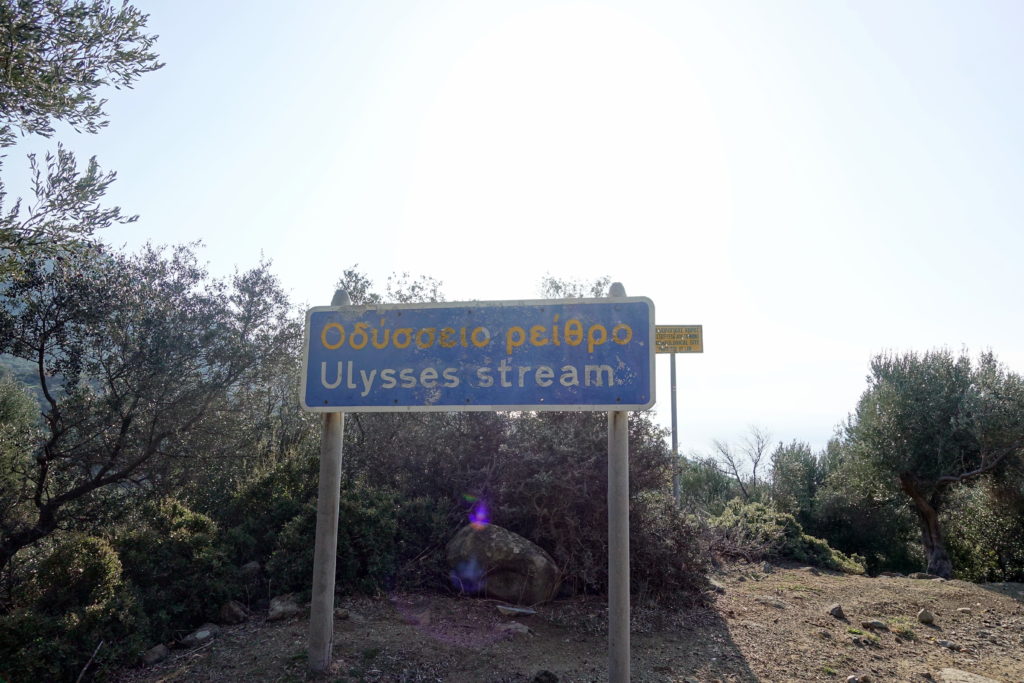
There was a sign, but this stream didn’t really exist – still a lot of mythical imagination all over Greece.
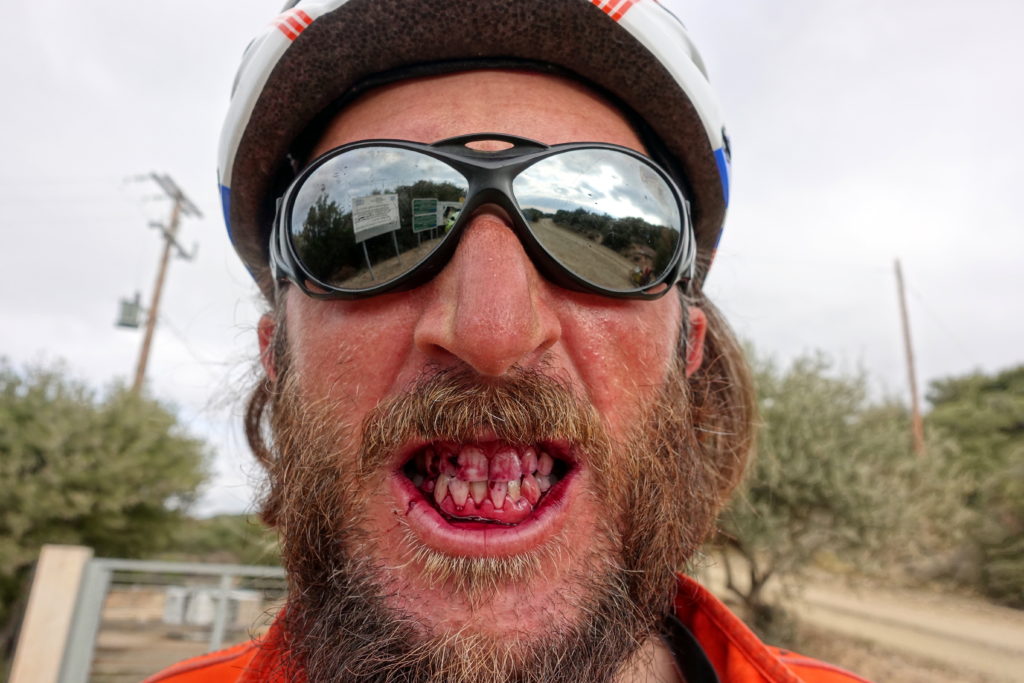
The olives are pretty juicy… yes, we discovered that Olives (although fresh ones taste horrible) can give a good cannibalistic serial-killer look.
After our night in Kremasti, surprised to wake up by the call for prayer of the local mosque (how we realized that this region is the only one in Greece with a recognized ethnic minority), Cédric and I loaded up the bike and started cycling towards Kavala. Unlike the day before, we spent most of the morning cycling along the road because the landscapes didn’t provide too many things to marvel at. It is still amazing that there is an archeological site every few kilometers in Greece, but apart for Hellenist experts, a lot of those places are not quite breathtaking (there aren’t many columns and statues!). We found the area near Kavala to be quite industrial and full of marble processors, so just cruised through. Around noon, we entered the city along the coast and cycled through the aqueduct to the downtown. We stopped for a hearty Greek lunch (moussaka) and frappé and then used all of those extra calories to cycle over the massive hill to get closer to the Greek/Bulgarian border. About an hour later, we stopped for a quick break in Krinides and tried to get peaks at the UNESCO Filippi Archaeological Site despite the closed gates. Our night ended in a small apartment tucked away on the hillside.
]]>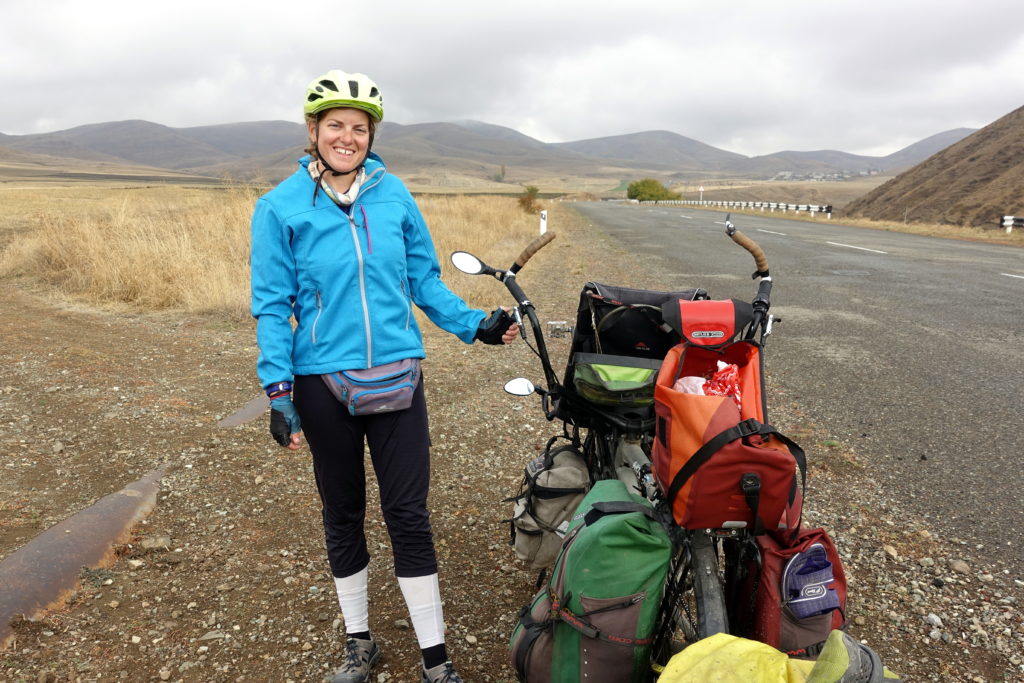
Getting from Armenia is not straight forward, it still reminded us that the country is mountainous everywhere. We had to start playing with multiple layers of clothing – strip down going uphill, swaddling going downhill.
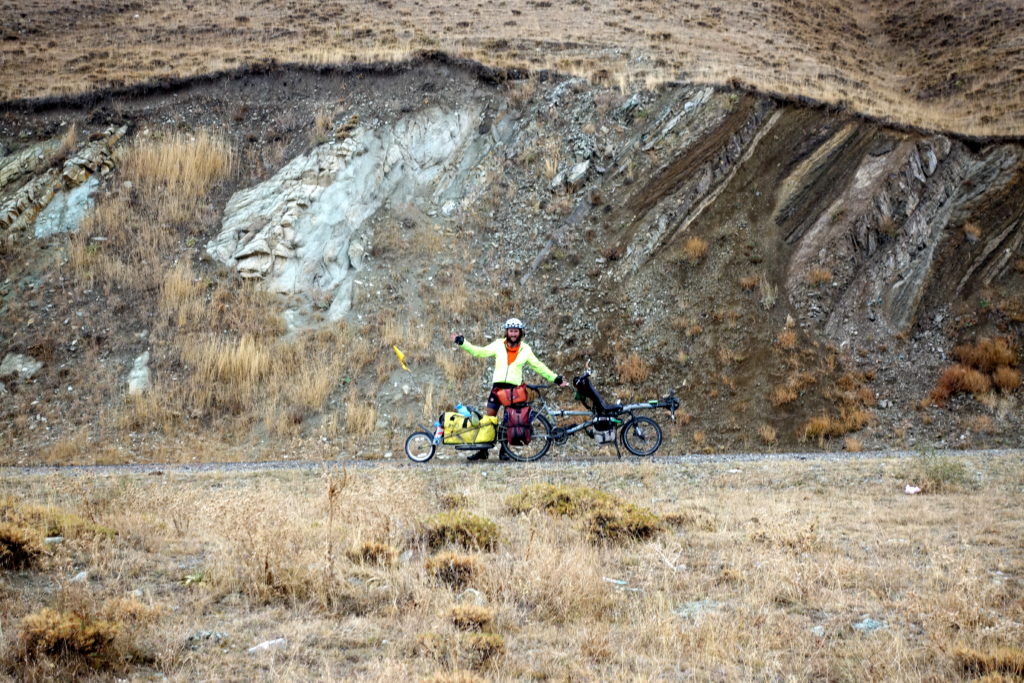
Up the last Armenian passes – and still enjoying the Armenian drivers before a short ride through the south-west of Georgia.
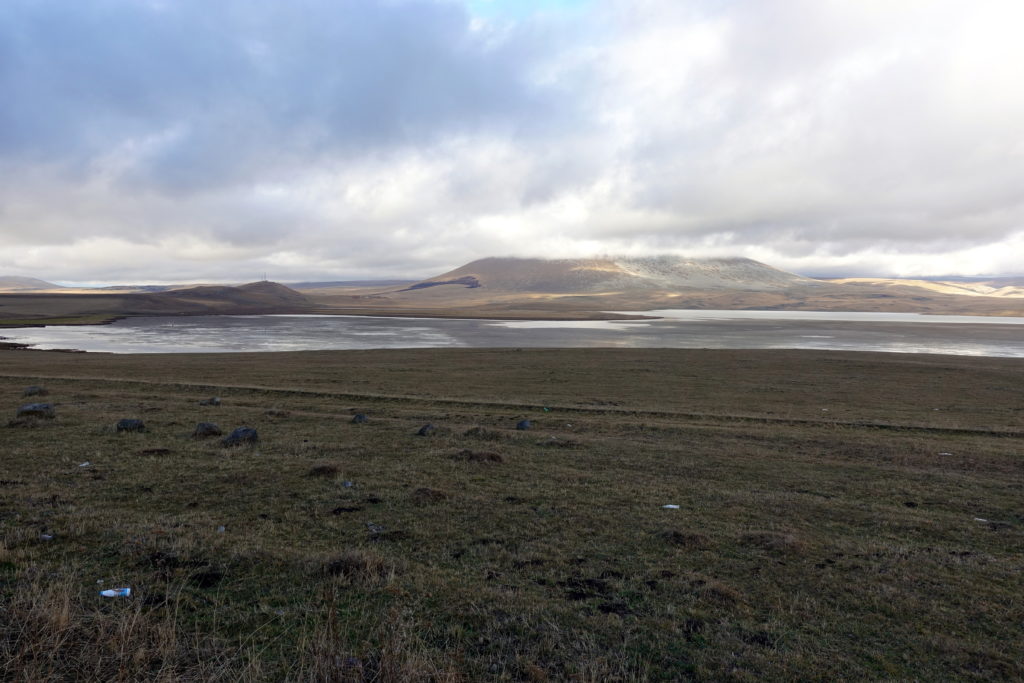
We mostly avoided getting heavy showers – no need of weather forecast, just looking at the clouds, the wind direction and adjusting the length and timing of our breaks.
We got the usual weird questions of the border officers: where do you come from? Cassie replying to one officer “Armenia!” while giving an US passport (we are in Armenia heading to Georgia at the border so obviously from Armenia, duh!), and Cedric told another officer “Kazakhstan” (well, that was where our last flight landed – duh again!) handing a German passport. Not sure what they are really asking at the borders with questions like that (and it has happened a few times) – but apparently no matter what you reply, they seem convinced with the answer (Western countries passports also probably help a lot!).
After the crossing, the roads took a turn for the worse and we had to cycle through thick, wet mud and potholed roads all the way to Ninotsminda, where we spent the night. It looked like the process of doing a new road was done over a decade, with years apart between the destruction of the previous road and the new pavement.
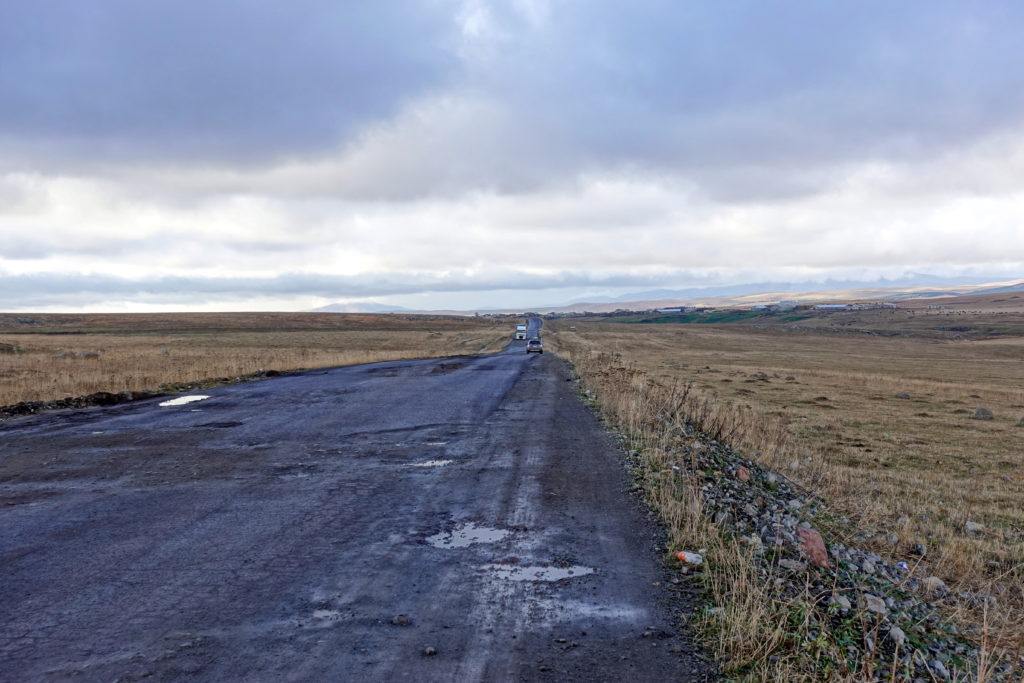
Surprise, surprise! The road turns into a 4WD track after the border…we were wondering why so few trucks were taking that road (it should be the shortest road joining Turkey to Armenia, but also western and norther Georgia to Armenia and Iran), we found the answer: a large detour is a lot faster than that path (Iranian trucks even completely go around Armenia through Turkey).
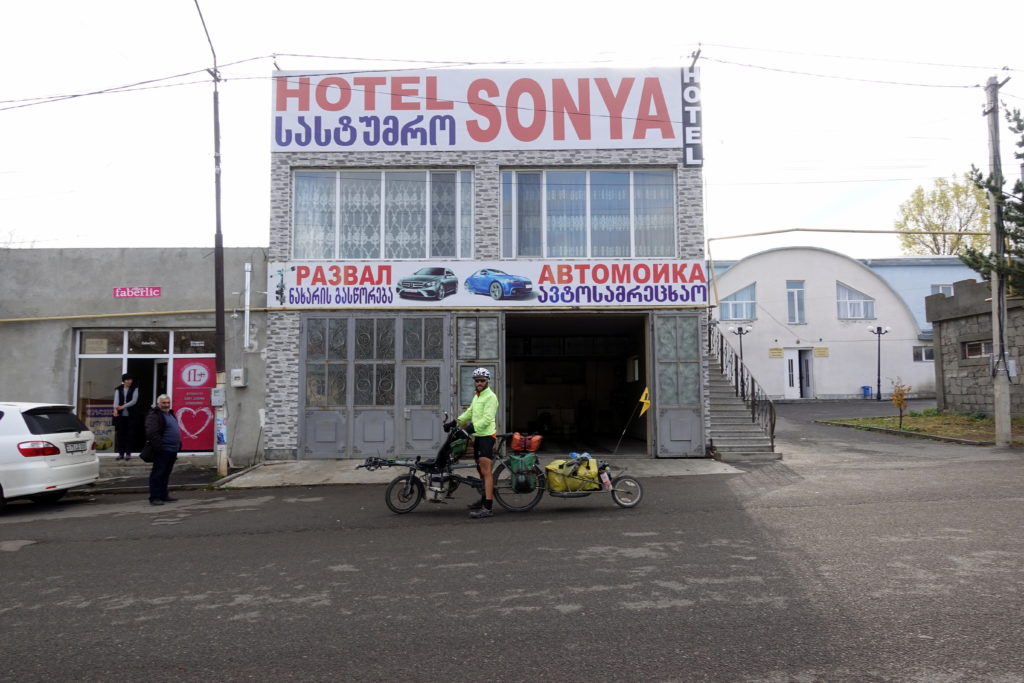
Our hotel, with the owner apparently managing everything around: the cosmetics shop on the left, the grocery store further left, the car mechanics underneath, and a restaurant on the right!
The next morning, Cédric and I packed our things in order to head towards the Georgia-Turkey border. The original plan was to camp somewhere close to the border, if not in Turkey that night. As we were leaving, Cédric and I had a debate about which road to take – my thought was to stay on the main road, despite the crazy Georgian drivers, and Cédric wanted to take a shortcut through some villages. I was a bit wary at first, considering that it had been raining and the Georgian roads from the day before had proven to be in rough shape, but I conceded after seeing a few cars driving down those roads. In the end, however, my first reservations turned out to be true. As we approached the second village, the roads went from manageable gravel to what I called ‘purely medieval.’ (A good reference for these roads would be from the Monty Python and the Holy Grail ‘Bring out your dead’ skit – Link). Within seconds on the path, our bike couldn’t move due to layers of thick, black mud between the wheels and the mud guards. With no other choice, we parked the bike and started poking out the dirt with our flag poles (the dirt was thick enough to break sticks). All too optimistic, we tried going on the path again and only made it for 100 meters before repeating the same process. And again, and again, and again through a village of 100 homes – which meant that people were watching us and dogs were barking all around, but no one came to help. Just a funny entertainment for the day – we had to cycle 60km in Georgia to get from Armenia to Turkey, and we were still not thrilled by Georgia. When we decided to head back to the main road, a guy called us and told us that he’d get us a taxi – but at the price he quoted, we decided that cycling was better, or at that fare accept only a helicopter-shuttle for a 10km leapfrog. By the time we made it to the main road, we had lost the entire morning and the clouds above started to swirl again. In order to improve our moods, we decided to cycle to one of the marked guesthouses in a village called Sulda, a lot before the original plan of reaching the Turkish border. We were hoping that it’s proximity to the main road meant paved village roads, but at this point, it was naïve to think that. We pushed the bike to a guesthouse and enjoyed an evening not toughing it out in the elements.
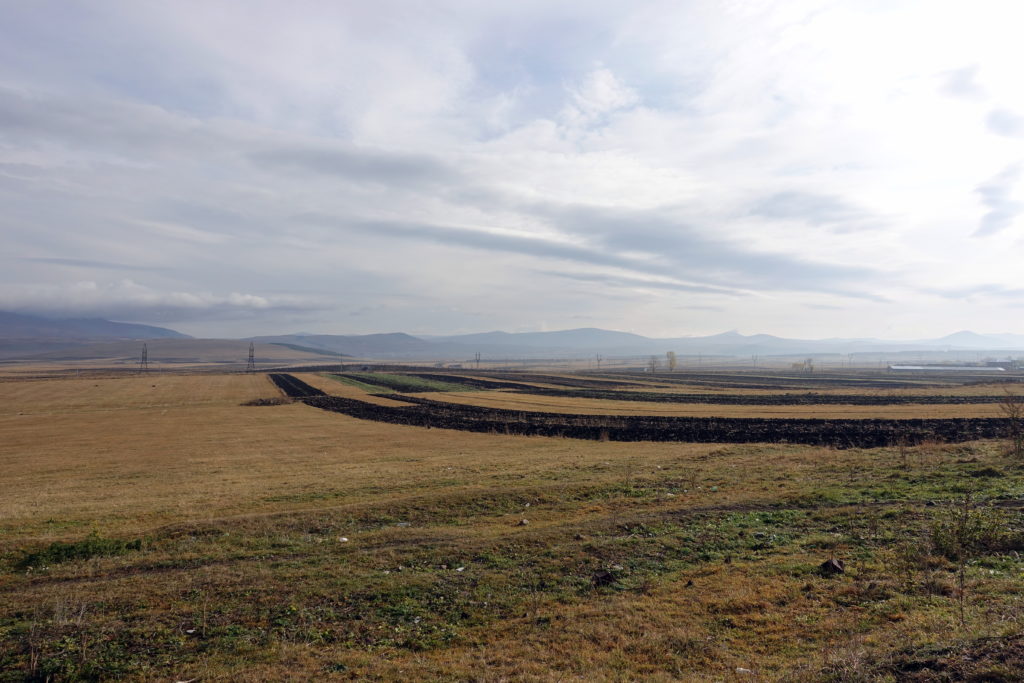
The last kilometers in Georgia shall have been easy and doable within a day – the shortcut did not work that well!
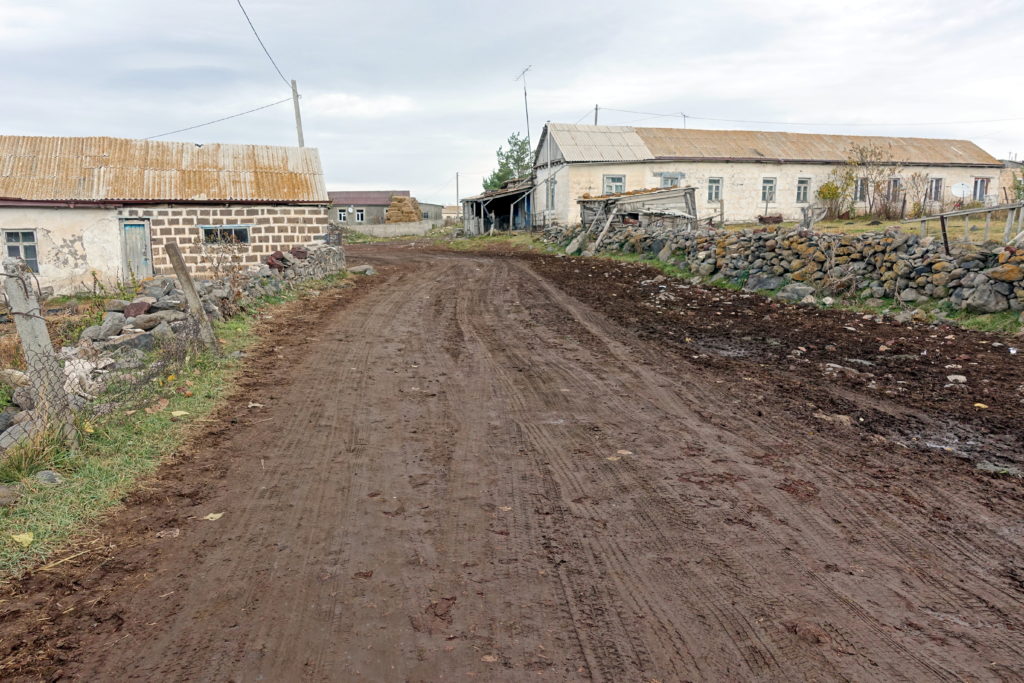
But to make things short, it make a nightmare! After three hours of struggle, we had gone back to the original intersection, the bike had dirt everywhere, and we had ruined our legs trying to pedal more than a few tens of meters between each clog.
A short video of the muddy mess:
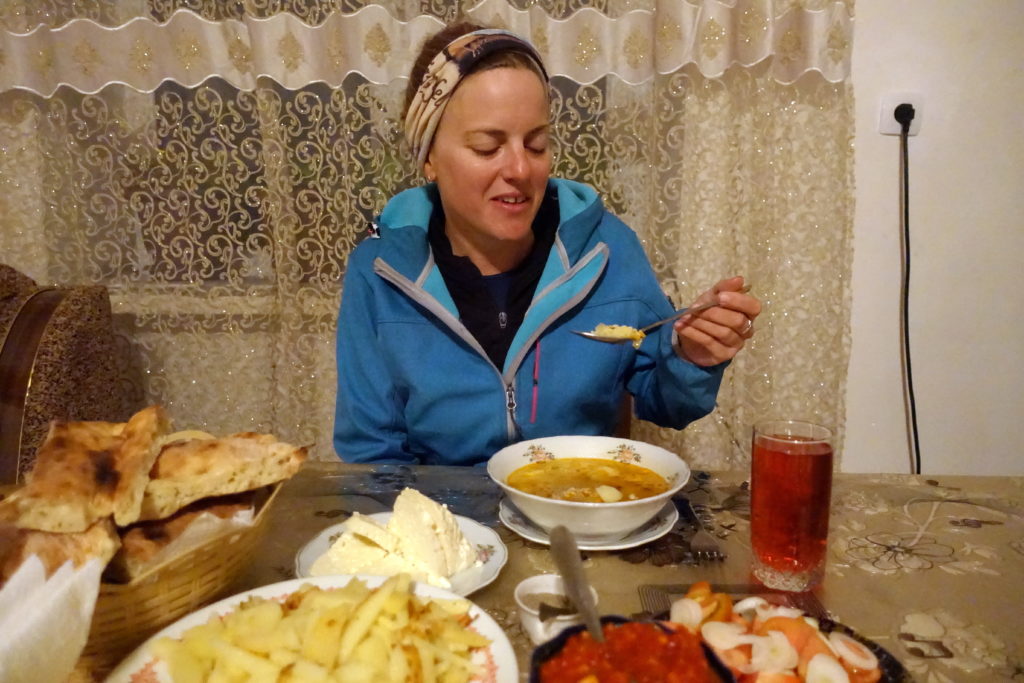
With the weather changing we are not hesitating much about overnight stays at cheap guesthouses – and if we can get something else than pastas, it is okay too!
The next morning, it was very difficult getting out of our warm bed and preparing for another cold and cloudy day with showers in forecast. We had a hearty Georgian breakfast, bade our host goodbye, and pushed our bike through the medieval dirt hopefully one last time. Once we got back to the main road, we pushed out the remaining dirt on our tires and set off towards the Turkish border. As we cycled through the last few villages, we couldn’t help but feel that these borderlands had been overlooked… the difference between here and Tbilisi, just 200 kilometers away – but centuries apart – was drastic, and it felt like being back into remote villages of Tajikistan. We reached the border in the late morning, turned in our passports for stamps (we got an officer testing our German skills – probably just to make sure that we had not stolen the passport – but not understanding our answer… I guess it probably sounded German enough to him), and then cycled off into Eastern Anatolia. The first thing we noticed was the new asphalt (with a shoulder, mindful drivers and even trucks using their blinkers!) and hopes that we would no longer have to deal with mud. We cycled up a large hill and came across two other cyclists who were speeding down. We quickly exchanged information about where we’ve been, where we’re going, the respective hazards of both countries we had just gone through, and where we stayed over the last few days before it became too cold and we said our goodbyes. They gave us a good tip on where we could stay that night (and price), because the weather was continually getting worse. The wind was starting to pick up and the showers were becoming more frequent, so we quickly stopped at a café for lunch in Çildir before cycling the last stretch to a resort on Lake Çildir. Cédric negotiated the prices and we settled into a bungalow for the night, once again glad that we wouldn’t have to worry about the tent crumpling due to the wind. Although the bungalow had three large room, we quickly re-tuned the interior design to condemn two rooms and transform the third into a studio with heater full-on and to not have to get-out of the room until the next day.
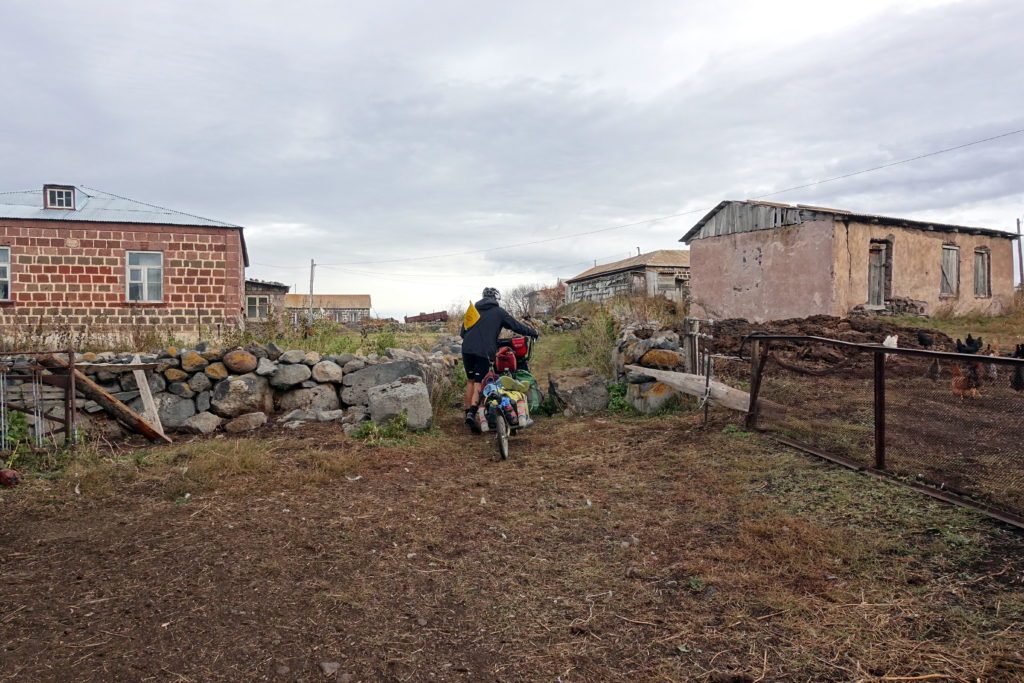
Not quite as shiny as Tbilisi! It seems that Georgia has forgotten to invest anything during the last past decades in that corner of the country (but the guesthouses had received some support from a German state agency).
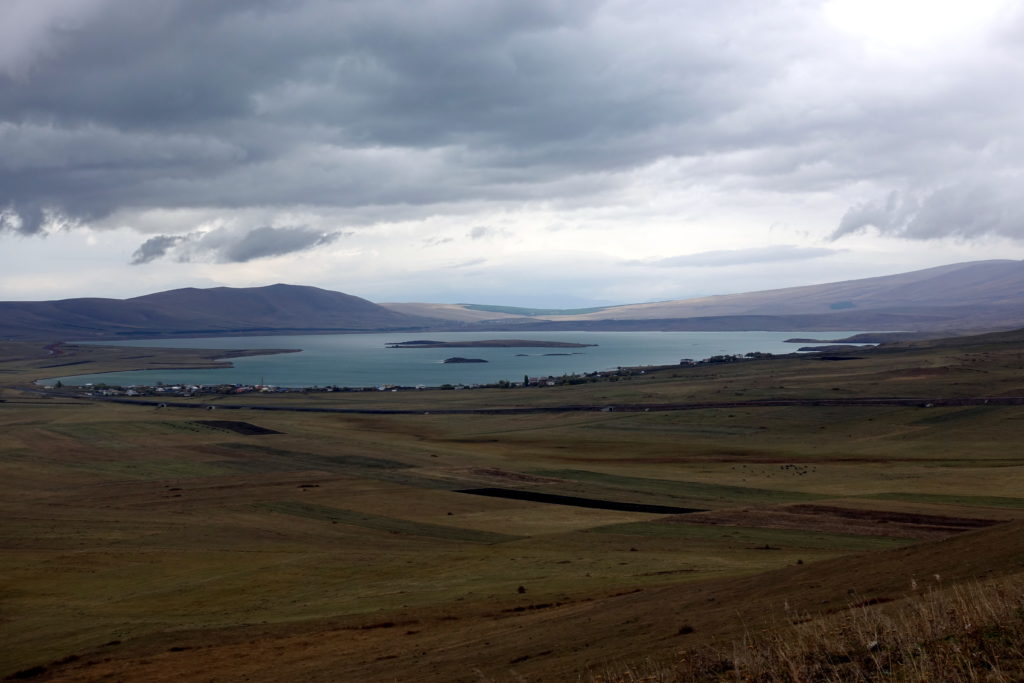
A last view towards Georgia, the lake being split between the two countries. That area was a lot more tense before the fall of the USSR – the idea was that whoever attacks first would probably go through those high but easy passes and turn the whole Caucasus into a battlefield
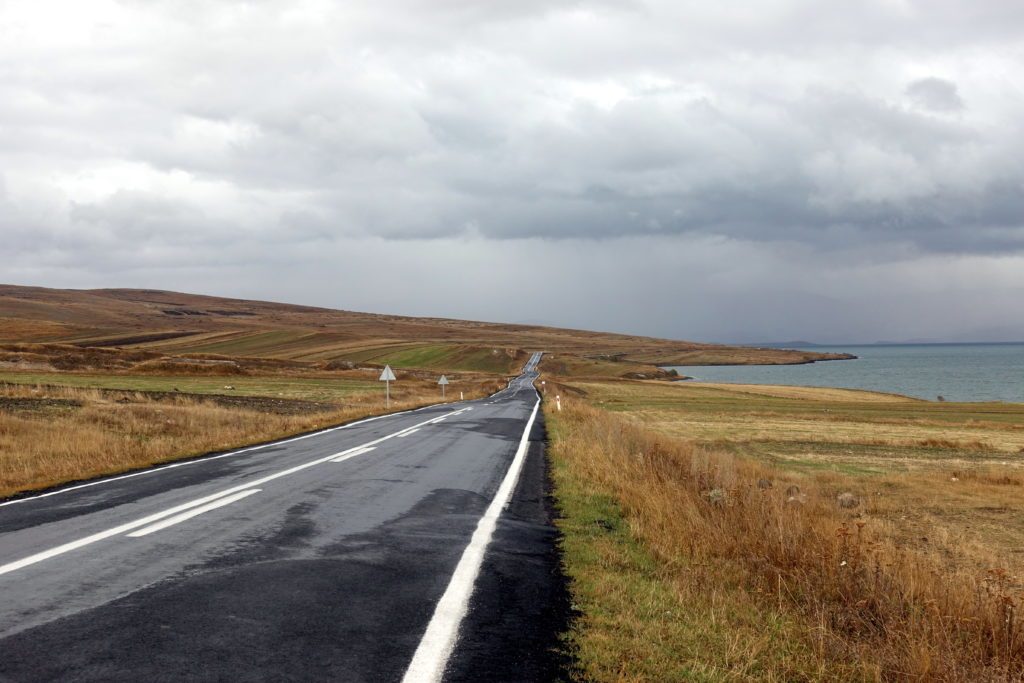
The first glimpses into Turkey: awesome roads, little traffic, gentle drivers, great views – just not the most promising weather.
We awoke the next morning, tired from a loud, windy night. It seemed like our bungalow was built only for good weather since wind was blowing through the cracks throughout the entire night and sometimes felt like it was going to collapse. When we awoke, we looked outside at the trees bending in the wind and wondered whether it was worth it to attempt cycling this day… since we had time before breakfast to figure it out, we flipped on the heater and watched the news on the TV. At breakfast in the resort’s restaurant, the wind continued to howl outside, and it was predicted to get even stronger to gale-forces by midday… so we decided to stay an extra day and use the time to catch up on blog posts. The next morning, we again woke up early and noticed that the wind had died down over night, but were surprised when we pulled back the curtains… snow! A few centimeters of it, too. The wind was still blowing, but not as strong, but now the roads were covered in snow. Again, we pondered over our predicament over breakfast and then decided to wait it out another day as we watched snowstorm after snowstorm pass.
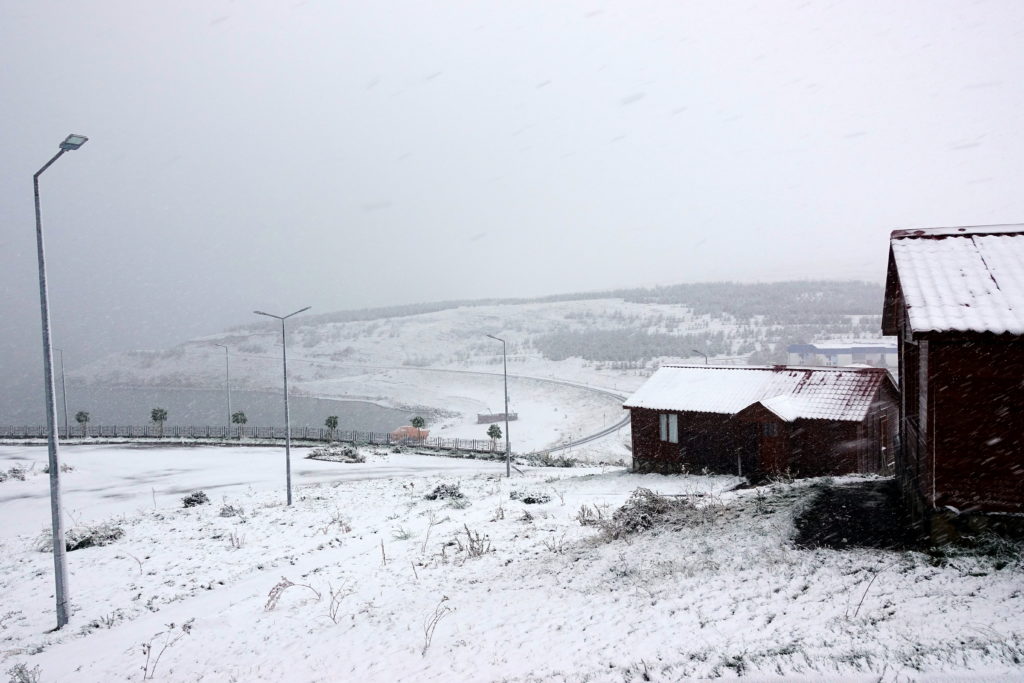
Surprise, surprise early in the morning on day two… the whole area (over 2000m) turned wintry overnight. Snow only would have been fine, but the flurries, the consecutive snow showers, the temperatures kept us stranded there.
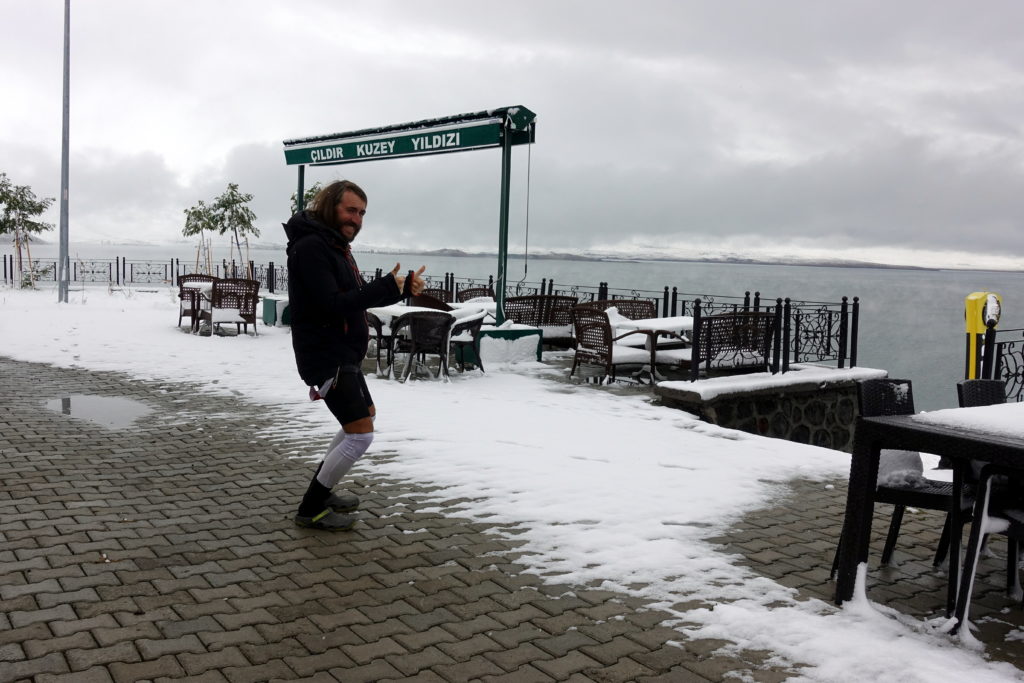
Cedric still had hopes in the morning that it would get better at some point and we could race into Kars – 80km away. The weather got better at some moments, for a few minutes only – still keeping cycling equipment on.
Finally, after three nights confined to the resort (and having exhausted all our food supplies), the weather became better and we could leave. In true Murphy’s law fashion, our bungalow didn’t have running water during our stay at the resort (a burst pipe or something, maybe laziness), so we were also without shower and a convenient bathroom. As we were leaving, however, the water magically started working again. We packed the bike, said farewell to the resort staff and cooks, and set out for Kars.
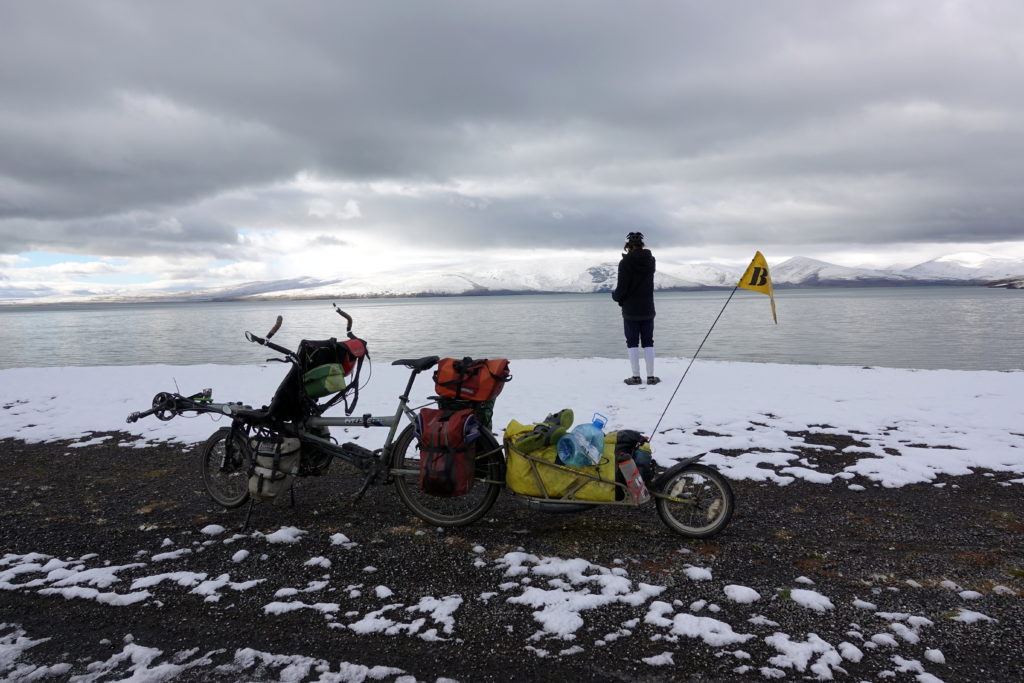
The landscape looking completely different after the two days. Yes, this is still Turkey and not Greenland.
The already-melting snowfall did wonders to the landscapes as we cycled around the rest of Lake Çildir- it added another dimension to the mountains that we had not yet seen while cycling. We enjoyed the journey down to Arpaçay for lunch and continued cycling over some hills until we reached Kars. The benefit of Turkish cities is that most people live in large apartment buildings, so reaching the center in towns of tens of thousands of people is quick and tolerable (as opposed to navigating thousands of streets and cars). All shops and restaurants are altogether within walking distance. Knowing that the overnight temperatures were dropping to below freezing, we found a hotel downtown for the evening. Turkish hotel owners have notably always been great at helping us manage our gears and store the bike for the night – no questions or reluctance, they always find a safe indoor spot for the bike (no way it stays in the street, but people don’t always understand that).
The next morning, we set off westward. Our trip in Turkey was only going to last until Erzurum and we still had a few hundred kilometers to get there. After cycling through a few streets, we reached the highway once again. Compared to nearly everywhere we had been cycling over the past few months, Turkey felt like a dream: the highways were empty, shoulders were wide, gentle drivers and everything was newly paved. This is what we wanted after countless roads covered in potholes, gravel, glass and constant honking. Looking at the snow-capped mountains in the distance also made the day even more enjoyable. We stopped in a town to eat our lunch, which ended up being bread and spreads on a curb because we weren’t interested in cycling into the center. In the afternoon, we followed a small road through a few villages to Sarikamis, which again had light traffic and unbelievably smooth pavement. Because the day was easy, we packed our things inside our hotel and walked around the ski town, eating at two restaurants because one meal wasn’t filling enough.
While the morning temperatures were still below freezing, Cédric and I packed our things and left. For us, it was slightly depressing to know that the temperatures for our last stretch of cycling wouldn’t improve (or at least get back to shorts and t-shirt weather). Just like the day before, it might have been a cold start, but there wasn’t a cloud in the sky. We warmed up by cycling up a small pass and through pine forests – although we needed to put our jacket and gloves back on for the descent. As the day progressed, we marveled at the landscapes we were able to see from the road: canyons, cliffs, fairy chimneys (and we weren’t even in Cappadocia!) and the remnants of the Zivin Fortress… all of this aided by the mountains in the background and lack of cars made for an awesome day of cycling. We ended our day just before it dipped below freezing in Horasan.
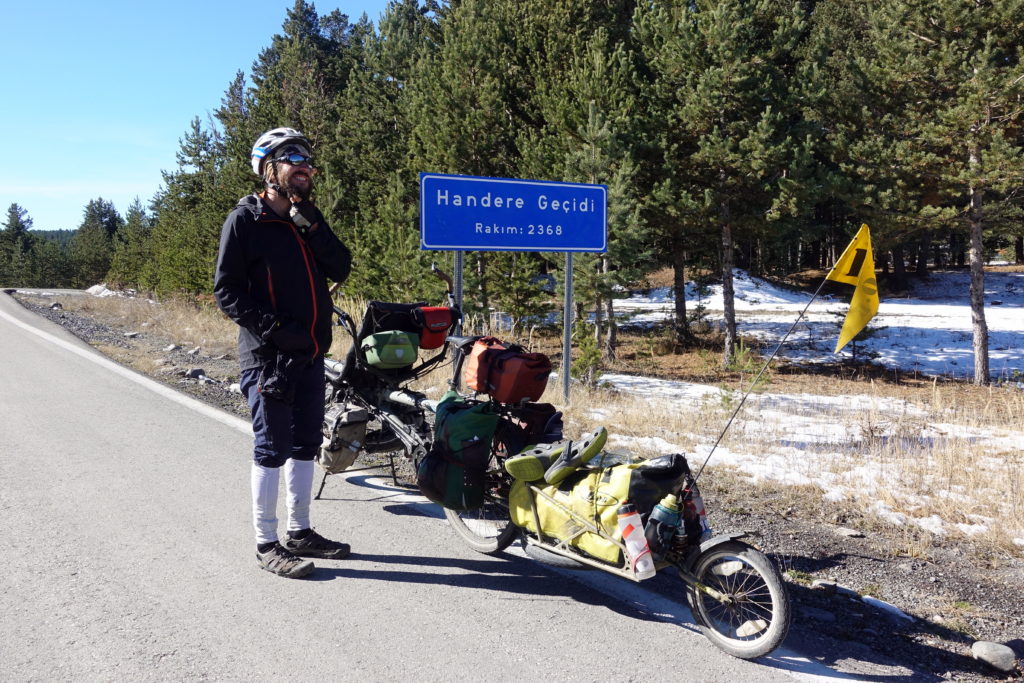
We’re hoping that this is the last official ‘mountain pass’ of our trip (anything under 2000m can be ignored – anything under 3000m is kinda easy stuff now!)
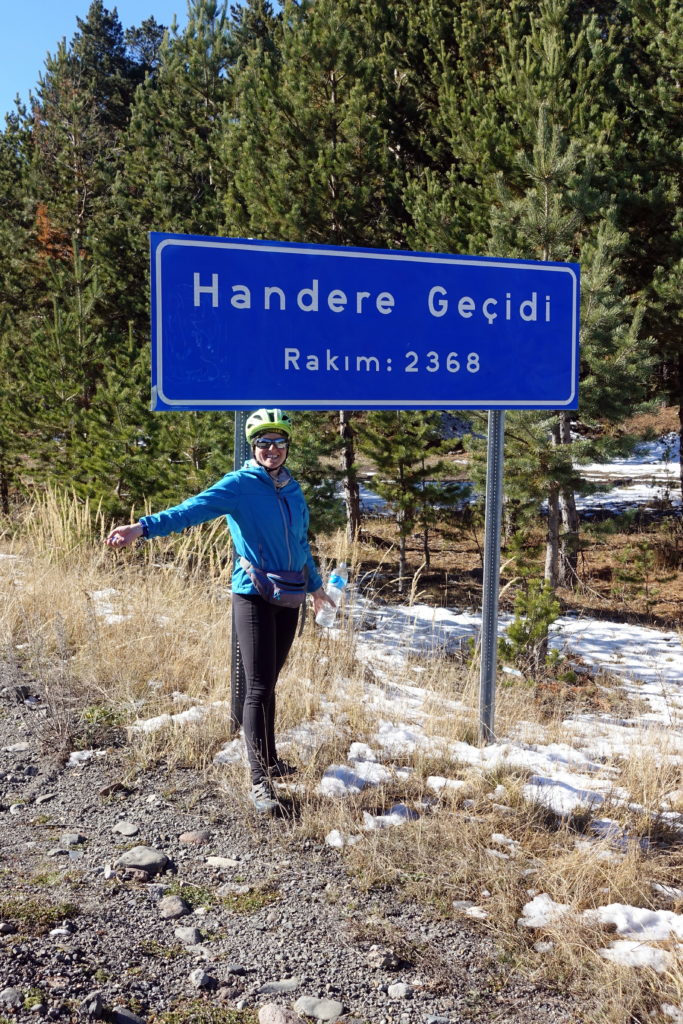
Ah, the altitude might be why it’s always freezing! After all the ascents we have done in the last months, that pass really felt like being one easy piece of cake.
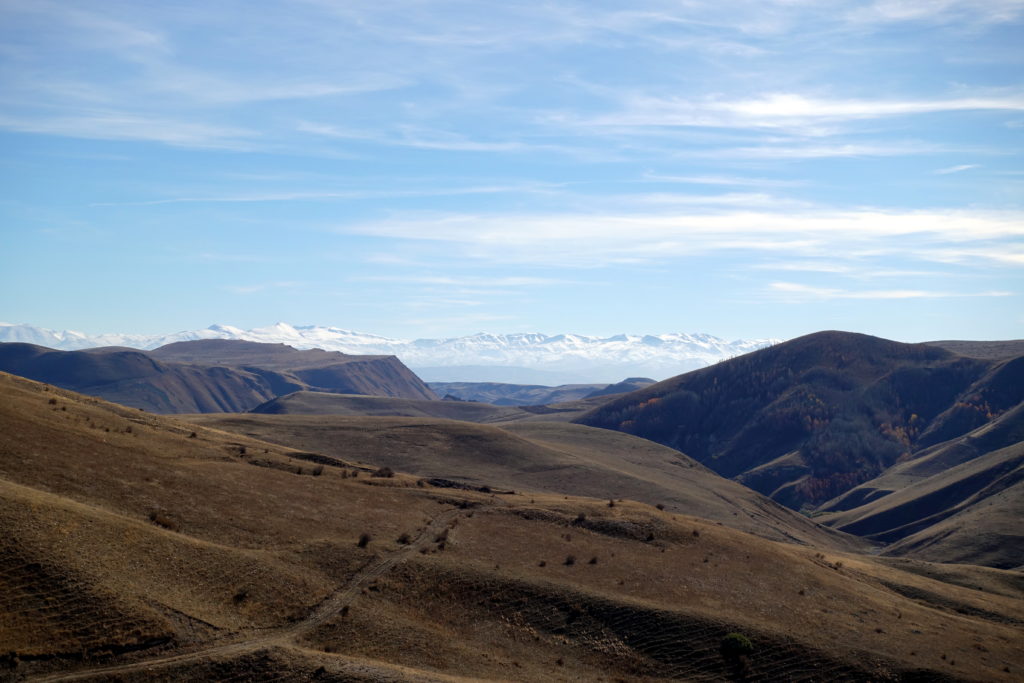
While we were taking these pictures, a guy asked to we needed a lift to Horasan and we told him absolutely not when we can look at this the whole time
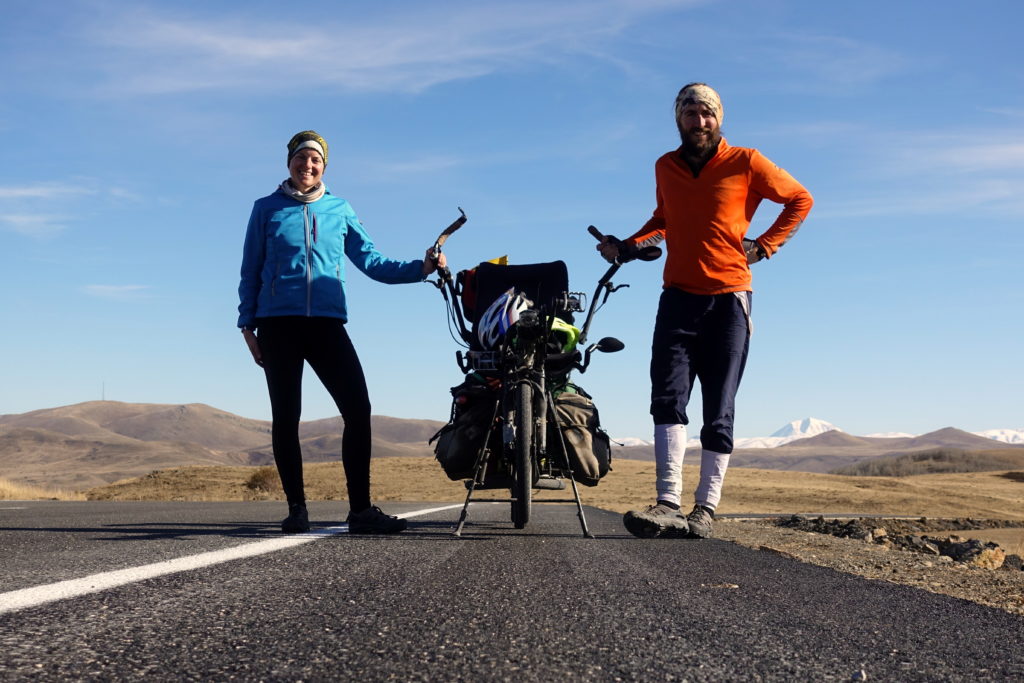
It was also a perfect day for taking selfies. Cedric did not carry winter clothes, so managed to ride by putting any kind of clothes available – including arm sleeves on the legs. He finally shopped for winter clothing in Istanbul (thanks Decathlon!).
For our last day of cycling, we had no other option besides cycling along the highway to get to Erzurum since it was the most direct route. The weather was still cloudless blue skies and the day was pretty enjoyable, despite the uptick in the number of semi-trucks cruising past. While cycling through a police checkpoint (they’re looking for guys avoiding the compulsory military service… and terrorists?), we were offered tea by one of the guards who could speak English. He told us that many cyclists go past in the warmer months, but it’s rare to see people so late in the season. We stopped to warm up over a lunch in Pasinler and then continued our journey. In the afternoon, shortly before Erzurum, we met Joscha, a German guy heading towards Singapore and exchanged a few stories on the side of the highway. The ride into Erzurum was effortless and we quickly found a place to stay in the downtown. The hotel was also helpful in finding a bus company that would take us into Istanbul.
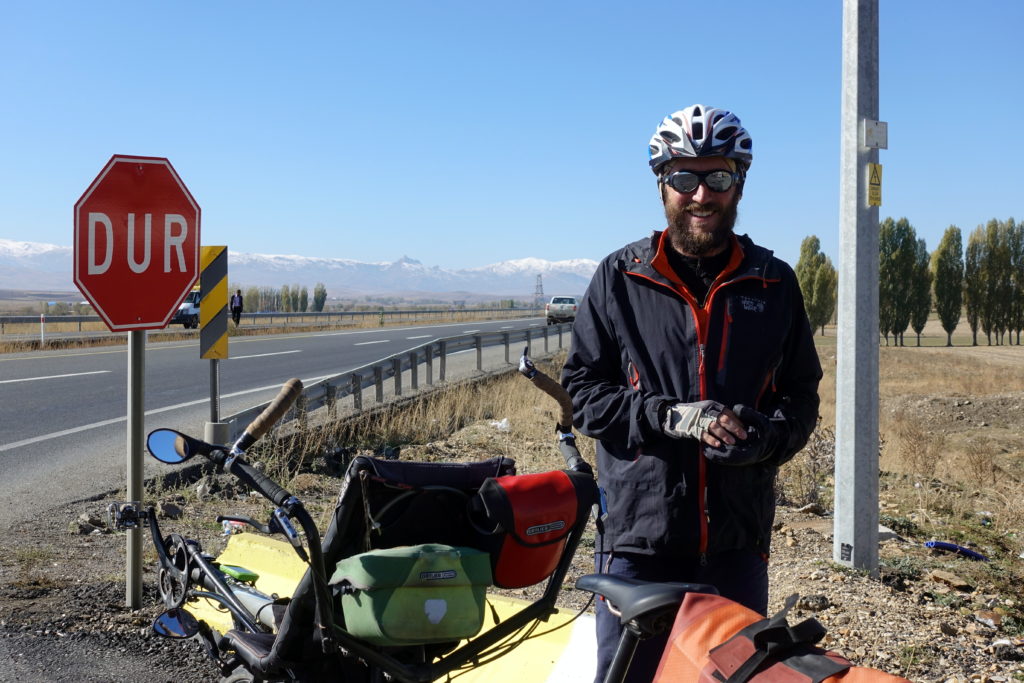
Happy after being offered a cup of tea (we weren’t allowed to take a picture of the checkpoint). Oui, traverser l’Asie est dur!
The next day, with a bit of extra time do to an afternoon departure for Istanbul, we wandered around the city and saw some of the historical sites. It appeared as though Erzurum was also planning to be a hit tourist destination in the near future, so the castle was under renovation (or possibly reconstruction). We were also being pulled into a carpet shop and spoke a bit of German with the friendly owner as he told us a bit about the handmade carpets and his life. If we weren’t cycling, I’m very sure that we would have walked away with something. In the afternoon, we loaded our bike and made our way to the bus depot, hoping that our luggage wouldn’t freak out the bus driver. When we loaded our stuff, the drivers and assistants rammed our bike into other luggage, which broke our headlight, but still demanded that we pay additional money for the luggage. I tried my best to negotiate the price (mostly by screaming “problem!” and pointing to the headlamp), but we didn’t walk away with a discount. The 20-hour ride to Istanbul was cramped and uncomfortable; we were able to sleep a few hours during the night, but many old guys talked on their phones and the frequent rest stops didn’t allow us to have uninterrupted sleep. The bus driver, probably doing the trip several times a week, managed to even miss Istanbul (15M people) and realize that half way to Bulgaria: 2 more hours in the bus! He was focusing a little too much on his cigarette and buddies on the phone… We rolled into Istanbul the next day in the late morning and quickly packed the bike and rode to the nearest hotel that would take us. Competition between hotels is fierce in Istanbul, and by being in the business area on a week-end, thus slightly outside of the touristic downtown we got to settle in a 4* hotel for a bargain price.
]]>Those three countries have been strangled throughout history between their influential larger neighbors or simply part of larger empires: Russia in the North, Persia/Iran in the south and the Ottoman/Turks in the West have all shaped the culture and traditions. Reading a little more in detail the history of those countries, it is interesting to note that although all claiming millennia-old history and ancient roots, the three countries got defined as of today only with nationalism in the 20th century.
We thus found interesting that although the three countries have had multiple wars and have tense borders, they felt somehow quite similar: food, people, towns, etc. Many parts of Georgia/Armenia/Azerbaijan were previously inhabited by some people from other ethnicities – notably Baku being mostly Armenian and Yerevan being mostly Azeri.
We got particularly amazed that those tensions are still so strong and deep – Armenia still struggles with Turkey as nationalists regularly claim half of eastern Anatolia, Azerbaijan and Armenia have basically no clear border, just some barbwire, snipers and fields of landmines spread randomly (it felt, looking at the geography…) over hundreds of kilometers.
Azerbaijan, although a Shia country, is closely allied with Turkey and surprisingly with Israel (yet not sharing a border with them). Armenia has close ties with Russia and Greece, although again not sharing any borders with those two countries; it is also astonishingly closer to Iran than Azerbaijan. Georgia after having tried to defeat the Russian army (and unsurprisingly failed within a few days) is doing everything imaginable to get as close as possible to the EU and the US: NATO advertisement campaigns, EU flags on every public building (even the border crossing), etc.; again, Georgia does not share any border with the EU and the US. In short, those countries have populations who lived together for centuries, but managed to make things ugly and at the end, we felt that the loser of the story was Armenia – landlocked, and not benefiting from foreign resources like the two other countries: Georgia through EU aid and Azerbaijan through apparently unlimited oil reserves.
So once again, if you haven’t read the previous posts about the three countries, check those out first. If Yerevan sounds for you like the capital of Yemen and Baku the nickname of your local confectioner, take a map first!
- Azerbaijan: we had not read or knew much about Azerbaijan before getting there, except its history linked with oil in the 20th We got surprised to see a variety of landscapes, from desertic areas on the coast, to humid mountainous forests up north.
- We liked:
- The trees: after being in tree-less climates for the past few months, it was nice to find good shaded spots. Trees also meant that we could possibly have a more stealth camping spot (although we were always found by a shepherd).
- The informal tea houses. Ok, according to the Lonely Planet guide, Cassie wasn’t supposed to hang out there, because it’s understood as a male-only space (where men can feel comfortable in the presence of other men – as opposed to markets, bakeries, every restaurant… etc.). In our short bit through Azerbaijan, we found them a nice place to have our lunch and warm up.
- The mud volcanoes – although not a large area, this is a seriously weird landscape.
- Finally getting a variety of fresh fruits and vegetables. Okay, the lower valleys of Tajikistan were also enjoyable for that (especially as everyone was offering us their garden produces!)
- Baku (downtown) is surprisingly clean and well-maintained, people in Baku feel open and liberal.
- We disliked:
- Cars – Particularly in Baku. There were just so many parked and taking up space on the street, honking, speeding down the blocks, and generally making the city a bit unbearable. This trait isn’t just Baku alone, almost any sizeable town or city (everywhere we’ve been) is cramped with cars – and while on the bike, we’ve been pondering ways that could make things more bearable. Cédric has been thinking of a device that would blow-off the driver seat and make the car useless if it goes less than 10 kilometers in distance – but yes, most of the drives are clearly a few kilometers, if only a few hundred meters, and almost certainly slower than just walking.
- Shashlik – or any type of barbecued meat. Ever since the Caucasus, Cassie’s been trying to avoid the dish – threatening to go vegan when the trip is done. Shashlik and Kebabs are found virtually in every post-Soviet country (and now shish-kebabs in Turkey…), but when every restaurant only serves meat with lots of inedible gristle… it starts to get to you.
- Men (outside of downtown Baku!) – Azerbaijan was the most machismo and misogynist country we have crossed. There are just no women in the country, and idle dudes are not particularly interesting, not very friendly, and really invasive.
- Trash – Azerbaijan is certainly the dirtiest country we went through this year. There are trashes thrown everywhere! Nothing stinky, but plastic was found in all fields (even far from the main axis, roads, villages are covered with plastic.
- We liked:
- Georgia: one of the first (oldest) Christian countries, we were happy to get into a different culture (not that we particularly intended to go to mass, don’t worry!), known for its cuisine and apparently also its wine.
- We liked:
- Cute churches – Georgia is one of the oldest Christian country in the world, and unlike in Europe where churches have been rebuilt and enlarged multiple times, Georgian churches have not changed much since they were built (sometimes in the 5th century). Churches are often on top of hills (together with small monasteries) and not necessarily in the center of the villages which make them very picturesque.
- The food: food is seriously awesome in Georgia – seriously! Great variety, some elaborate dishes, and getting dinner in guesthouses is just awesome: you get more dishes than you can imagine, whenever you think it is finished, something else comes – meat, fish, vegetables, nuts, fruits, salads, desserts, etc.! The dream

- Guesthouses: there are lots of guesthouses everywhere in the country for a very reasonable price. Hotels are not that great (and expensive), but all people we have met in guesthouses were really friendly (it probably also helped that we were in the low-season and went to remote towns who rarely have any guests – or went into guesthouses owned by Iranians).
- Some scenic rides, with autumn season colors and massive mountains at the border with Russia (well, sort of – Russia found that its country was a bit too small and invaded two Georgian regions 10 years ago)
- Georgia was the first country where we first saw books and newspapers in houses since Malaysia (honestly) – we got really surprised to find shelves of encyclopedias, dictionaries, and novels in the various guesthouses. This is also true for Armenia. Similarly, Georgia was the first country in months where using a VPN was no longer necessary to get around internet censorship (also valid for Armenia).
- We disliked:
- The traffic: Georgians are the most insane drivers we have seen in any country (and not just this year). The driving is simply as fast as you can, the turns in the mountains with the hand brake, some drifts on the road, driving on the left side of the road, full-throttle all the time. And obviously almost no law enforcement. Really scary! We did not stay long in the country mostly for that reason – steering the bike means a continuous focus on any car instead of enjoying the landscape, and the safest roads felt like the busiest ones (it’s harder to drive on the left side when there are traffic jams on both sides of the road…).
- Aggressiveness – for whatever reason, Georgians are a little rough and nervous. They want to get to the fist immediately for some complete non-sense (we had a guy who wanted to show his strength because I warned him that he was backing-up his Mercedes into our pedals – he would have probably preferred a long scratch on his car… but again, it helps to be a head taller than Georgians (and looking a little rugged with chaotic beard and questionably clean clothes! The consumption of wine does not seem to help much… You combine the aggressiveness with their driving style and you get people yelling and honking at disabled or older people while they cross the street on the crosswalks a few meters away. It is ranging from boorishness, crudeness, intolerance, or just stupidity.
- The wine (sorry, because it seems like the national pride!) – okay, we are not experts in wine, and the wine in Georgia is better than Kyrgyz wine (a mix of grape-juice and vodka!) but compared with its supposed reputation…well it tastes better after multiple glasses (guesthouses are happily continuously refilling your glass, and you cannot drink water with dinner)!
- We liked:
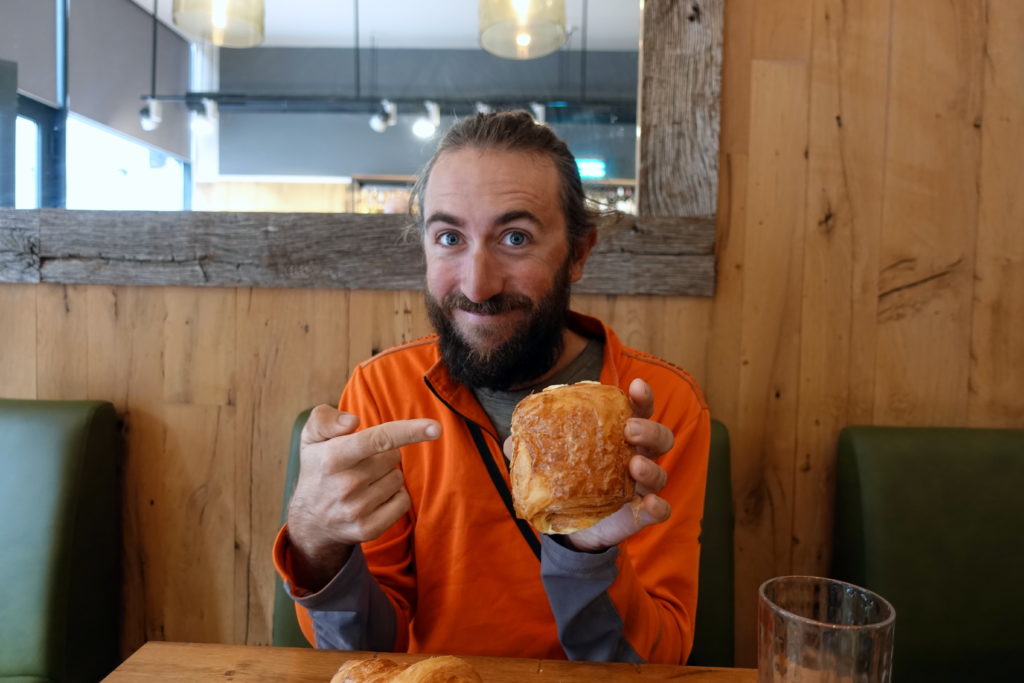
This is a look of pure joy – one day after saying he desperately wanted a chocolatine, Cédric’s wish came true!
We came back the next day for breakfast too! Btw, they taste exactly like the French ones…
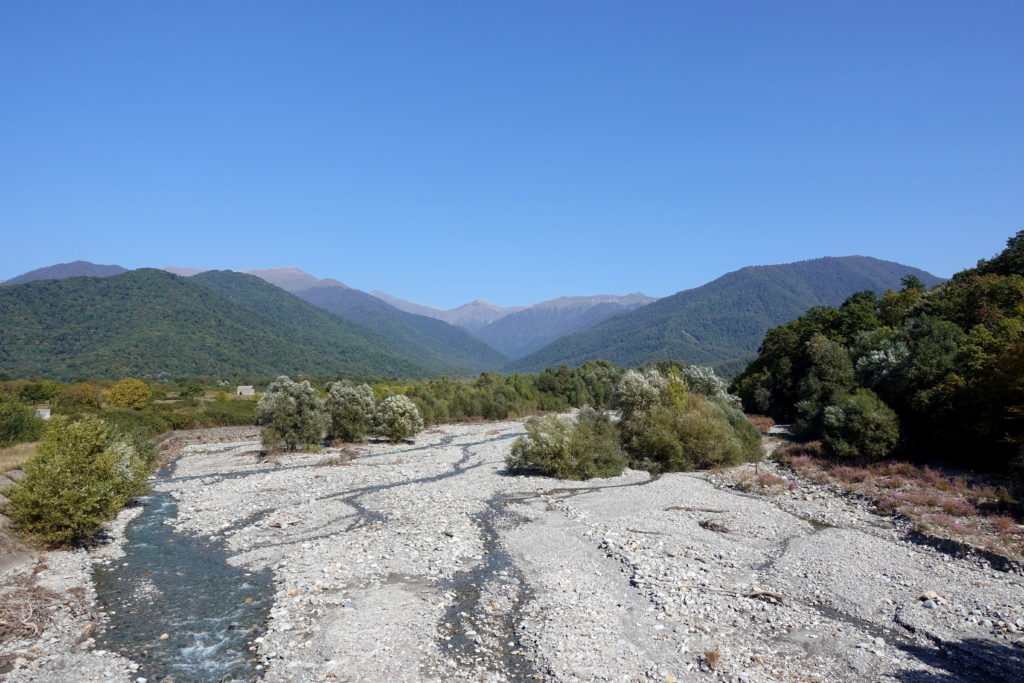
The main range of the Caucasus, between Georgia and Russia. This range actually beats the Alps in height (the Elbrus at 5640m would make the Mt Blanc look like a dwarf).
- Armenia: An even older Christian country – supposedly the oldest – although just like Georgia, the borders of Armenia have significantly moved over time. Armenians are also Christian Orthodox, but not the same Orthodox as the Georgians: Armenian are somehow more “ancient orthodox” – closer to Ethiopians and Copts – whereas Georgians are more “Byzantine orthodox” – closer to Russia and Greece. We tried to figure out the difference, I doubt many people understand it: something about miaphysitism versus monophysitism, good luck explaining that to us! Armenia was one of the most industrial country of the USSR but managed to get into nasty relations with its two largest neighbors, got itself stuck and mostly ignored as just small land in the Caucasus.
- We liked:
- Compared with Georgia, it was surprising to be in a much more chilled atmosphere right after the border. Car drivers are a lot more relaxed, not much honking, no aggressivity. A big relief!
- A very mountainous landscape. It does not go up as high as Georgia, but valleys are also narrower and more remote, implying a lot more up and downs for us cycling. While we mostly followed larger valleys in Georgia, we went from one to another in Armenia. Thus, more variety of landscapes and changes of views during the day.
- More historical towns – Armenia felt like the country of the Caucasus with more traditional villages, most historical relevance, some ancient castles (really old, not the plaster Potemkin castle decors of Azerbaijan, and overall a very old presence of humans in the area. Forget about the history of Yerevan though.
- Carrefour! (a large French supermarket chain) – we got to pile up lots of food in our bags and significantly improved our breakfasts and lunches (including pâté, chocolatines, etc.)
- We disliked:
- A lot of industrial wasteland – remains of the USSR, particularly around Yerevan. The 50km around Yerevan offer a weird sight of huge abandoned factories, and if still functioning, in a state of disrepair. The nuclear plant (near the Turkish border – they don’t like each other) is notoriously unsafe and there are warnings on traveler advise websites to regularly make sure that nothing goes wrong there (!).
- The brandy (locally renamed Armenian-Cognac) – like the Georgian wine, a national pride, but urgh bah (we’re also not liquor drinkers, beer please)! We bought the smallest possible bottle (at Carrefour!) and had to buy an additional 2l of Fanta quickly after to drink it. It tastes okay while mixed 10:1.
- The tensions with Azerbaijan – we admit that we had not paid much attention of the local geopolitical situation. Well, this is very tense there! Some regular fights, snipers regularly having fun, landmines on the ceasefire line, and just hate towards Azeris (Azeris hate Armenians just as much). After some reading, and because the locals seemed to exaggerate a little, it seems that the responsibilities are far from being one-sided – also similar to the situation between Georgia and Russia. If you stick to the paved roads, it remains safe though – but it might have been wiser to monitor the situation beforehand.
- Somehow Armenia feels like there is a problem of dysfunctional state and some crookedness going on in the country. Some areas are in a complete state of disrepair with villages falling apart, no schools (children just playing in the streets during week days) and any remain of industry abandoned, while some people (even in some towns) show an exuberant wealth. We have never seen that many Bentley and Rolls-Royce cars as in Armenia – several every day – it felt like people either have rusty wheels or cars that most people are unlikely to ever afford with an average salary in the country of 400$/month. While the country struggles to produce energy with aging plants, the clergy apparently finds enough funds to build spanking new outrageous churches…
- We liked:
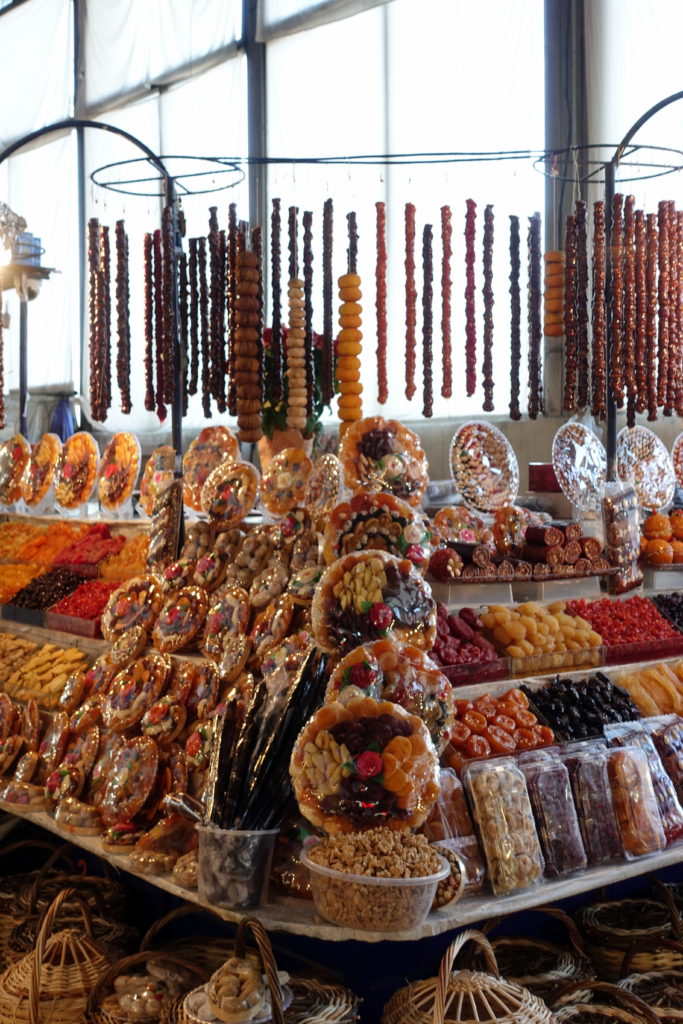
Dried fruit, nuts, and strings of churchkehla (nuts on a string, dipped in caramelized jelly) are very common in the Caucasus
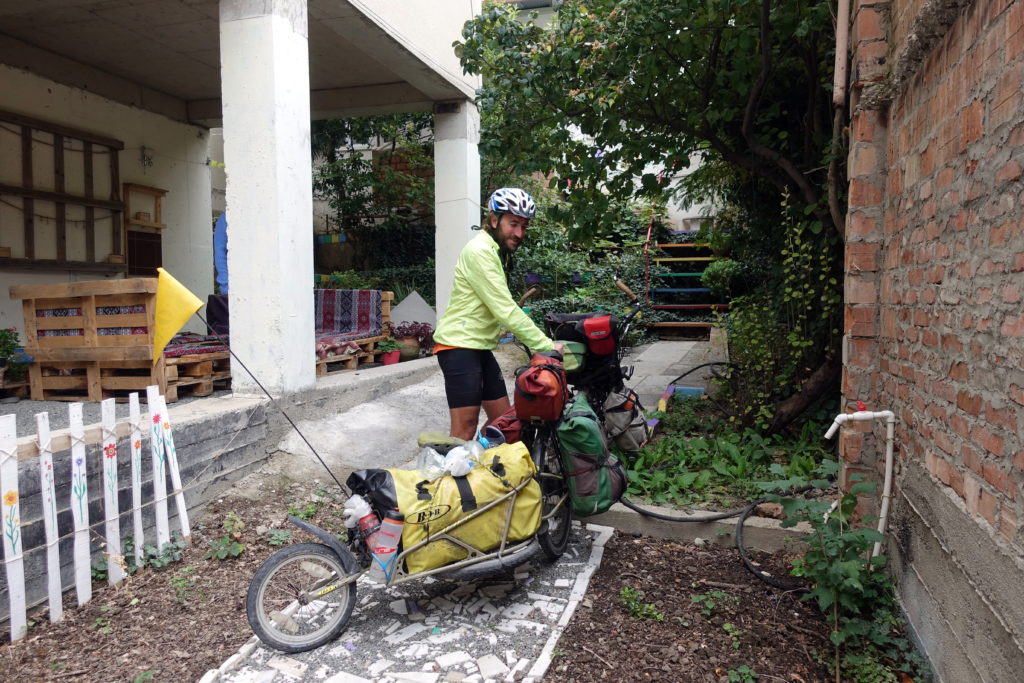
Our selection of accommodation is often constrained by our rig, here in the pleasant Tea-house/Guest-house where we spent 3 nights in Tbilisi.
Instead of following the main highway the entire time, we decided to find a not-so-shortcut unpaved road through a few fields and villages. This had us go on a few rough tracks and through the eerie town on the shores of Lake Kumisi – we weren’t quite sure what purpose the mostly abandoned buildings served, possibly vacation homes we figured, but definitely not the greatest image of Georgia. Just as we were reaching the main road, Cédric and I had a few bike malfunctions which caused us to stop and tinker with the chain for a good half hour. In the afternoon, Cédric and I managed to catch up with the cycle tourists once again (three Russians on a two-week trip from Baku to Yerevan) and proceeded towards the Armenian border. Along the way, we found produce and laundry detergent stalls lining the road and selling their wares to travelers looking for a better deal. We were starting to wonder how Armenia was going to be, especially if they had to get to Georgia to find detergent and other basic products – yet another desperate country like in the Pamirs? The traffic was dense over the last tens of kilometers before the border, but there are not so many roads between the two countries to choose from, and taking the shortest road to the border from Tbilisi would bring us to much quieter roads on the Armenian side – either you get the traffic from Tbilisi, or the traffic to Yerevan… We crossed the border together towards late afternoon and sorted our needs for the new country (SIM card, cash, and food). First impression after a few kilometers only, Armenia felt a lot more chilled than Georgia! Towards nightfall, we found a camping spot overlooking the Debed River and the mountains on the Georgian side.
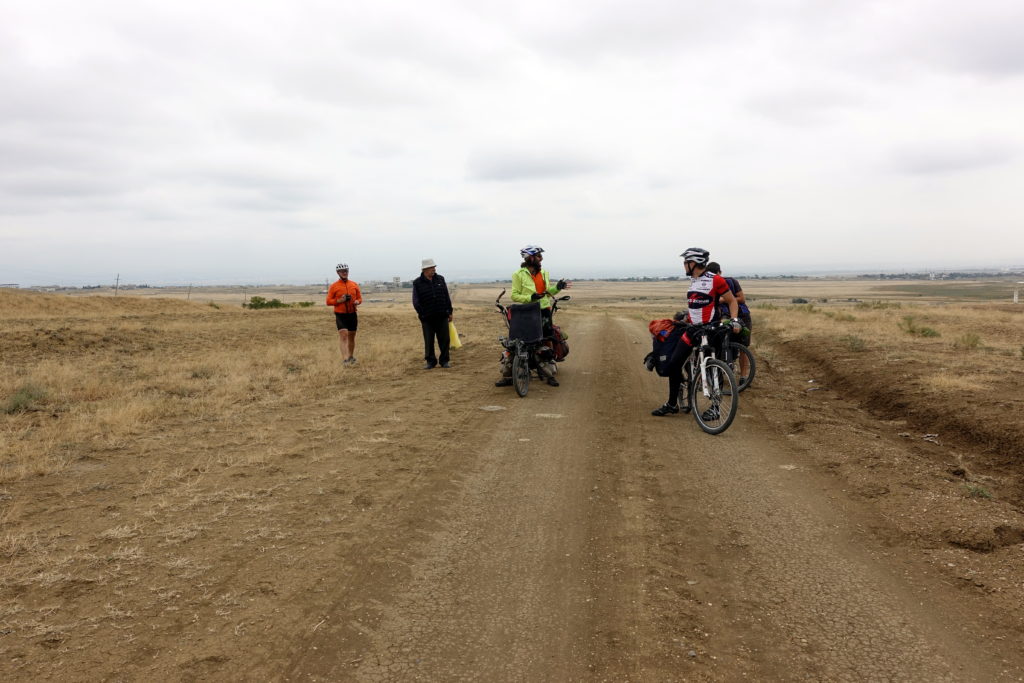
The Russian cyclists have the advantage to speak Russian to locals to get information about the way… although in that case our method of using maps would have been more reliable
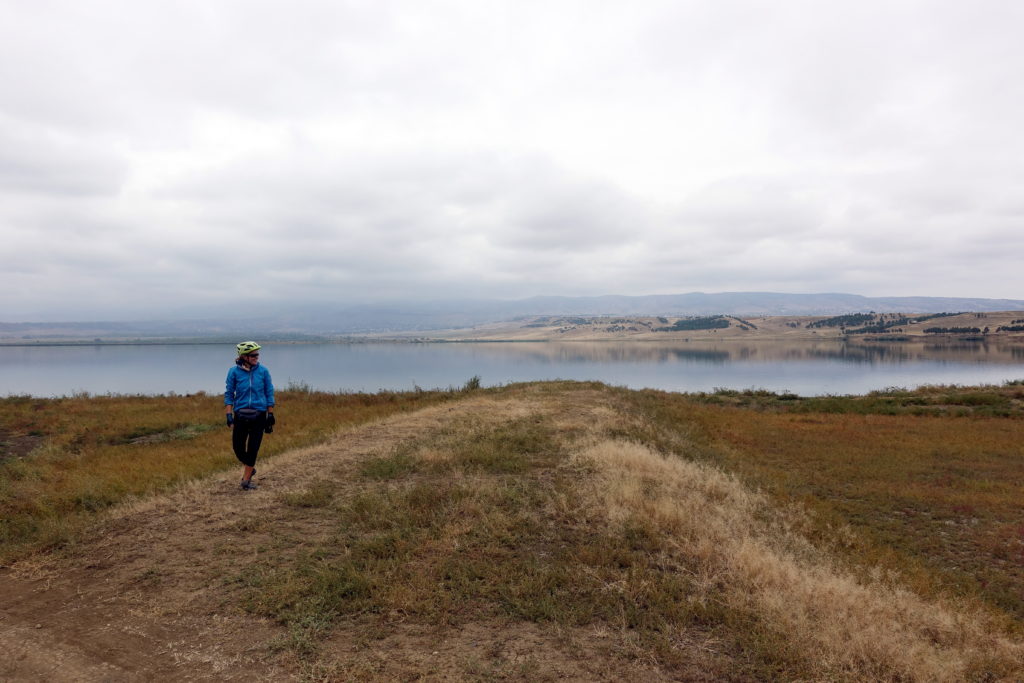
A lake right outside of Tbilisi. It looked like it was a getaway park a few decades ago, but feels quite desolate today.
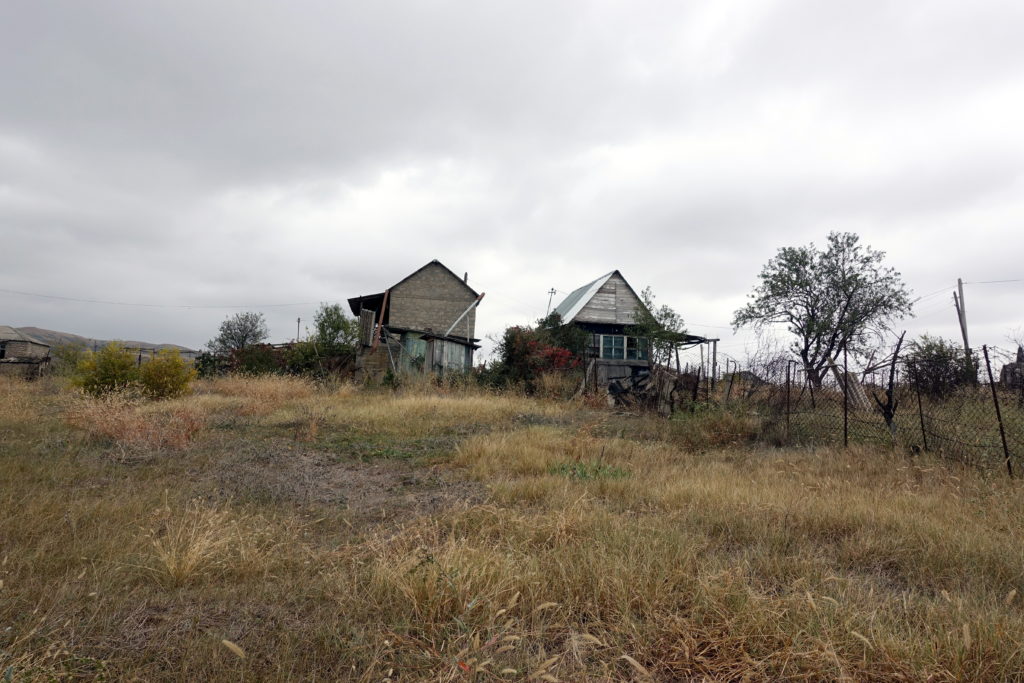
Yep, desolate! Those houses were spread around the lake, probably some weekend houses… some are unbelievably still inhabited. The area felt very much like a ghost town, although being just in the outskirts of (shiny) Tbilisi.
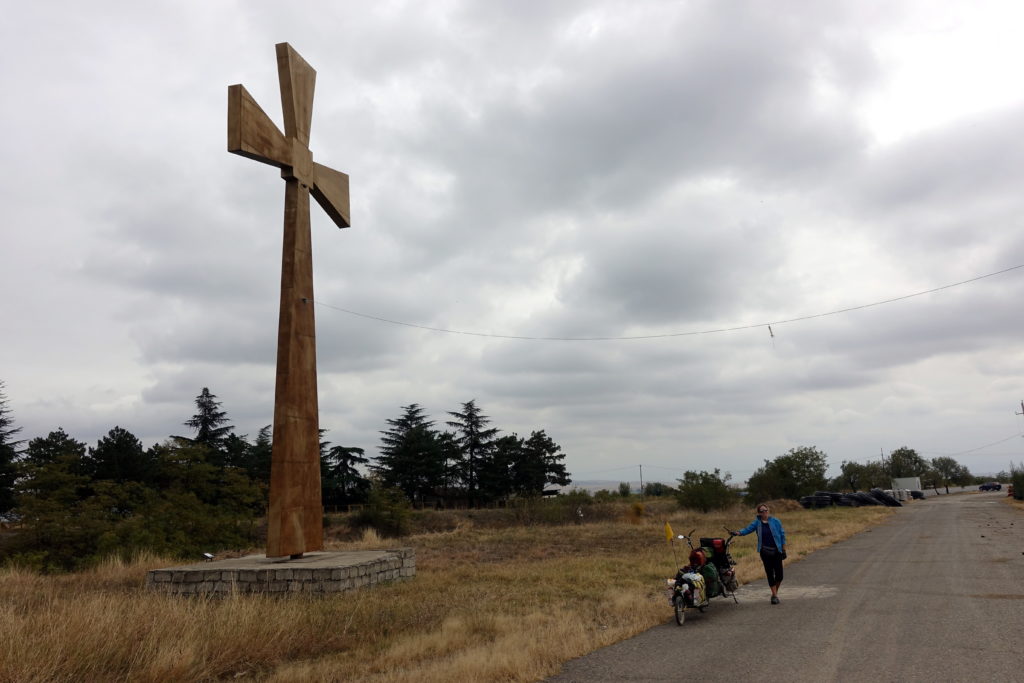
On the side of the road. Yes, Georgians are very religious. That cross base however served us as a picnic spot.
The next morning, Cédric and I set out early, positive that our lightweight companions would catch up to us at some point during the day. For the morning ride, we had nothing but a steady uphill climb to manage. We passed through villages where locals were butchering livestock and tending to their crops in the fields. What we could notice almost immediately after crossing the border is that Armenia also felt more industrial than the other post-Soviet countries we cycled through (save Kazakhstan). Some of the smaller villages had functioning factories (albeit very small in scale) in addition to the local market, car mechanic, and café. As we were continuing our ride up the mountain side, we stopped near a roadside fountain (which are plentiful in Armenia, a dream for cyclists) to enjoy our lunch in the sun.
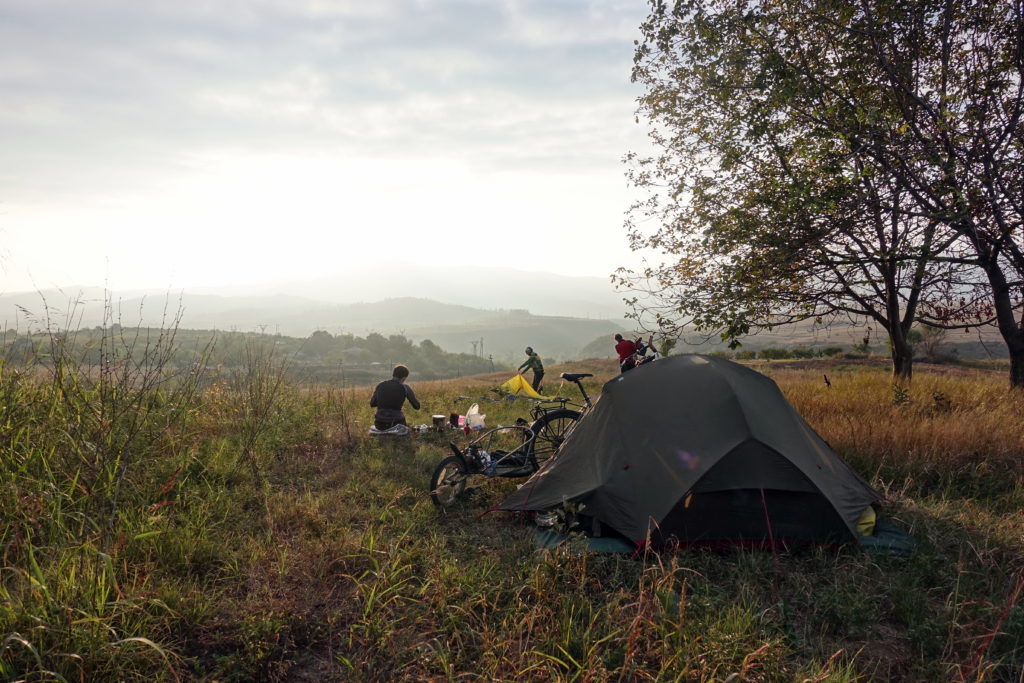
Taking down our camp in the morning. You can see different camping methods in place – we prefer to first eat breakfast in the tent, others eat after their tents are packed
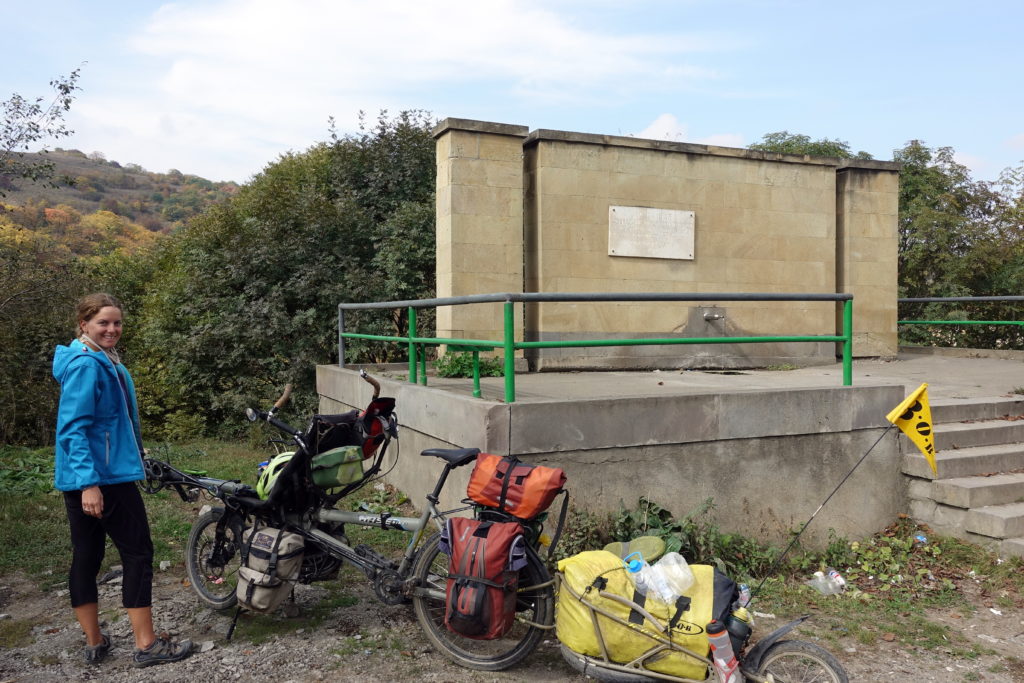
Picnic spot. Armenia has a lot of public fountains everywhere, perfect for getting water for cyclists
In the afternoon, we continued along the road that bordered perhaps a bit too close to Azerbaijan. The Armenians and Azeris are still in active conflict over some border territories – if anyone looks closely at a map, they’ll notice that there are still some enclaves of Azerbaijan in Armenia and visa versa. The most notable is the Nagorno-Karabakh region, which technically belongs to Azeri territory, but is controlled by the Republic of Artsakh (an unrecognized state, the Caucasus has a few of these…) and the Armenian military. In short, the borders are not super clear, and basically depending on who and when you ask. Needless to say, tensions are high along some borders and the Armenian and Azeri forces are very present, facing each other at bullet-distance (+1 meter). Some villages found themselves in the crosshairs after the dissolution of the Soviet Union, when borders were being defined, and are now decaying shells of buildings. Despite the fighting, one remarkable structure that’s still standing is the 7th century Holy Mother of God Church just inches away from the border. As we approached, two Armenian military guys came down from their lookout to show us the inside of the church – things appeared to be relaxed that day because they were both wearing flip-flops instead of combat boots. (Also, for anyone reading this and worried about our safety – the current contested territories are far away from this area, but it is still better to remain on the asphalt in this area – both countries have had the genius idea to plant landmines instead of potatoes there). The conflict between the two countries is pretty much unheard and unknown outside of the region, and we have to admit that we got surprised on site by the current situation – the good news is that this road is very pleasant and quiet (probably because apparently recommended to avoid, but given its length it would be easy to quickly get away from the area!).
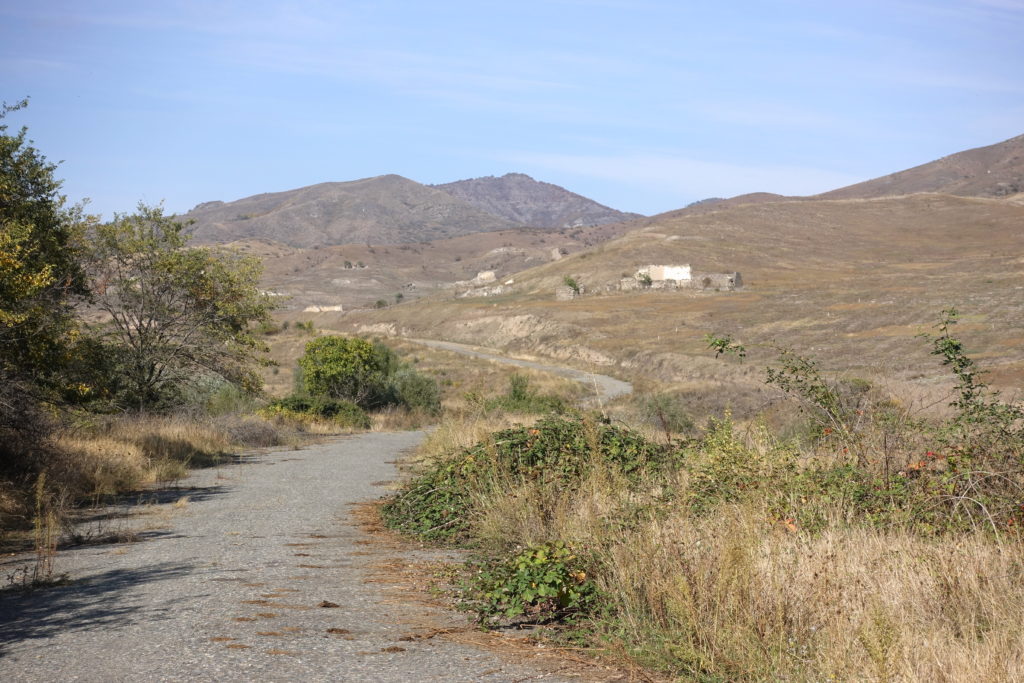
A look at the once border town between Armenia and Azerbaijan. This road was supposed to not be the safest as being way too close to the border (a few meters away). At the same time, because there wasn’t a single car taking it, it felt to us to actually be the safest ride in all of the Caucasus.
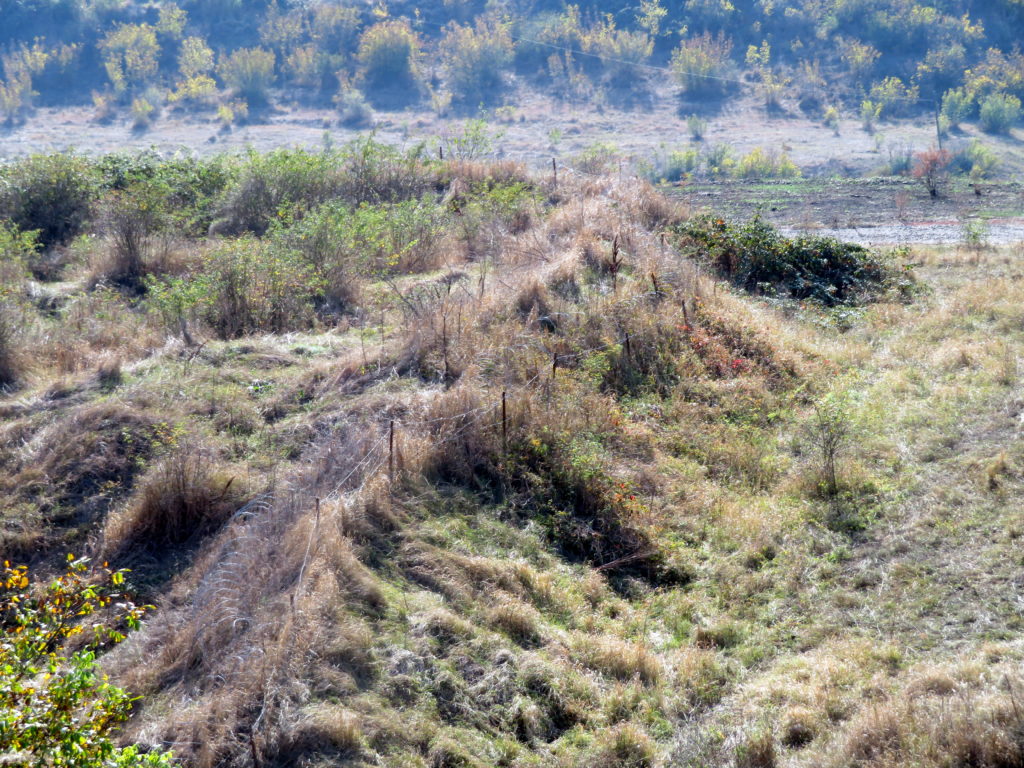
There’s the border (at least according to some sources, there are multiple lines of border between Azerbaijan and Armenia). No walls, infrared cameras, etc to keep people out, just tales of snipers nearby (and a deep-seated hatred for one another), some landmines spread-out around, and two armies ready for a firework.
After we visited the church, we wanted to make sure we camped a good distance away from the border (again, some unverified rumors of snipers), so we had to cycle up over a large hill that sat squarely between the two countries. We found a good camping spot in a field in the evening and were joined by our Russian friends around sunset.
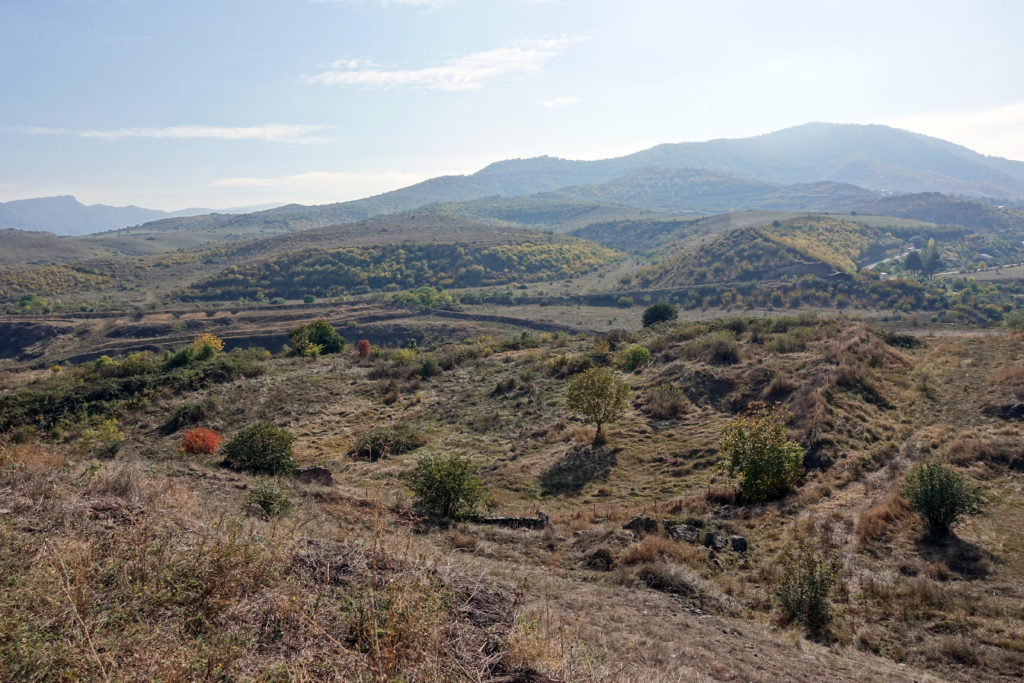
Views into Azerbaijan from Armenia, although the hills in the back are also Armenia… Basically, the bottom of the valleys are Azerbaijan and the hills are Armenia – the other way around elsewhere – with multiple enclaves on both sides. Or how to make borders even stupider than stupid.
The next day, we continued our journey south and down the valley towards Ijevan. The trees in the mountains were an explosion of autumnal colors and paired beautifully with the brisk October day. In Ijevan, Cédric and I stopped for mid-morning pastries (we mistakenly went to the factory instead of the shop, so got a much larger bag of pastries for a much better deal!) and slowly cycled through the city, looking at some abandoned buildings in contrast to newer ones. We continued following the road towards Dilijan, where we ended our day with a nice Armenian dinner at our guesthouse (we also tried some homemade wine, as requested, but it tasted more like vodka-infused grape juice).
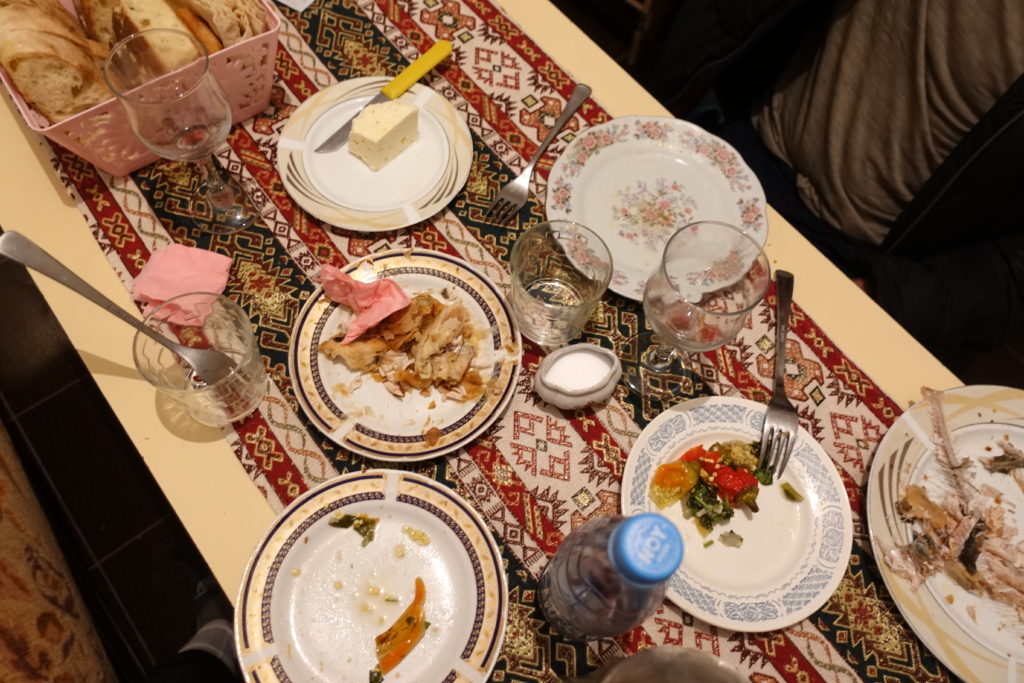
The remnants of our guesthouse meal: fish baked in lavash and chicken harissa. Lavash is a type of bread in the Caucasus, also used to bake some food in it. We had a few deliriums of Trouts and La-Vache (especially Margherite) on our way around Armenia. Not sure all readers would understand/smile though… but we have to entertain ourselves!
We woke up the next day to cold, cloudy skies and were preparing for a chance of showers as we left. With the temperatures and weather changing so rapidly in the mountains, we didn’t know what to expect in the upcoming hours. When we left Dilijan, we needed to cycle up one more long pass before our descent into Yerevan. About an hour into the climb, the clouds broke, and the sun started to shine and warm us up. As we were taking a picture-and-snack break, the Russian cyclists caught up to us and we continued cycling up over the hill together. At the top, we all stopped to take in the now clear, warm day overlooking Lake Sevan. Cédric and I then cycled down to the lake and had lunch at a restaurant overlooking the water. For the rest of the afternoon, Cédric and I slowly made our way down the road and through a few villages, stopping constantly for either pictures or snacks. We found an excellent place to camp on the hillside across the road from a chapel that also served as a place to knock back a few drinks with your friends. As we were cooking dinner, some guys who spotted our tent (and possibly more friendly due to some clear liquids) came over to see what we were doing. One guy told Cédric watch out for the wolves and that we could sleep at his place instead, although we weren’t interested in the prospect of packing up our things in the dark of the night and probably drinking a dozen shots at his house. The chance of getting eaten by a wolf in your tent are about as likely as getting a space-shuttle landing next to you, but here also the darkness of the night, being outside of your comfort-zone and some myths of larger animals are worrying people.
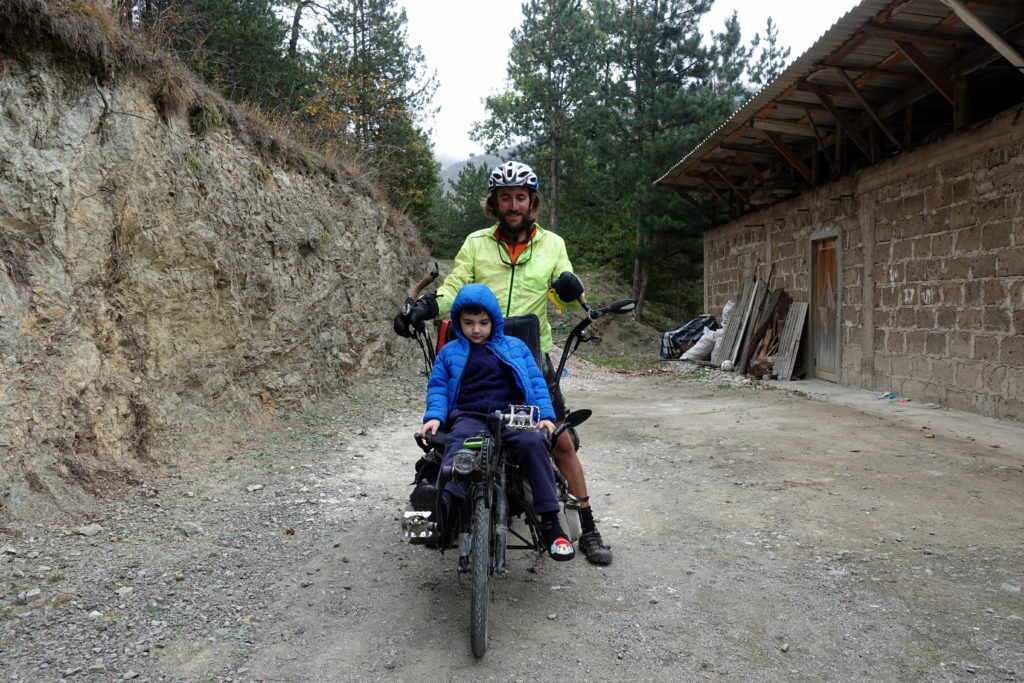
Cédric found a new co-pilot at our guesthouse in Dilijan. I’ll still keep Cassie, that one is too short for the pedals!
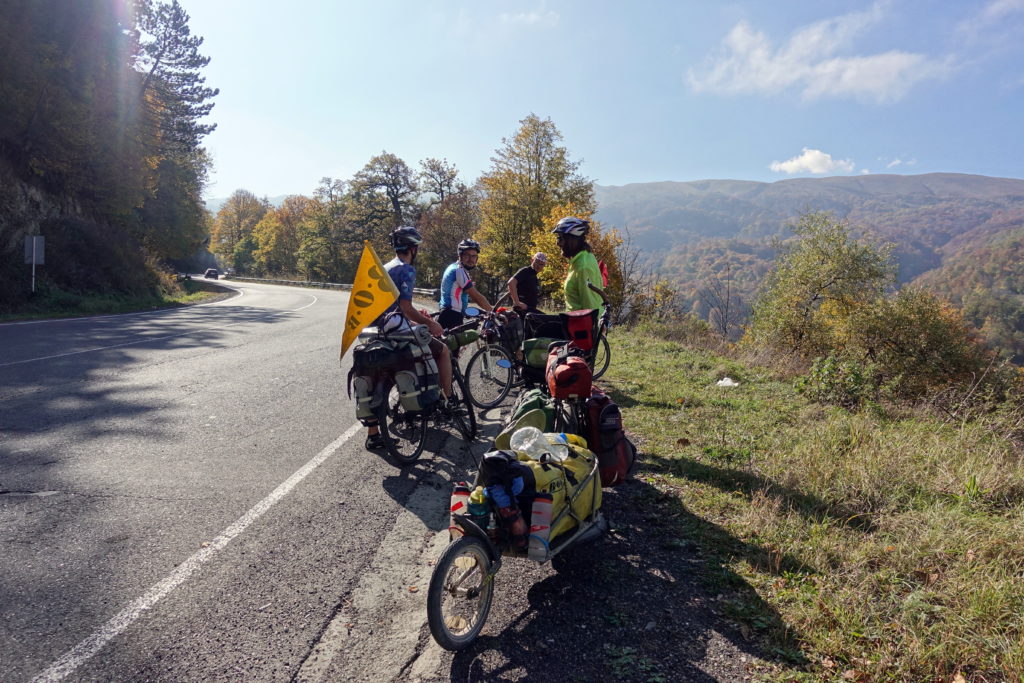
Reunited with the Russian cyclists once again. We thought that they would be far ahead as we were going up taking breaks every 5min…but they had a cold night in the tents and decided to snooze the alarm clock.
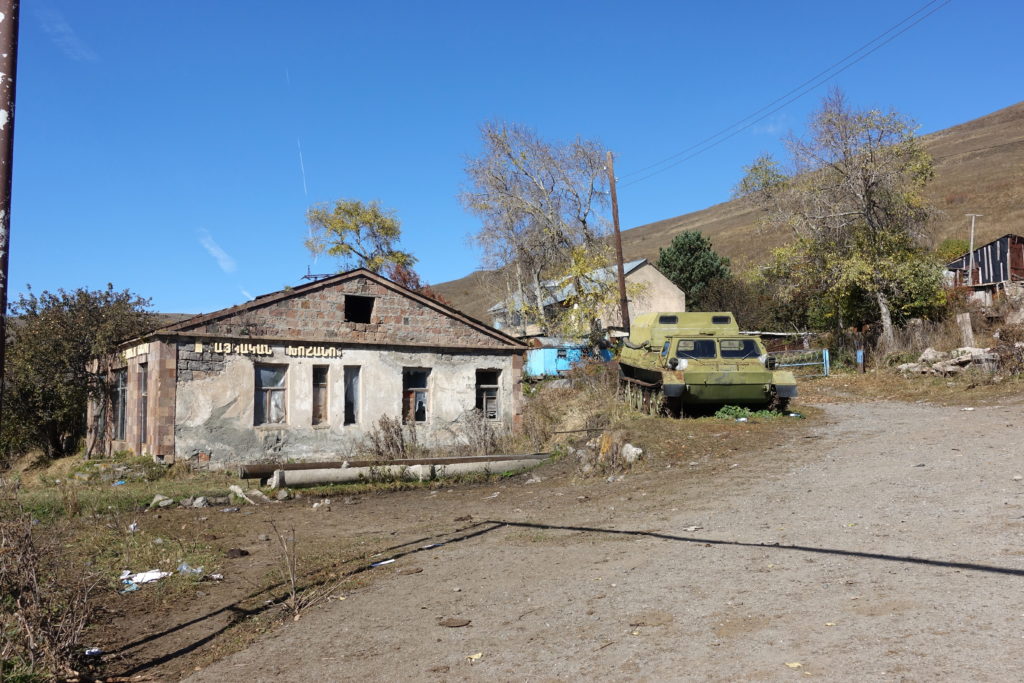
I commend the tank for making it up the hill before it broke down. An usual sight of garden-decor in the backcountry of Armenia.
We thought that being invisible from the road, in a field next to a chapel would make that camping spot perfect, but we got to discover on that night that Armenian have a special religious tradition: whenever they pass a religious building, they honk at it twice! We have no idea what the reason can possibly be (God might be fed-up with all those churches), but for us that was slightly annoying for a deep sleep… Luckily there was almost no traffic at all for a good part of the night.
The next morning, we woke up to a frosty tent and ground. For the first time on our trip, the nighttime temperatures fell well below zero, which made it more difficult to get out of our warm sleeping bags. However, by the time we left, the sun was shining and warming up the area – and even giving us a great view of Mount Ararat in the distance. Our original plan was to follow a small river road down to Yerevan, but we took a wrong turn and ended up heading towards the highway. Since the highway shoulder was large and the traffic wasn’t too dense, we decided to take the faster route instead of backtracking. This didn’t come without its drawbacks – shortly before Yerevan, we managed to get a puncture in not one, but two tires in the same kilometer (if anyone’s wondering, our tires can withstand almost everything, even the smashed glass on the side of the road, but small wire remnants from blown-out truck tires are our nemesis – and have been the cause of all our 5 flats this year). We quickly patched the tubes and continued the ride towards our hostel in Yerevan. The rest of the day, Cédric and I did what we do in every large city: feast and look for replacement bike parts.
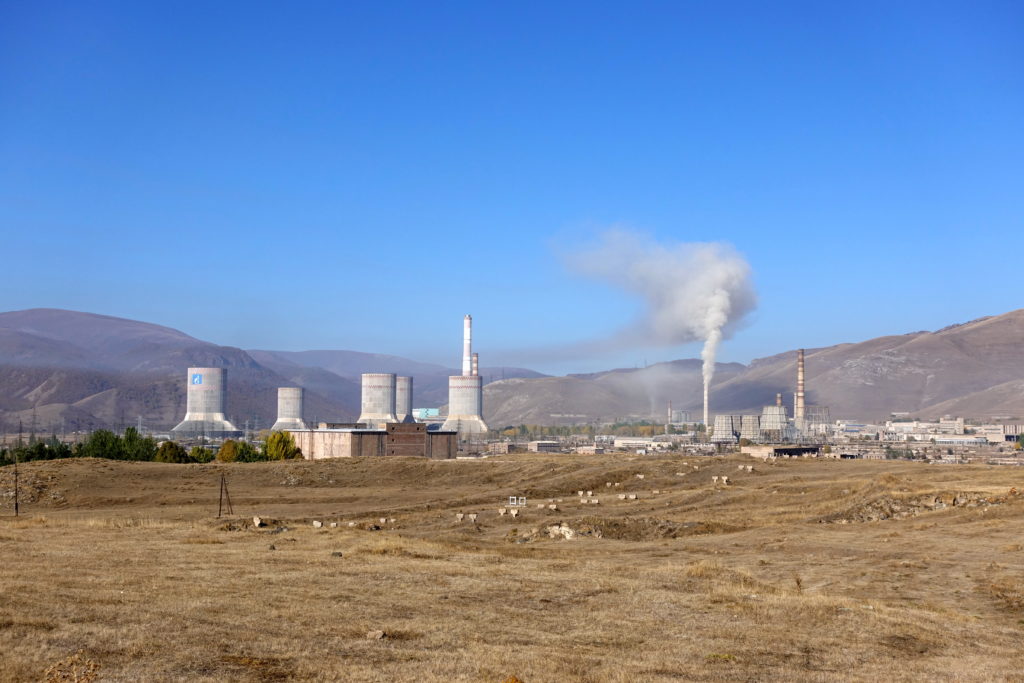
We’d be lying if we said that we had great views, all the time. Armenia had a lot of industry, and not sure they all respect the top environmental norms.
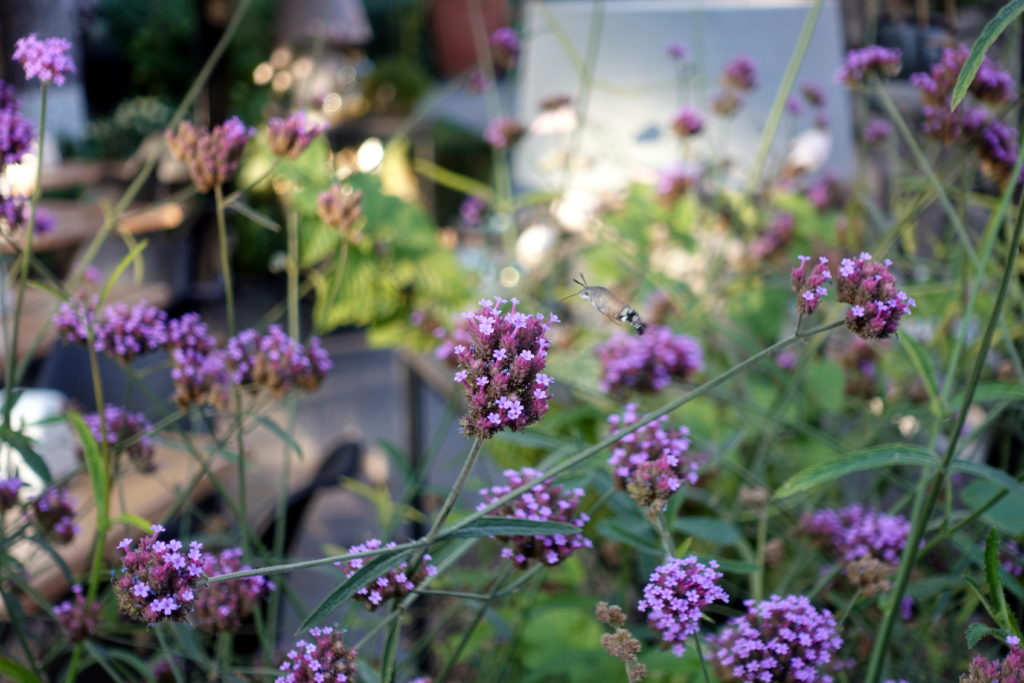
A hummingbird moth – we watched this thing for far too long in the Yerevan gardens trying to figure out if it was a bird or insect
The next day, Cédric and I walked throughout much of central Yerevan. We visited the large cascade staircase, the National History Museum (very interesting for an area near the cradle of civilization), and countless churches. Cédric was also excited to go grocery shopping at Carrefour, a French supermarket chain, and was overjoyed by finding all the French delicacies that he’s been missing.
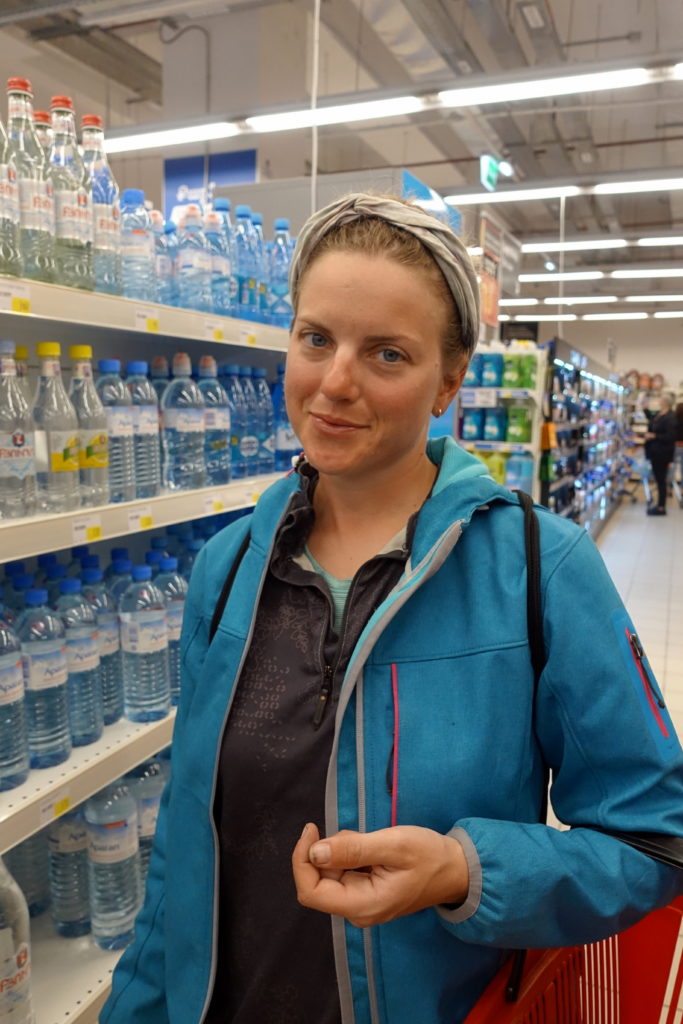
Not amused with Cédric insisting that we buy all the French things at Carrefour (no we do not need eight cans of paté)
We set out the next day, eager to beat the traffic and cycle westwards towards the Turkish border. Along with Azerbaijan, Armenia also does not have a good relationship with Turkey, so the borders remain closed, and a possibly 200km ride to Erzurum becomes a 500km detour. Our plan was to find some empty, out-of-the-way highways to get back to Georgia and this route seemed reasonable. On the ride outside of Yerevan, we stopped in Vagharshapat to see the Echmiadzin Cathedral, which is the center of the Armenian Church, and the St. Gayane Church. Both places were a little annoying to visit with a bicycle, because the groundskeepers were a little overzealous and adamant that our bike be out of sight in the courtyard and not simply parked off to the side – the Armenian God apparently does not like to see bicycle from the church tower, only four-wheel stinky vehicles. In the afternoon, we continued cycling along the highway and through fruit fields and villages. Along the way, some towns looked run down with huge abandoned Soviet factories looming in the outskirts of the villages. In the evening, we found a camping spot deep in a field and had a great view of the nearby mountains.
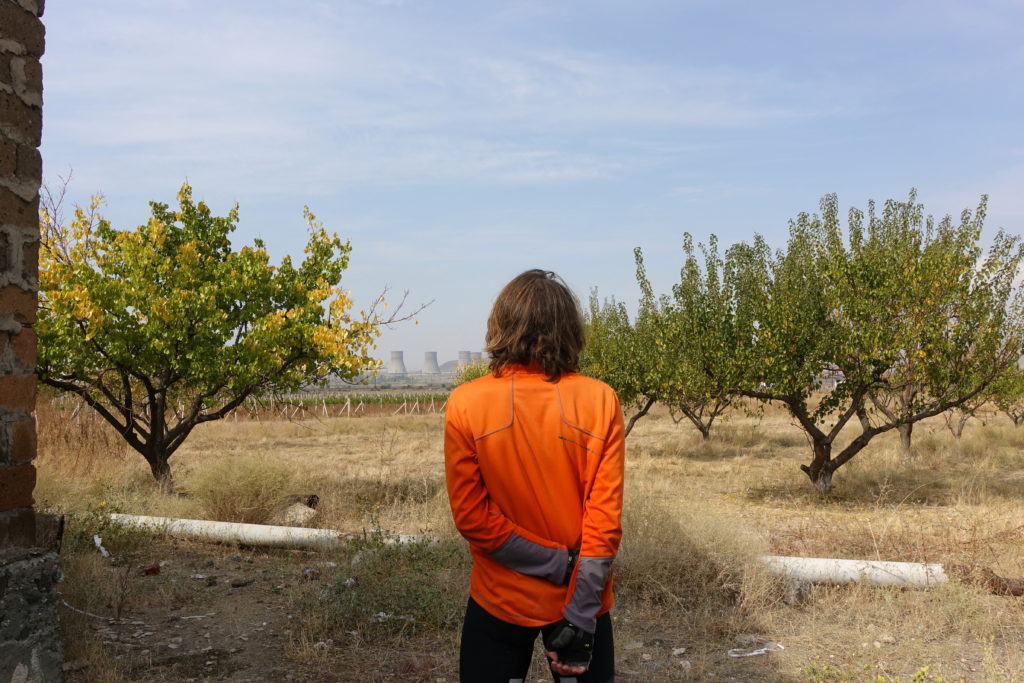
Cédric enjoying the views. The nuclear plant in the background is a sensitive topic – that stuff could pretty much explode at any time. It was basically considered unsafe right from the beginning during the Soviet Union, got closed not that long after, but because Armenia got stuck with neighboring countries closing the borders, they decided to restart the plant – especially as it is right next to the Turkish border and possibly a good way to pressure Turkey (it wasn’t). It is still running and is the main source of electricity in Armenia. Ah, and because of border problems they get uranium supplies through air-freight from Russia – people under the way of old Ilyushin flying saucers are not thrilled, but it may be Georgians so whatever… Still some ambassies recommend to check regularly the situation with that plant – weirdest travel advise.
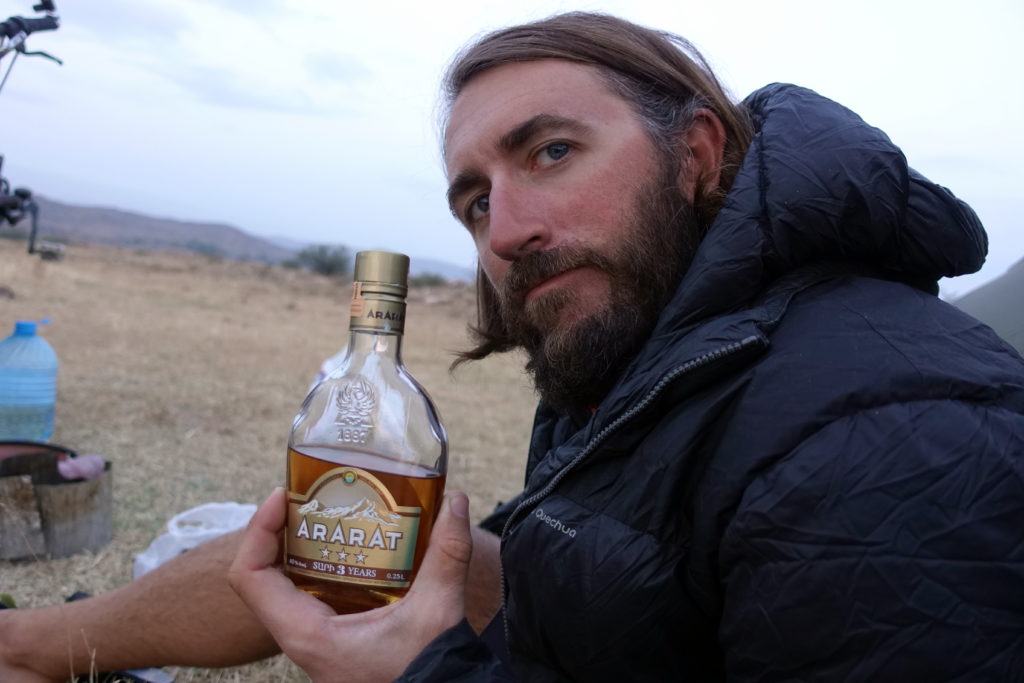
We were told to try the Armenian cognac, loved by Churchill and Stalin, but found it tasted too much like burk to enjoy – so we got a lot of Fanta, and it got better!
The next morning, we continued along the highway, which was now running north along the Turkish border. For both of us, it was frustrating to know that we essentially needed to cycle back up to Georgia, to cycle back down to Kars in Turkey, which was only about 70 kilometers west of Armenia. The roads exist, but there just needs to be two politicians to set aside old grudges and just open the gate. Unlike in Georgia and the eastern part of Armenia, the landscapes became golden and barren once again, reminding us of eastern Uzbekistan and Azerbaijan. For lunch, we took shelter from the brisk winds in a bus stop, although we were missing the kindness that we experienced in Tajik bus stops a few short months ago. We continued cycling up over the hills, with the weather changing from sunny to cloudy within a few moments. Towards the late afternoon, we finally reached our guesthouse in Gyumri and quickly went out into the city to explore before nightfall. Compared to Yerevan, with its modern rose-colored Soviet buildings, Gyumri’s center was still full of maintained buildings (or at least the facades) dating back to the 18th and 19th centuries when the city was a part of the Russian empire. We also visited a some of the city’s churches before finding dinner and making it back to our guesthouse before the weather started to turn.
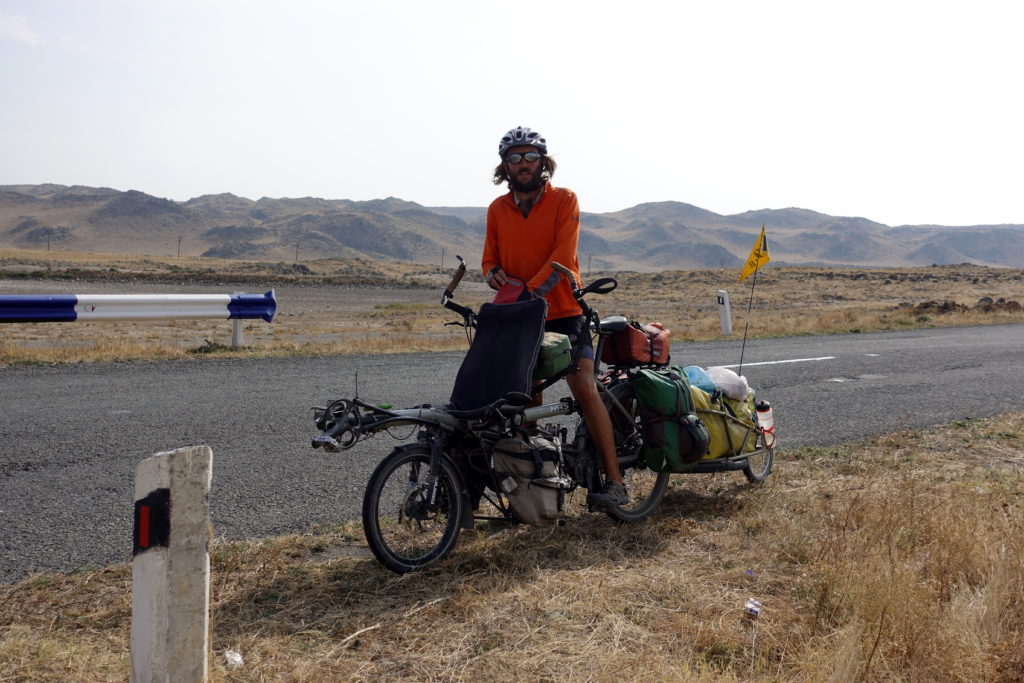
The western part of Armenia is drier and feels more desolate than the forests in the eastern part of the country.
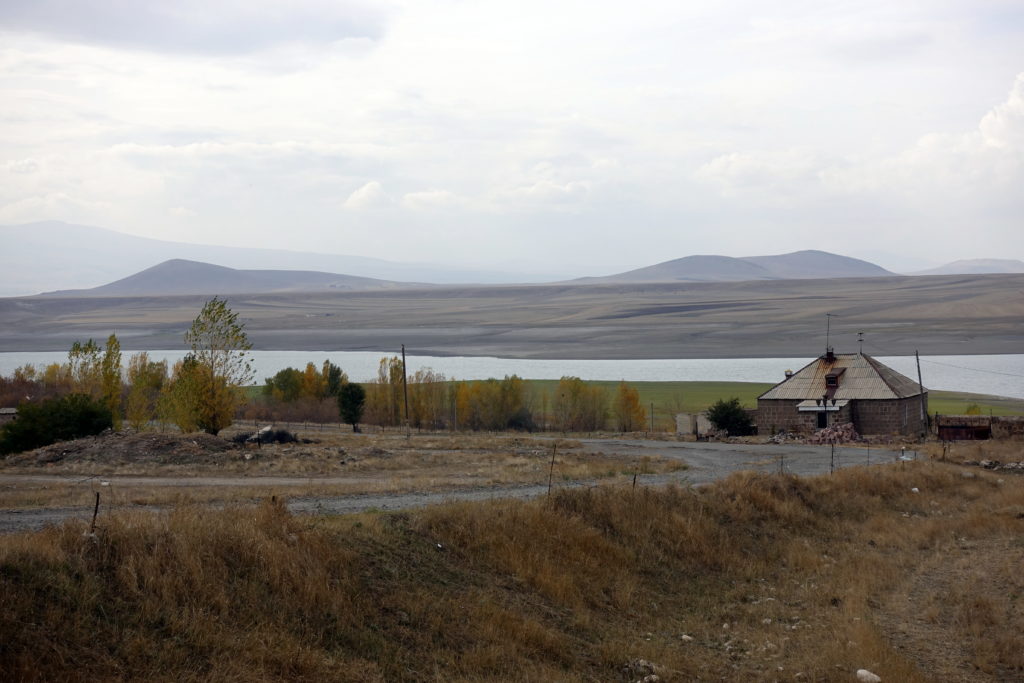
Turkey a few kilometers away in the back. We would yet need to do a detour of 200km through Georgia to get there.
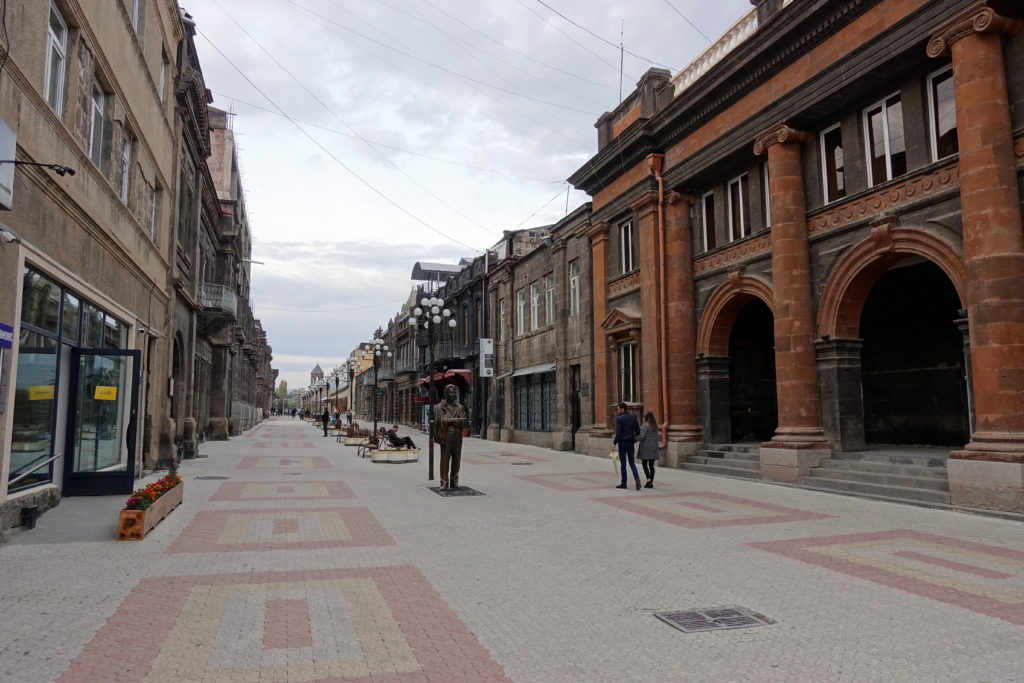
The center of Gyrumi- the city is also very much under construction. I think Armenia is preparing to be the top tourist destination in 2020.
We have crossed the border with Turkey a few days ago, are getting close to Greece and have thus left the multiple post-Soviet countries of Central-Asia and the Caucasus.
- First of all, read the posts from the last pasts months!
- Second, Central Asia is in Asia:
- China ∈ Asia
- Central Asia ∈ Asia
- ⊬ China = Central Asia
- Third, shame on you if you still do not know in which country Dushanbe, Bishkek or Tashkent are.
- Forth, even bigger shame if you cannot place Kazakhstan on a map (even worse if you have never heard of Baikonur and Gagarin!). (Cassie’s comment: can anyone tell that Cédric is a geography and history buff?)
But just in case you are still lost with all the ‘Stans and the tiny countries of the Caucasus, here is our short summary of the last three months:
- Kazakhstan: by far the richest country of Central Asia, mostly due to a sparse population and a lot of natural resources, which helped to transition more quickly to a market economy.
- We liked:
- endless desert land areas, the steppe landscapes.
- surprisingly rugged mountains on the northern side of the Tian-Shan range, with canyons, glaciers, etc.
- little importance of religion, Kazakhstan also felt like the most social-liberal country of Central-Asia, with more diversity and fewer gender inequalities.
- The only country where you are likely to find better quality products (food or outdoor equipment), even non-fake goods!
- Almaty is surprisingly clean, well-maintained and even has bike-lanes!
- Good roads (and good enough drivers – although Kazakhs become slightly arrogant as soon as they are on the other side of their border)!
- We disliked:
- Kazakhstan also felt like the country with the most nonchalant people. It felt like whenever you ask something you annoy people – not just a random question in the street, but we also got refused from empty restaurants just because they were not motivated to cook today (seriously!), hotel owners annoyed that they have to go up the stairs to show the bedroom (checking the room before paying is a wise idea in any of those countries…), people who just tell you that they don’t know anything (although when it’s about their job), etc.
- For whatever reason, you can find more food products in Kazakhstan, but Kazakhstan was also the country where we found the ‘most-expired’ products. Shops have cans having shelf-life of several years, but still expired by 5 years! 10-year-old sardines are seriously disgusting (not sure if these were better at the beginning though).
- Distances! The country has many interesting sights, but those are usually in very remote areas, and very difficult to reach. Going from Almaty to Aktau will take you three full days in a train, with very not much in-between. And even in the Mangistau region (Aktau), you will need hours of driving (days of cycling) to reach some interesting areas.
- We liked:
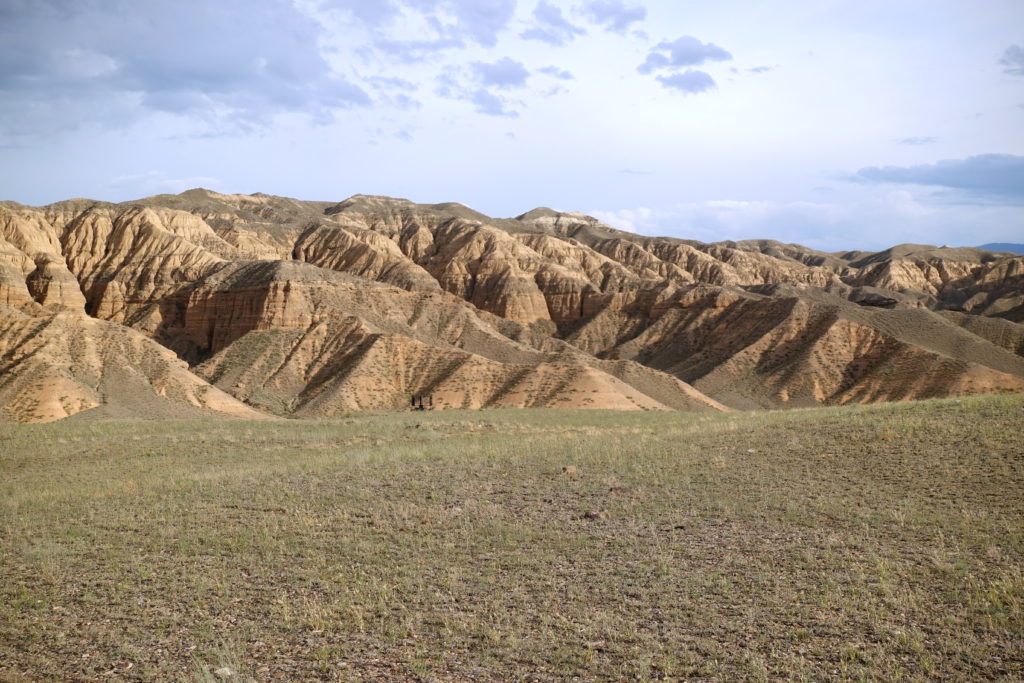
After a few days on the road in Kazakhstan, we were getting a taste of the stunning landscapes to come
- Kyrgyzstan: a poorer country, yet more traditional and very much a mountainous version of nomadic Mongolia.
- We liked:
- Gorgeous landscapes, with changing views from valley to valley, the greenest country of all, with high-altitude steppes and plenty of horses.
- The dream country for camping. Basically, any place in Kyrgyzstan is an awesome place to pitch your tent for the night. Locals do not mind, especially in the more mountainous regions, you have a tent, they have a bigger Yurt a few hundred meters away, everything is alright!
- Friendly folks in the mountainous regions, with a very relaxed atmosphere. Kids try to race you running next to the bike (even toddlers would kill many athletes at high altitude!) and adults wave at you without expecting you to give them money or buy a horse.
- Mobile internet is surprisingly good and cheap!
- Being able to go uphill faster than Kyrgyz Audi cars from the 80s. Audi is the cool car brand of the country, unfortunately a new Audi would cost a life-long wage, so they still spend a lot of money on rusty Audis, with still the driving style of a rally-championship. We got passed multiple times uphill by a roaring car, only to catch it up a few kilometers later with the driver randomly hitting the engine with a hammer.
- We disliked:
- The drivers! There is an obvious problem of alcoholism, with additionally some suicidal-driving behavior. Kyrgyzstan was the worst place to ride on roads, we always had to look at every single car coming from any direction – and get ready to pull-out the road at any time. They just don’t care! Luckily, we took some off-road tracks with very (very) little traffic.
- Tracks: because we did everything possible to avoid roads, and because there are really not that many roads, we ended up on the roughest tracks we have encountered this year. Kyrgyzstan was definitely the toughest country, both for the profile (continuously going up and down from 1000m to 3000m), and the road conditions (washboard, trenches on the road, rocks, etc.) – get ready to bike 7h for 40km and going uphill is not necessarily much slower than downhill.
- The Fergana valley, much more conservative, much more gender-divided, with men acting like young teenagers trying to show that they are stronger than you. Imagine a 12-year-old trying to look like a mobster, and you have about the idea of men in the Osh-Jalalabad region.
- We liked:
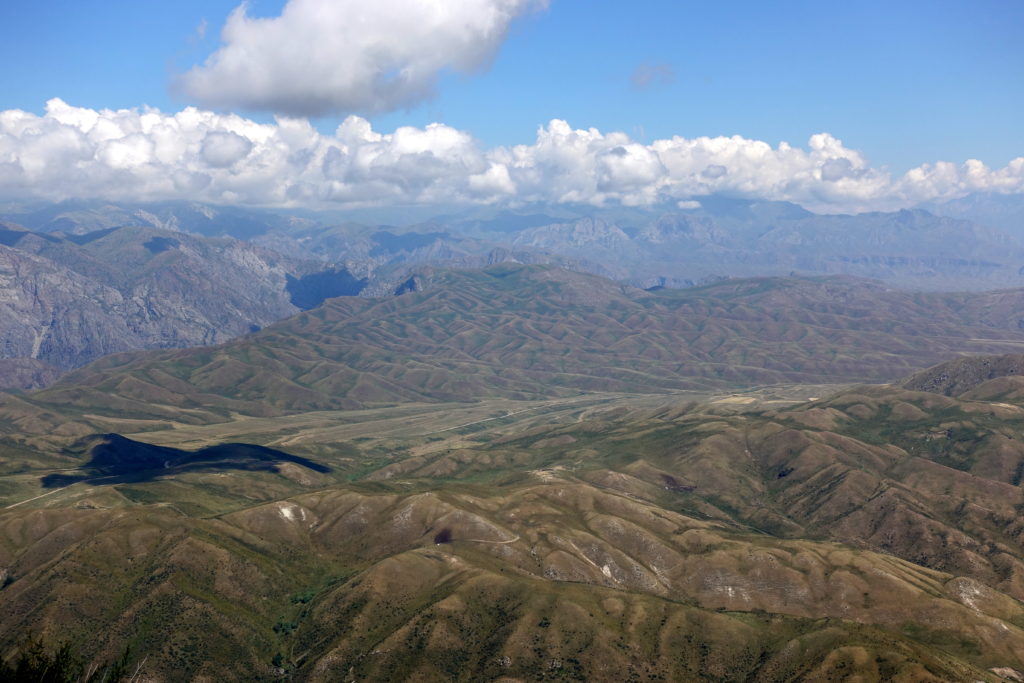
The Song Kul – Kazarman road: tough, but worth it for the views (the picture was not taken from a plane, but from the top of a mountain-pass)
- Tajikistan: the poorest of the Asian countries (except Yemen and Afghanistan, which are active war zones). The highest country on earth (average altitude), possibly one of the most remote and inaccessible regions on earth too. The feeling to be on a completely different universe.
- We liked:
- Cycling on another planet, over days we felt like doing some space travel between the Moon, Mars, Venus and other satellites of distant planets – lack of oxygen included.
- The road condition of the Pamir highway, although very rough, was easier than we had anticipated (also probably because after the tracks in the Kazarman and Song-Kul areas of Kyrgyzstan, everything seems easier).
- Incredible hospitality of locals in the Pamirs. People live in extreme poverty but are always happy to help, do not try to scam us, are very friendly, and amazingly many people speak English there. We really had the feeling in some villages to be with the toughest survivors, and the only way to survive is to help each other without condition or limit.
- Meeting a lot of other cyclists on the way, especially as we were cycling in the opposite direction as most of them (it is supposed to be easier to bike Dushanbe-Osh than the other way around).
- Dushanbe is a surprisingly enjoyable city. Not much to see, but it is a rare place to find good restaurants, it is relatively easy to get parts or gears, some parks and relatively clean.
- The Panj river valley is an indescribable feeling. You are cycling days looking at a medieval and almost mythical Afghan society. Afghanistan feels like being back in time several centuries ago, although it is interesting that even remote Afghanistan villages now have access to mobile internet. By the way, yes there has been an attack in southern Tajikistan – and apparently tourists have all left the area, which felt silly! Tajikistan is safe, and has now been downgraded by the western foreign ministries to the security level of western Europe…
- We disliked:
- Well, it’s hard to not get some type of sickness (mostly digestive) in Tajikistan! Electricity is far from reaching every village, running water is a luxury, and simply the remoteness does not help having a good food-hygiene. Most of the guesthouses are nevertheless clean and we did not get anything too serious. Plus, there is really no problem doing an emergency stop anywhere on the road when you only see 10 cars per day…
- Politics in the Dushanbe region is really “special”. There is clearly no democracy in Tajikistan, but our conversations – several people were trying to practice their English – were severely bridled. Dushanbe inhabitants are clearly privileged in the country, and they seem to all strongly and blindly support their president, including the fact that he should stay there forever, with his son taking-over later. Western countries, with elections every few years thus cannot be good… The area around Dushanbe felt like the most indoctrinated in Central Asia with an idealization of the leader everywhere. Discussions were surprisingly more difficult in the capital than in the rest of the country. The opinion of that leader is indeed very different in other parts (especially the Pamirs) of the country.
- Cycling several weeks around 4000m is physically hard. We both lost a lot of weight (it’s all gained back, don’t worry), you finish exhausted every single day, and after 1000km of continuous dirt roads (including Kyrgyzstan), we were just dreaming of asphalt.
- We liked:
- Uzbekistan: the most historical country, with old cities, many monuments and the core of the silk-road cities in Central Asia. Uzbeks thus consider themselves a little as being the only urban civilization (versus nomadic tribes) in the mountains or in Kazakhstan. Although very isolated (a double landlocked country, today far from any trade route, and yet with little interest to develop connections with neighboring countries) but nevertheless the most populated, Uzbeks consider unconsciously that all Central Asia shall be theirs.
- We liked:
- The road conditions are good! Especially after Tajikistan and Kyrgyzstan, we were glad to finally have continuous stretches of asphalt without too many potholes (small potholes are useful when cycling as they make car drivers a lot more cautious).
- The historic cities – basically Samarkand, Bukhara and Khiva – are impressive and remarkable, they are well maintained and are worth visiting.
- Some generous people, particularly after near the Tajik border until Qarshi (very few tourists) – we had everyday people offering us chocolate bars, ice-creams, and other treats!
- The new president seemed to shake things up in the country and finally try to solve the serious problems of the country (since 2016), this is particularly notable after the reign of the previous dictator Karimov (completely nuts): tourism develops, Uzbekistan opened its border more widely to its neighboring countries, they finally want to get rid of the cotton industry and the corruption linked to its system, possibly work on refilling the Aral Sea (that may take a few decades!), etc.
- We disliked:
- Some men are slightly creepy! Every single women tourist that we have met (not those in guided tours!) have encounters some type of weird moment – from men who want to kiss you, to some touching or grabbing, etc. There is some impunity against forced marriage (including children), and women are clearly a lower social class. It did not feel like something directly liked to religion (few Uzbeks are practicing, women do not wear veils or hide and are active in the society), but a deep cultural habit.
- Again, about men (who are the primary car drivers) … we got used to honking and so on, but some Uzbeks felt like being really pushing it. It is not just a short honk and waving, but a non-stop honking behind you, at your pace, until you acknowledge them. We are all day long on the road, and that would be fine in the Pamirs with 10 cars per day, but Uzbekistan has a larger population (with a lot of cars) so we got slightly tired of getting interested in every single driver. Even better, you get regularly stopped (the car passes you, puts the warning lights on and slows down until you stop) by group of guys who want to take a selfie with your own camera. It’s funny once, but we have a lot of pictures of Cedric (Cassie is happy to be ignored) with a group of locals on the side of the road… The real treat was having a driver slow down and take a video of us on their smartphone while still driving – funny at first, but we don’t condone distracted driving practices (and mostly stopped the bike when we saw what the driver was doing, so they would be forced to drive ahead).
- The desert landscape! The country west of Bukhara, and especially after Khiva, is desperately monotonous and boring. I really would not recommend anyone to cycle across that (we only met one person, a Swiss, who had done it, and he told us he became almost insane after the several weeks alone with the exact same sight).
- The Plov! I guess this can be about Central Asia in general, if you look up the region’s national dishes, but Uzbekistan is richer, and they have enough farmland to grow other things than cotton – and then possibly make some recipe variations! Seriously, why does everyone revere this dish? It feels that they only like that, only serve that, and make that and almost worship it. It is not intrinsically bad, but we just could not see it any longer. Cassie was also starting to loathe the mutton sitting on top of the dish.
- Uzbekistan is the country where we got the sickest (again, digestion issues). We however cannot explain it there by the lack of electricity and fridges.
- We liked:
